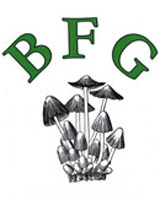Latin Masterlist Index
A B C D E F G H I J K L M N O P Q R S T U V W X Y Z
| S |
|

 |
Sagaranella tylicolor (Slater Greyling) Dec 30, 2023. In mossy grass under Oak and Holly in Gerrards Cross Jesper Launder spotted this somewhat inconspicuous pale LBJ mushroom. Previously in genus Tephrocybe, the species is not often recorded - we have just two previous county records under its older name. Once having identified it from its unusual spiny round spores, Jesper discovered that it favours sites with animal faeces, this fitting well with this area which is apparently frequented by dog-walkers! The species name translates as 'mouse-coloured'. This is a new entry for Finds. |


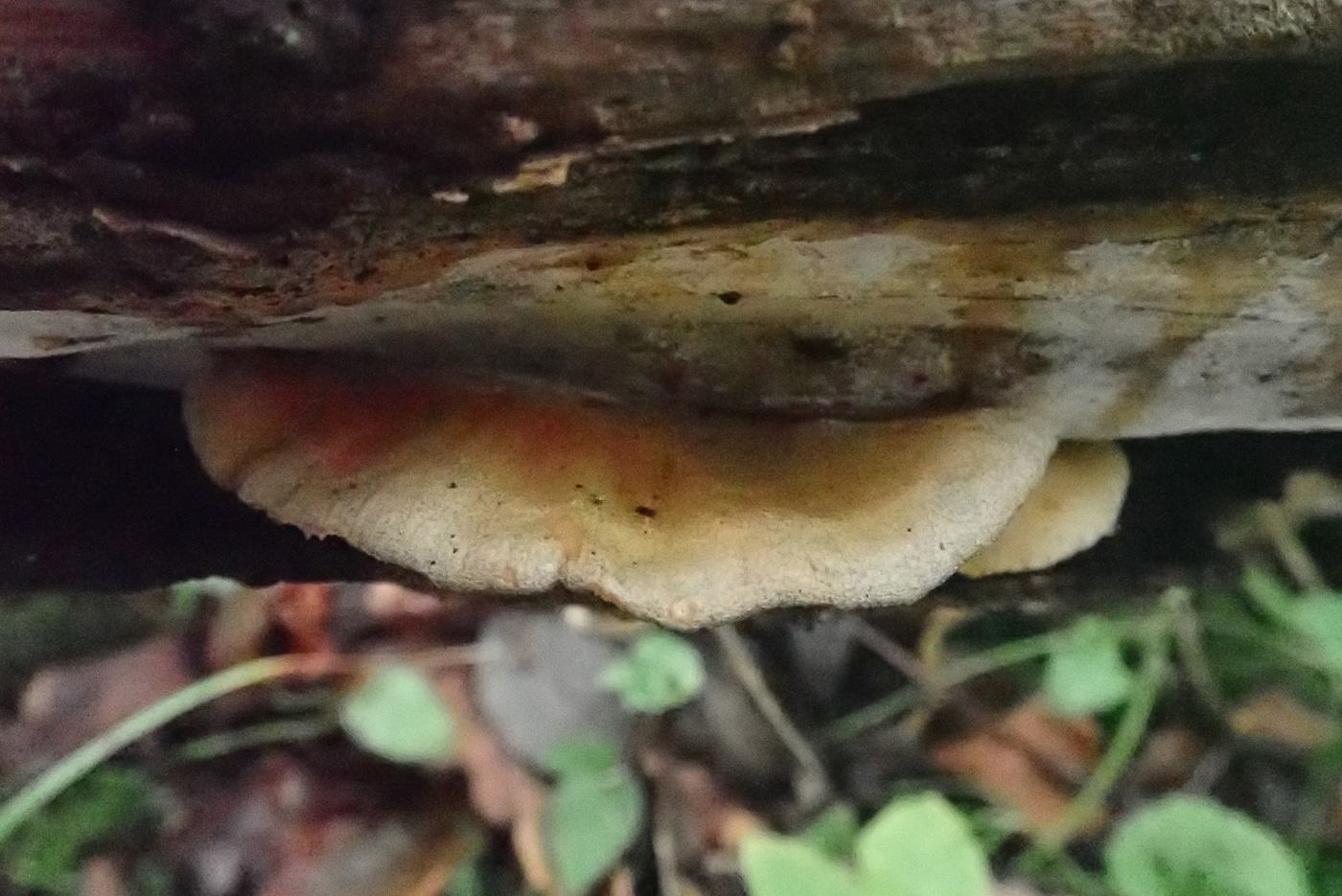
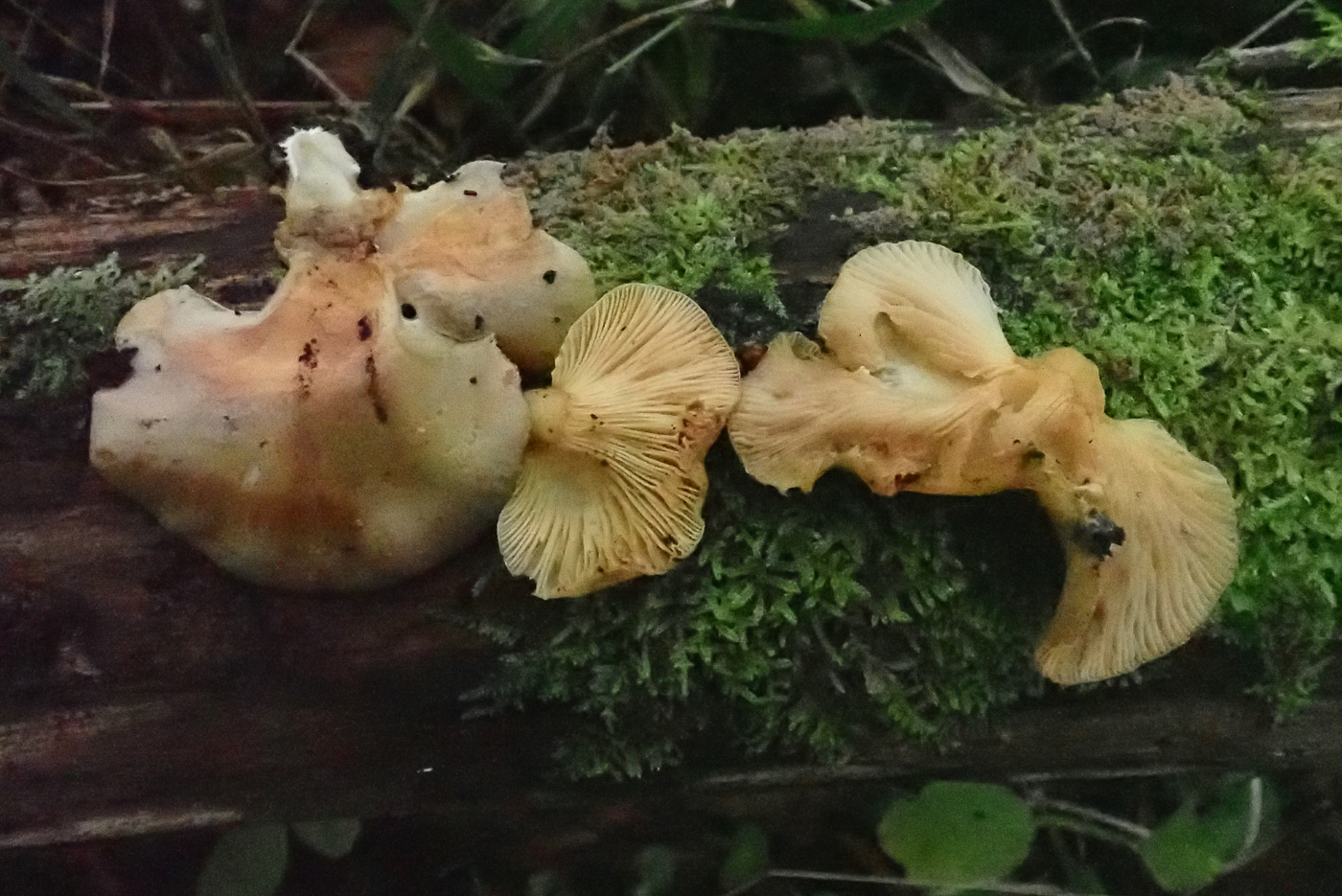
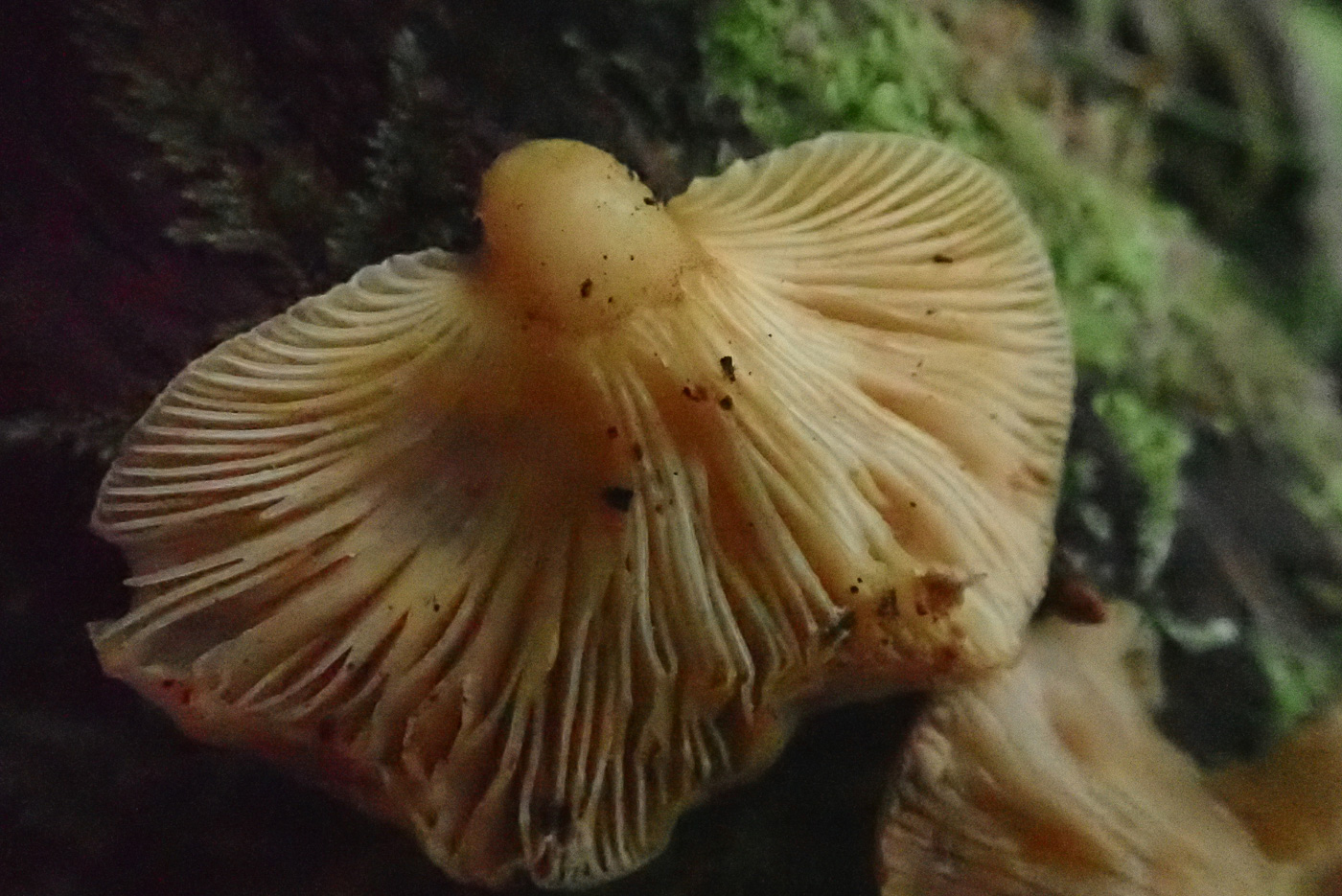 |
Sarcomyxa serotina (Olive Oysterling) Jan 8, 2023. On a rain-drenched fallen Beech trunk at Burnham Beeches Penny noticed a single cluster of this typically late season species amongst other brackets - seen here just above a line of rather pale Trametes versicolor (Turkeytail). Previously in genus Panellus, when somewhat washed out and having lost much of its greenish olive tints as here it is easy to mistake for Pleurotus ostreatus, being about the same size and shape, though the underside (photo 2) is more pinkish ochre beige which helps to distinguish it. We only find it occasionally, usually in wintertime, and when fresh and in good condition the upper surface can be a beautiful shade of green. Jan 3, 2022. On the underside a fallen Willow trunk in Rushbeds Wood Penny noticed this 'Pleurotoid' species (photo 1) but had to break several of the brackets off to be able to view it properly. The yellowish eccentric stem was a strong clue to the species though the dull brown cap colour could have belonged to several other species but at home the scope revealed tiny allantoid (sausage-shaped) spores and also the flesh was extremely gelatinous - all good pointers to this unusual but not rare species (previously known as Panellus serotinus, the species name meaning late season). When fresh and at its best the caps are olive greenish but this colour usually fades quickly. We have quite a few sites in the county where it's been recorded but it was new to Rushbeds Wood today. |

 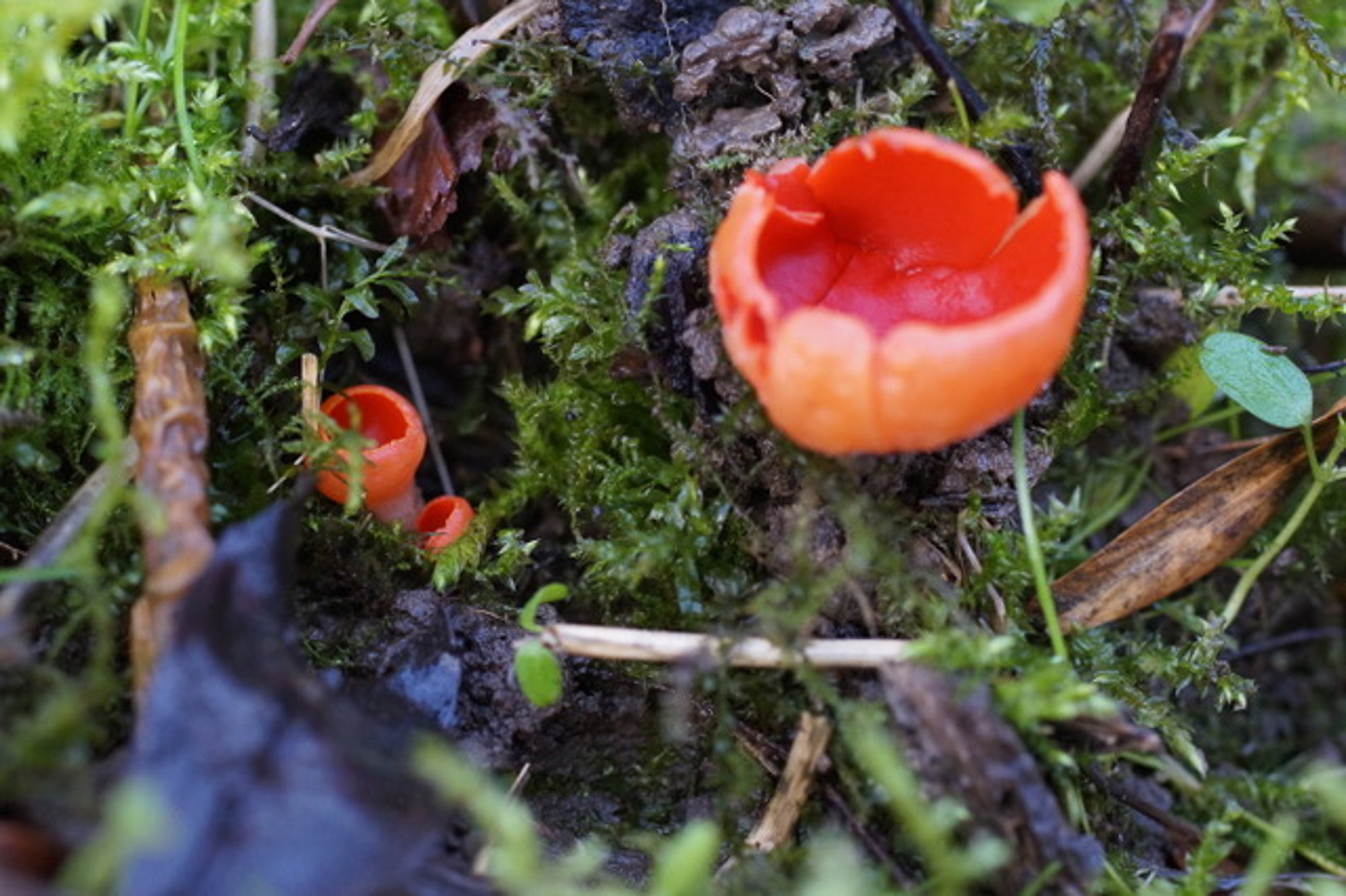






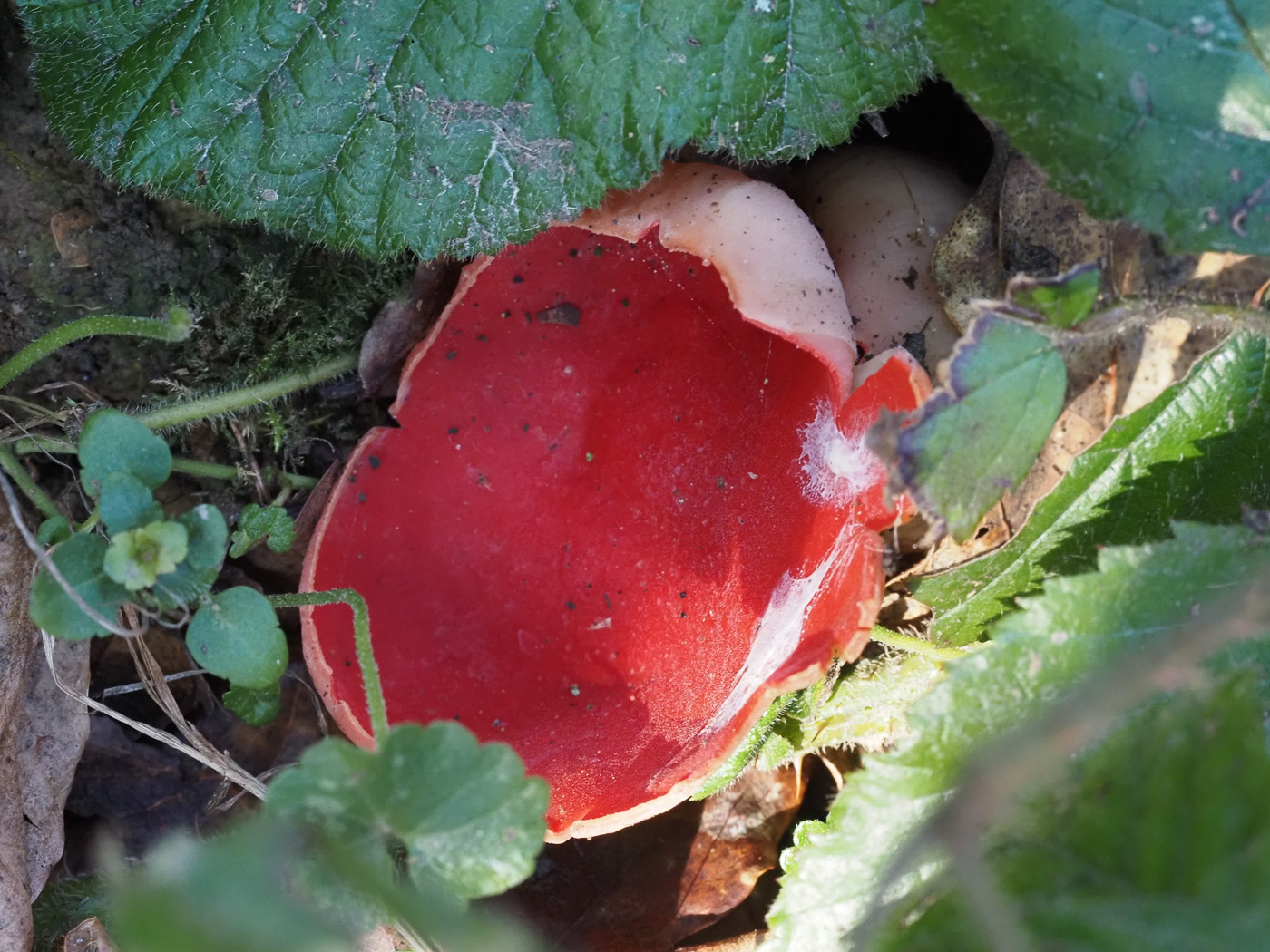
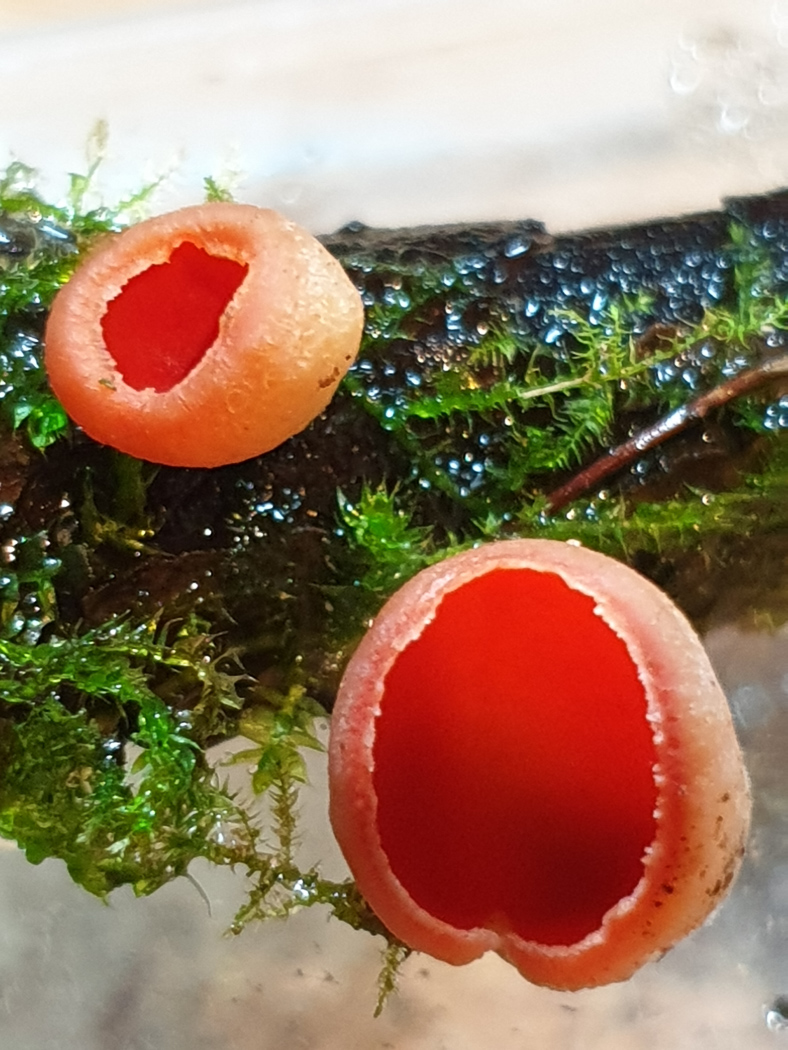

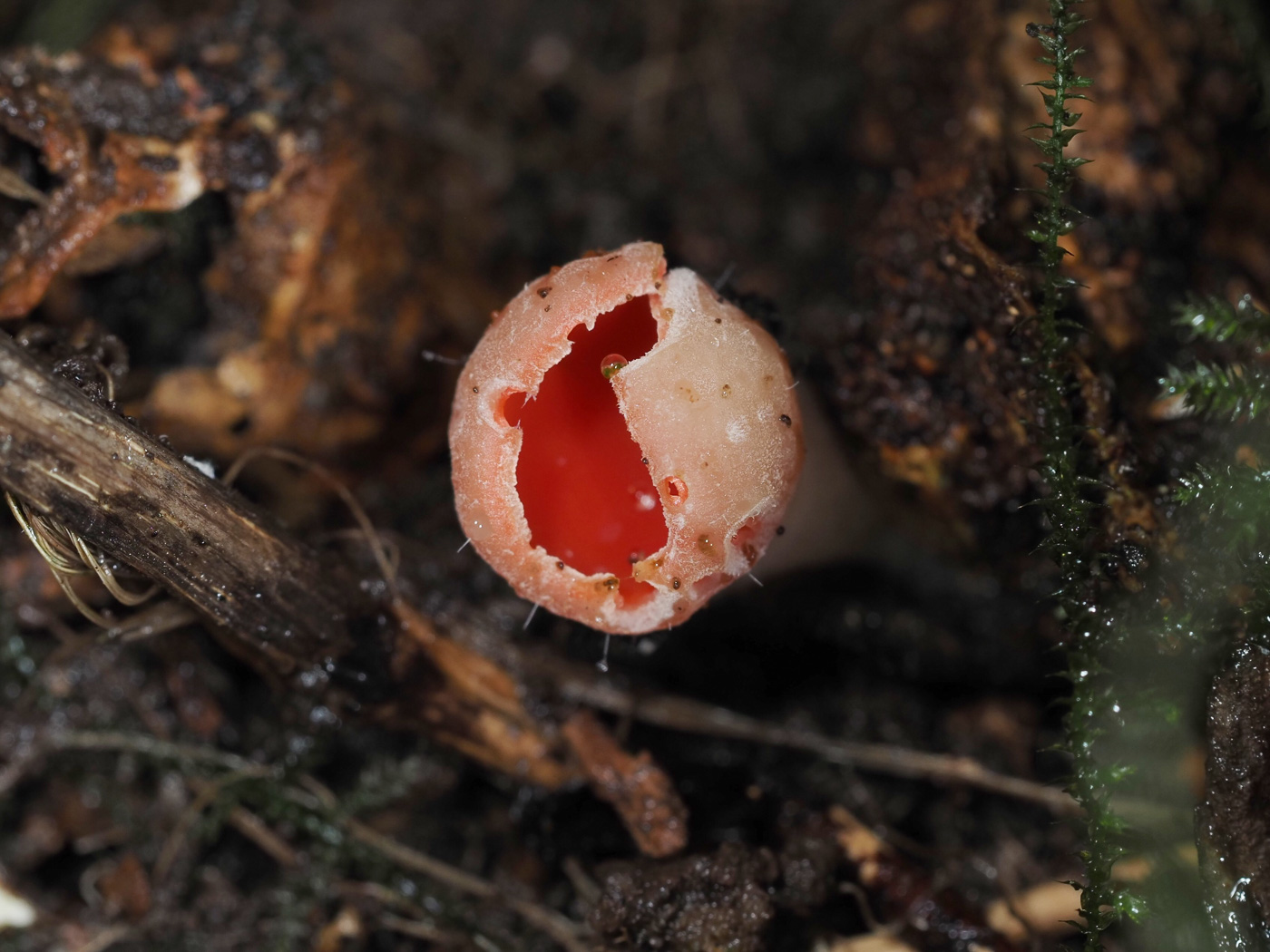
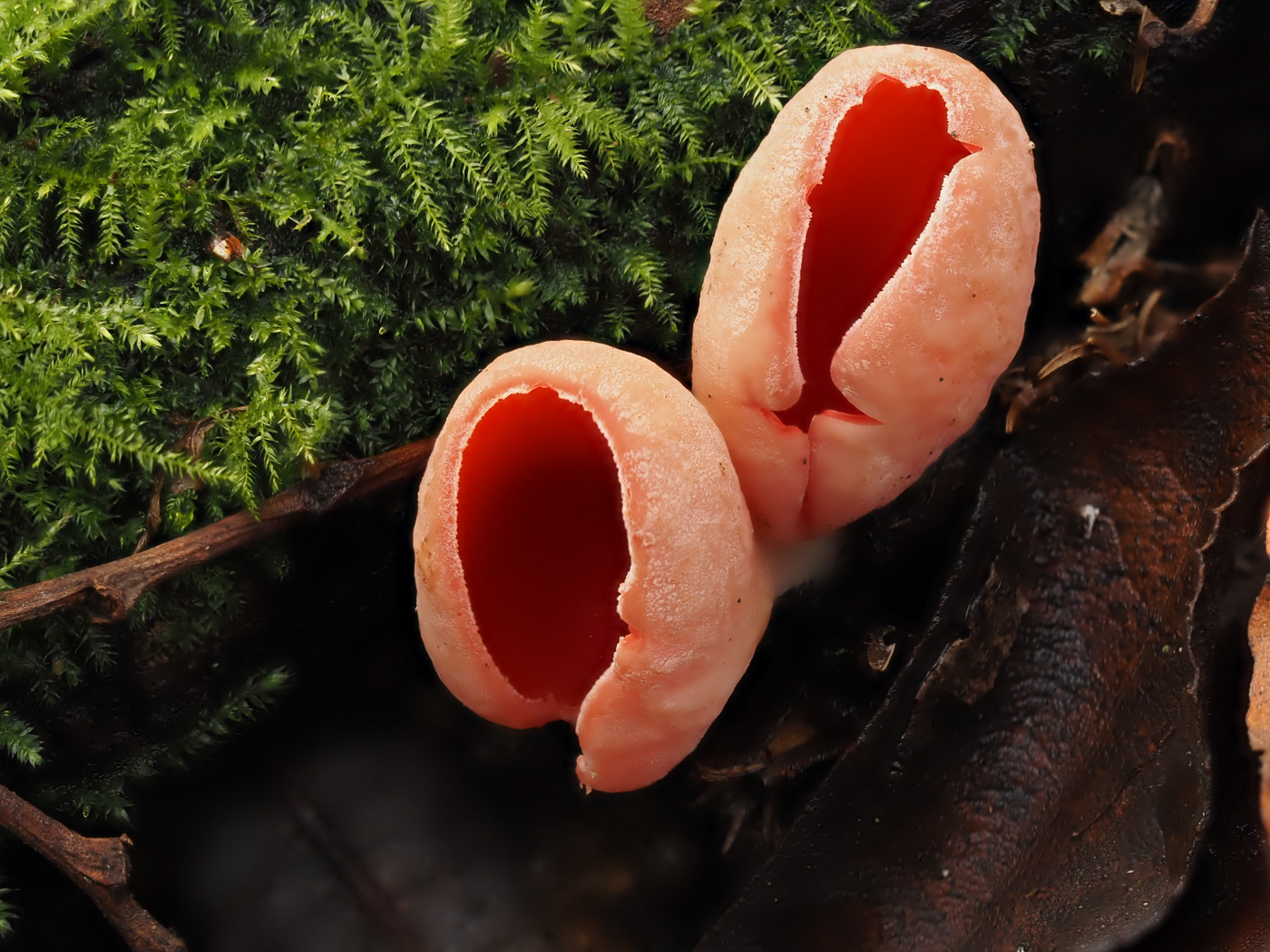
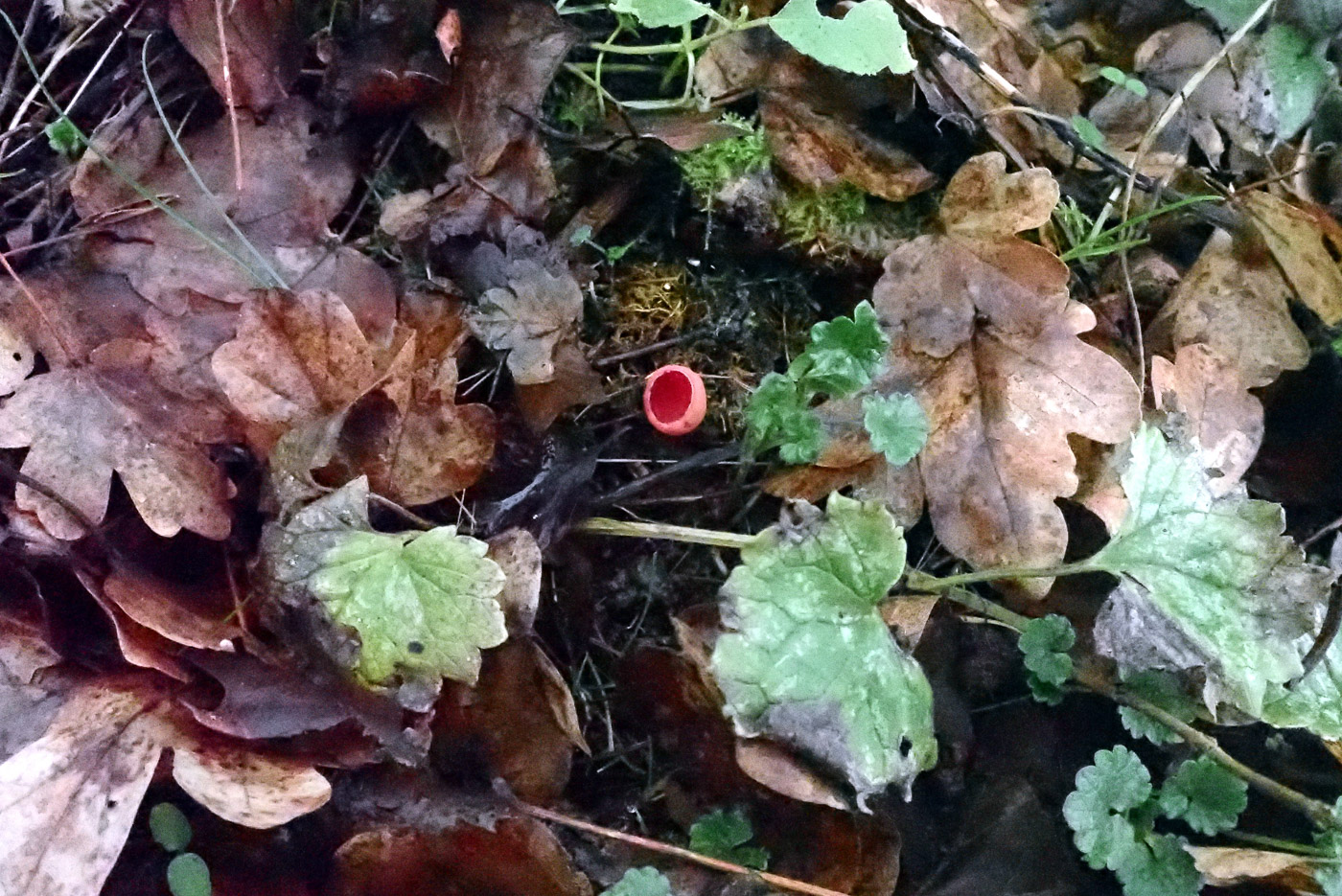
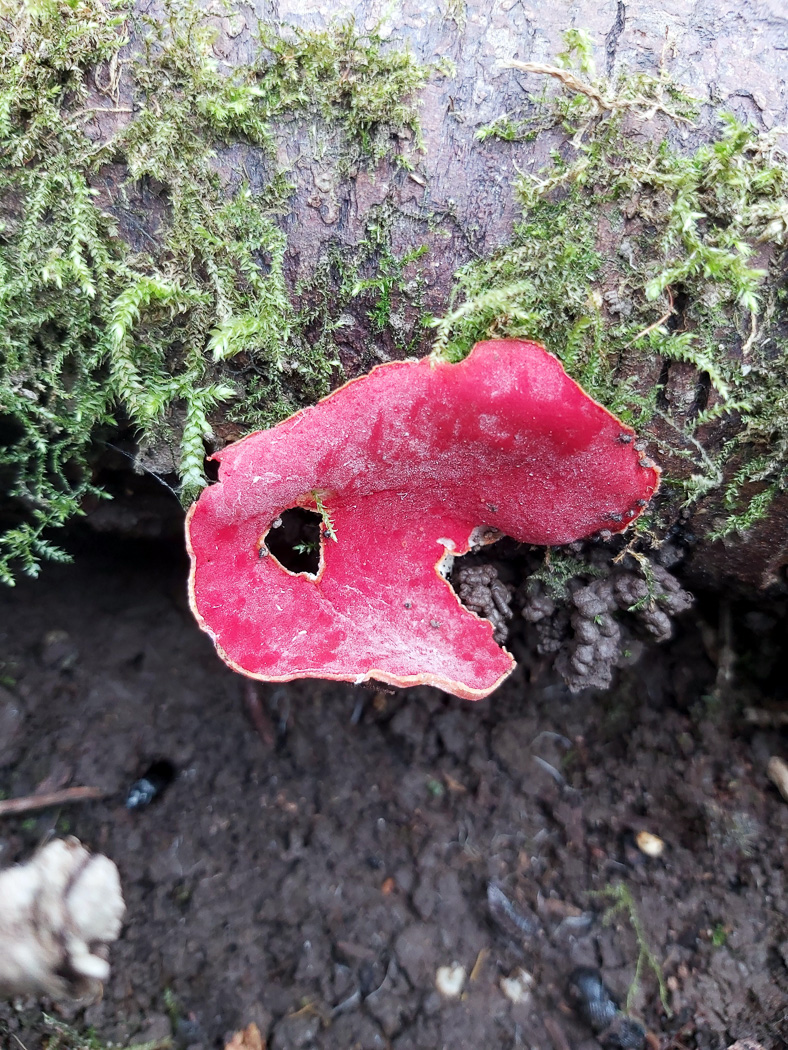
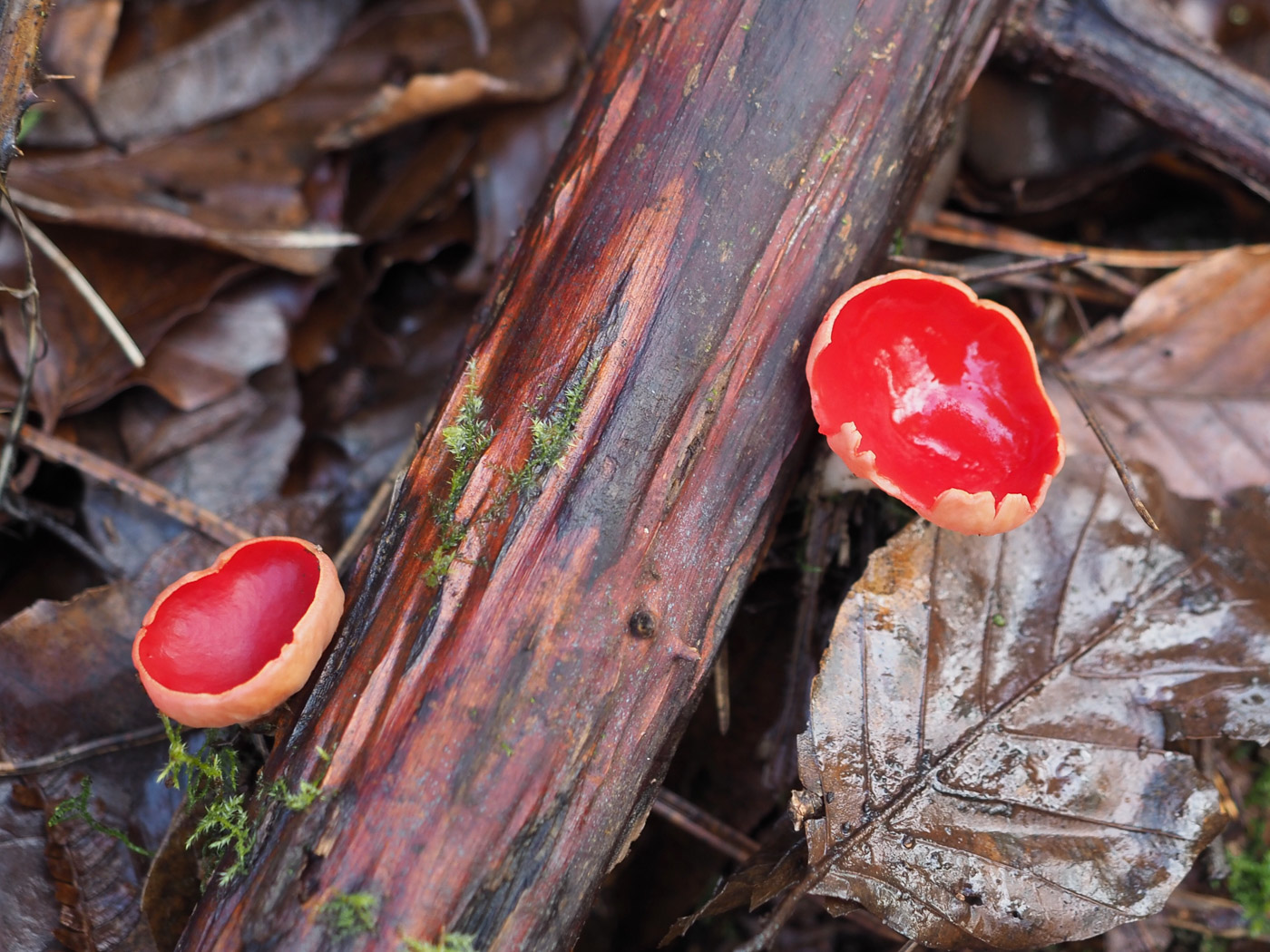
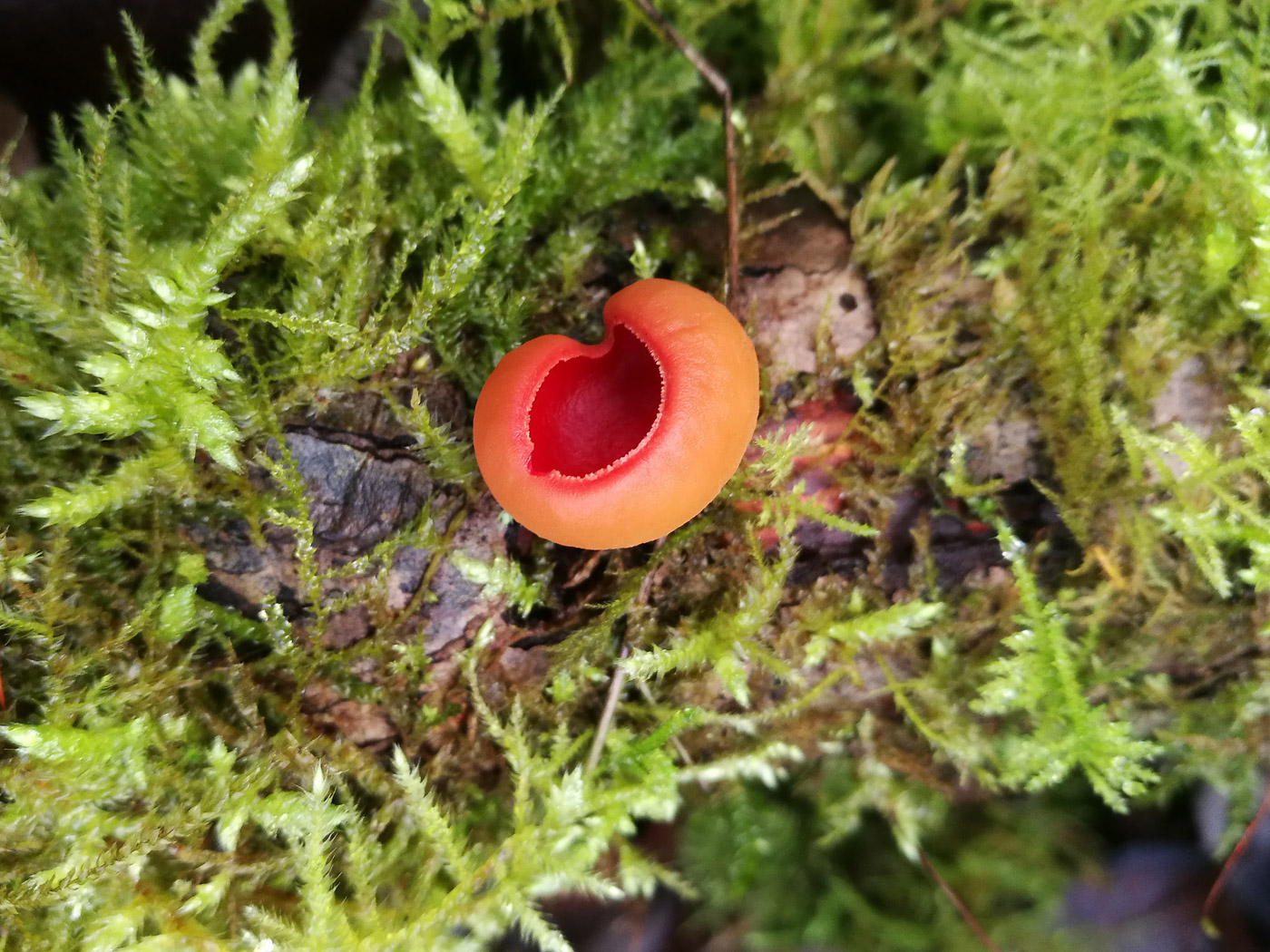
|
Sarcoscypha austriaca (Scarlet Elfcup) Mar 12, 2024. At Burnham Beeches our small group of forayers were delighted when good numbers of this eye-catching cup fungus were found. The species is having a 'bumper year' this winter and spring, no doubt encouraged by the mild wet months, and has been seen in extraordinary numbers in several places. However, very surprisingly it had never been recorded here before today though this site must have one of the lengthiest species list in the county, going back over a century or more. The photos are Linda Seward's. Jan 3, 2024. An appropriate species to start off our 2024 entries! This little beauty was sent in by Bob Simpson, found in his Salden Wood in mossy woody litter, and is a species which thrives in damp conditions at this time of year. So it's no surprise it should be fruiting now, and in fact was also found a few days ago in Penn Wood (see December 29th in the previous Finds page). Dec 29, 2023. In Penn Wood ex-member Toni Standing found this charismatic springtime species fruiting early. Penny was pleased to receive her photos, recalling the exact spot where she knows it fruits regularly there, having first found it in this wood in 2003. The recent mild and somewhat damp conditions are perfect to encourage this species to start fruiting now, so look out for it on fallen rotting damp deciduous wood which is in close contact with soil. Mar 12, 2023. Now the weather has warmed up a bit, Claire Williams noticed this attractive species fruiting again in two different sites: photo 1 was at Naphill Common and photo 2 at Downley Common - both found on fallen soggy deciduous wood which is (typically for the species) in contact with the soil. Photo 3 was found a week later at Turville Heath by Penny, and we have an earlier example from January 9th, also several others in the Masterlist. We hope it will still be fruiting on our Rushbeds Wood walk on April 2nd where it is a regular at this time. Jan 9, 2023. Penny's been waiting for someone to find this early springtime species and send it in: here it is from Dancersend, found by Paul Goby - something to brighten these dingy soggy days which seem to be endless at the moment. We have quite a few previous entries (see the Masterlist) but you can never have too many and these are particularly splendid. Photo 2 is of a slightly damaged fruitbody found by Claire Williams just a week later in Downley Common. Mar 7, 2022. In Naphill Common Claire Williams spotted the telltale bright red colour of this beautiful species on fallen rotting deciduous wood and peeping through the undergrowth near Daisy Pond. Though not a rarity this is our first record from Naphill Common and it's not uncommon for the species to continue fruiting through the spring months - even into May. So still one to look out for. Jan 24, 2022. Jackie McKenzie Dodds sent Penny this photo of a collection fruiting on a deciduous stick picked up on our Rushbeds Walk last November when she'd spotted some tiny pale pink blobs on it. In the field Penny was fairly sure of their identity but suggested Jackie should retain the stick at home, keeping it moist and weathered, to see if it would develop further to confirm this early springtime species. It did! Rushbeds is known as a reliable site for it though surprisingly a thorough search there by Penny recently was fruitless. Jan 1, 2022. The perfect way to start off our 2022 photos! On New Year's Eve Claire Williams noticed this little beauty just opening out on fallen rotting deciduous wood in Downley Common (photo 1), then went back today to check various other spots in Downley where she's seen this species in previous years. She reports 13 sightings! Photo 2 was the best of them. This is a typical springtime Cup Fungus and one which is easy to recognise too, so is certainly one to be looking out for now in damp deciduous woodland, particularly on fallen Willow where the wood is in contact with the soil. Penny is not surprised it's around now, having found signs of it starting (tiny little 'buds' of pink) back in November on our walk at Rushbeds - another regular site for it. If ever there was proof of the value of getting to know your local patch where many species reappear year after year, this is surely it! (Photo 3 is of a tiny specimen just emerging in woody litter, taken by Penny in Rushbeds Wood on Jan 3rd.) Mar 25, 2021. Jesper Launder noticed this springtime species in woods near Chalfont St Giles though it is probably past its best but still showing the 'wow' factor - always nice to find this one. There are two closely related and extremely similar species - not possible to tell apart without a scope (not used here), but one (S. coccinea) seems to be becoming extremely rare and the other (S. austriaca) appears to be replacing it in the UK. So it has been assumed but not checked that today's find is the common species. Penny has been surprised not to have received more photos of this from around the county because it is such an eye-catching fungus, occurring in damp woodlands on rotting fallen deciduous wood (usually Willow). So one to look out for now. Jan 29, 2021. At last we have an example of this charismatic and unmistakeable Springtime species, found by Claire Williams in woods near Downley. Penny was expecting to be inundated with photos of this but not so, though we did have an example in Finds 2020 dated Dec 20. It can be found on rotting damp deciduous fallen wood which is semi-buried or lying in contact with the ground, most often Willow. Dec 27, 2020. At Dancersend BBOWT Reserve Michael Hatch found an early fruiting specimen of this beautiful and eye-catching species - one that is always a thrill to find. Clearly a cup fungus, this is actually unrelated to the very similar genus Peziza and favours damp woodland sites, most often found on fallen rotting and partly submerged mossy branches of Willow or Maple, though it can occur on other deciduous wood if suitably soggy. It is a Spring fruiting species and is well worth looking out for any time from now till April or sometimes even into May. |
 |
Sarcoscypha austriaca var. lutea (a very rare variety of Scarlet Elfcup) Apr 7, 2023. In Seer Green Jesper Launder noticed that amongst the bright red cups of this collection was one which was a notably different colour. This had to be the elusive variety lutea though its colour is more peachy orange than yellow. It was first discovered in the UK in Wales, (2005 - see the Field Mycology article in vol 8(1) describing this) and there are only a handful of records in FRDBI, all from Wales bar one from Yorkshire though interestingly one of these was from January this year. More images can be seen online, but this was an exciting find. |
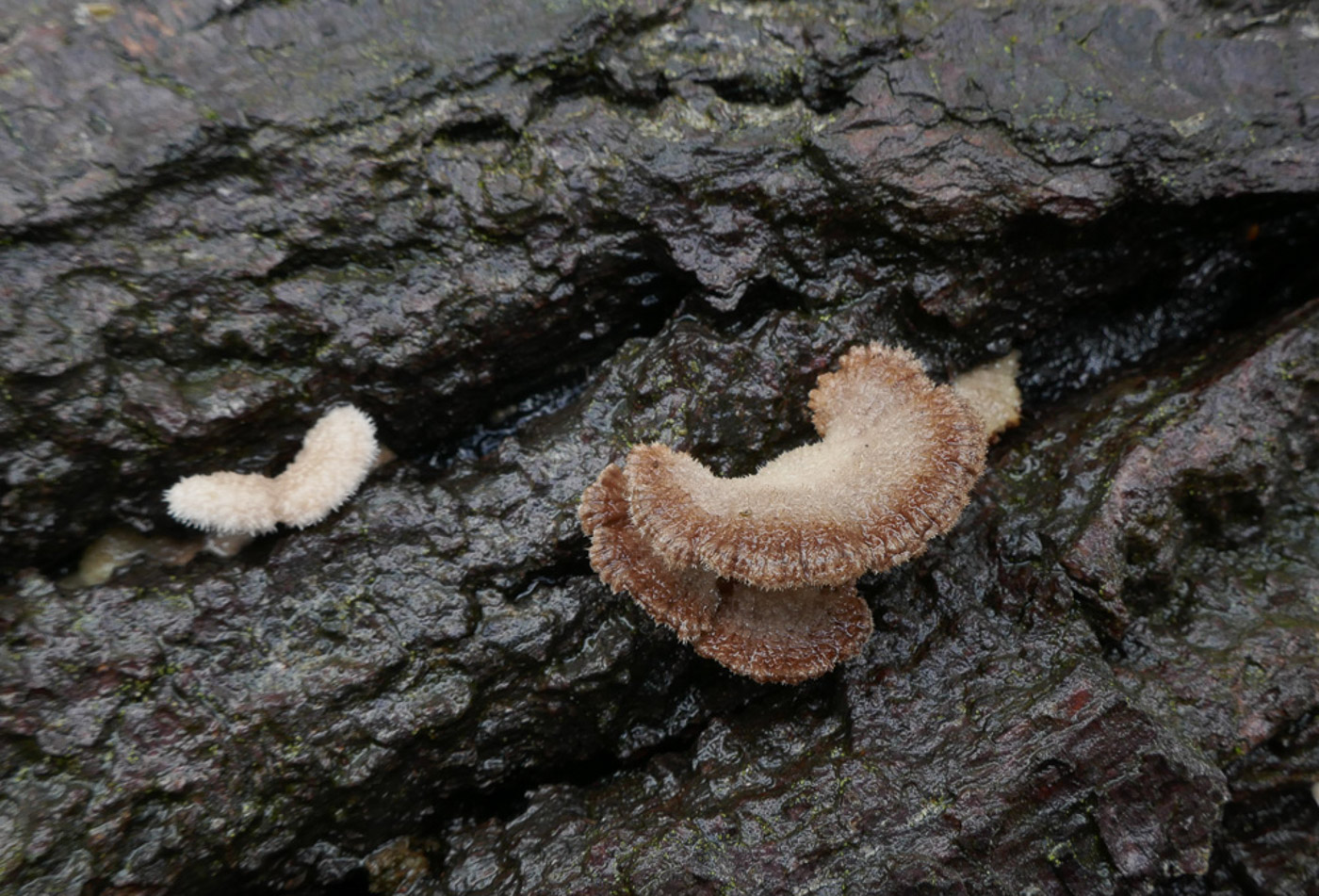
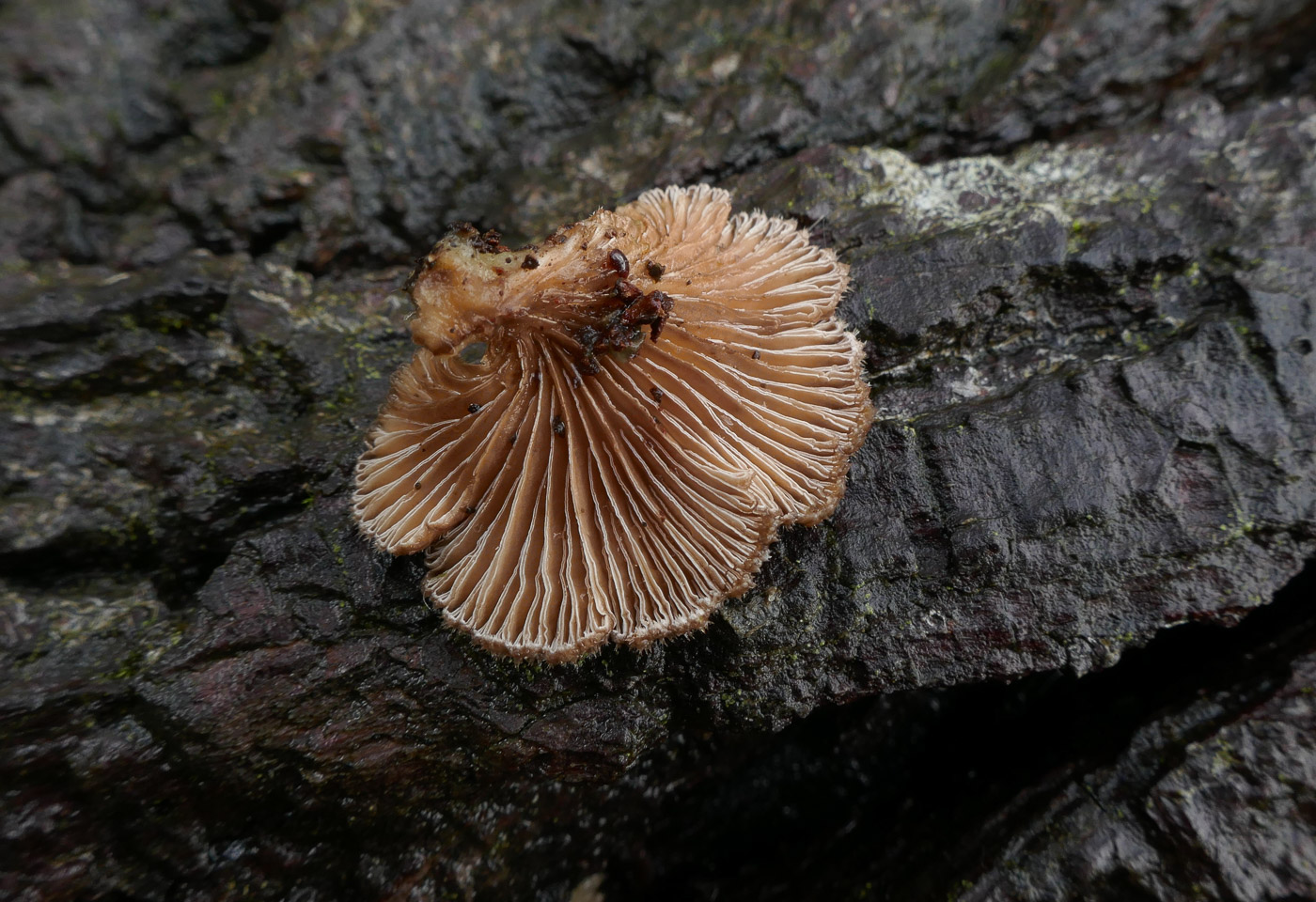
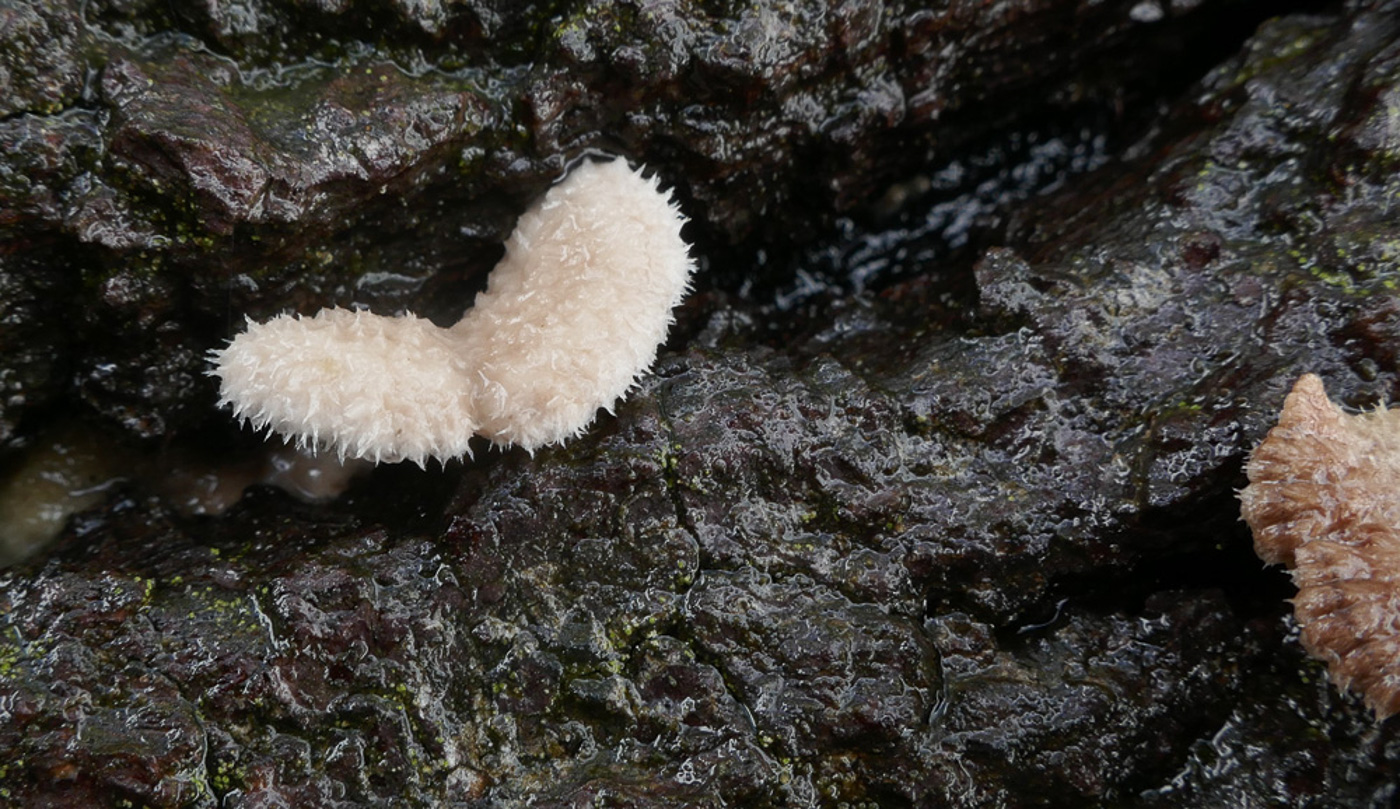 

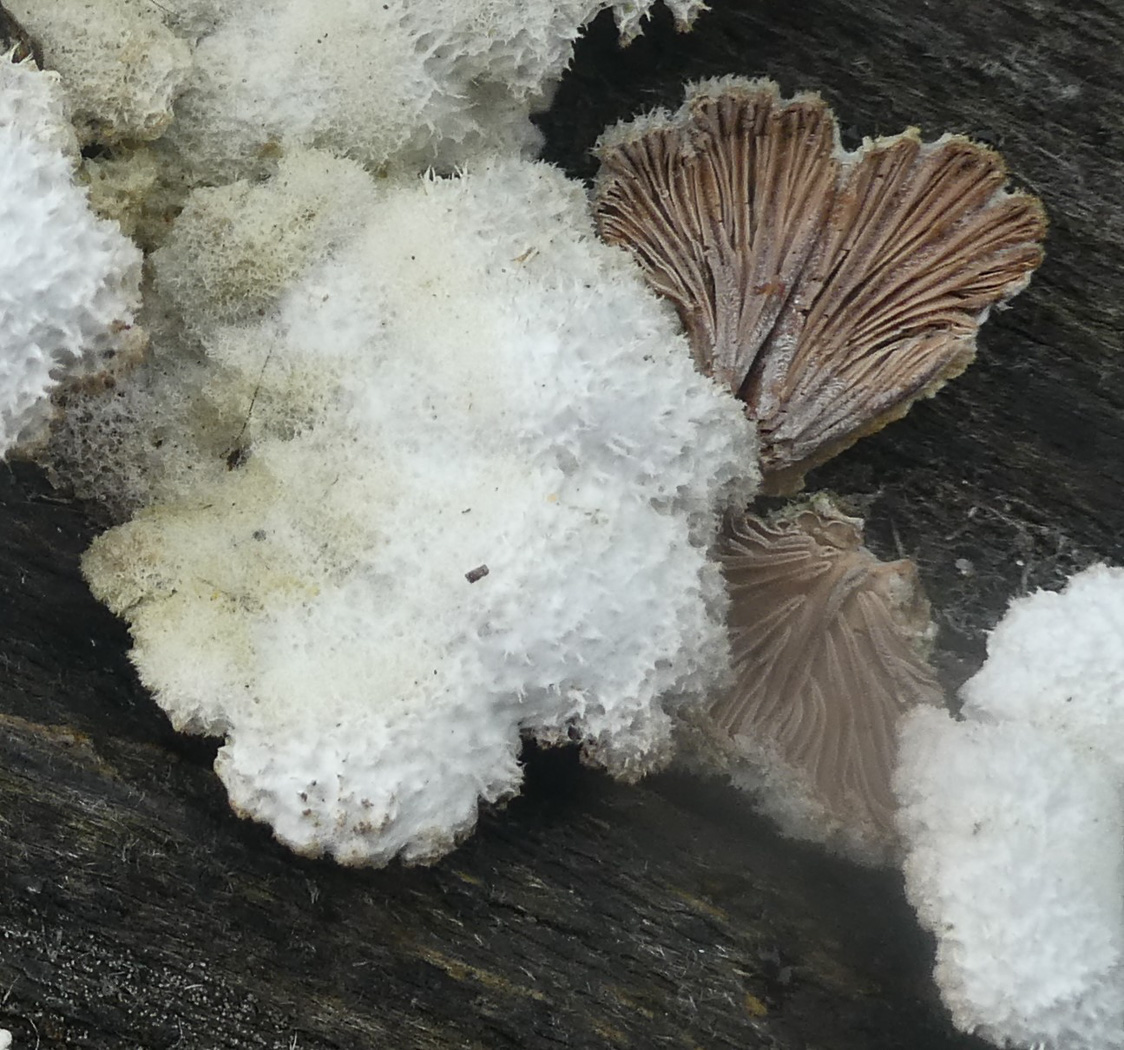
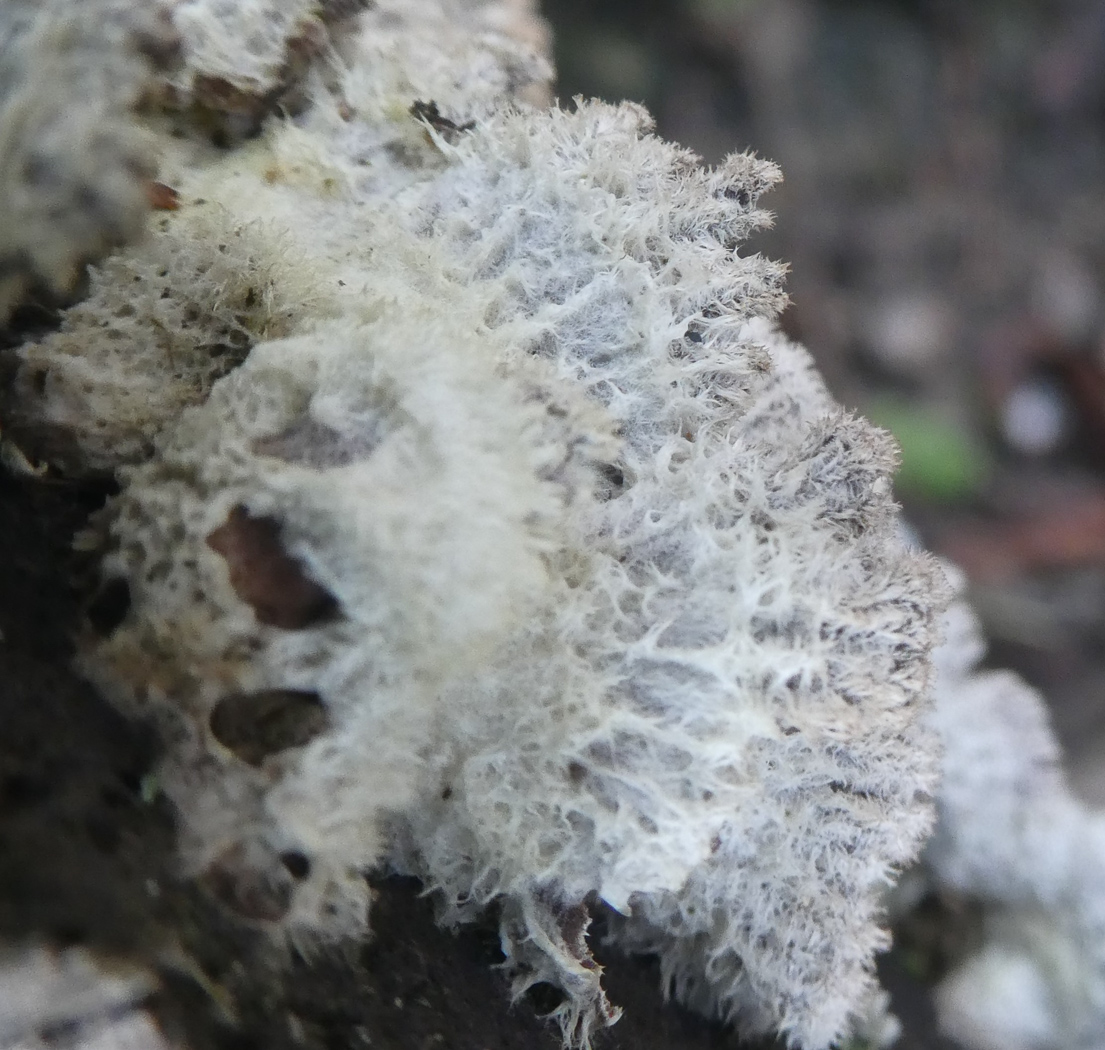
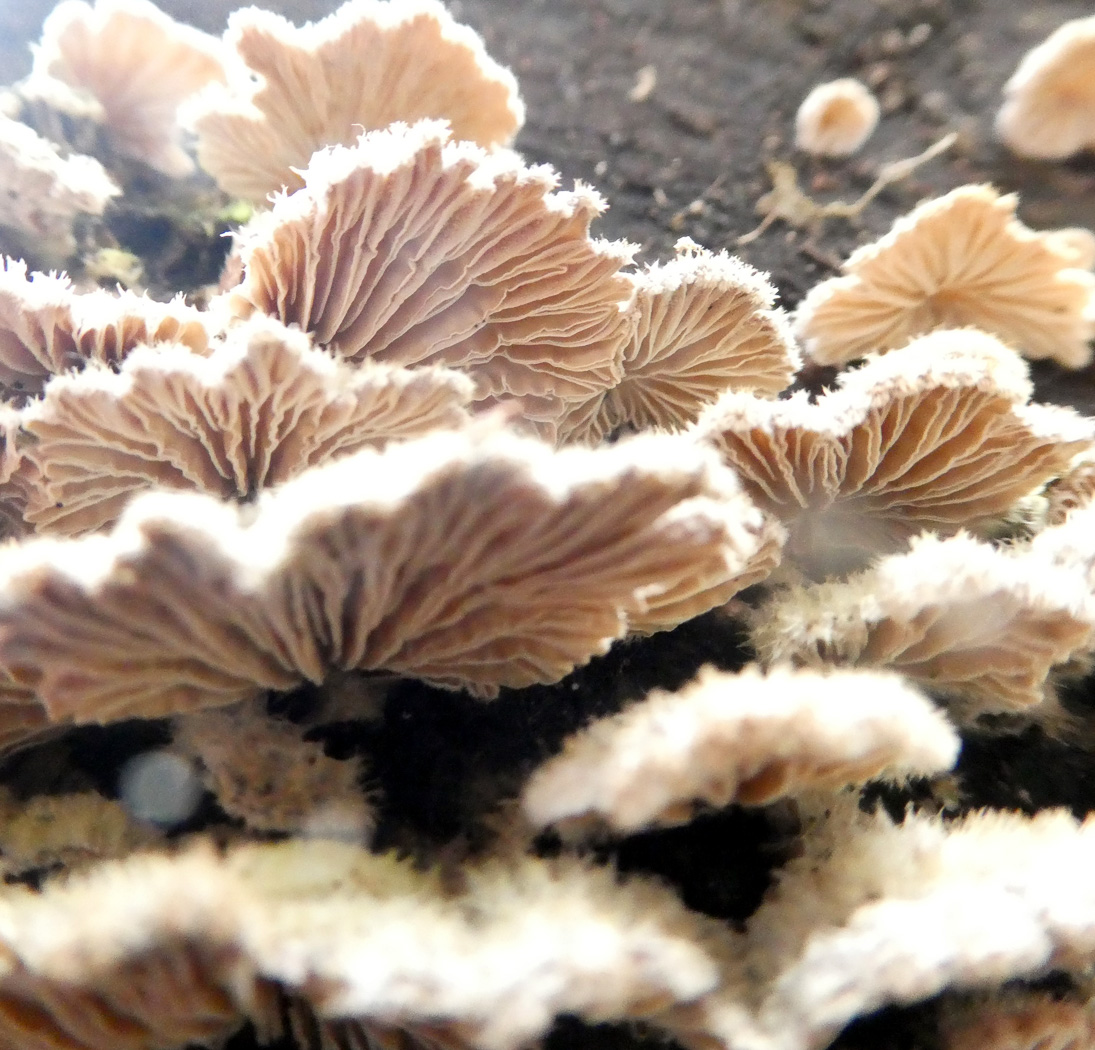
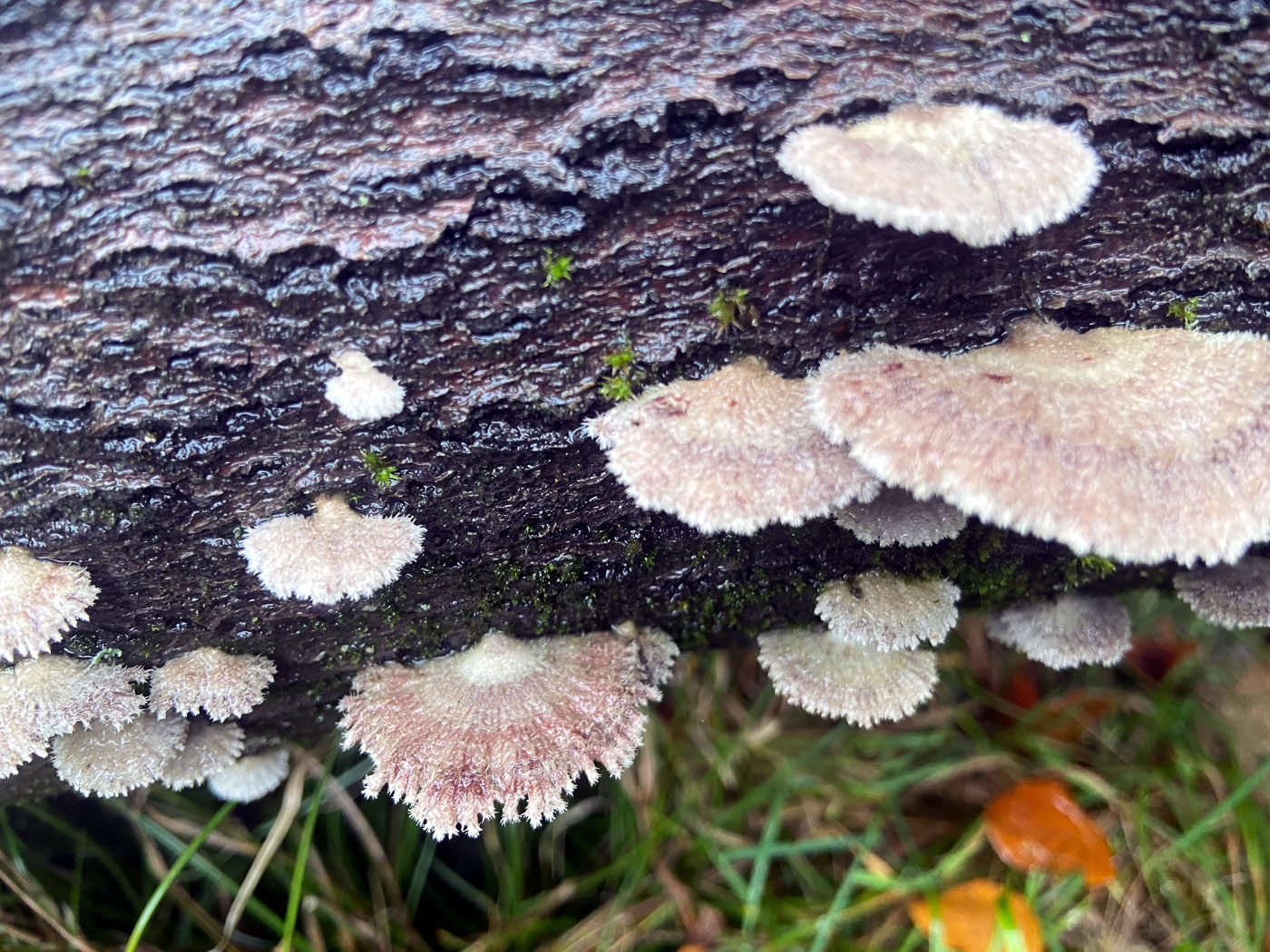
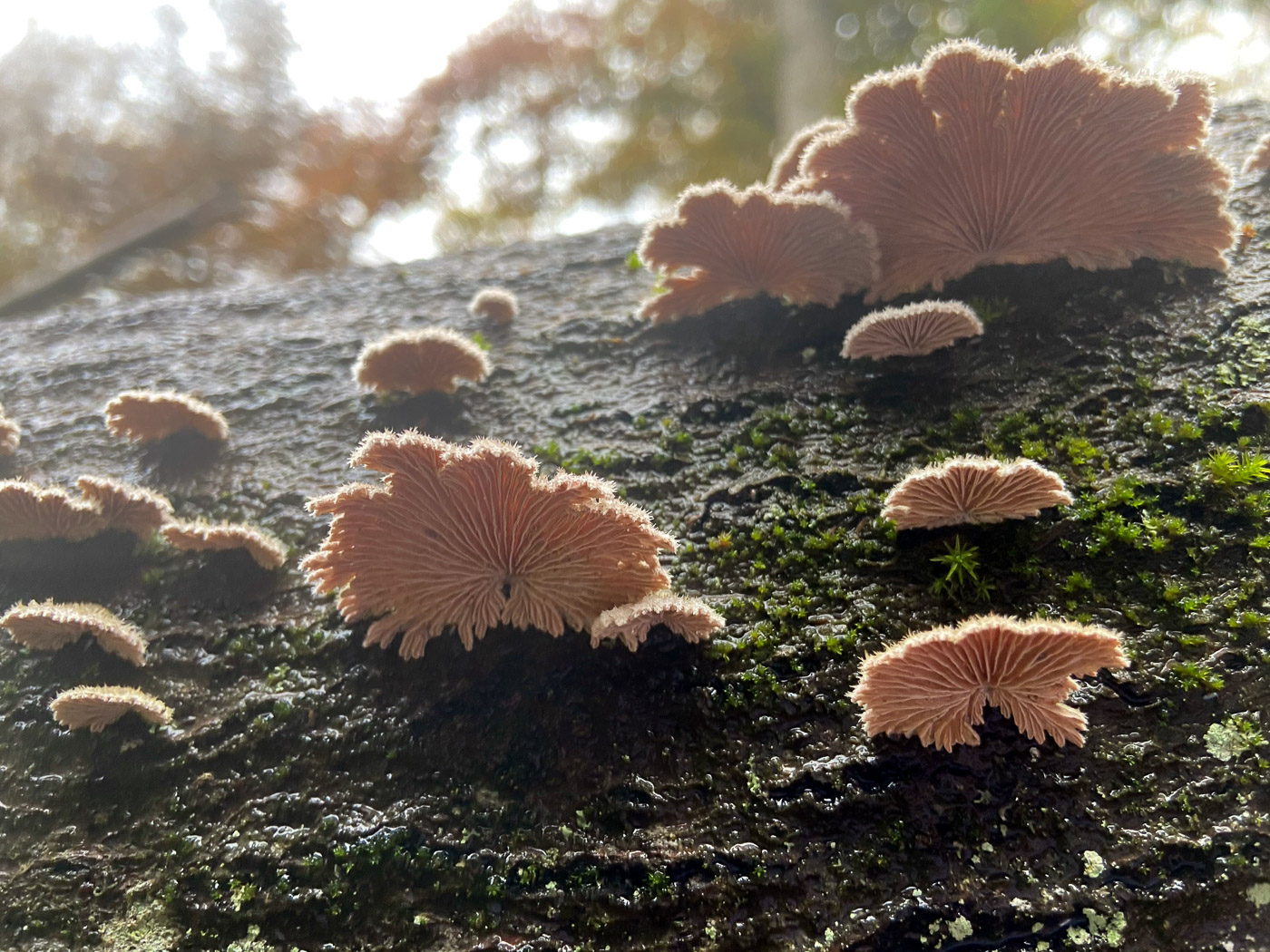
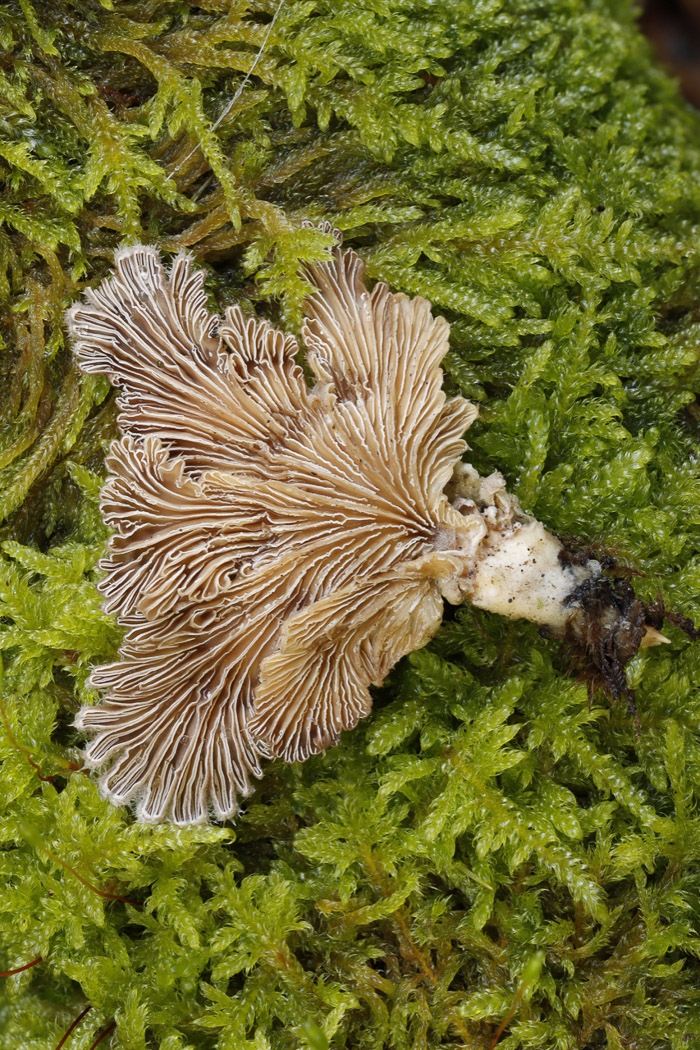
|
Schizophyllum commune (Splitgill) Sep 26, 2024. On a felled Oak trunk at Stampwell Farm Jackie Ewan noticed this species just beginning to make an appearance. The pale colour, hairy surface, halfmoon shape (rather like a hairy Crepidotus - Oysterling) and distinctive gill formation (see photo 2) make this an easy one to recognise. Photo 3 is of an immature specimen. Jan 6, 2023. On an unidentified log in Ivinghoe Paul Goby noticed this cluster and sent the photos off to Penny, correctly named. See other entries in Finds: 2020 October 29th and 2022 February 23rd, illustrating that the species can occur at any time and is quite common - an easy one to recognise once you turn it over: the fan shape is very distinctive. Feb 23, 2022. On the edge of Moorend Common Jill Wills found these attractive little lacy-edged 'fans' fruiting on several felled deciduous trunks, also on their sawn off ends. This is a distinctive species with its white to cream hairy upper surface (looking almost frosted) and pinkish fawn strongly forking gills. Oct 29, 2020. Sarah Ebdon found these rather delicate frilly and bracket-like fungi on a fallen Beech trunk in Naphill Common. This strange-looking little fungus is quite common and clusters can grow on a range of woody substrates, also bales of straw and hay in plastic, coconuts, even reportedly inside humans! More like a bracket than a mushroom, it lacks a stem and has a finely hairy surface with a white fluted edge. The pseudogills on the underside split and divide several times before reaching the margin. Each fan can reach about 3-4 cms across and once it becomes dried and shrivelled it has the remarkable property to recover and reshape after rain. Paul Goby found this same species in Naphill Common two weeks ago but Penny C. failed to recognise it at the time! Photo 3 shows Paul's excellent underside view (not his, the fungus's!!). |
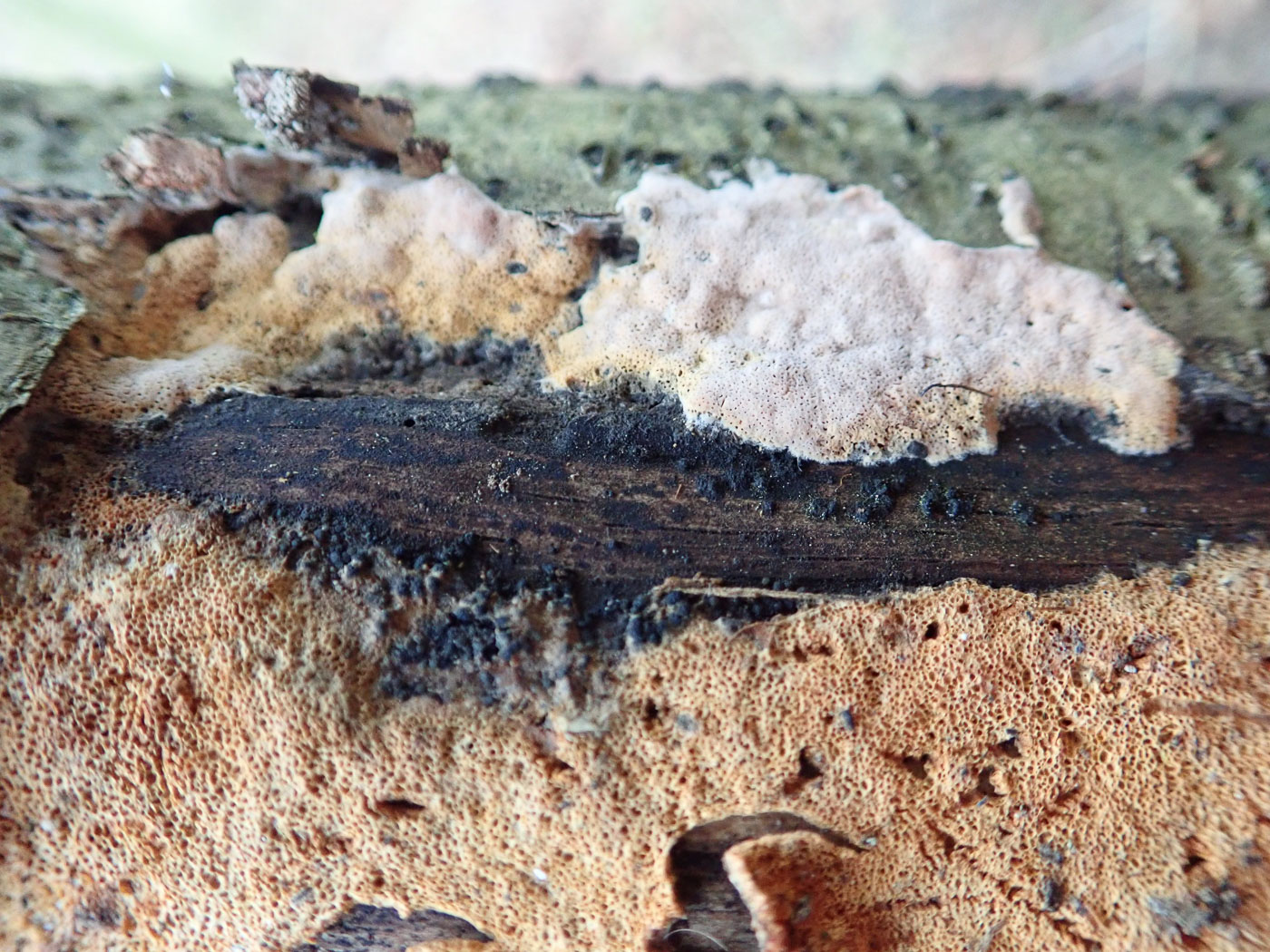
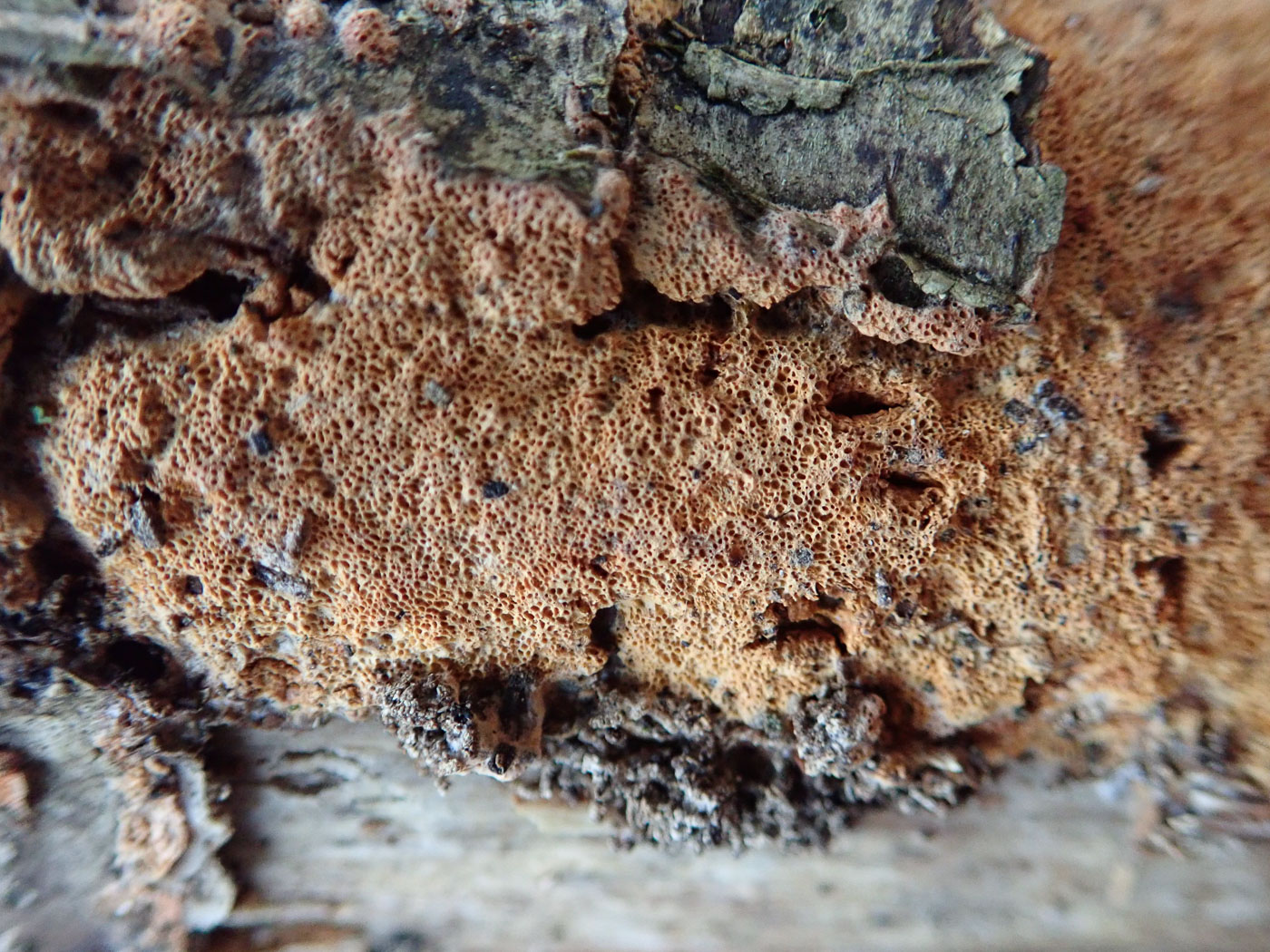
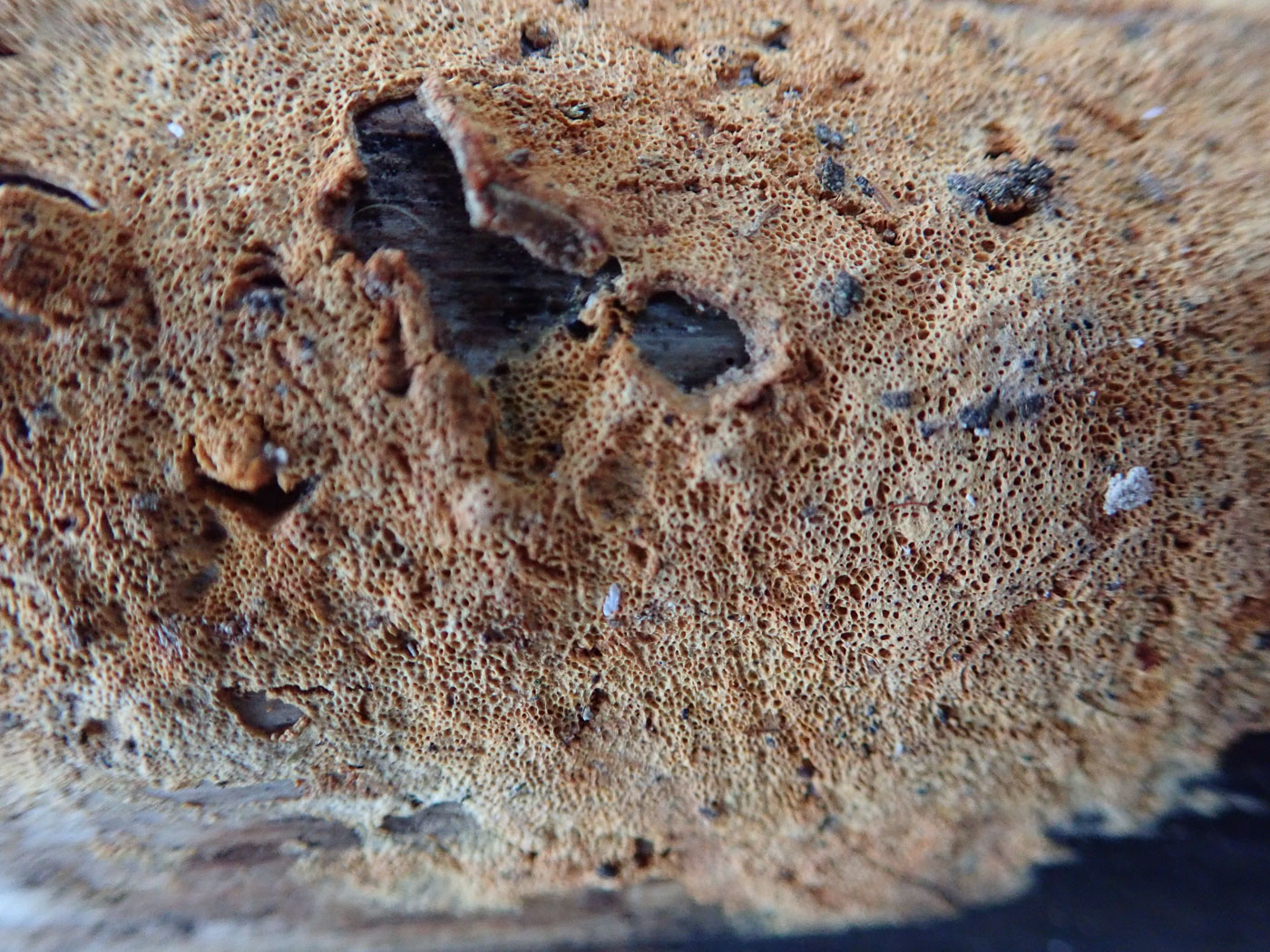
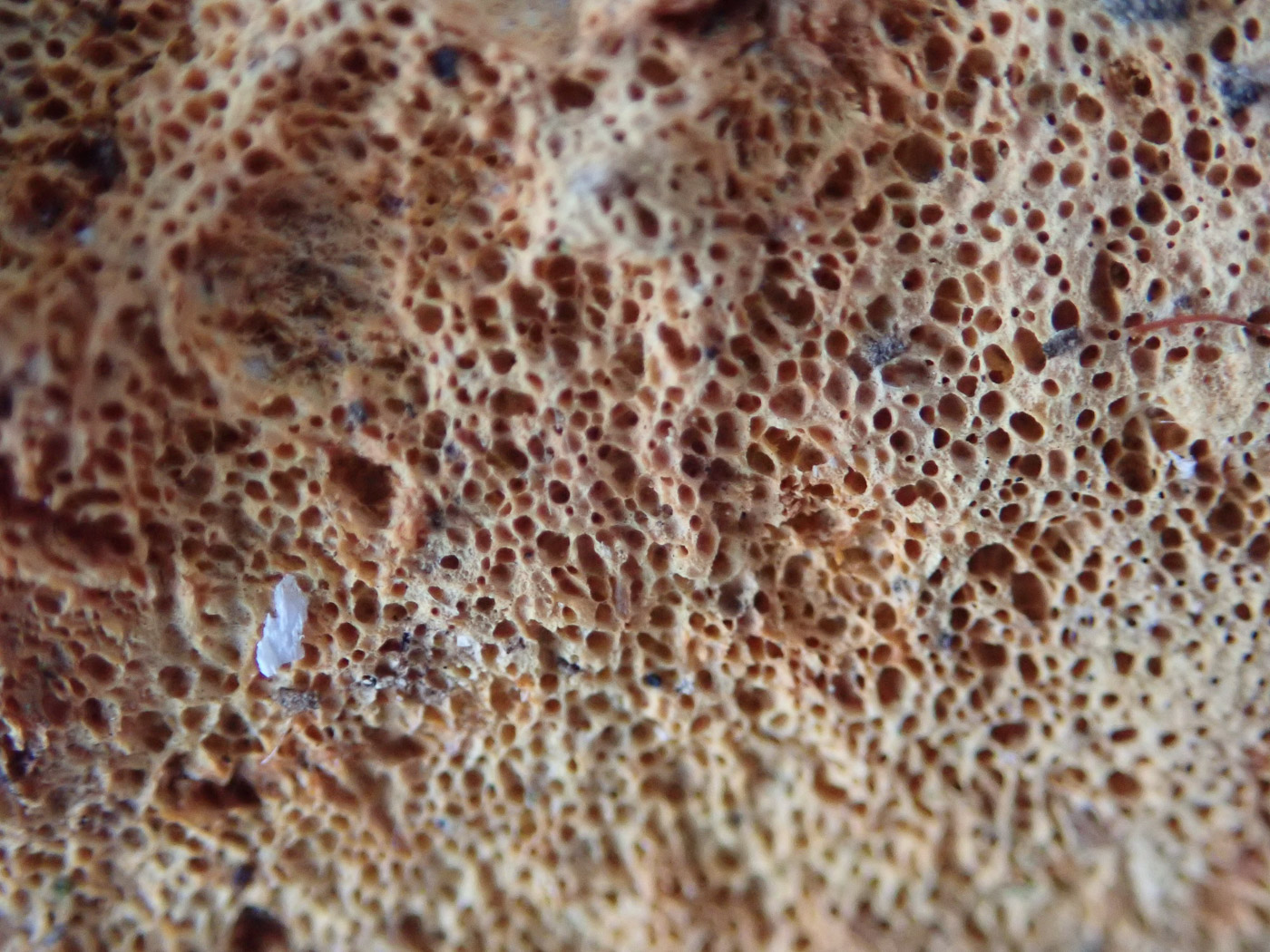 |
Schizopora flavipora (a resupinate fungus with no common name) Jan 29, 2022. In Dancersend John Tyler found this 'crust' on fallen Hazel which he didn't recognise, so sent the photos to Penny in the hope of identification. This not being Penny's strong suit, she was a bit doubtful of her skills to name it but suggested it was possibly Schizopora flavipora, then sent John's photos off for expert Alan Lucas's opinion. He agreed that this was correct, adding the comment that as it was not that rare it was not going to be controversial to record it without a microscopic check. The species is closely related and very similar to the extremely common and also very variable S. paradoxa (Split Porecrust) but is far less common, in fact we appear to have just one previous record. This could in part be due to the fact that we often identify S. paradoxa in the field without checking if it might possibly be S. flavipora which has smaller spores, though it does become a recognisably more distinct buff to almost orange colour as seen here. |

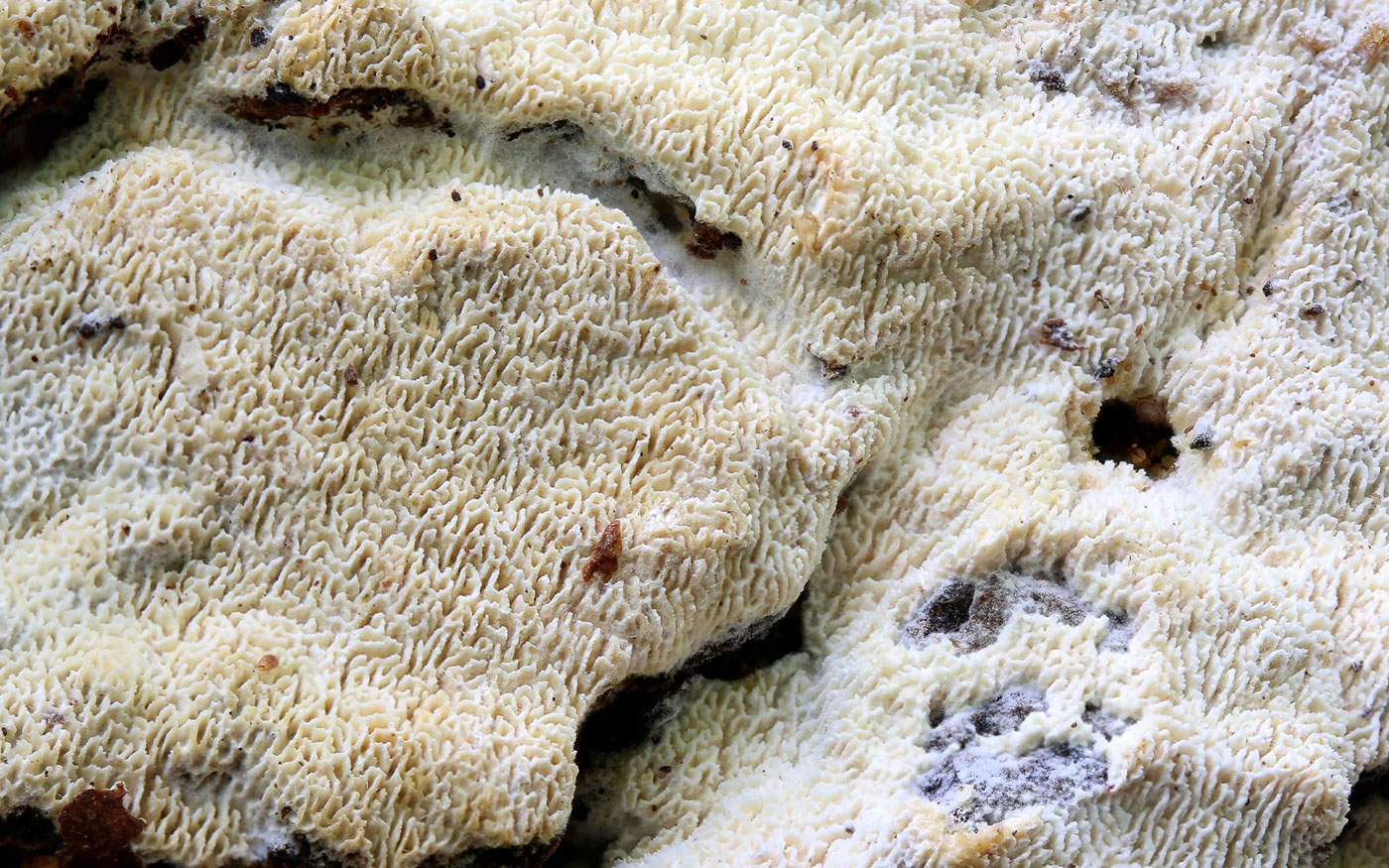
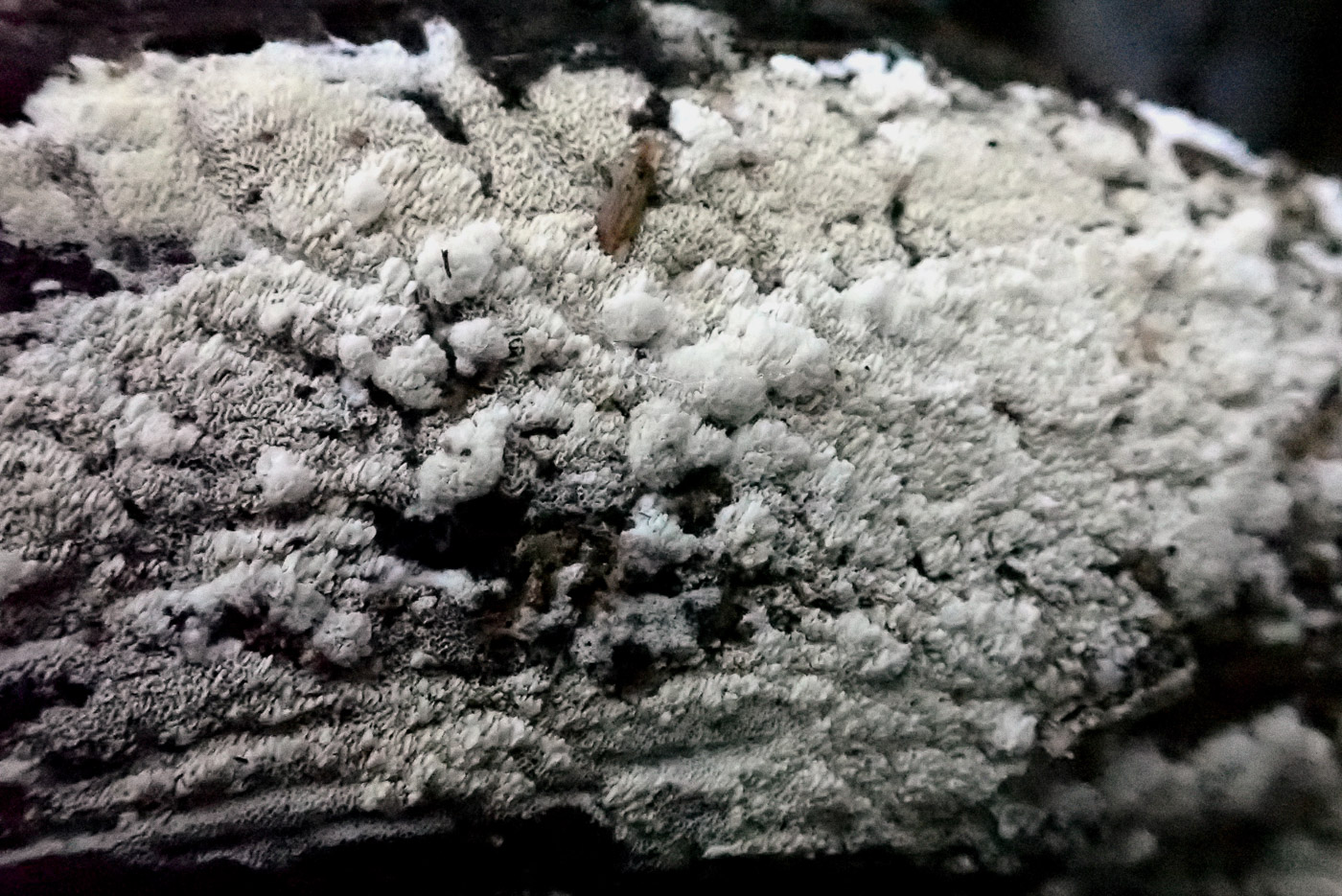
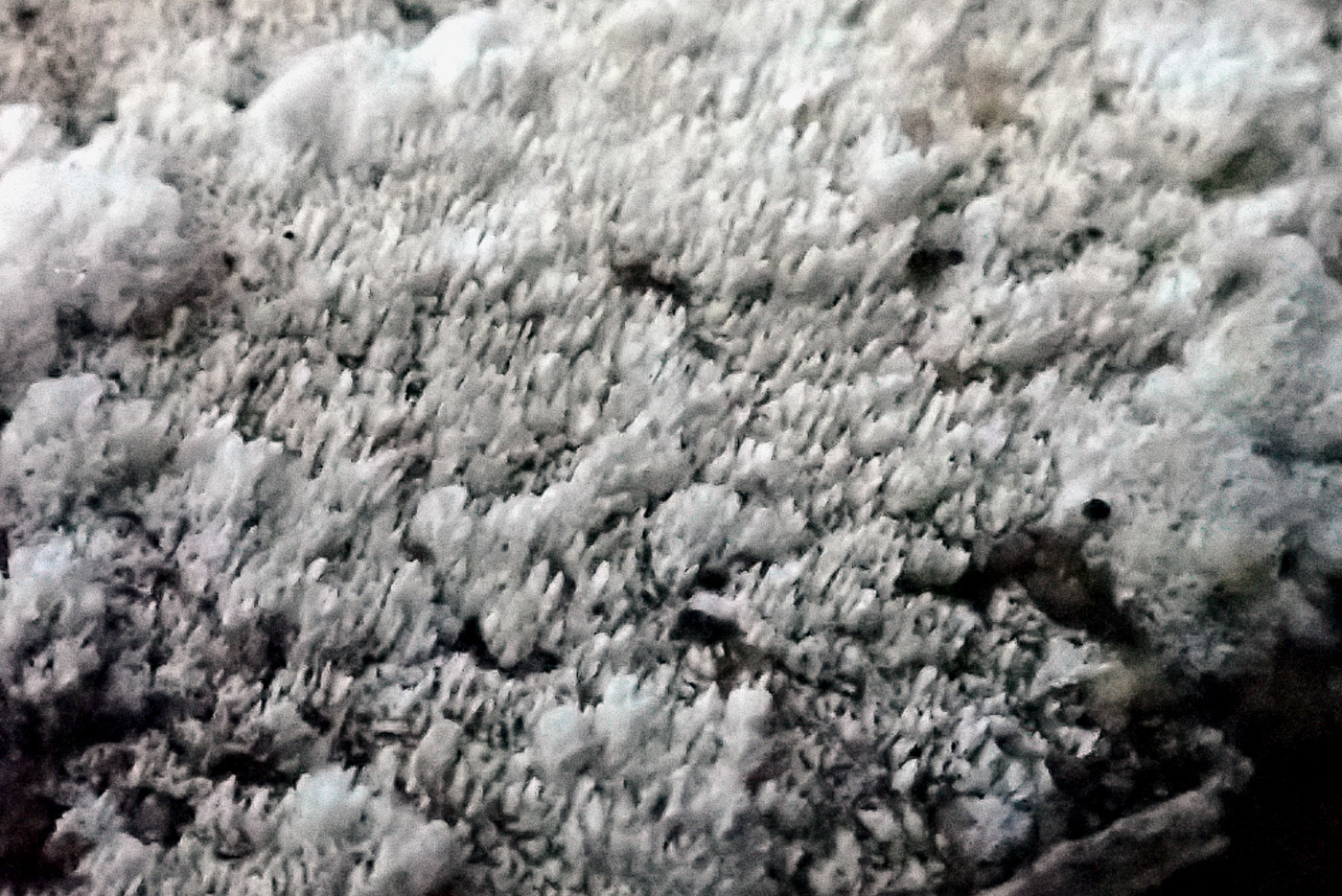
|
Schizopora paradoxa (Split Porecrust) Jul 7, 2023. In Gerrards Cross Common Jim Wills found this poroid corticioid species on very well rotted hardwood. It is possibly our commonest corticioids, occurring on fallen deciduous sticks and branches everywhere, though the closely related S. flavipora is extremely similar and apparently quite rare and possibly mistaken in the field but has smaller spores. See also in Finds 2020 December 07 and 2021 May 10, also S. flavispora for comparison in 2022 January 29th. May 19, 2021. At Burnham Beeches Claudi Soler together with Derek Schafer and Kerry Robinson found this quite common resupinate fungus on fallen Oak though it occurs on the wood of many other deciduous trees. Features to look for to identify it are the obvious irregularly poroid surface which bruises brownish when touched (if fresh) - this can just be seen in the centre of this specimen, and its tendency to form a 'semi-bracket' - also seen here. Furthermore it notably peels away easily from the substrate. Dec 7, 2020. In Penn Wood Penny C. found a pile of fallen deciduous wood, knowing that this very common resupinate species - one not yet on our list - was very likely to be present somewhere. Sure enough there were several large patches tightly covering the dead wood, probably Beech on which the species is extremely common. The creamy white pore surface (which is on the outside as it does not form brackets) is very variable: mazelike and roughened to almost toothlike. |
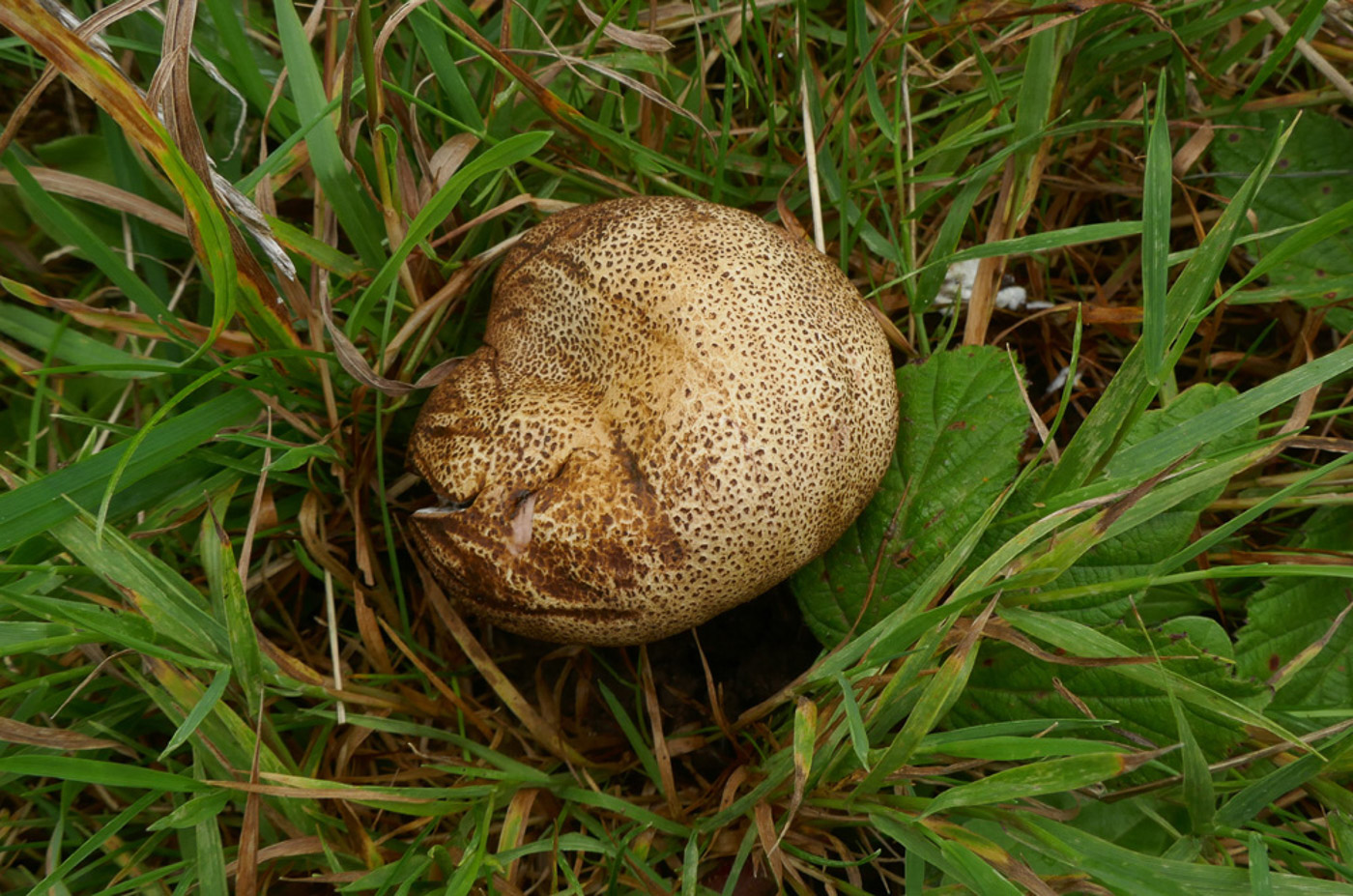
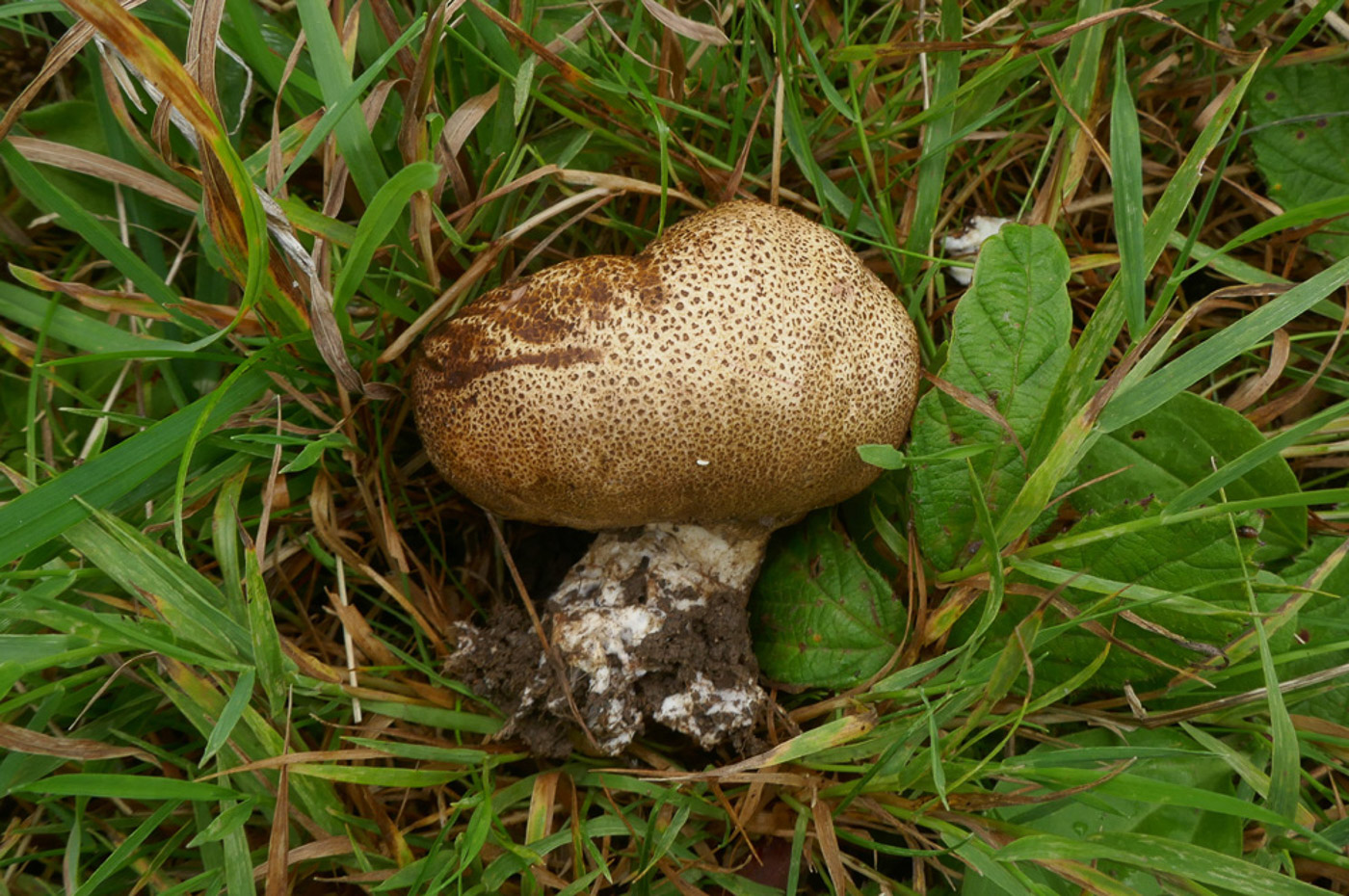 |
Scleroderma areolatum (Leopard Earthball) Sep 25, 2024. At Stampwell Farm under Oak Jackie Ewan noticed this species, recognising it from markings on the surface similar to that of a leopardskin. However, some collections are not so obviously marked and can easily be confused with the somewhat similar S. verrucosum (Scaly Earthball). In fact we regularly have debates in the field comparing the two species and many mycologists would argue that it's unsafe to decide purely from the markings without recourse to a scope to compare the spores. |
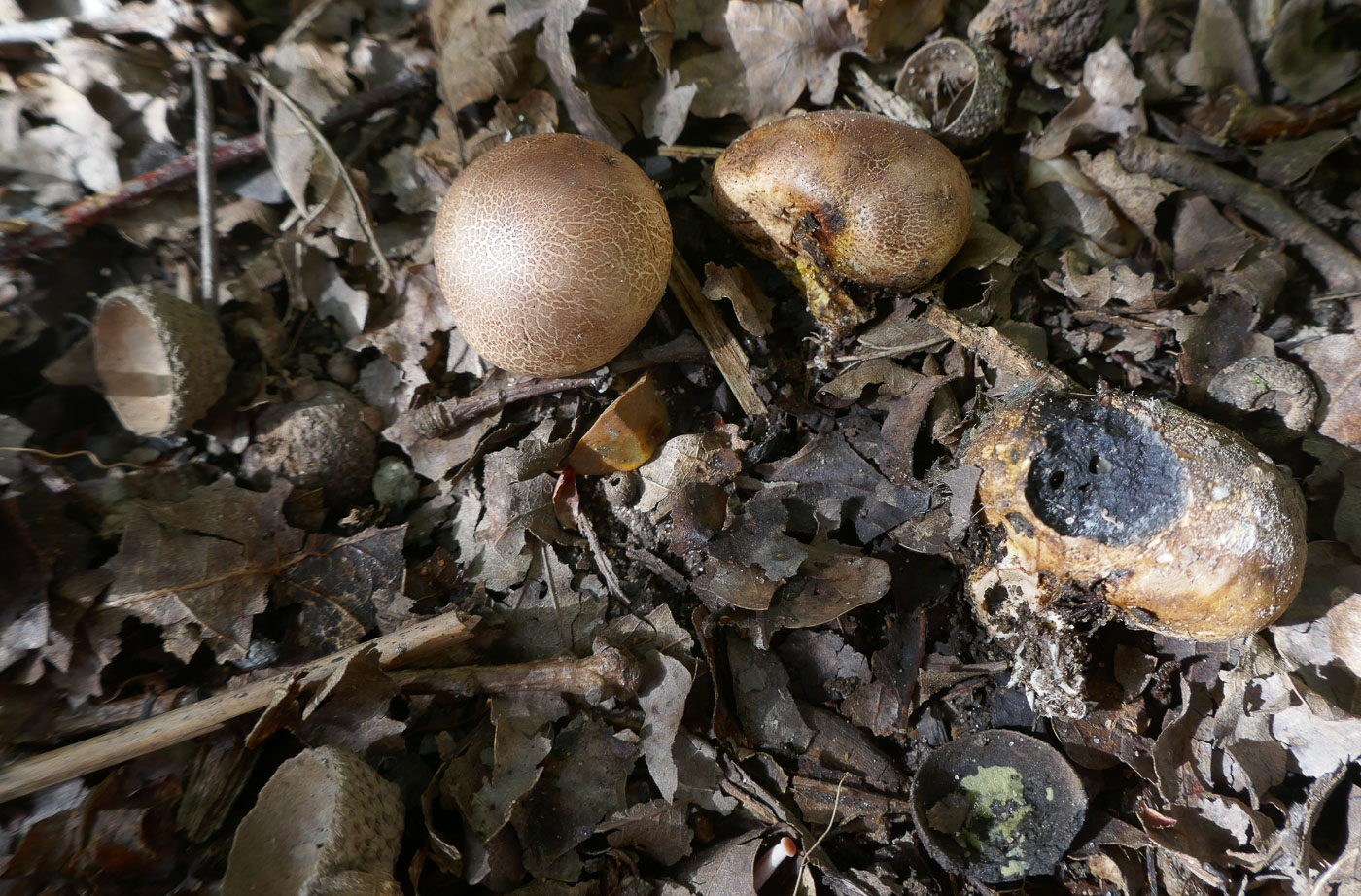
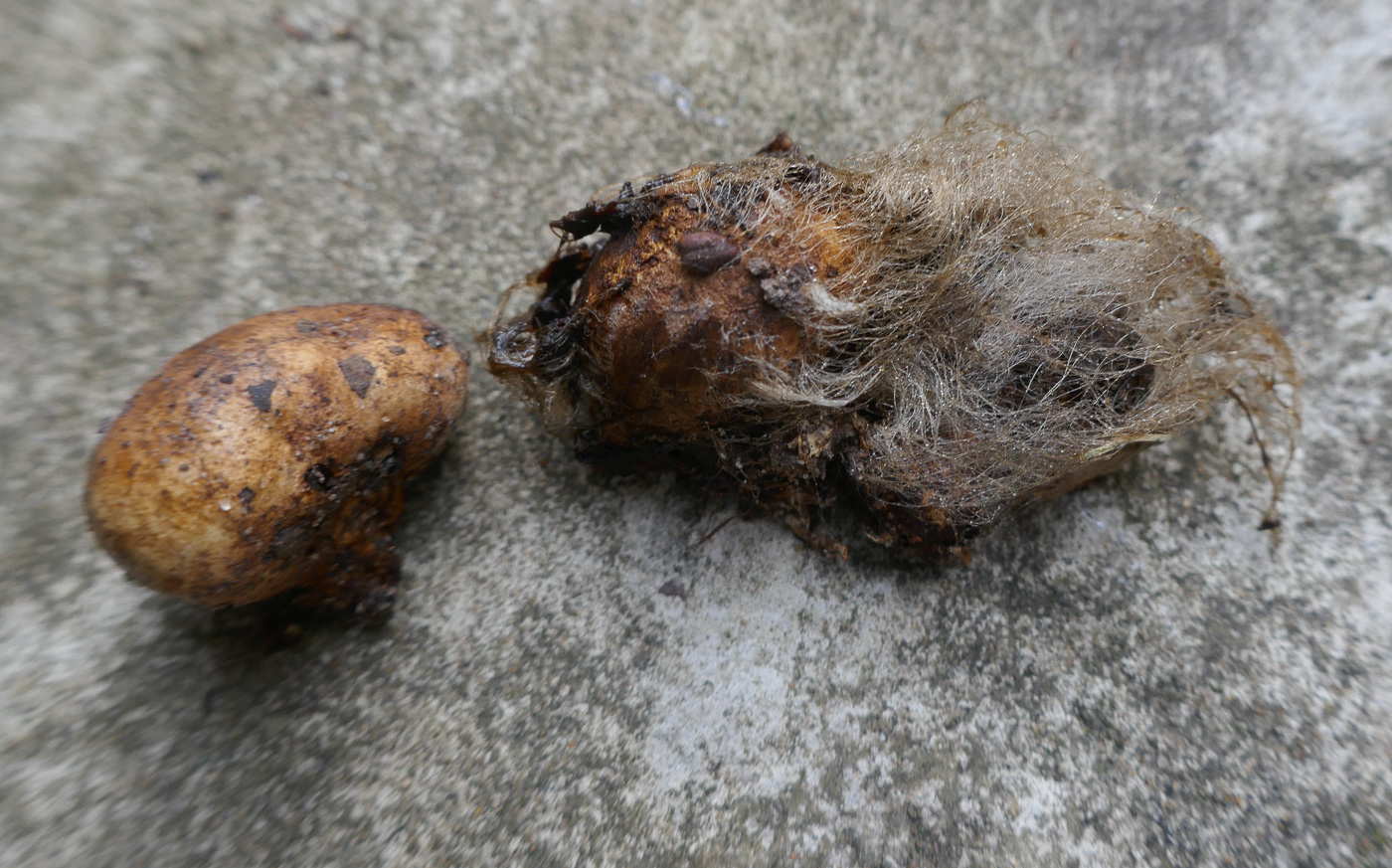 
 |
Scleroderma bovista (Potato Earthball) Sep 13, 2024. Under Oak at Stampwell Farm Jackie Ewan found these small Earthballs, much smoother and usually with a less distinct stem compared to both S. verrucosum and S. areolatum. Jackie commented that the outer surface turned red on damaging though Penny finds this is not that useful a pointer to species as both the other two species can also react in that way. The microscopic differences – both spore ornamentation and presence of clamps - are definitive for this species, however. It certainly has a resemblance to a potato which also helps! Photo 2 shows a remarkable sprouting of fine 'hairs' which developed after the specimen had been retained in a pot for a few days! Sep 26, 2023. In longish grass under Oak at Turville Heath Penny nearly missed this specimen, then did a second take and realised it was not one of the species we regularly record. It was almost entirely smooth and had a rooting base and luckily when examined at home was mature enough to have spores within. These were ornamented with a clear reticulation rather than isolated spines as in S. verrucosum or S. areolatum, also a thin sliver of the thick outer skin revealed clamps - absent in the other two species and confirming this was S. bovista. Not rare but favouring parkland rather than woodland, hence its o |
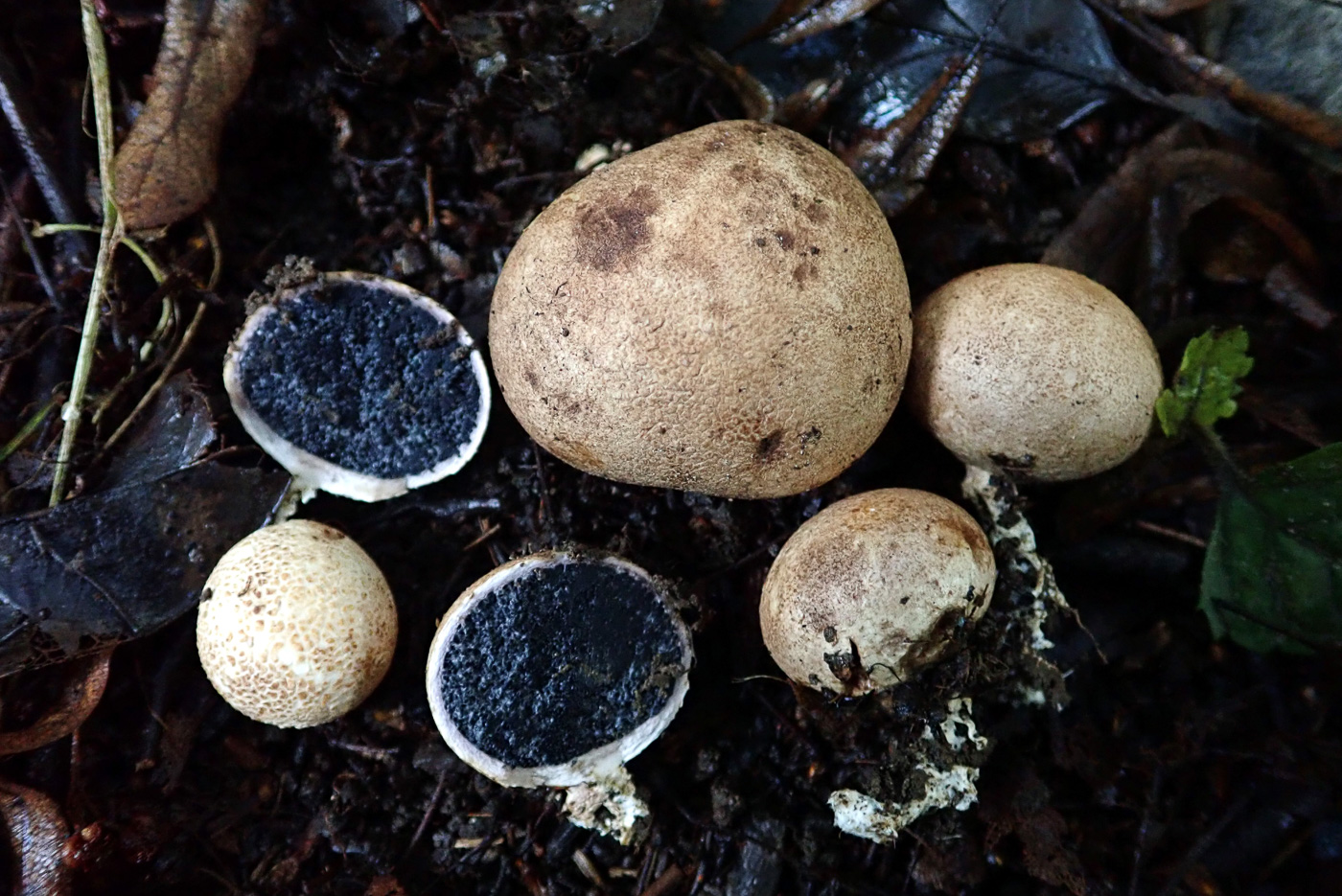
|
Scleroderma cepa (Onion Earthball) Oct 1, 2020. This quite unusual Earthball was found under Lime at Turville Heath by Penny Cullington. The species is less scaly than our three common species - S. citrinum (see Sept 20), S. areolatum and S. verrucosum (see Sept 19) - having a pale slightly roughened surface, and prefers sandy soils usually under Oak (though not in this case). Note the typical thick skin and dark undeveloped spore mass within when cut in half - differing from Puffballs with which this genus is sometimes confused |
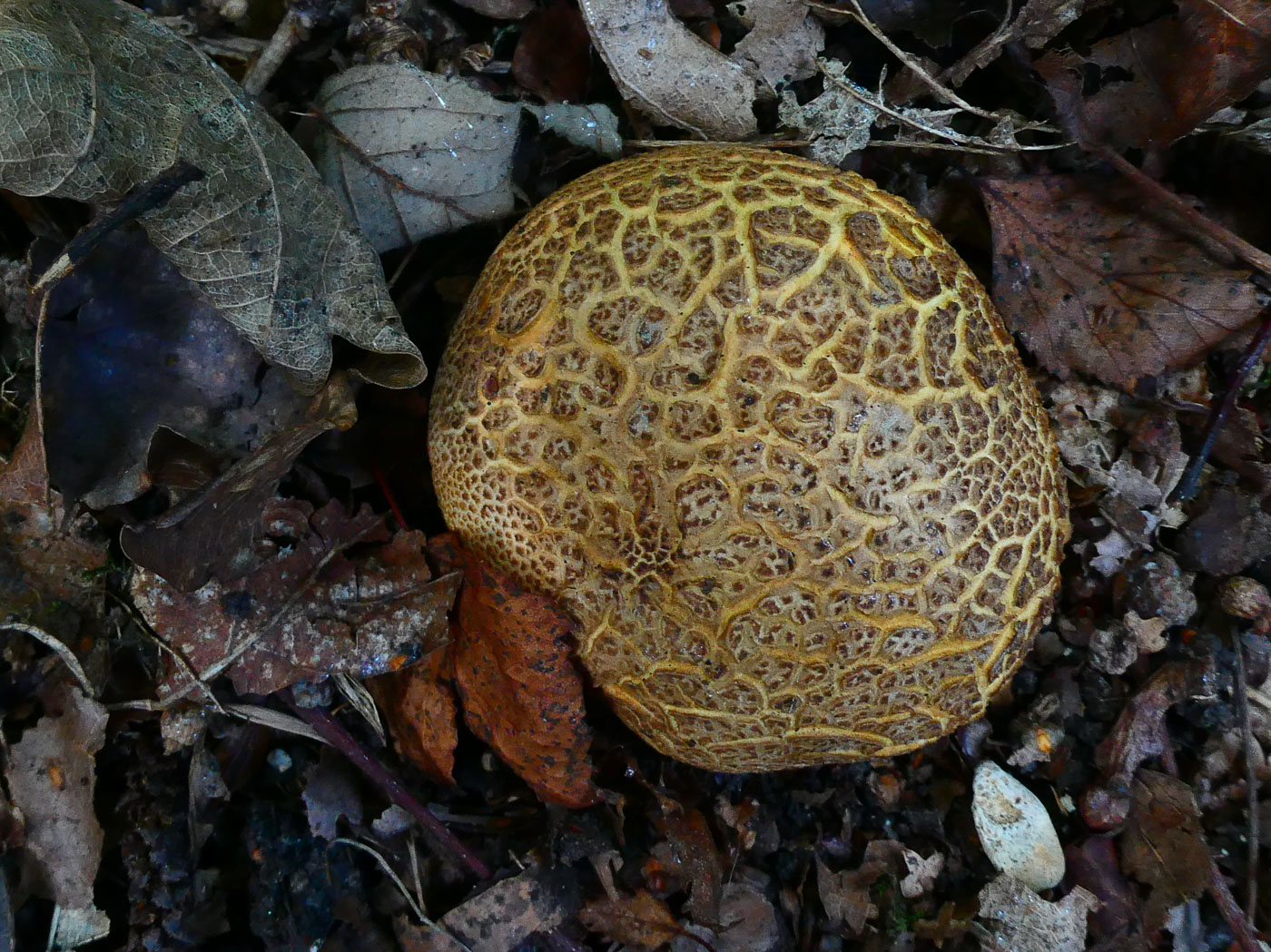
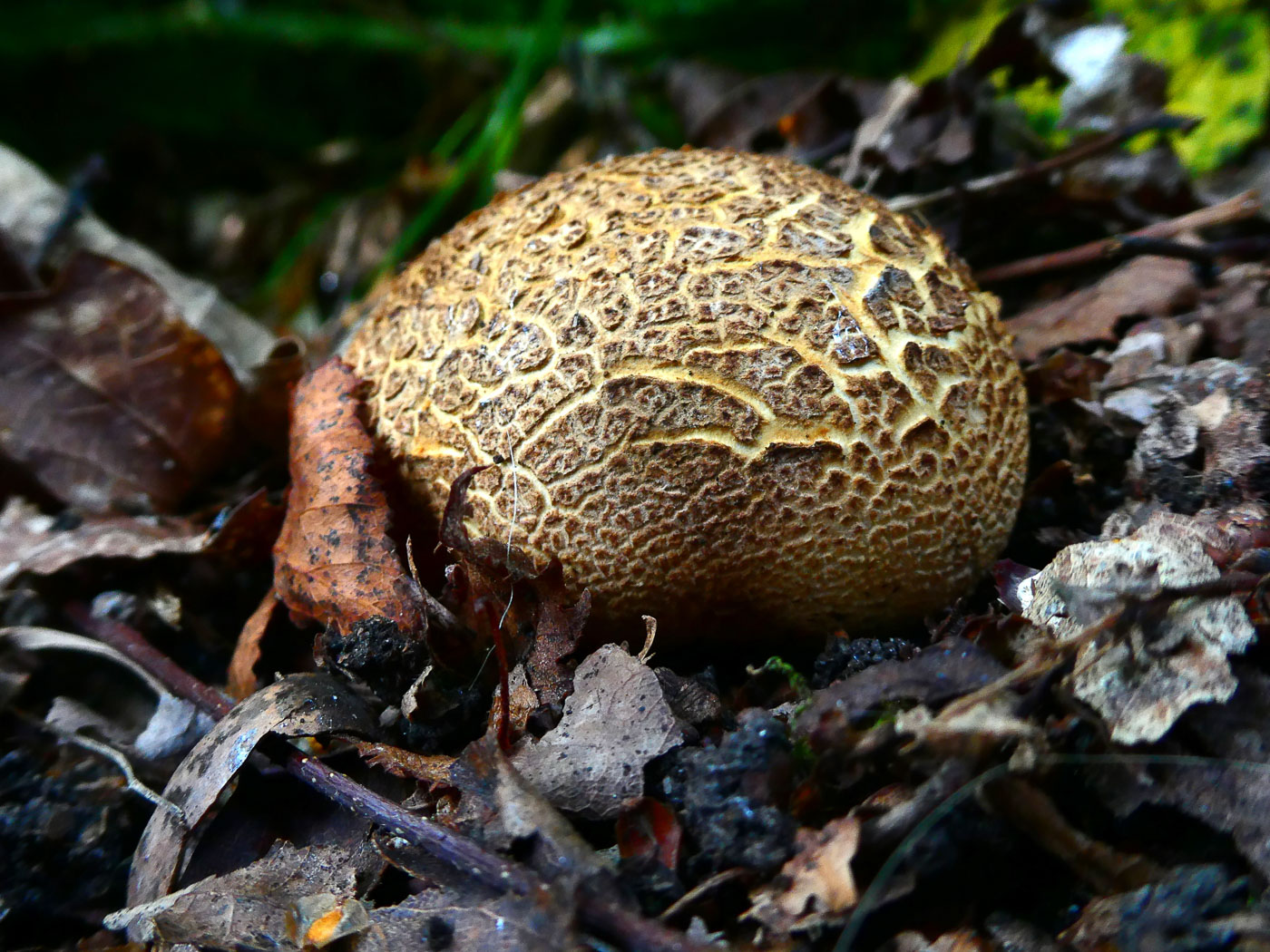
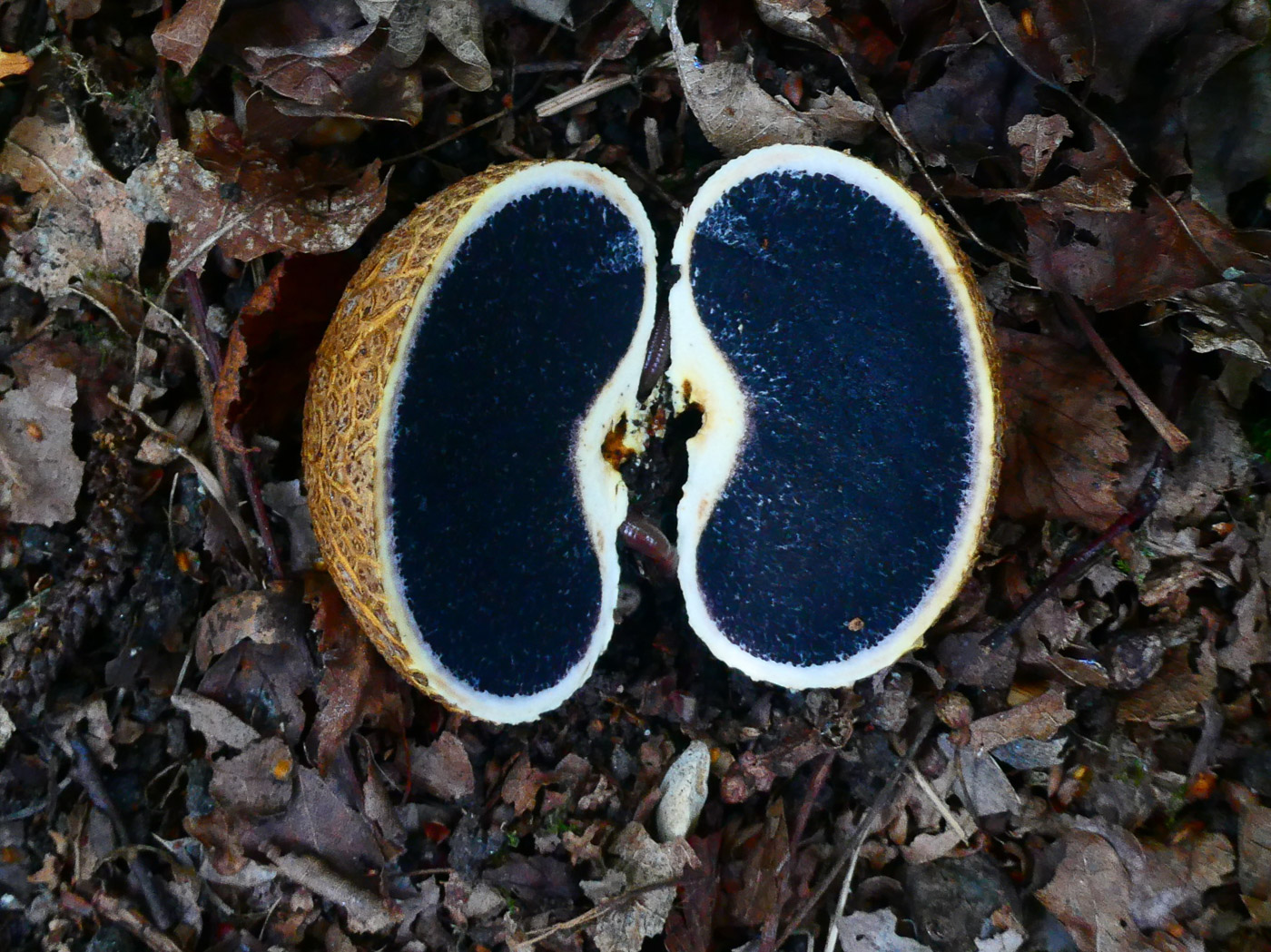 

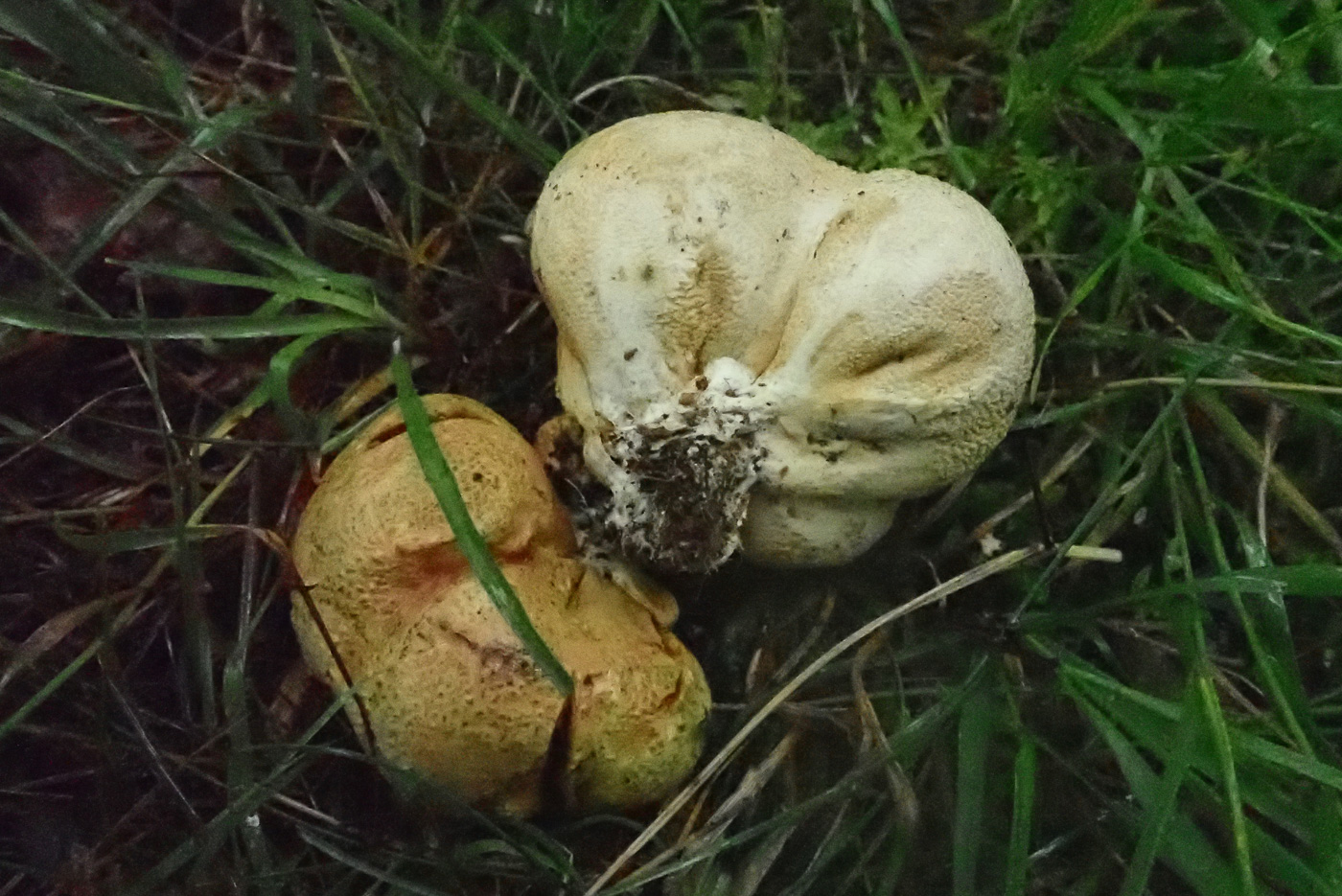
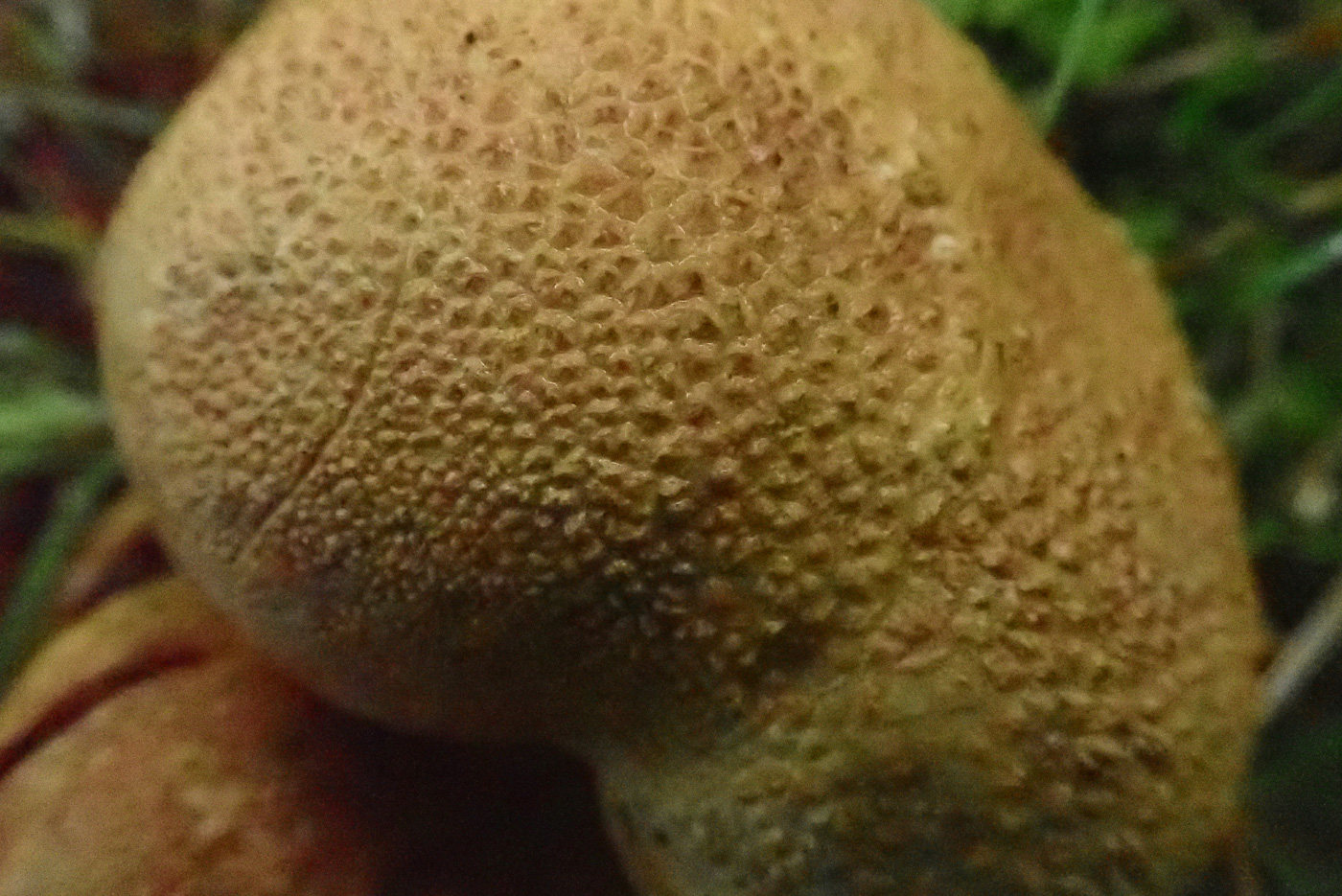
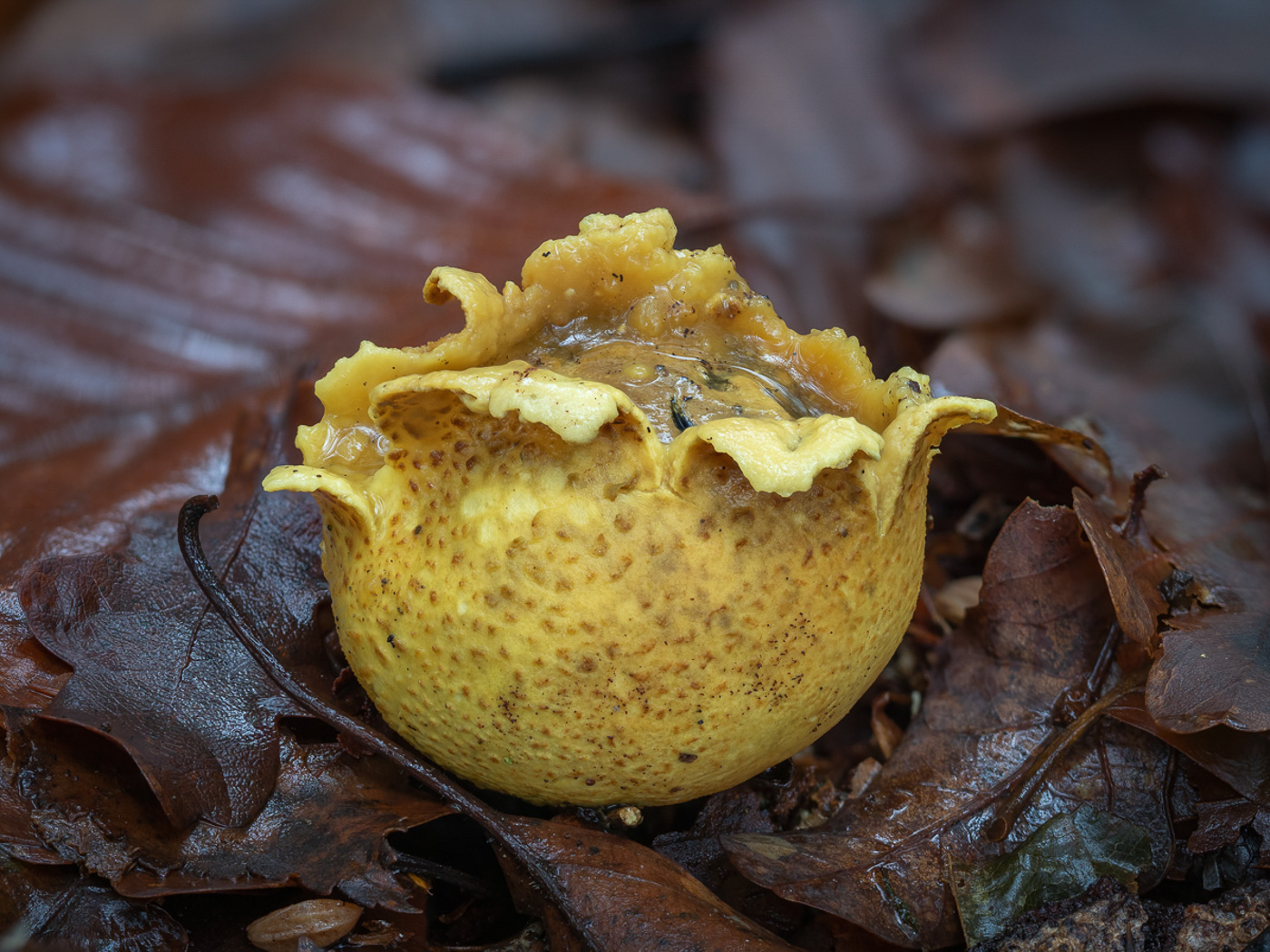
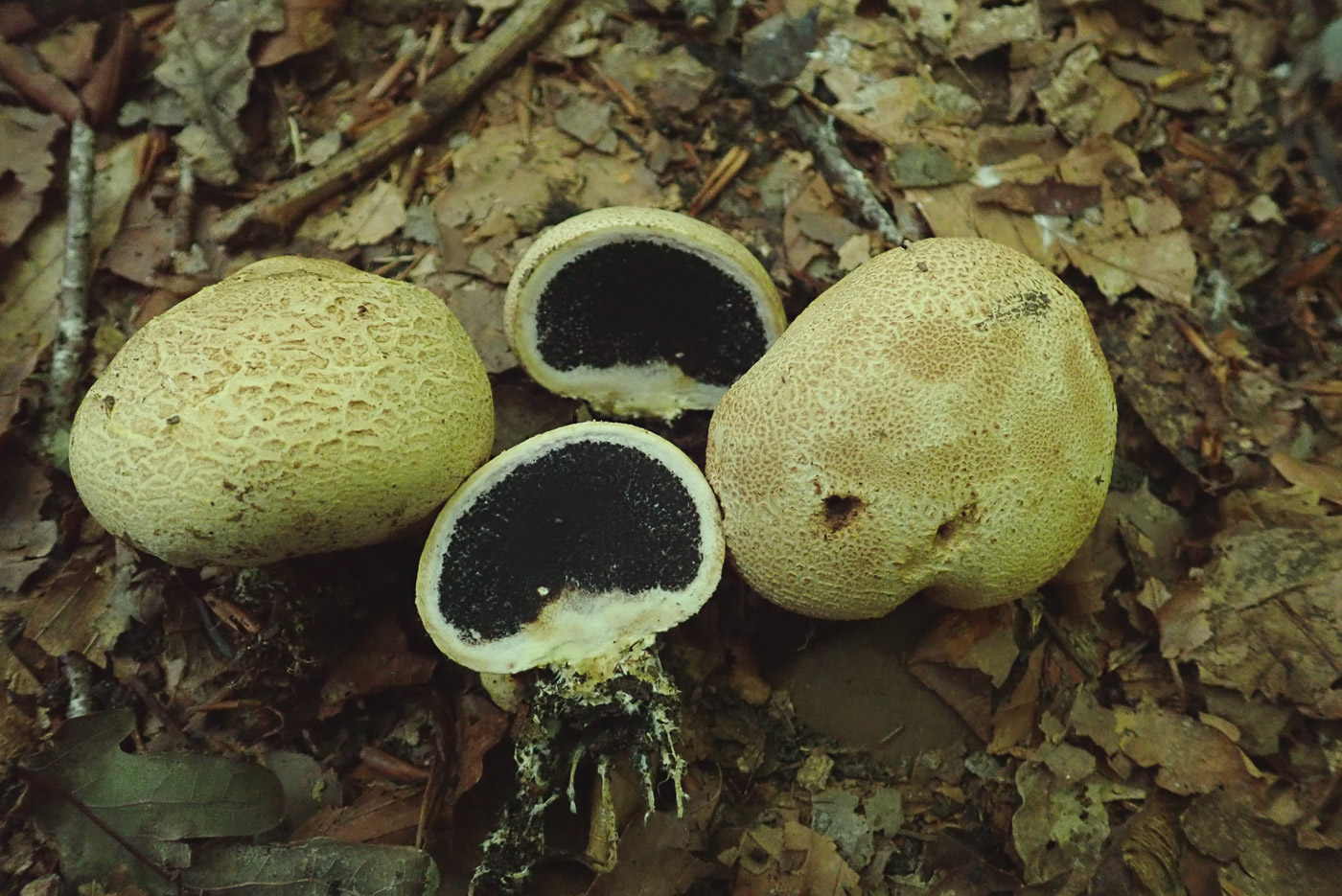
|
Scleroderma citrinum (Common Earthball) Aug 12, 2024. On Goldhill Common under Oak and Birch Jim Wills found this species fruiting in good numbers. The tough scaly surface together with its thick skin and almost black interior when sliced open (when an unpleasant rubbery smell is apparent) help to separate it from other species of Earthball. Jul 23, 2023. Jim Wills found this common species (also other Earthballs) now beginning to pop up in many places in Gerrards Cross Common. Though often with a yellower colour than seen here, the large distinct scales, lack of stem and notably thick skin (up to 3mm in places) made Jim fairly sure of his ID. For confirmation he then with a scope checked and found clamps in the skin (lacking in both S. areolatum and S. verrucosum). Look for this genus under Oak with which it often associates. Jul 28, 2021. In Burnham Beeches several specimens of this species were just beginning to appear, this pair found by Gill Ferguson in longish grass under Birch and Oak. Told from other Earthballs by its pale ochre (hardly lemon yellow!) colour, its very tough leathery skin which soon develops a rough scaly surface and a rudimentary stem (see photo 2). It has an unpleasant smell and can get much larger than other species - up to 10(15)cms across when often misshapen. If you find it, look out for the Parasitic Bolete growing out from around its base, sometimes in clusters - an unusual sight. (The photo here is Penny's) Feb 1, 2021. In Burnham Beeches Barry Webb found this Earthball growing in soil amongst deciduous litter. Normally found fruiting from late Summer through the Autumn, this is an unusual find for early Spring to say the least! Distinguished in the field from others in the genus by its combination of yellow colour and rough scaly surface, it typically splits wide open as seen here to disperse its spores aided by raindrops or air movement. Sep 20, 2020. This collection was growing under Oak at Pullingshill Wood, found by Penny Cullington. Our second Earthball photo, this species is the easiest in the genus to recognise as it's our only yellow Earthball. These were young specimens, only about 4 cm across, but they can get considerably larger and also considerably more roughened and scalier. Note (a) the thick rindlike skin and (b) the contrasting dark inner part even when young, visible in the specimen cut in half, both features which help to separate Earthballs from Puffballs which have a thin skin and are white inside when young (though do go darker inside when mature). Earthballs have a strong rubbery smell whereas Puffballs have a pleasant 'mushroomy' smell. |
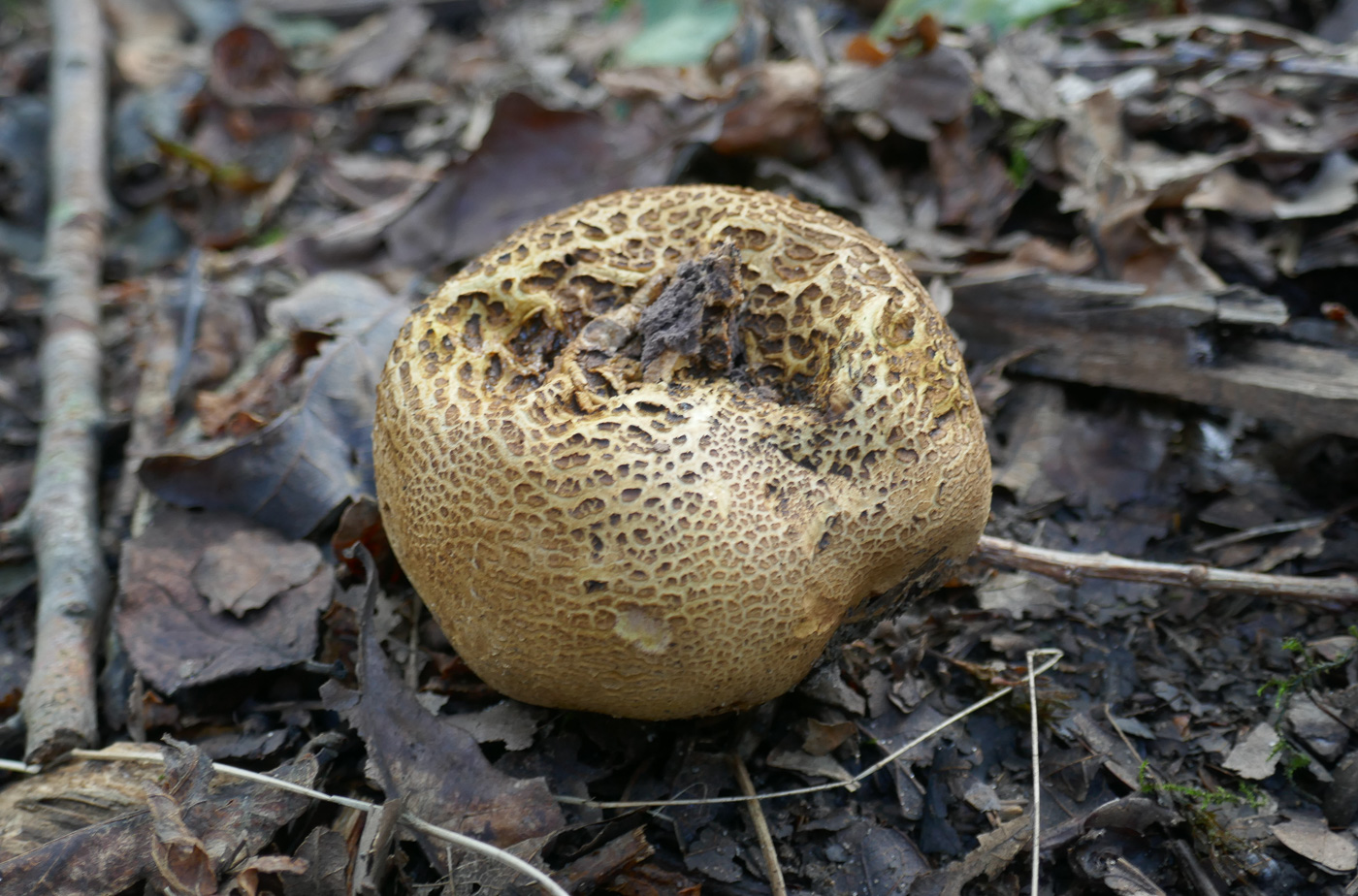
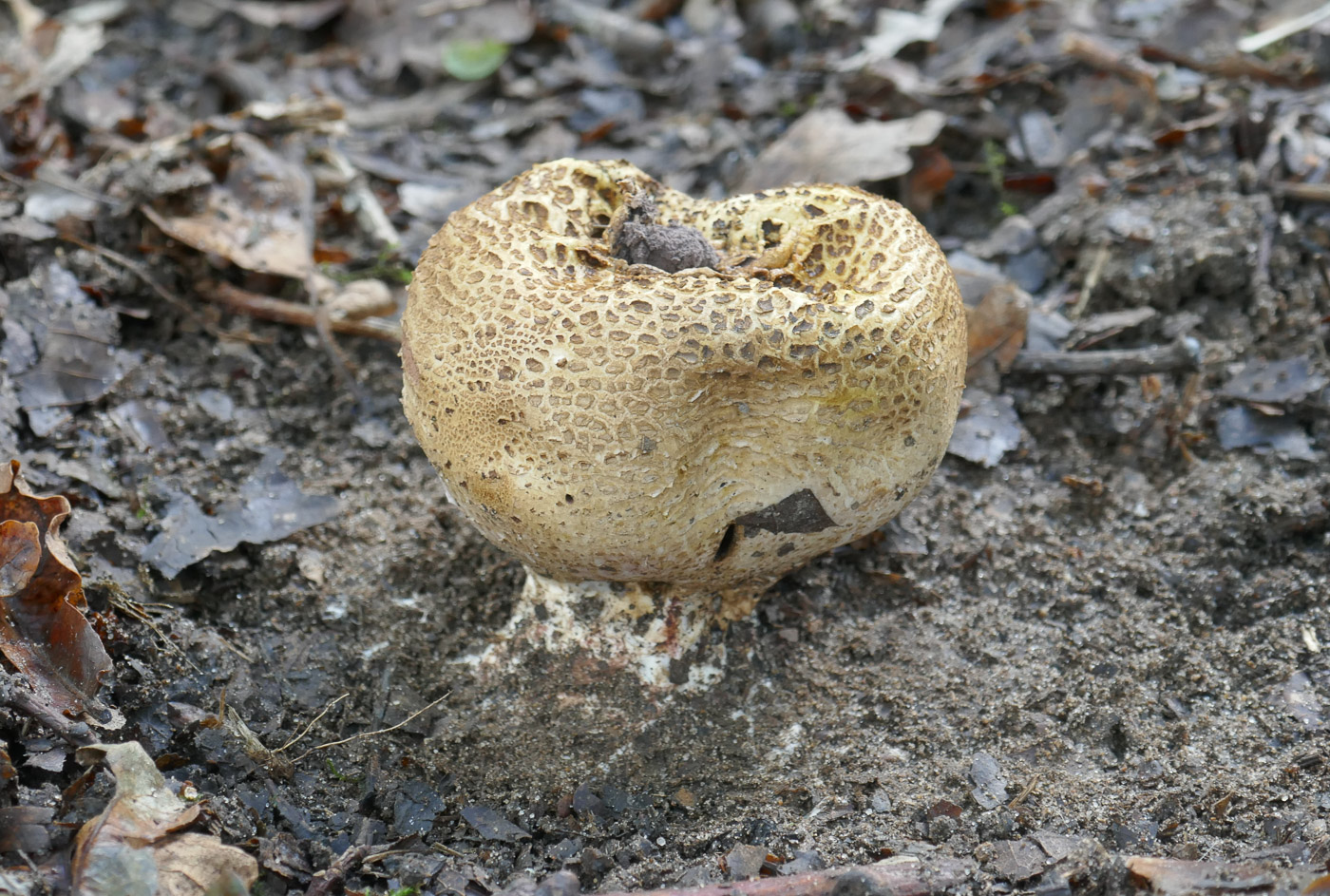
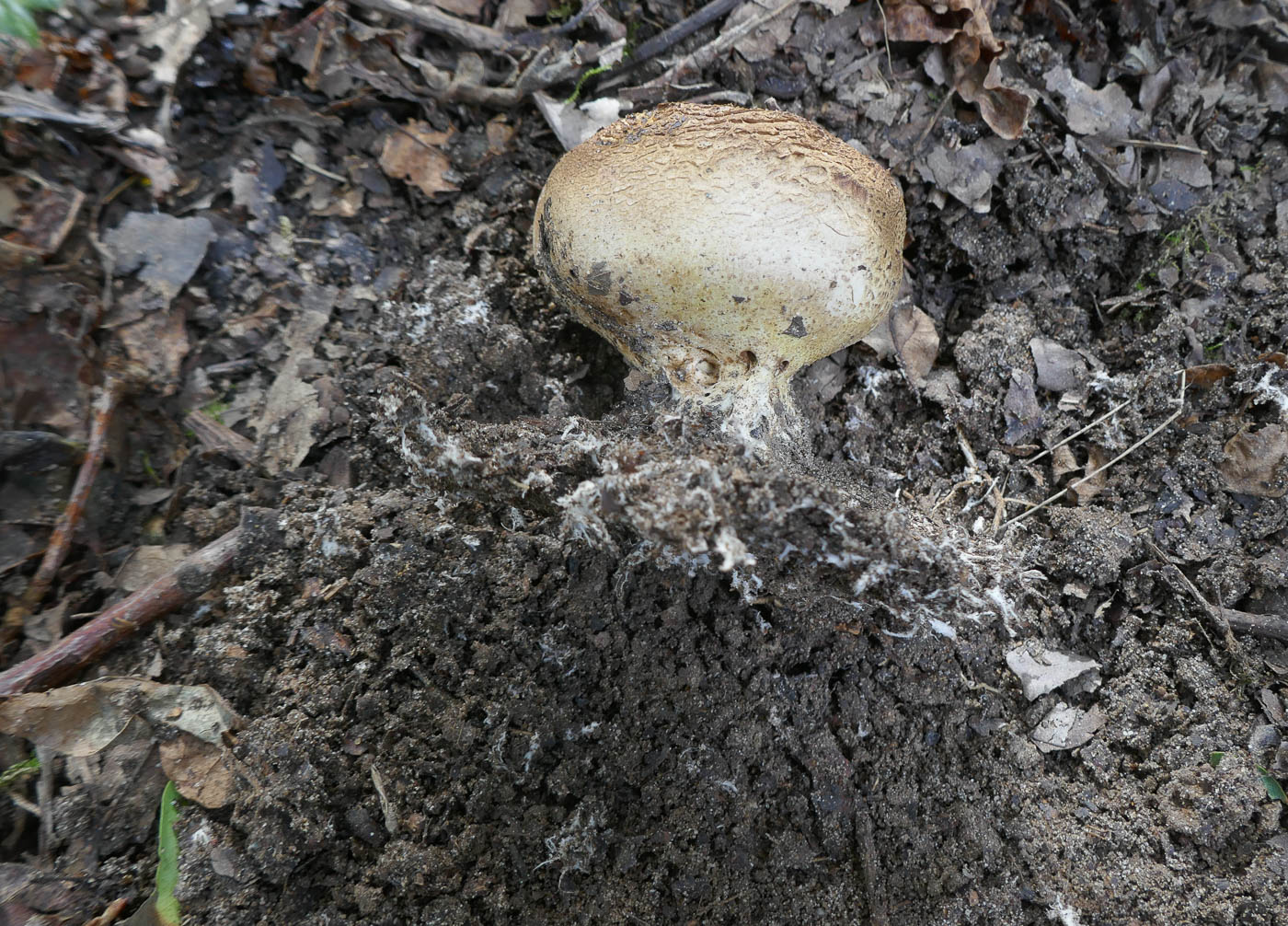 
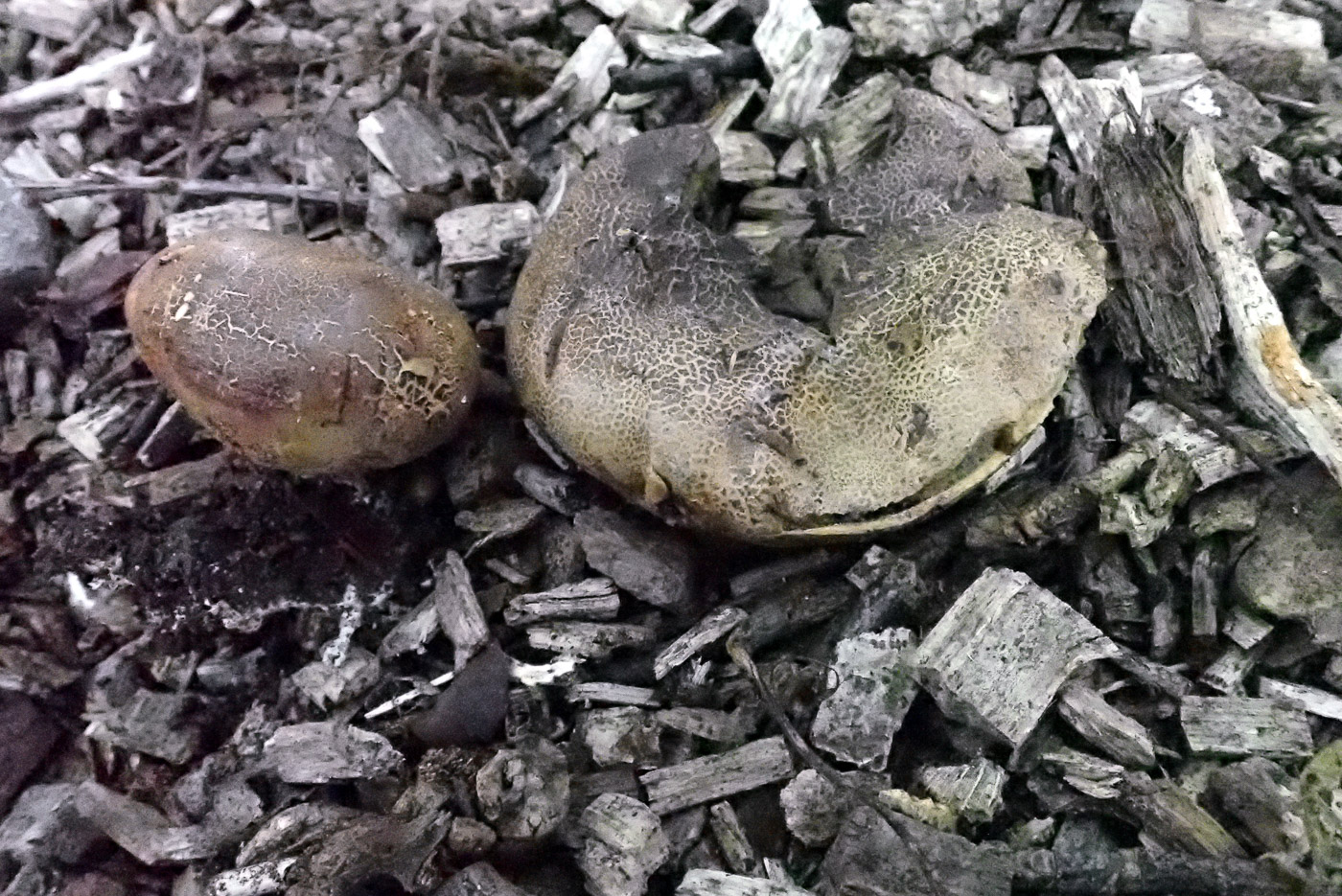
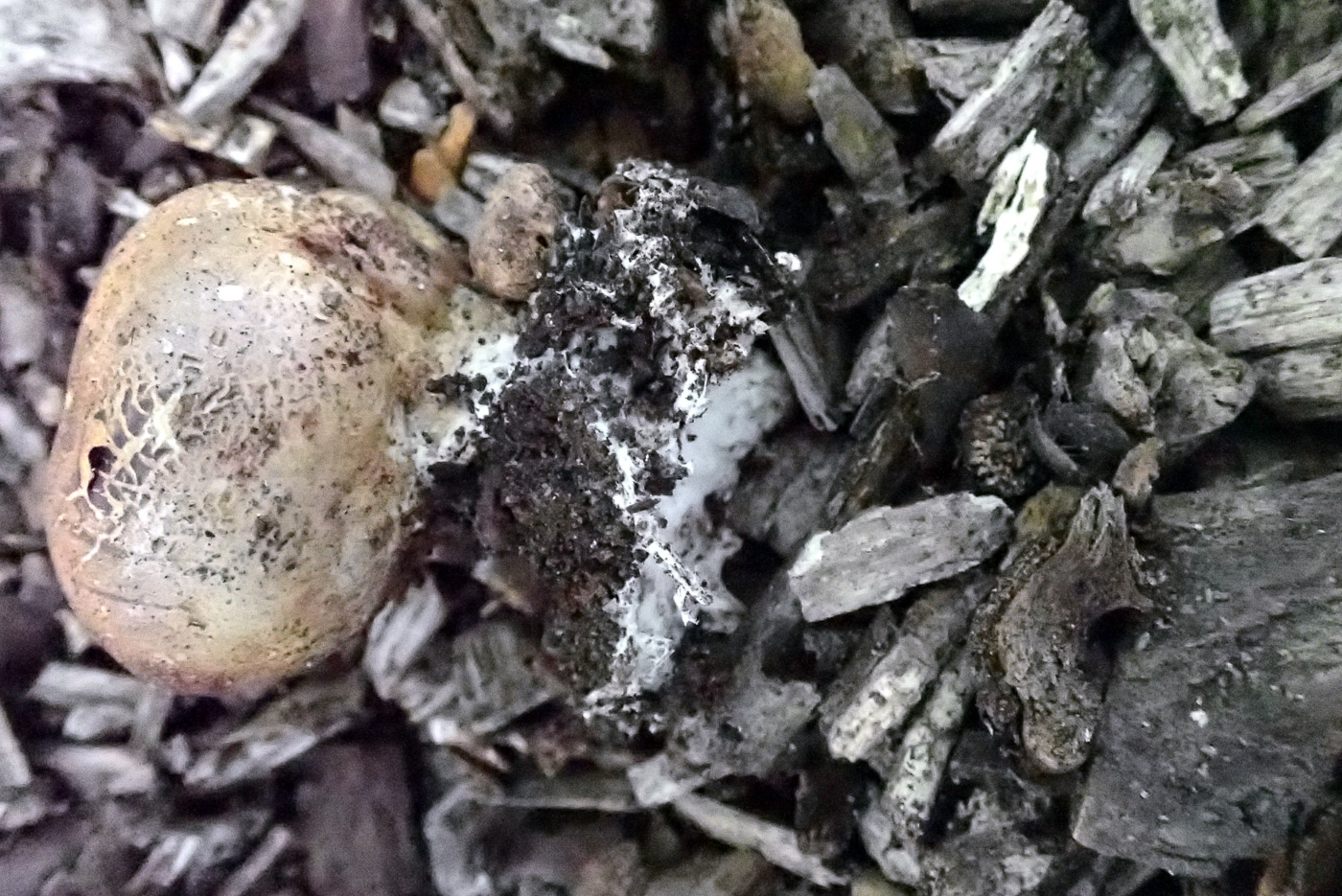
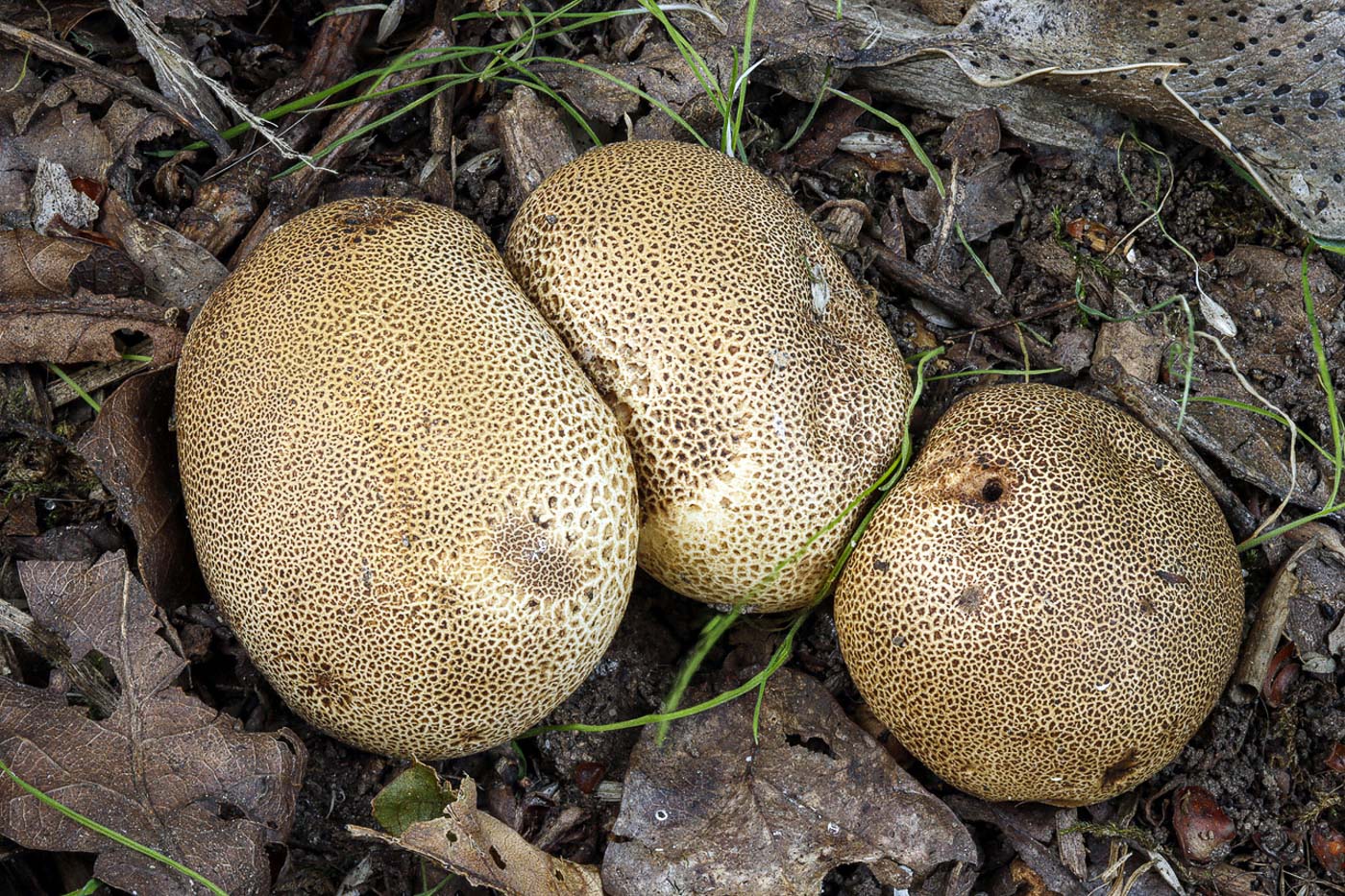
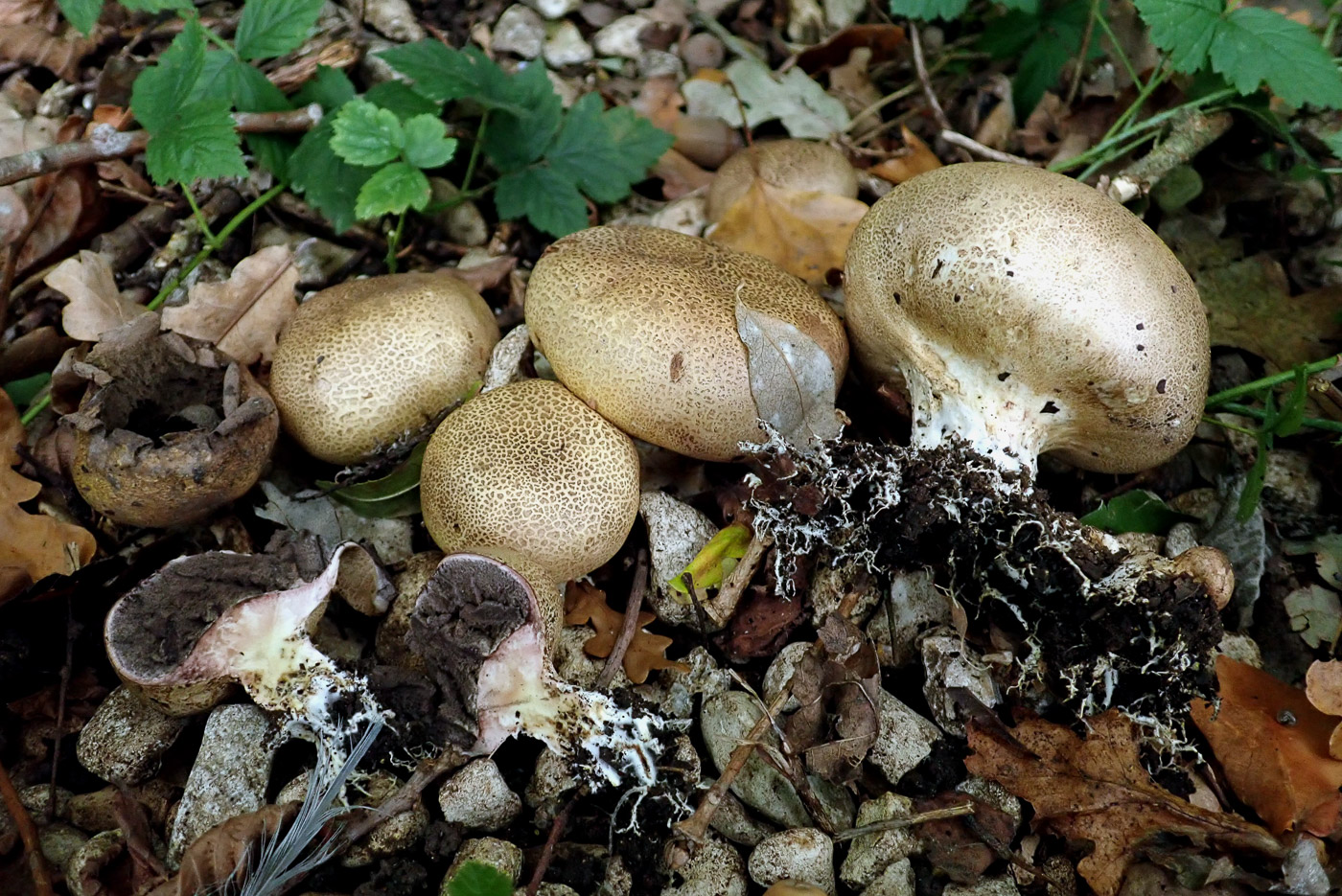
|
Scleroderma verrucosum (Scaly Earthball) Sep 9, 2024 At Stampwell Farm Jackie Ewan reports a few things beginning to appear now. This is one of them, though both Jackie and Penny initially mistook this Earthball for S. citrinum owing to its dirty yellowish appearance. However, a few days later when it had developed a distinct stem and aged a bit (see photo 3) Jackie realised it was not that species but in fact S. verrucosum! It just goes to show how easy it is make make incorrect assumptions even over common species ....... Aug 4, 2023. In a grassy path edge near Oak in Hodgemoor Woods Penny found nice examples of this species showing the distinct stem, the rough scaly surface which splits open at maturity to allow the spores to escape. Jul 19, 2021. On the edge of a large woodchip pile near Oak in Burnham Beeches Penny found her first Earthball of the season. Hardly likely to be mistaken for a Puffball when mature as here, the irregular shape and dirty brown colour with irregular pock marks, also the stem with debris interwoven into the mycelium at its base (photo 2) are typical. A common species usually associated with Oak. Sep 19, 2020. Our first Earthballs of the season, this collection was found by Paul Goby in Naphill Common growing in soil under mixed trees. Often mistaken for Puffballs, there are three common species of Earthball, all associating with deciduous trees. Differences to look for: Earth balls are never white when young, are either yellowish or brown from the start and have a thick tough outer skin, usually roughened or scaly, are not pear-shaped and are dark inside (if cut open), not white - even when young, and are generally less regular in shape. S. verrrucosum has a distinct stem, seen here in the second photo (taken on Sept 28th by Penny Cullington) which also shows how Earthballs split open when mature to disperse their spores (see LH fruit body). (Those with sharp eyes will notice the dead Holly leaf - top right - with little black spots. These are the ascomycete Phacidium lauri, previously P. multivalve.) |

 |
Sclerotinia trifoliorum (a rare ascomycete with no common name) Mar 22, 2024. In Gerrards Cross Jesper Launder noticed this tiny orange disc growing in soil near moss and other vegetation. He suspected it was a species of Octospora but it failed to match anything he could find, so his photos were sent to expert George Grieff who had assisted him recently. George came back with an entirely different name though said that the species does indeed look similar to Octospora but differs in having a stem which had not been obvious to Jesper in this specimen. However the microscopic details all matched. This is a plant pathogen affecting various clovers amongst other things and develops a tiny black sclerotium (like a tiny hard pea) at its base - hence the genus name. This is a new county record and there appear to be no FRDBI records as yet this century. |
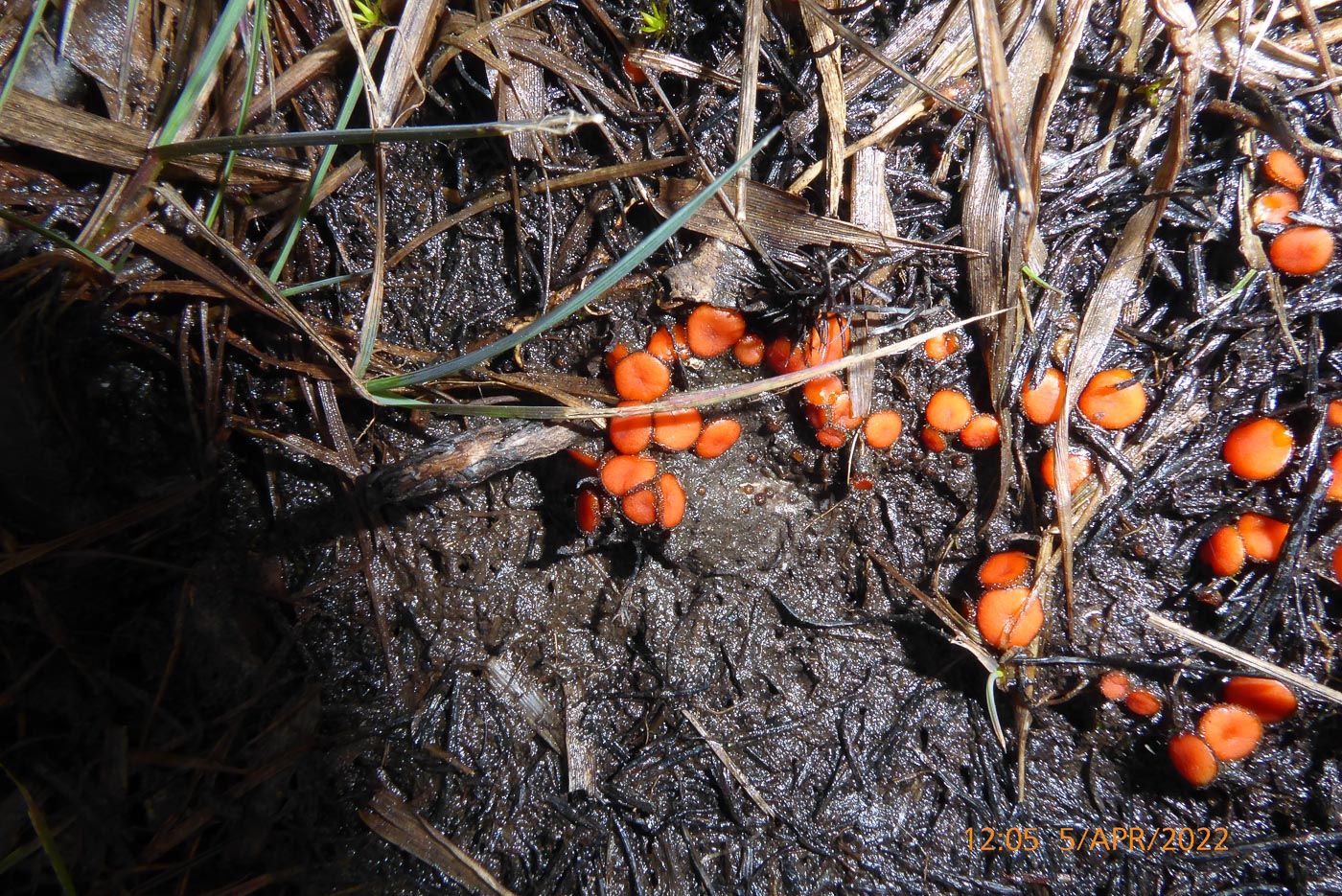
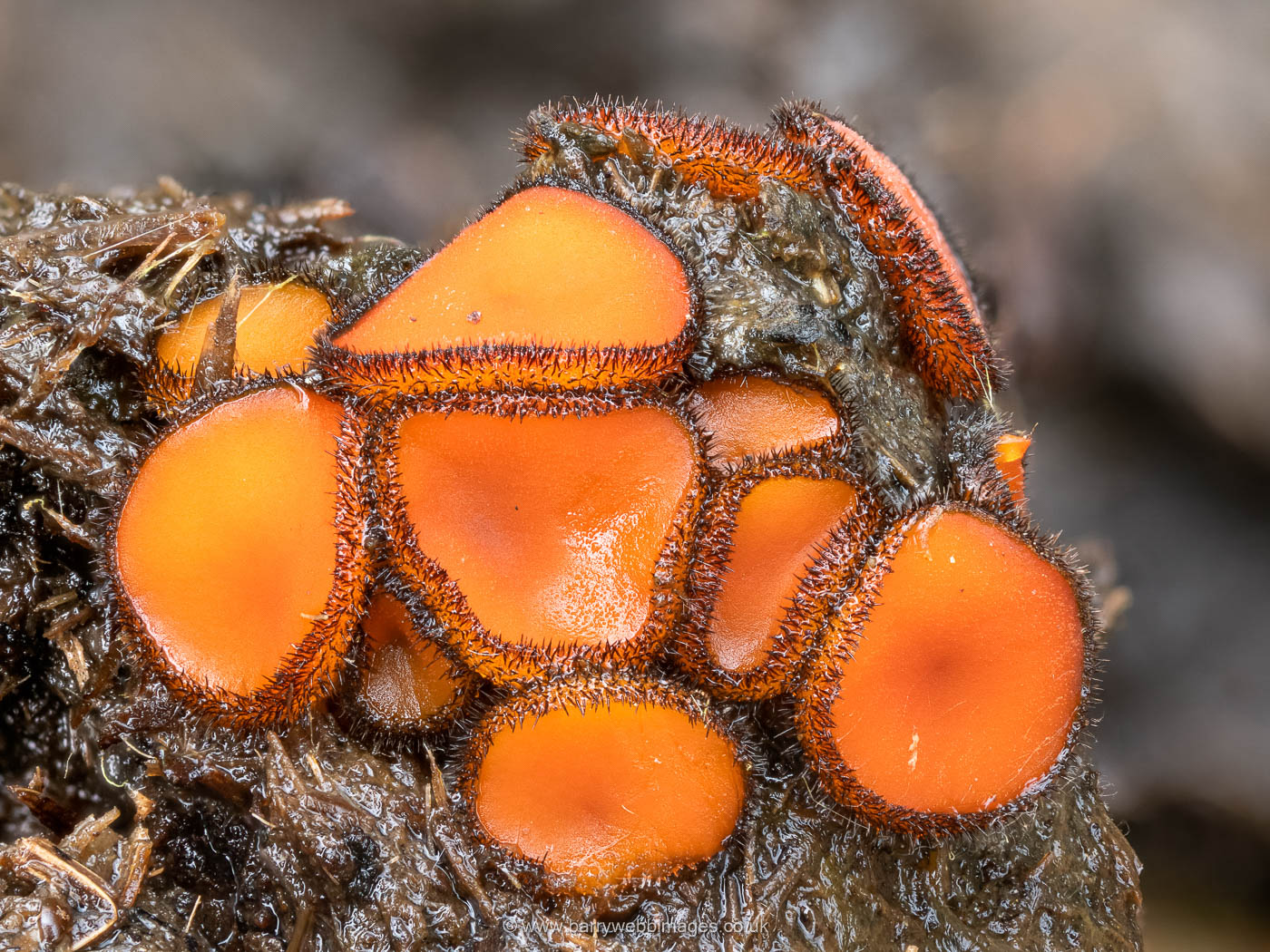 |
Scutellinia mirabilis (a rare Eyelash fungus) Apr 10, 2022. 5 days previously Penny received photo 1 from Jim Wills taken at Stoke Common, but as there are many such small red ascos it is never advisable to attempt an identification without recourse to a scope. However, by chance the same species was collected there by Claire Williams and Barry Webb a few days later, and Barry then returned for a further sample (photo 2) to take to Penny and Derek at the Easter w/e Rushbeds Walk. Both worked on it at home and came to the same name - always gratifying especially when it's a rare species like this one (though Barry says it was fruiting in good numbers on soil in several areas). This is an Eyelash fungus with much shorter 'eyelashes' than in the common S. scutellata, also the spores are larger and have different characteristics. It is not only new to the site and the county but there appears to be only one previous English record, from Lancs, also one from Scotland and one from Ireland. |
 
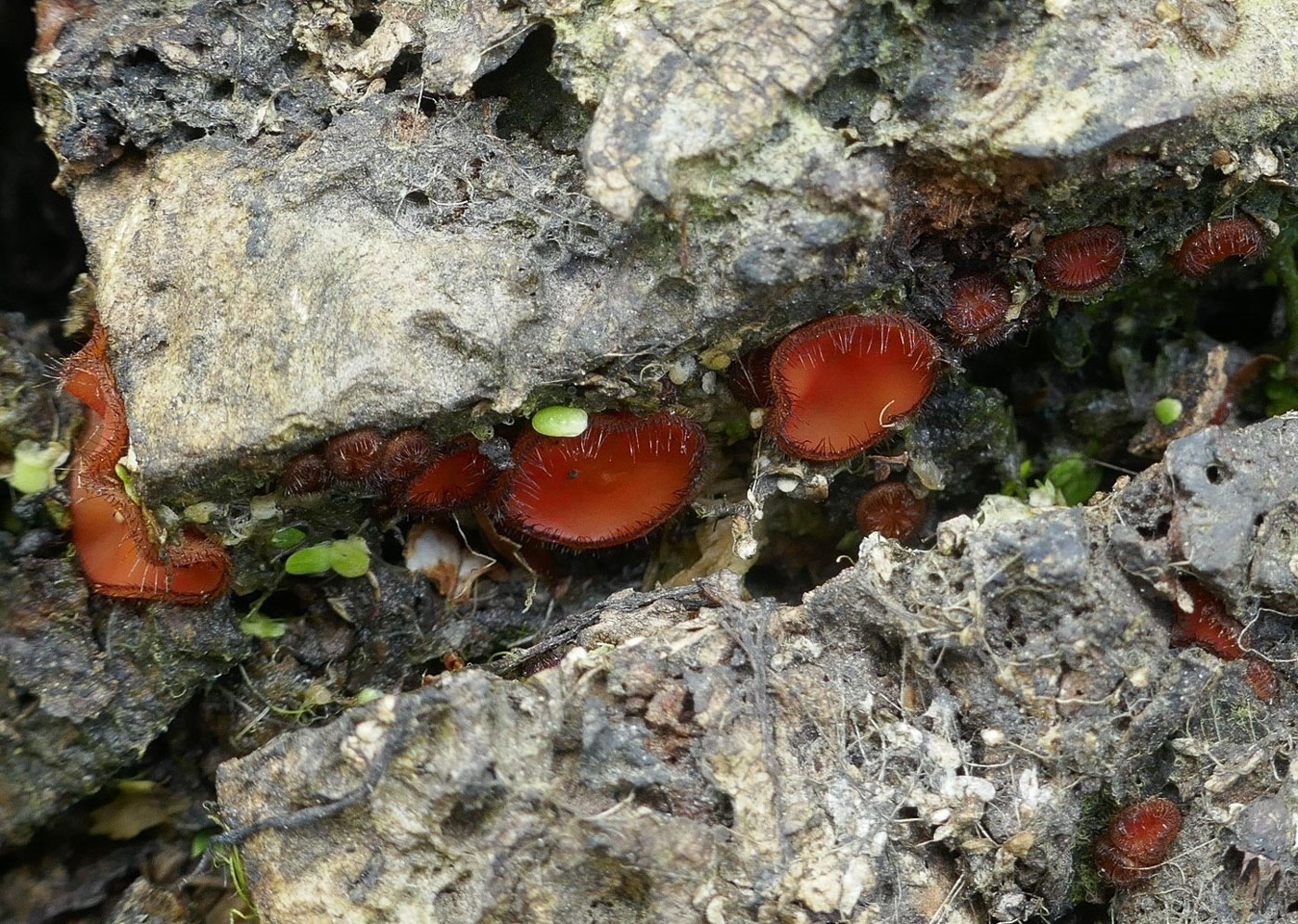
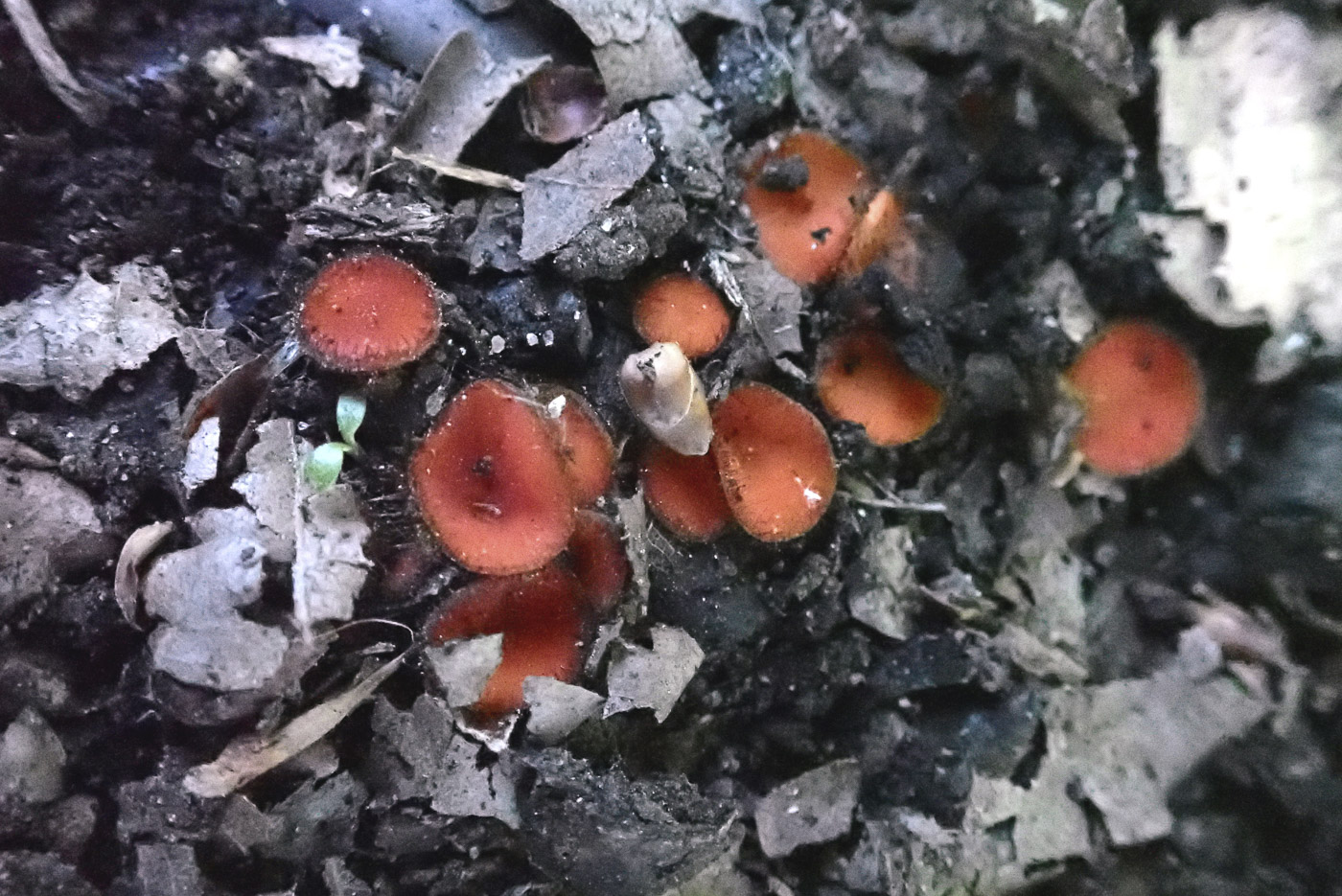
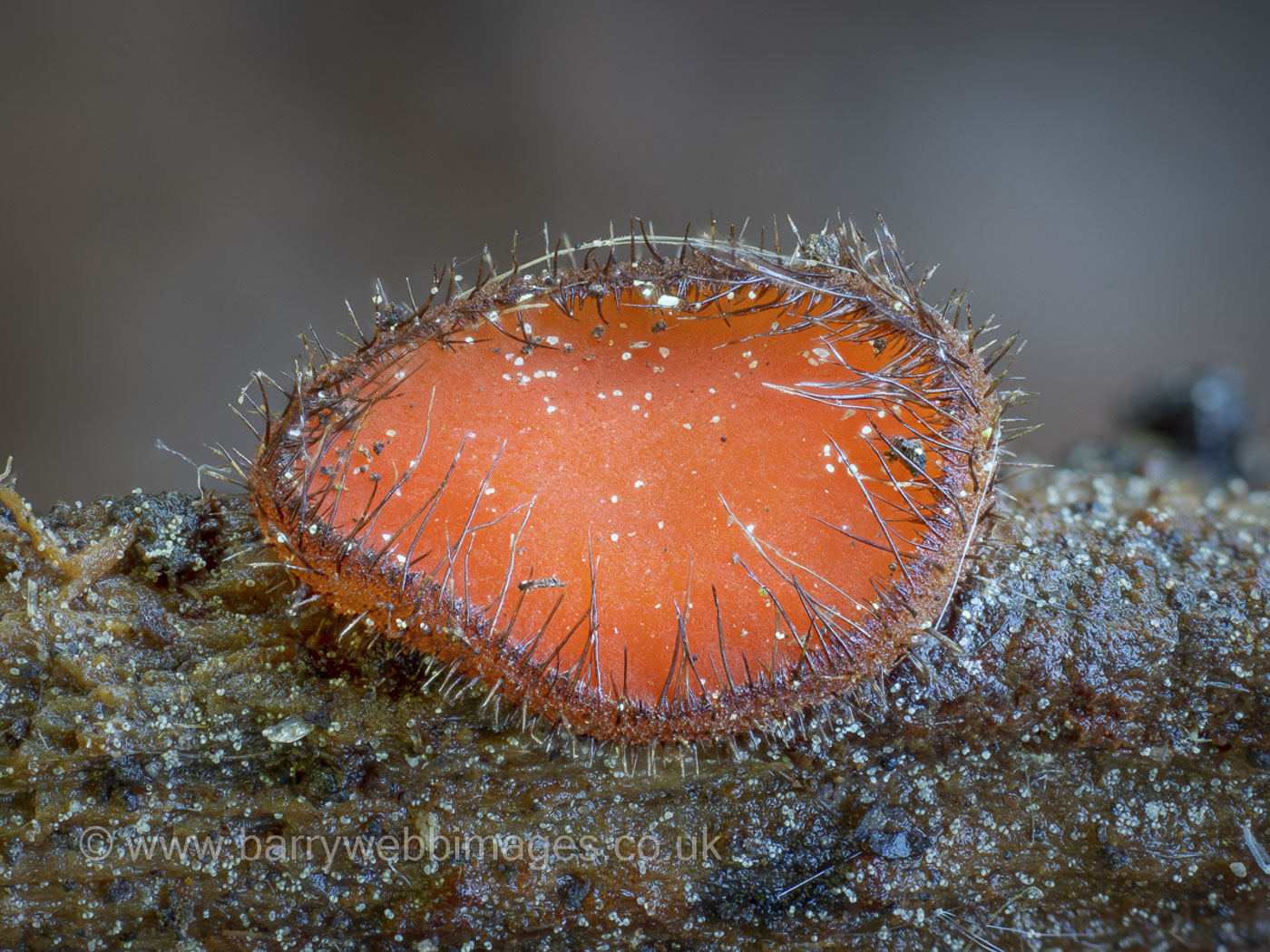
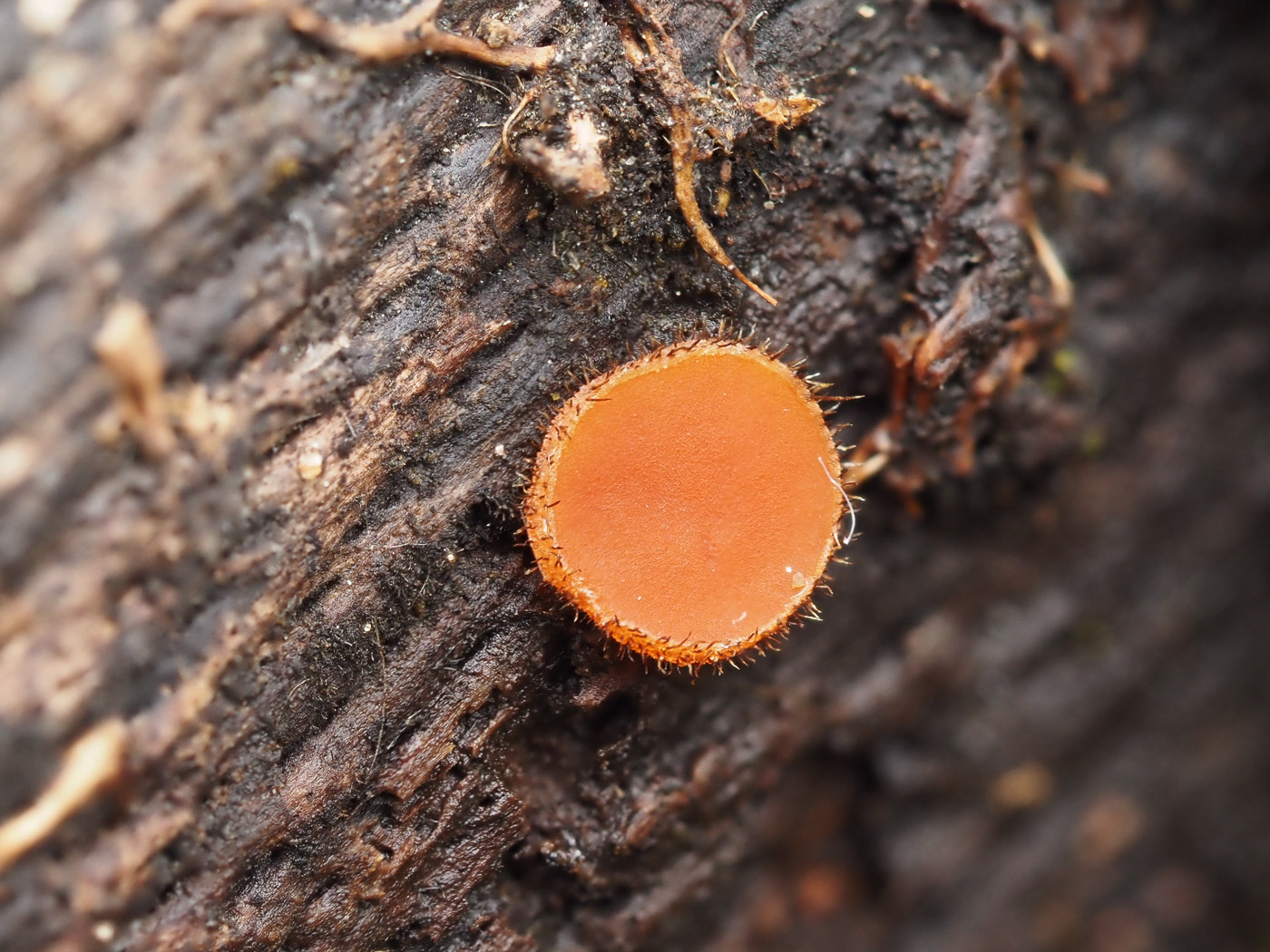
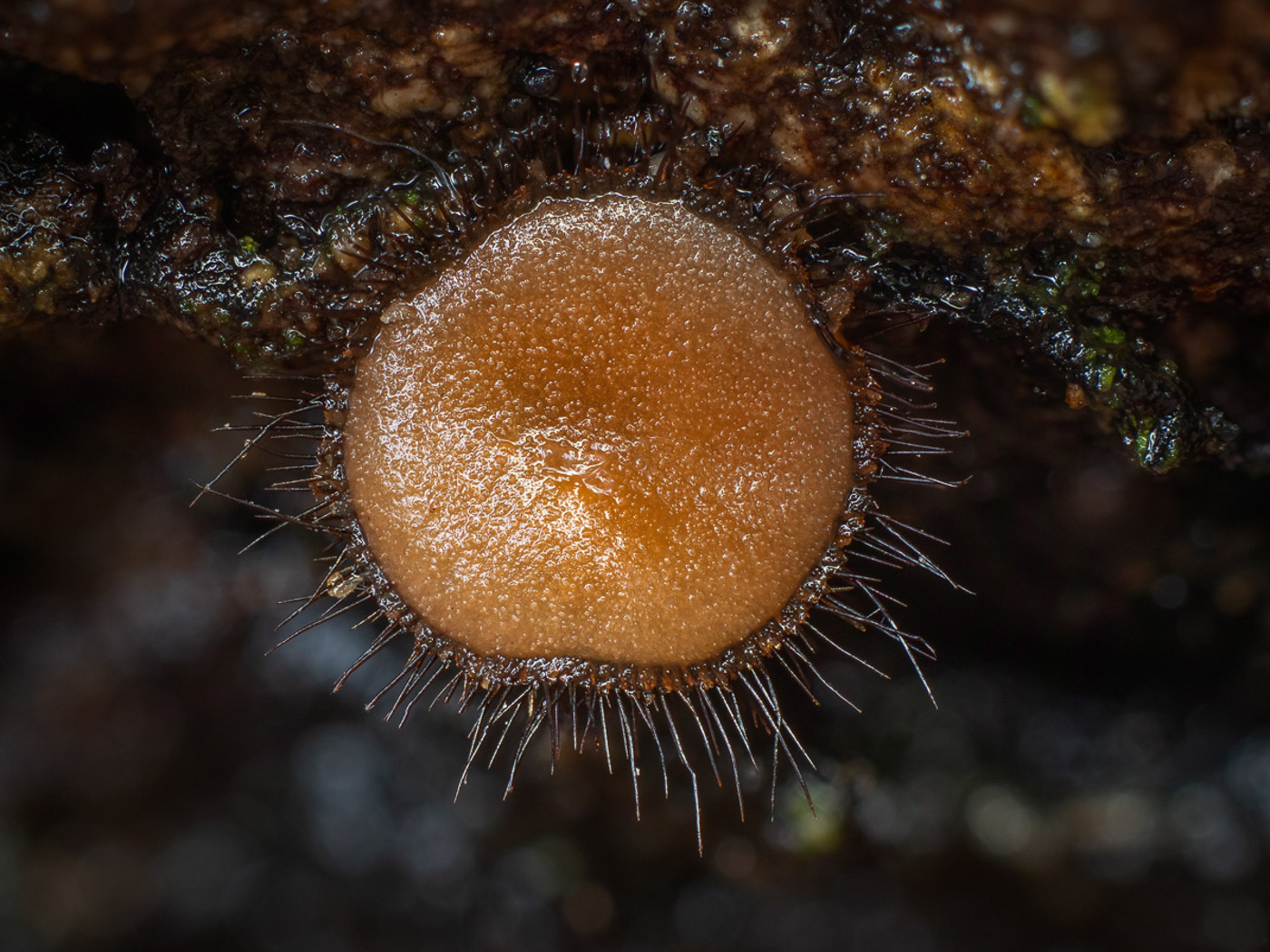
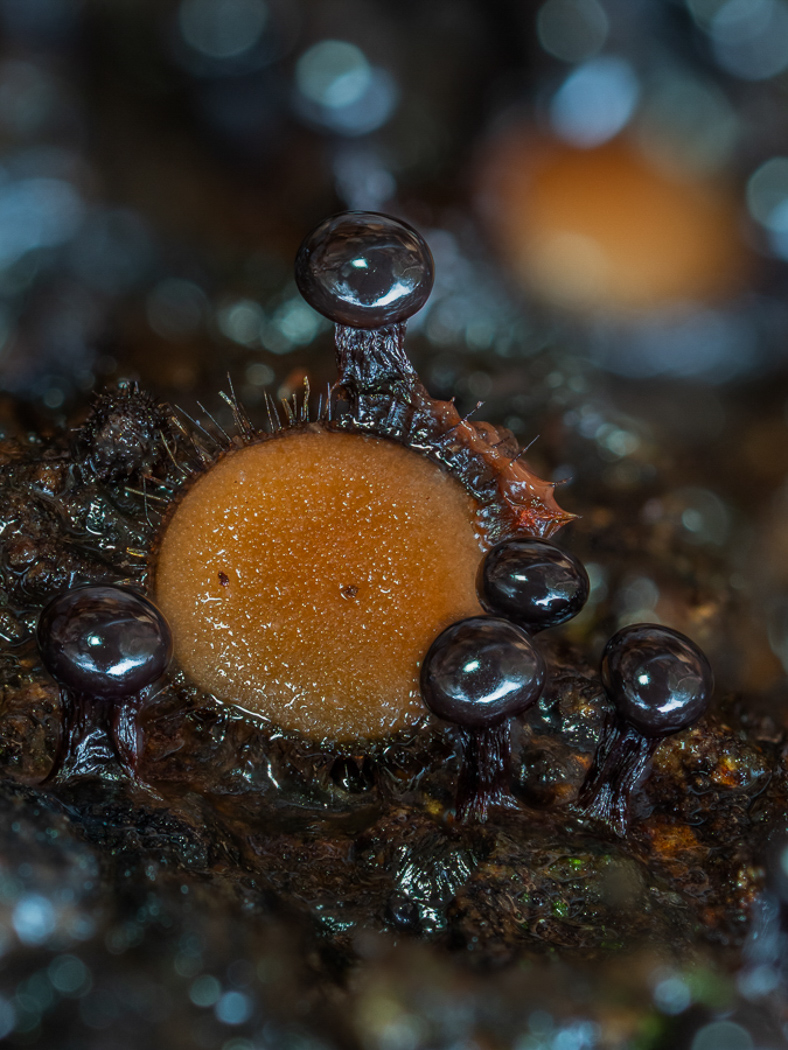
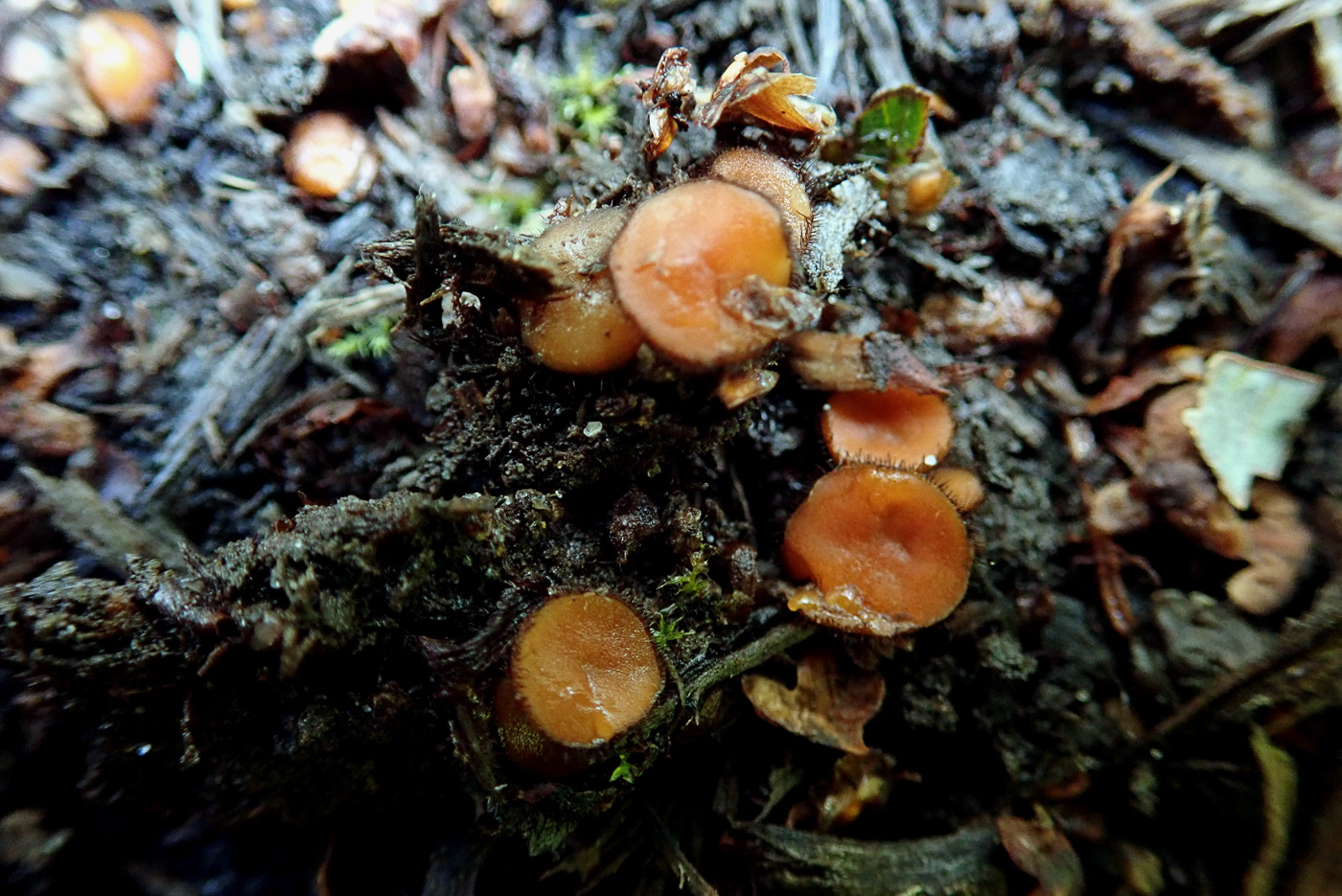
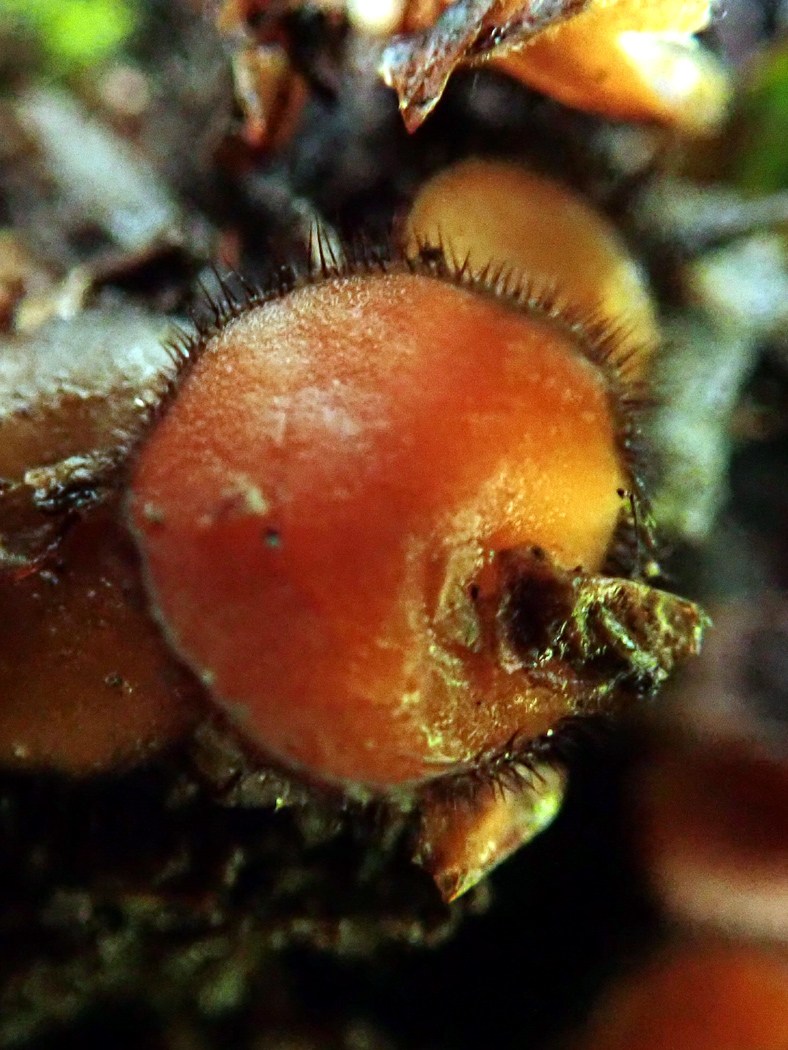
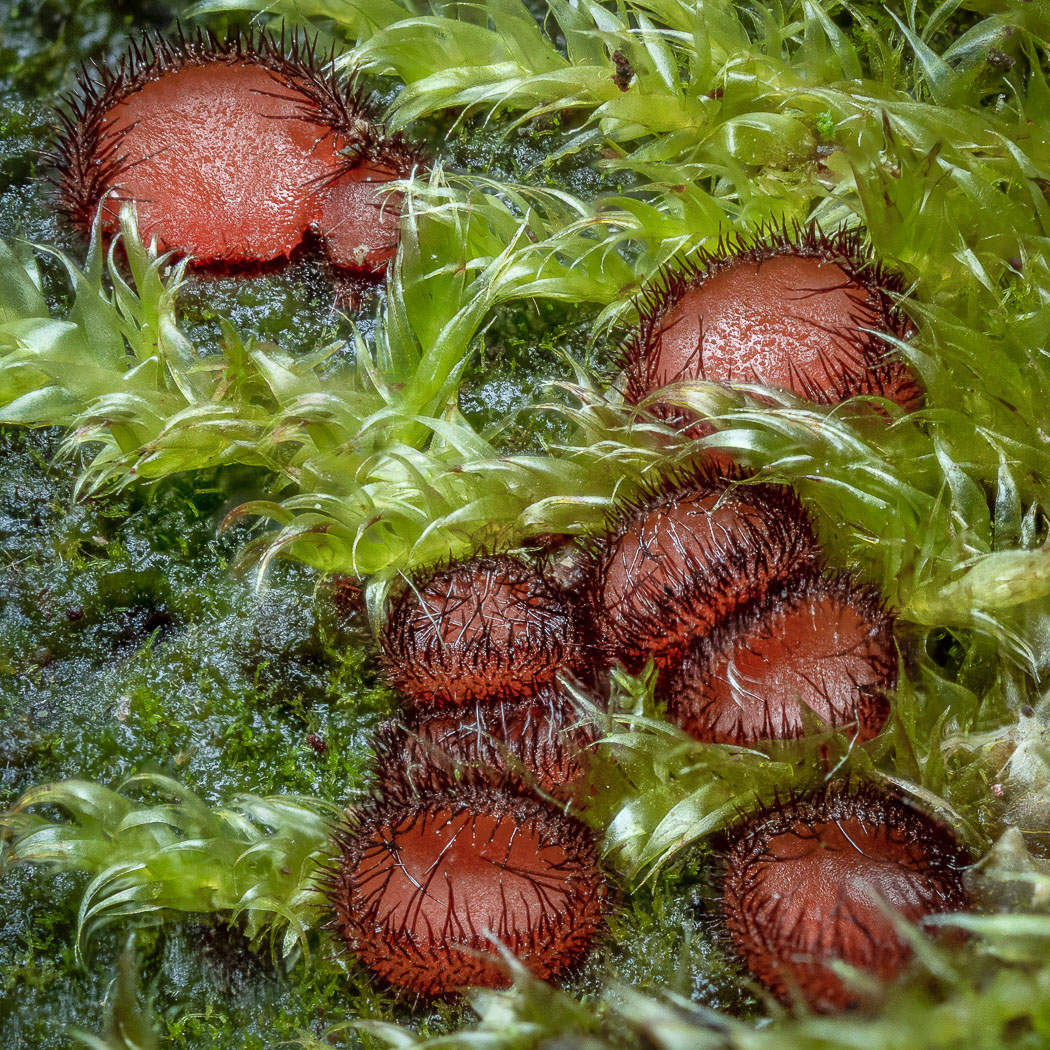
|
Scutellinia scutellata (Common Eyelash) Jun 28, 2023. At Burnham Beeches Jesper Launder found this cluster of a small Eyelash fungus on a piece of rotten wood and carefully keyed it out (as he thought) to the rare S. setosa which would have been new to the site and to the county and with under 50 national records. Clearly a sequence was needed to confirm his ID but sadly this was not to be! Back came the result as S. scutellata - disappointing but in no way skin of Jesper's nose. The genus is always tricky and differences in spore shape and ornamentation are subtle and difficult to assess at best. May 26, 2023. On a soggy deciduous log at Stoke Common Penny noticed this large colony of orange discs having very long 'eyelashes'. Despite a warm dry week this site was still underwater in places and clearly the log had previously been submerged making the perfect substrate for this damp loving species. Penny's camera skills are not up to good close-ups but see 2021 Jan 12th and, even better, June 9th for two of Barry's brilliant photos May 19, 2022. At Stampwell Farm on a rotten Willow stump Jackie Ewan found these tiny discs and checked the microscopic details to ensure it was not one of the other species in the genus - there are many and the keys are not for the faint-hearted(!) but the very long 'eyelashes' together with the spores confirmed her identification. Jun 9, 2021. On the edge of the Mire at Burnham Beeches Penny found just a singleton Eyelash in a muddy path, whereupon our small group then noticed several large clusters a few feet away. It was suspected in the field that this might turn out to be a different species of Eyelash because the Common Eyelash is much more commonly on wood of some sort rather than on soil (though the clearly lengthy hairs visible with a handlens belied this as it has the longest hairs of all species in the genus). Sure enough, Derek identified it as S. scutellata - disappointing in one way but it was such a sizeable collection so worth including here. Photo 1 is Penny's to give an impression of the numbers, photo 2 is Barry Webb's - a real stunner! May 28, 2021. Claire Williams noticed this tiny brightly coloured cup, an Ascomycete, on a damp log near Mannings Pond, Downley. There are quite a few different species of Eyelash, really needing as scope to be positive as to species, but much the commonest and also the one with the longest most prominent lashes (clearly visible around the edge here) is this one. Often found in clusters, the cups can get to 1 cm across or more and favour damp rotting wood. If you find one growing on soil then it's likely to be one of the other rarer species. Jan 12, 2021. Barry Webb found these two species growing together on rotting bare wood in Burnham Beeches. Though not checked with a scope, the Eyelash Fungus is likely to be this particular species which has by far the longest eyelashes in the genus. The tiny stalked black slime mould specimens are at the stage just prior to splitting open to reveal the spore mass within. (See more images in Finds 2020: Scutellinia dated Sept 28th and Oct 1st, Metatrichia dated dated Oct 17.) Oct 1, 2020. This attractive little Ascomycete was found by Penny Cullington on a damp woodchip pile at Turville Heath. Only 5mm across, each tiny cup is edged with dark 'hairs', hence the common name. There are several quite common species of Eyelash, all extremely similar in appearance, and they are found in damp places either on soil or woody remains. Identification to species level can only be made by measuring the spores and the length of the hairs, but this species is the commonest and has the longest hairs. Sep 28, 2020. We do have this species already, dated Oct 01, but Gill Ferguson's beautiful close-up photo is well worth including separately. It was found on rotting wood in Burnham Beeches. |
 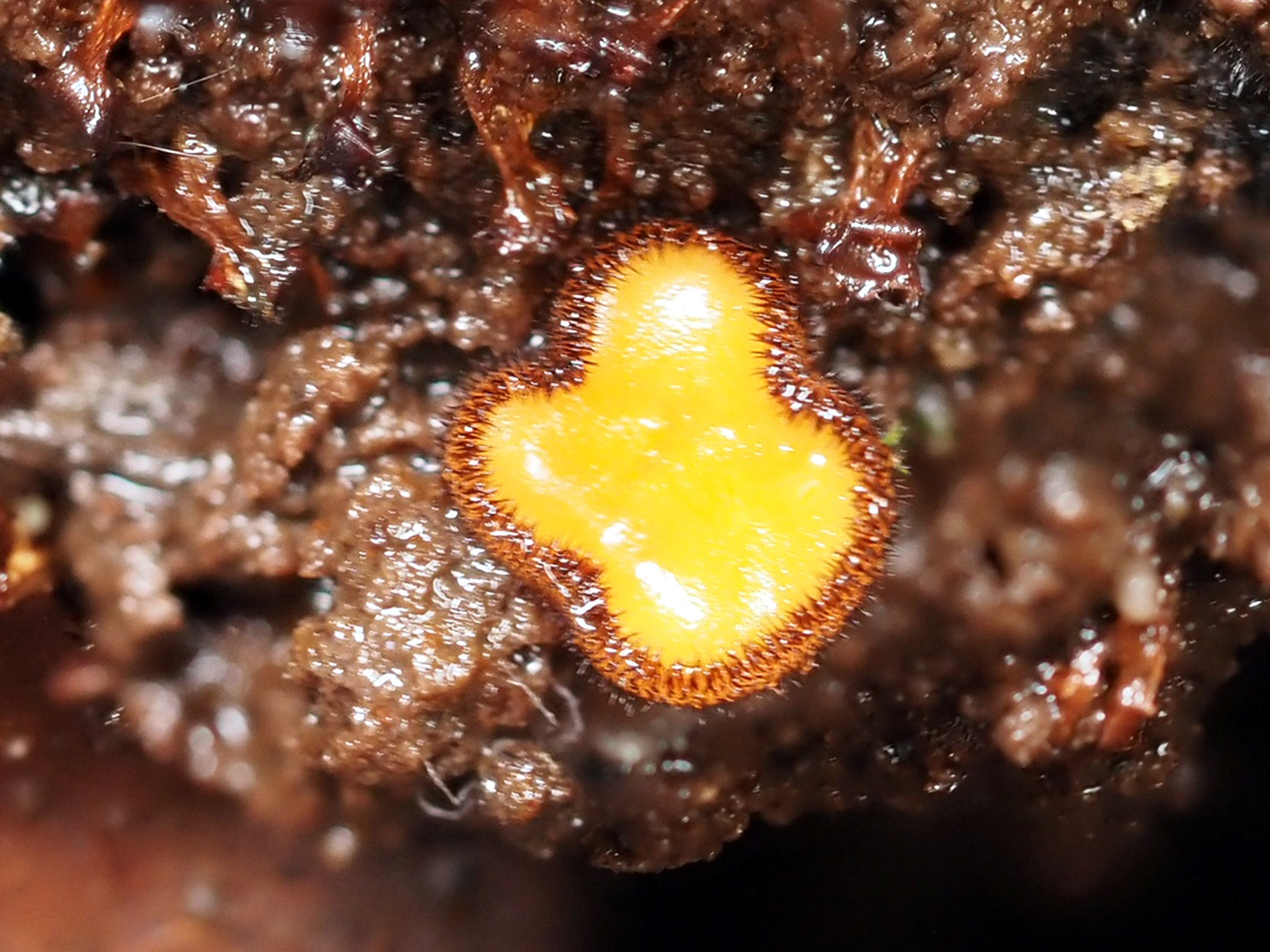
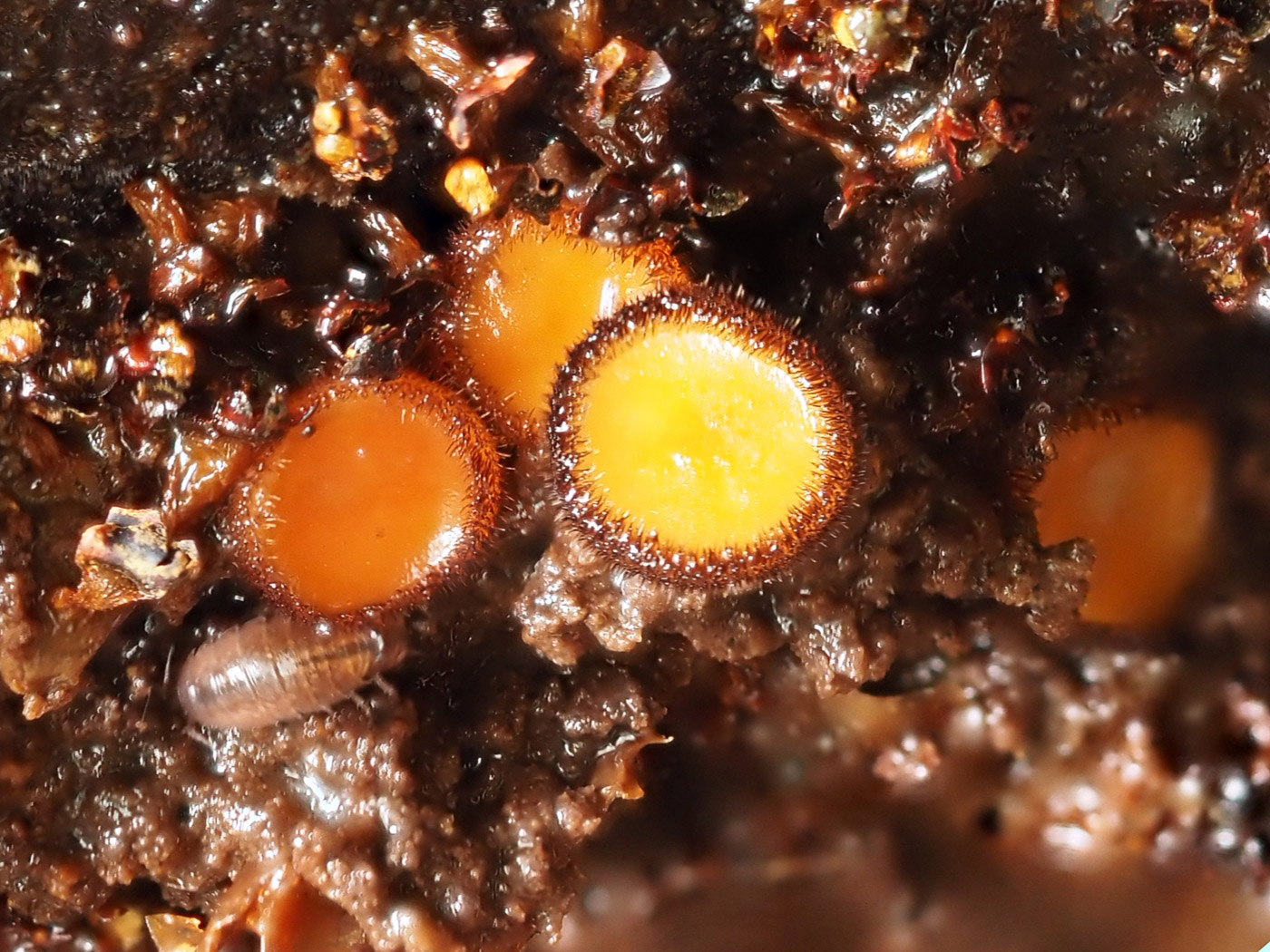
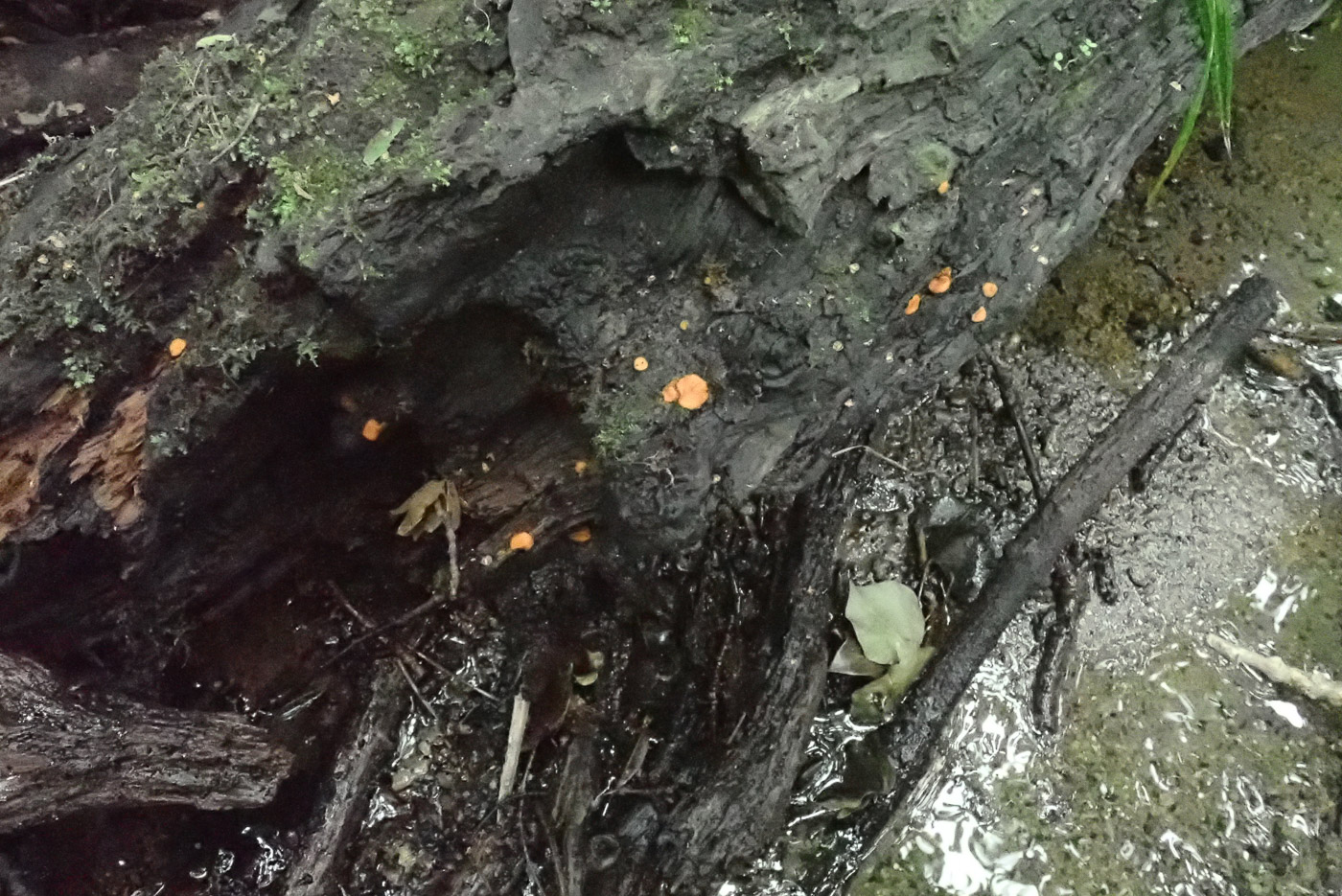
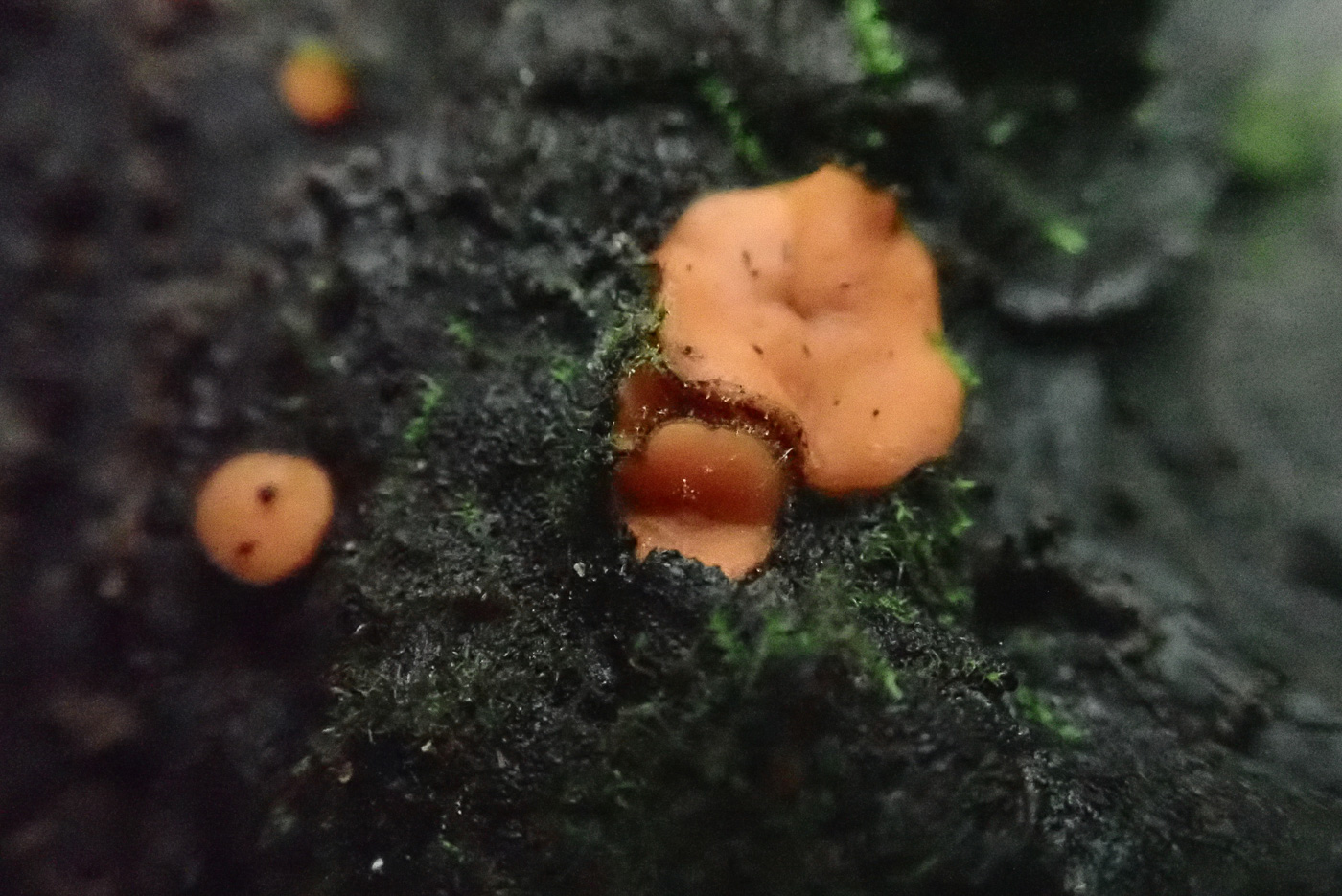 |
Scutellinia subhirtella (a species of Eyelash with no common name) Apr 12, 2024. On some recently cleared burnt ground at Turville Heath Penny noticed a few tiny bright orange red spots on some rotten wood. Sure enough on closer inspection they had dark hairs around the edge placing them in genus Scutellinia, though the hairs at first glance didn't look convincingly long enough for the common S. scutellata, also they had a slightly translucent more orange appearance. Taking note of the spore size and markings together with the length of the hairs, it keyed out in various different keys to S. subhirtella, a species for which we have a good handful of records - a couple from burnt ground. Apologies for the very ordinary photo but luckily Claire Williams's photos in Previous finds shows the species off much better. Jul 12, 2021. In Downley Woods Claire Williams found these tiny brightly coloured cups on rotting wood in a damp location and noticed that not only were the cups more yellowish orange than red but that the marginal hairs looked rather short for the common S. scutellata. She took the opportunity when visiting Penny with a bracket from the same site (also included today) to take her this Eyelash fungus which Penny was then able to identify working through various keys etc. We've recorded the species at only three previous sites, so this was a nice find. Photos 3 and 4 were of a later find of Penny's from Rushbeds Wood (August 13th) in a stream bed showing the typical view of the genus when viewed from above - i.e. just bright reddish dots on rotting wet wood - and the clearly more orange rather than red colour of the species. |


 |
Scutellinia vitreola (a very rare Eyelash with no common name) Apr 25, 2022. In Stoke Common on some Birch stumps Jim Wills found these tiny Eyelash fungi, only 5mm across at most, and took them home to work on. Following any key for this genus is no easy task and he was very unsure despite finding the relevant features. Penny and Derek also failed to come up with anything definitive after consulting with expert Malcolm Greaves. The material was then dried and sent for sequencing with the result that this appears to be a new species for the UK (with no records in FRDBI under this name) though there still remains some confusing evidence in Unite and Genbank - the two sites which store all fungal sequences but which unfortunately also include many misidentifications. Sorting out the wheat from the chaff can be a complicated business! |
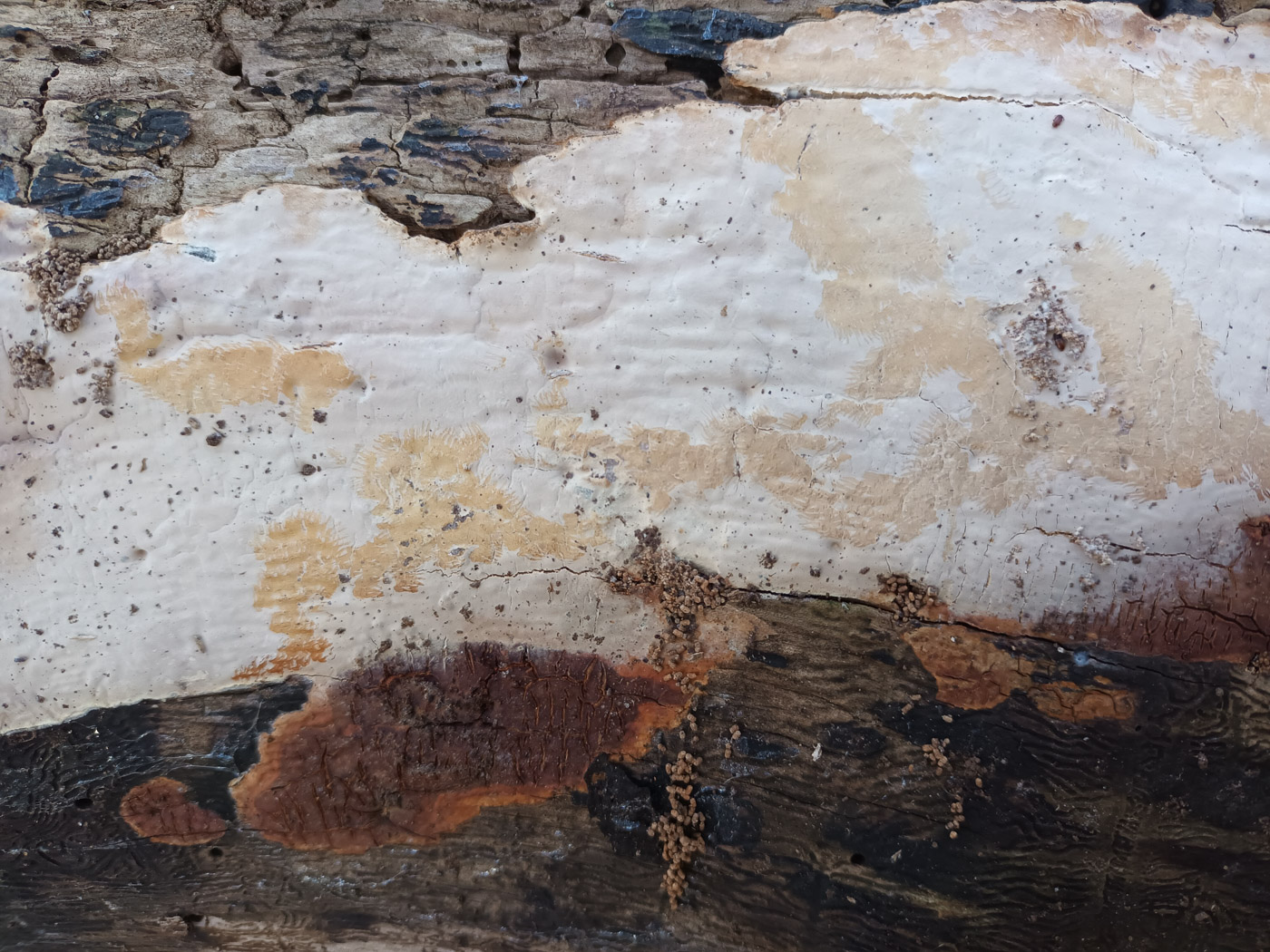 |
Scytinostroma portentosum (Mothball Crust) Jan 31, 2022. On fallen Sycamore in woodland near Jordans Village Jesper Launder found this fairly nondescript resupinate but one which has a very useful field clue to its identity if you know to test for it. It has a distinctive and strong smell of Naphthalene, ie mothballs - hence its common name (though the species is in fact quite rare). It has a soft waxy cream surface often developing a pinkish tint as seen here, and is reportedly most often found on Willow though our four previous county records, all from Dancersend, were on Beech. So this was a nice find and a first for our Finds pages. |
 |
Seifertia azaleae (Bud Blast) Feb 23, 2024. In Chalfont St. Peter Jesper Launder spotted a nice example of this common fungus which affects the buds of Rhododendron, preventing the affected bud from flowering. Previously in genus Pycnostysanus though common this is a new entry for Finds. |


 |
Simocybe centunculus (Dingy Twiglet) Jul 20, 2023. In Gerrards Cross Common Jim Wills found these tiny LBJs on a bare fallen Beech trunk and puzzled over them for a few days, returning a day or so later to take photos when they were a little bigger only to find that the caps had been eaten off! Discussion with Penny over both macro- and micro- details has resulted in this ID though we will get a sample sequenced to confirm. The occurrence on fallen wood, slightly velvety cap surface, pale gills and pale brown smooth spores help to separate this fairly nondescript mushroom from others. This is a new entry for Finds though we have quite a few county records. |
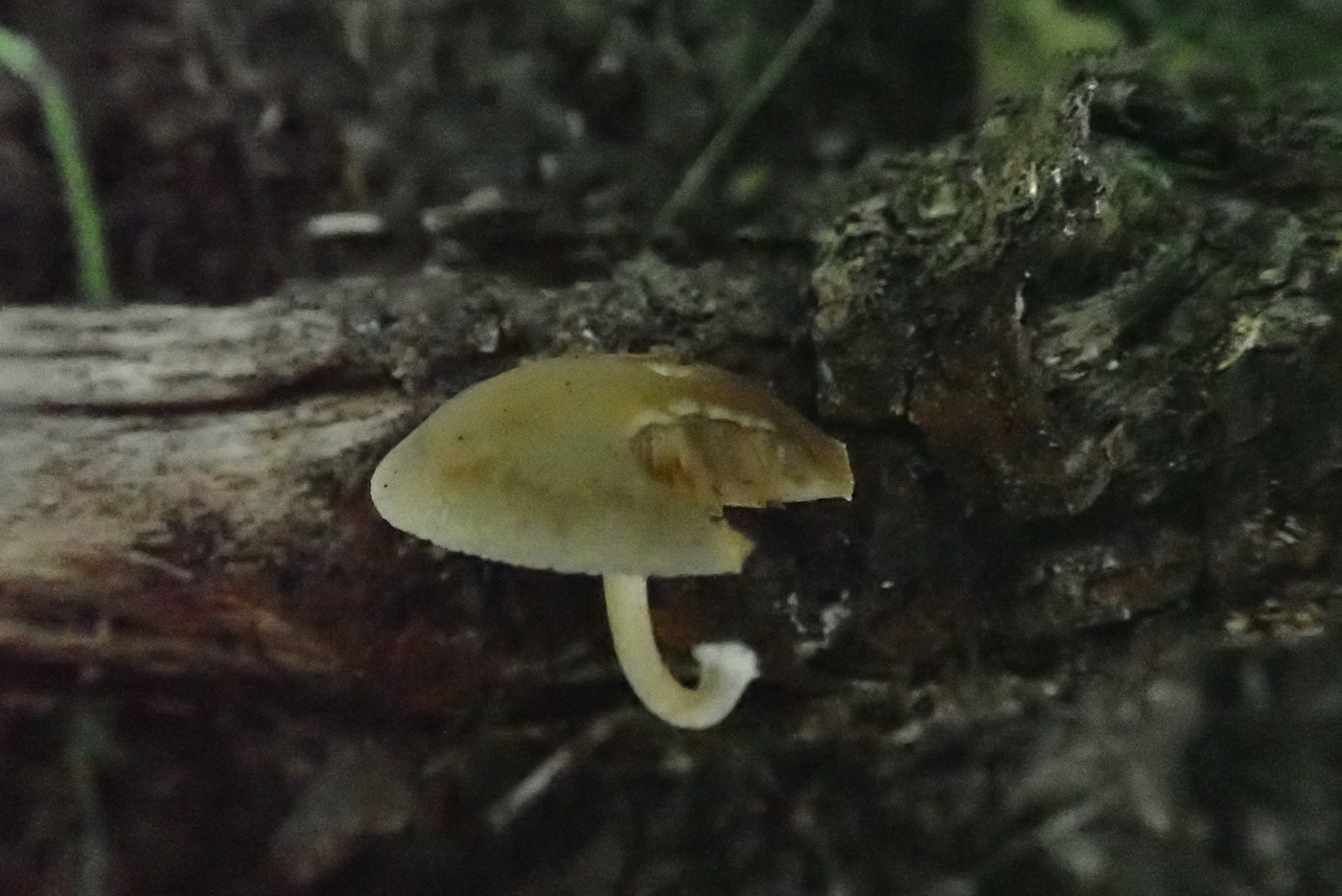
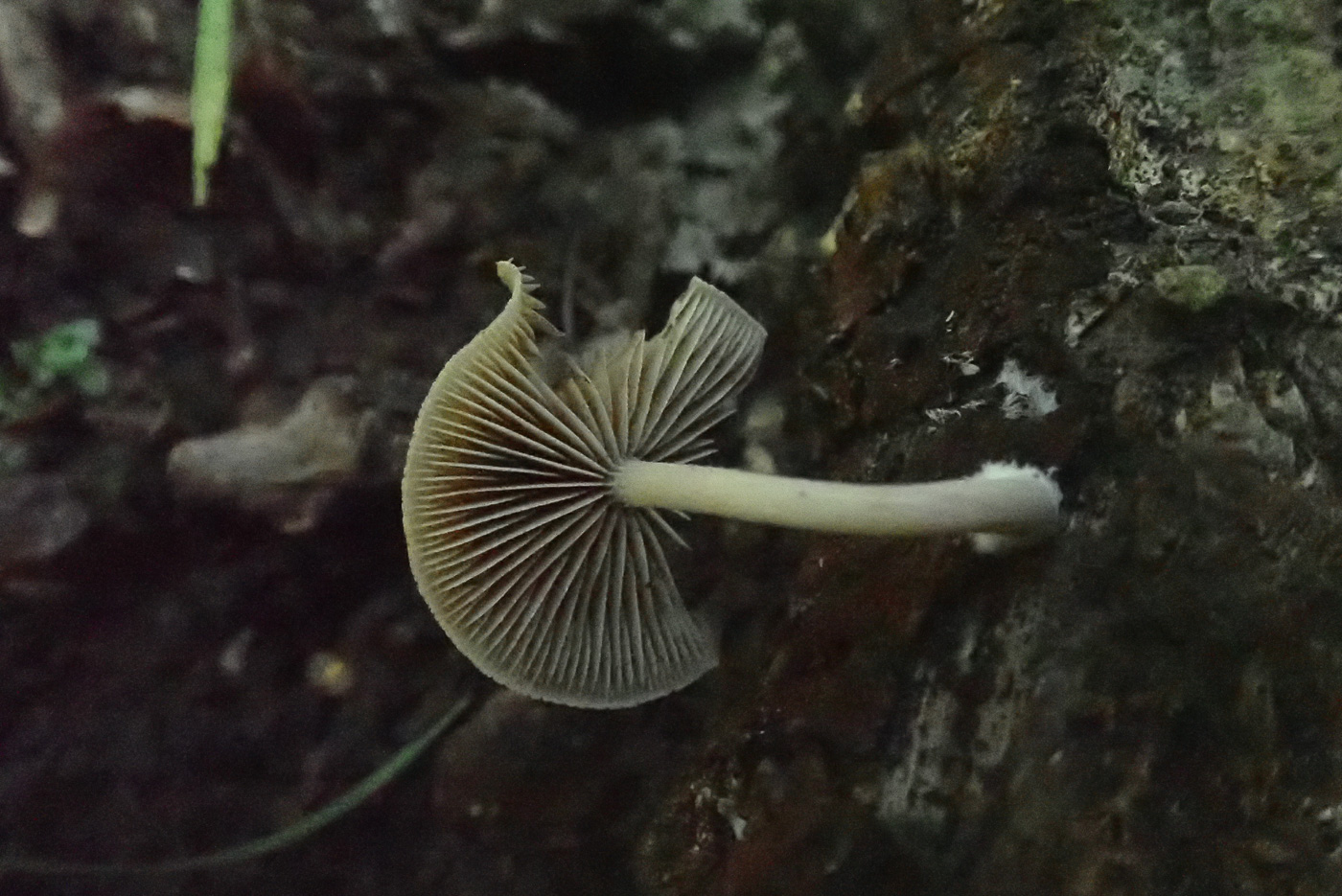
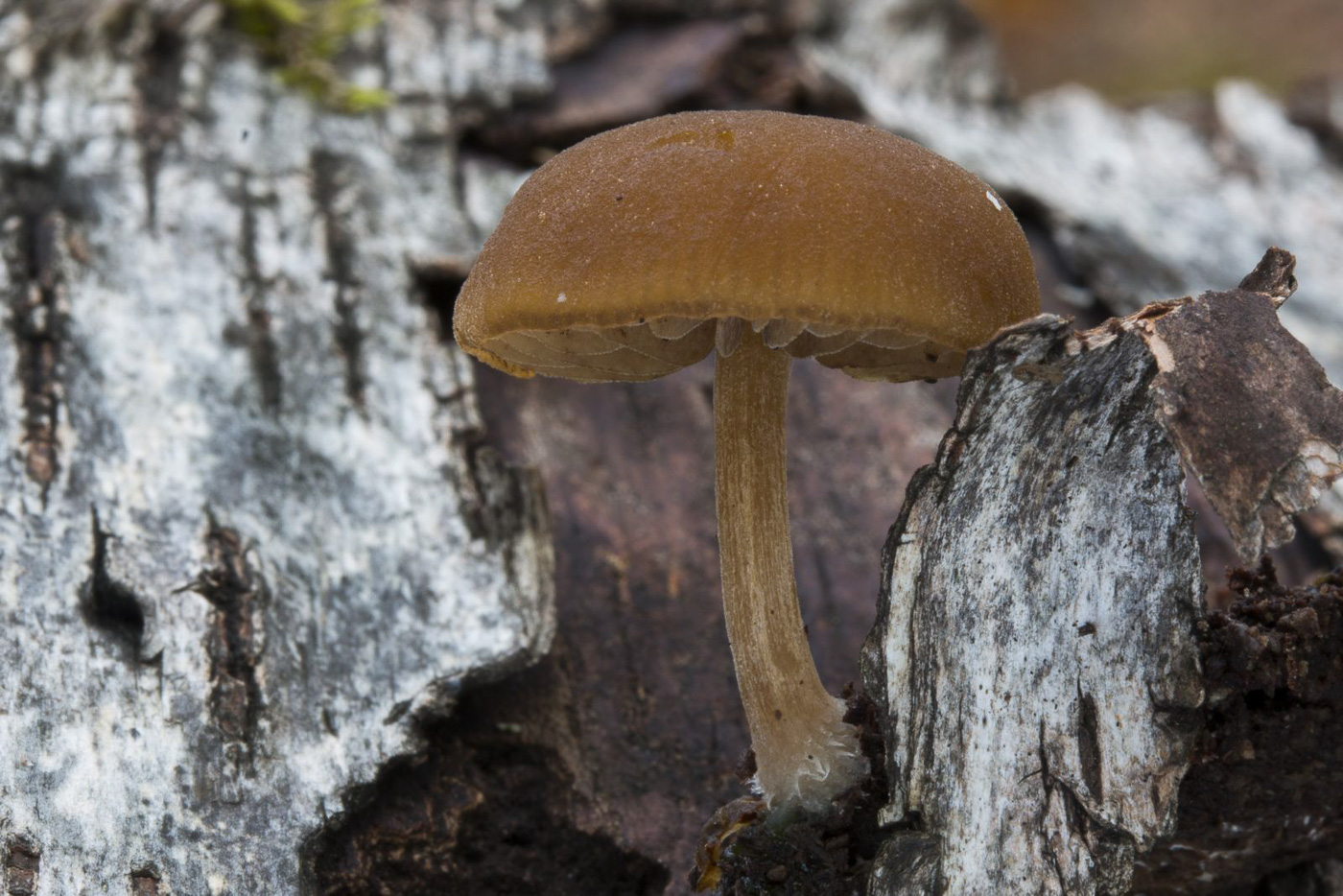
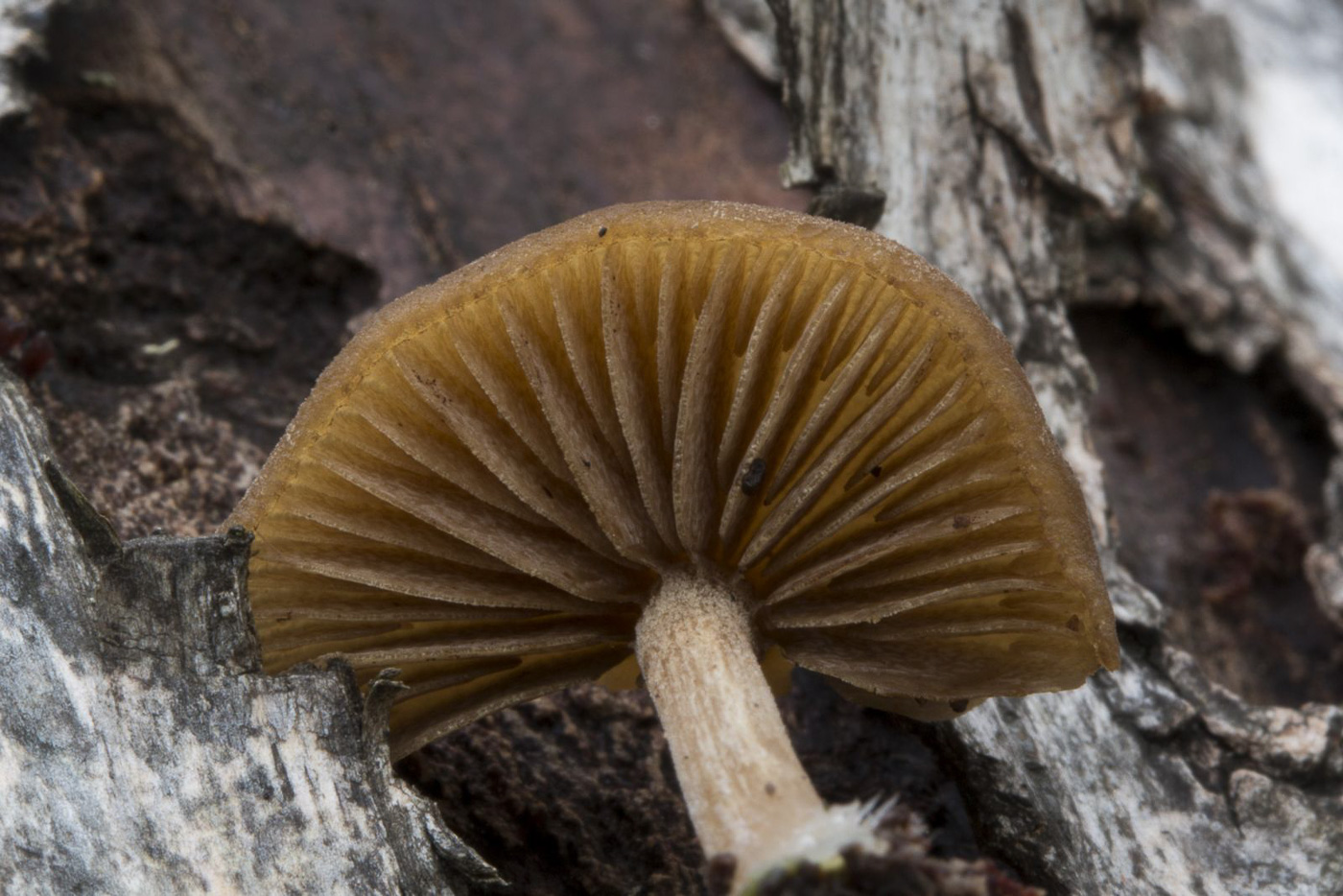
|
Simocybe sumptuosa (Velvet Twiglet) Sep 21, 2021. On a deciduous stick in Rushbeds Wood Penny noticed this LBJ, guessed it would be one of two possible species of Simocybe, so took it home to check. The fact that the genus lacks notable features apart from occurring on fallen deciduous wood is in itself a pointer to its identity. It could maybe be a small Pluteus but the gills are neither free nor pink, it could maybe be a Psathyrella but doesn't have a white brittle stem, etc, etc! Under a scope it redeems itself, having distinctive bean shaped pale brown spores and cells on the gill edge with swollen heads. Neither this species nor the very similar S. centunculus are at all rare but possibly go unnoticed or unrecognised. Oct 16, 2020. Claudi Soler found this small singleton on rotting deciduous wood in Burnham Beeches. Superficially from above it looks similar to a small Pluteus but once you turn it over and notice that the gills are not free of the stem at the top, nor are they crowded or pink, you know you have something quite different, maybe a species of Psathyrella? A scope soon eliminates that genus too, so the inexperienced would now be struggling for the genus! Luckily, Claudi knew it might well be a Simocybe so checked the microscopic features to confirm which of the two likely species he had. It is an occasional species thought easily overlooked and caps can be up to 4 cm across but are usually smaller as was the case here. |




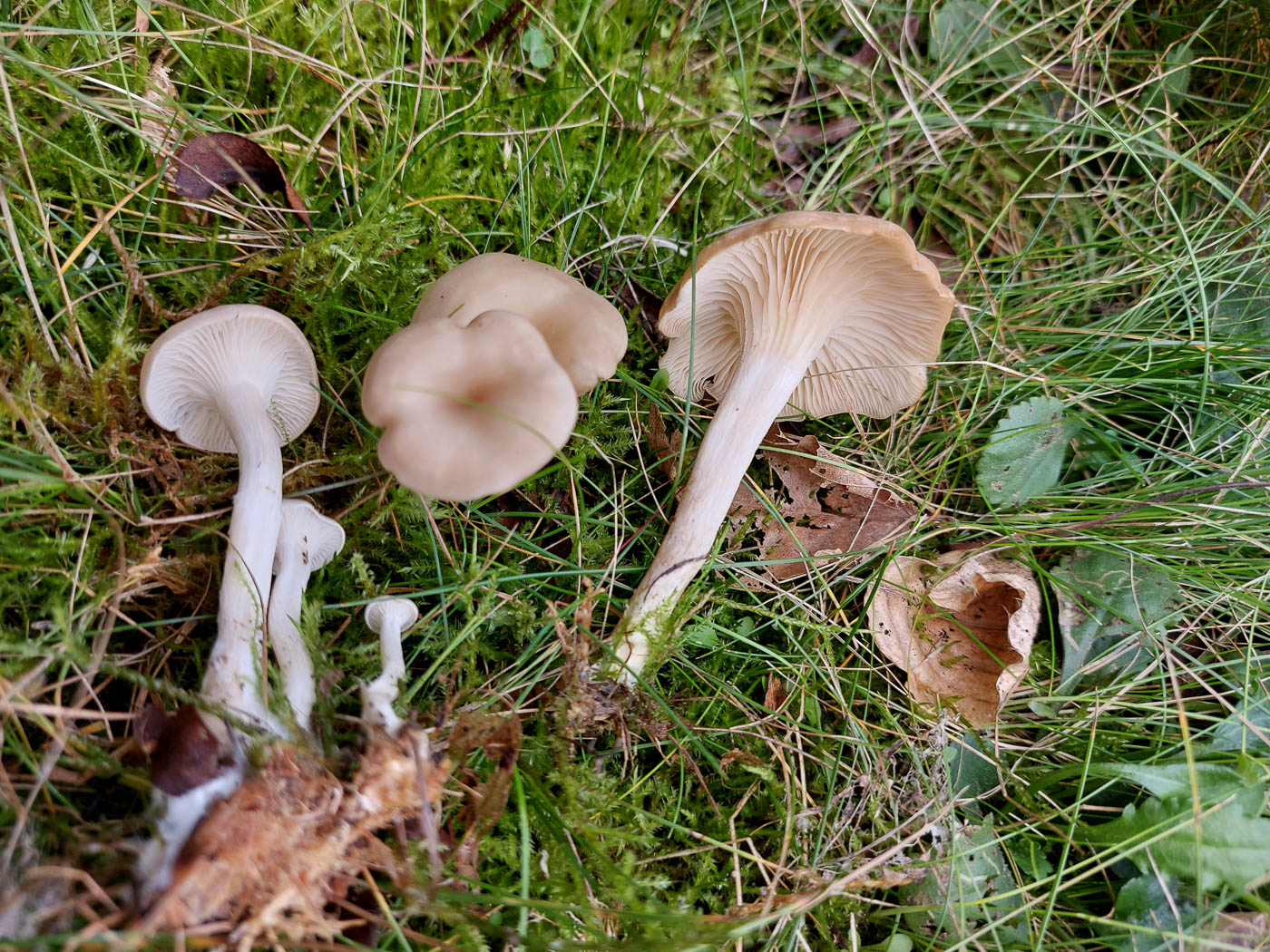
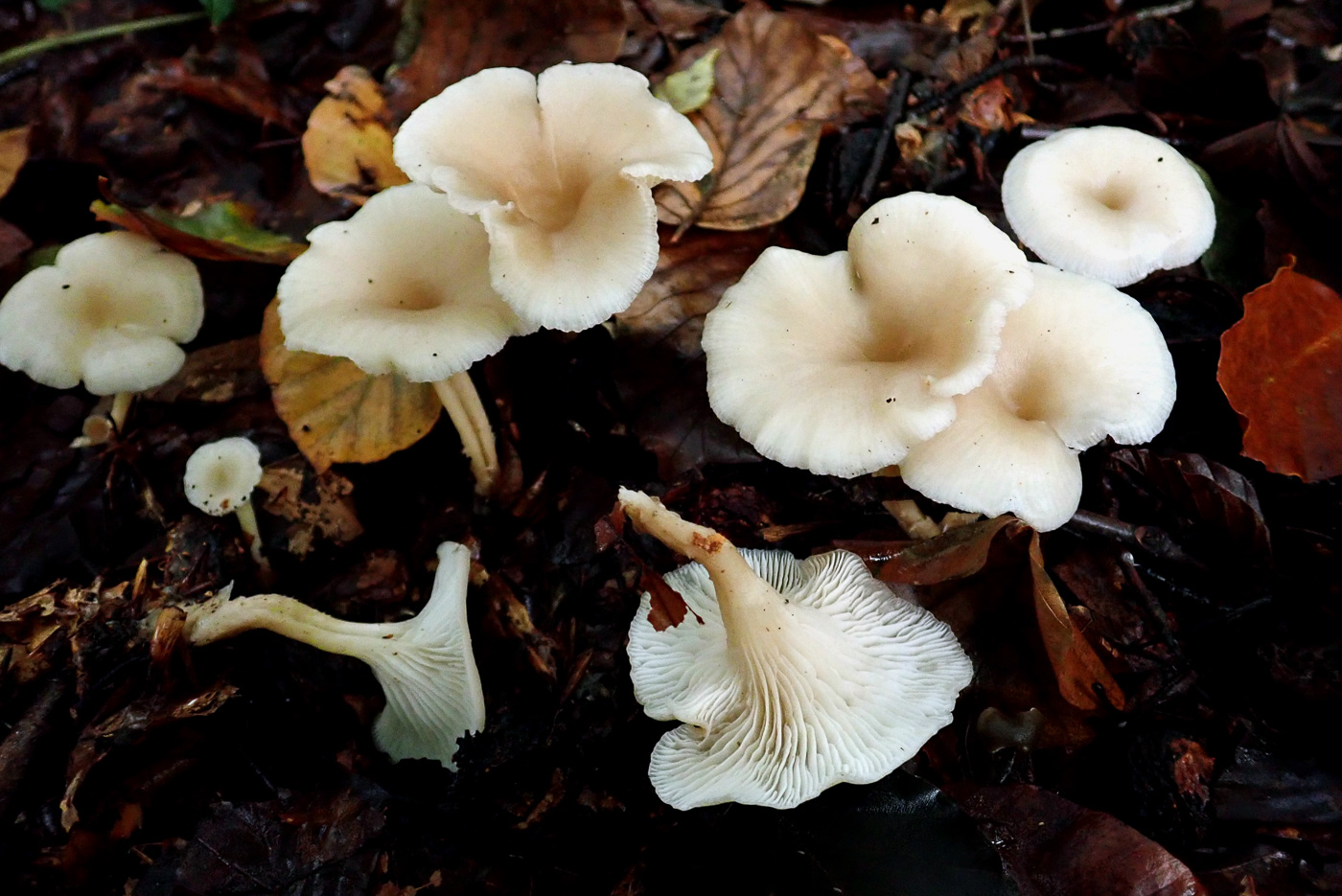
|
Singerocybe phaeophthalma (Chicken Run Funnel)
Dec 12, 2023. In mossy vegetation at St Giles Churchyard, Stoke Poges, Penny noticed this trio of Funnels, the smell of which instantly enabled her to place it to species. Wet feathers or damp dog describe the smell well, and it saves a lot of time and effort once one can recognise this in the field because so many Funnels looks very similar and lack useful microscopic characters to help. Actually today's species has some distinctive balloon-shaped cap cuticle cells - the reason for its recent move out of genus Clitocybe. Sep 27, 2023. At Stampwell Farm Jackie Ewan noticed these small pale Funnels in litter under Oak and was stumped as to their ID. Returning once they'd developed further (photo 2) and having just read Penny's Naphill Common report where this species is featured, she realised that they were very probably the same. Luckily there is a distinctive microscopic character within the cap cuticle of this particular species which Jackie was able to find to confirm her ID - this feature being the reason why the species has now been moved from Clitocybe to Singerocybe. Its other redeeming feature - a smell of wet feathers and the reason for its common name - was apparently missing today. Photo 3 is of a collection from Chalfont St Peter found by Jesper Launder a few weeks later. Sep 19, 2022. In a grassy area in his garden Jesper Launder noticed these pale Funnels, and collecting one to test for its smell - often a vital clue with Funnels - he recognised the rather unpleasant smell of wet feathers / wet dog in back of car! Many Funnels are not easy to identify because they give very little help under the microscope compared to other genera, therefore getting to know their individual smells can be really useful. This particular species was previously in genus Clitocybe. Oct 14, 2020. Yet another genus name change to get used to here: this relatively common species of Funnel was fruiting in good numbers in Beech litter in Kings Wood, found by Penny Cullington. There are quite a few very similar pale to whitish medium sized Funnels which are not easy to name to species even with a scope. Smell can play an important role, however, and this species is one which has a very distinctive smell said to be of wet feathers - hence its common name. If you're finding it hard to imagine that smell, think of a wet dog in the back of a car - that ticks the box nicely! |
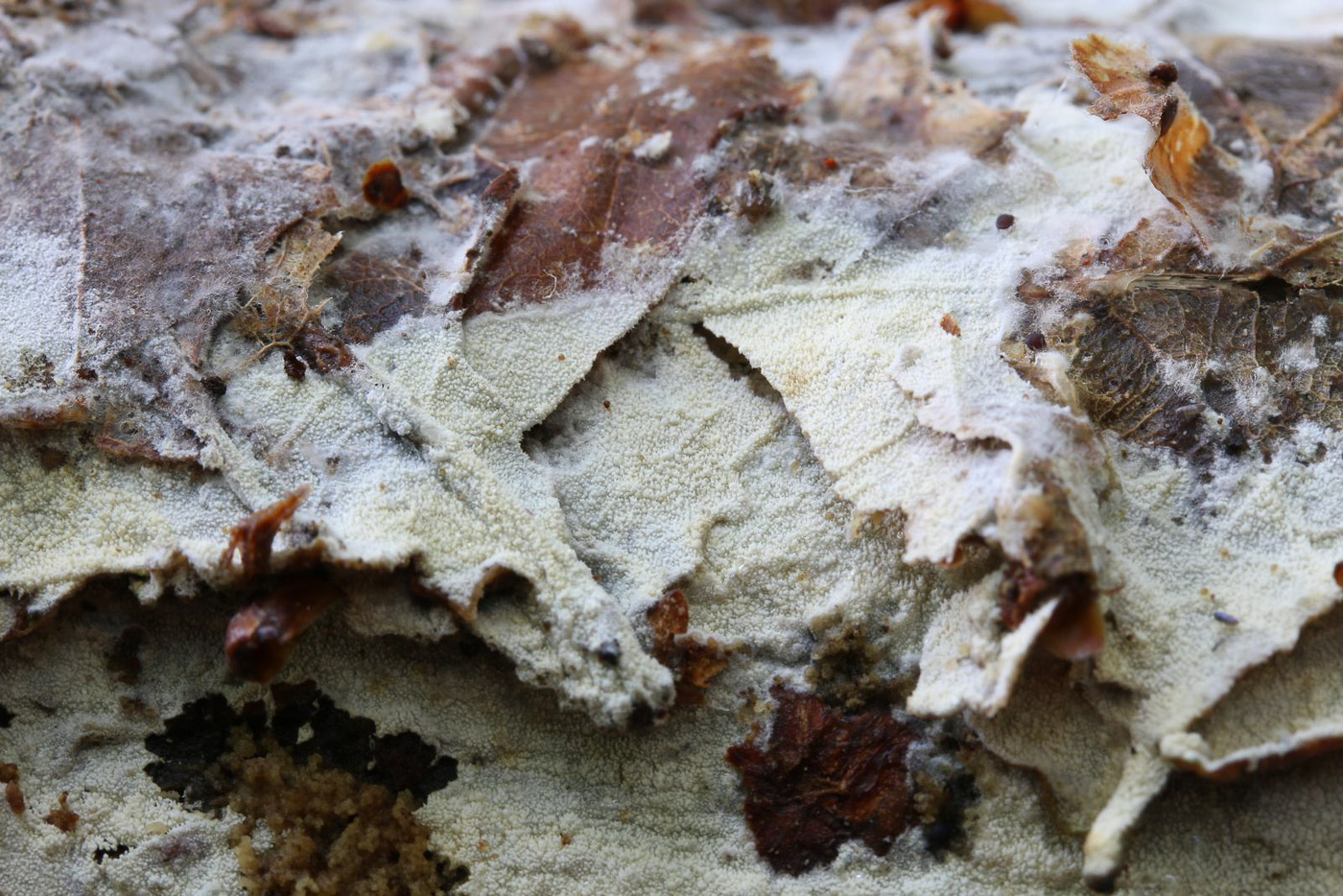 |
Sistotrema brinkmannii (a Corticioid with no common name) May 19, 2021. Kerry Robinson found this uncommon corticioid on the underside of a rotting deciduous log in Burnham Beeches. It is one which has a soft fragile granular white surface but one needs to check the microscopic features to confirm the identification. it appears to be new not only to the site but also to the county. (Photos Claudi Soler) |
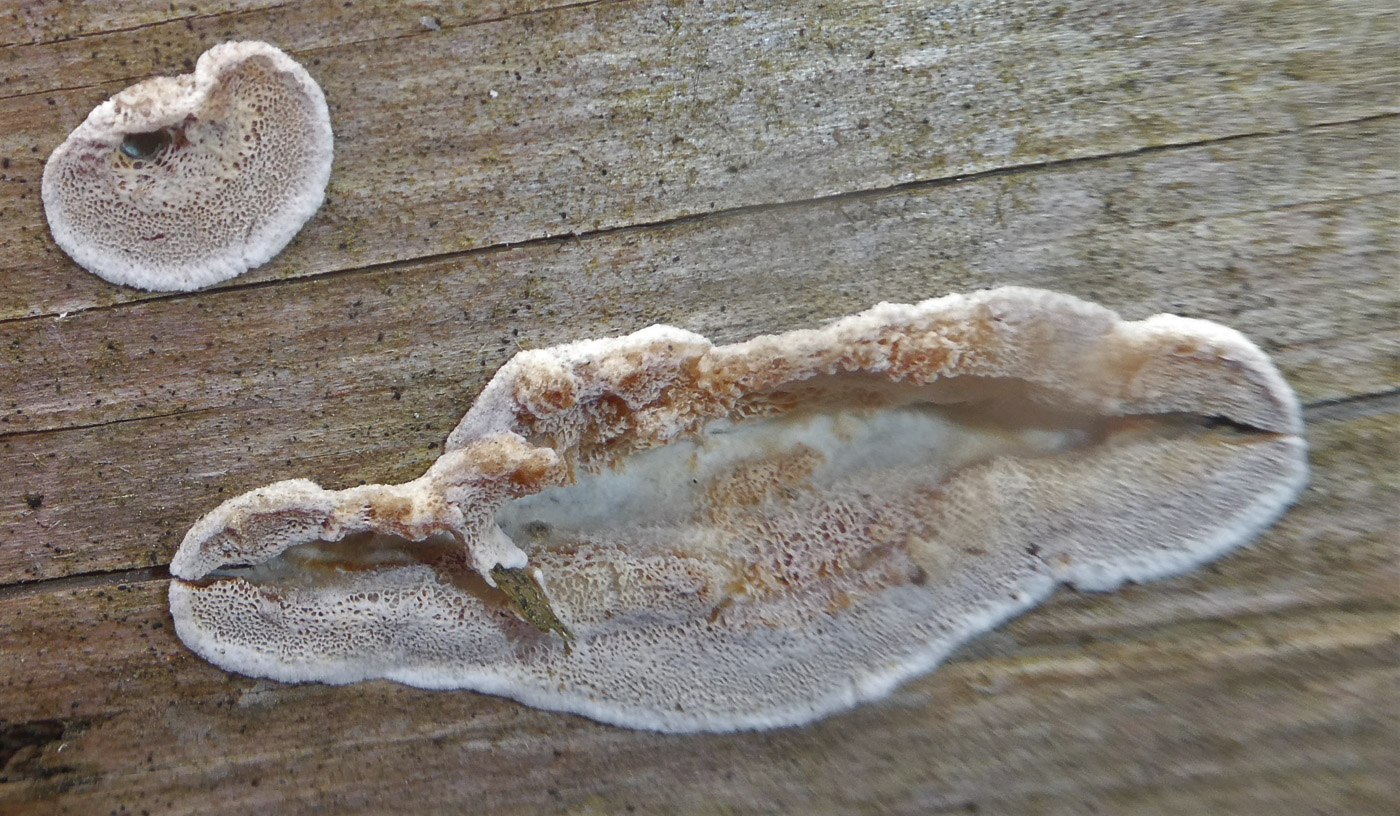
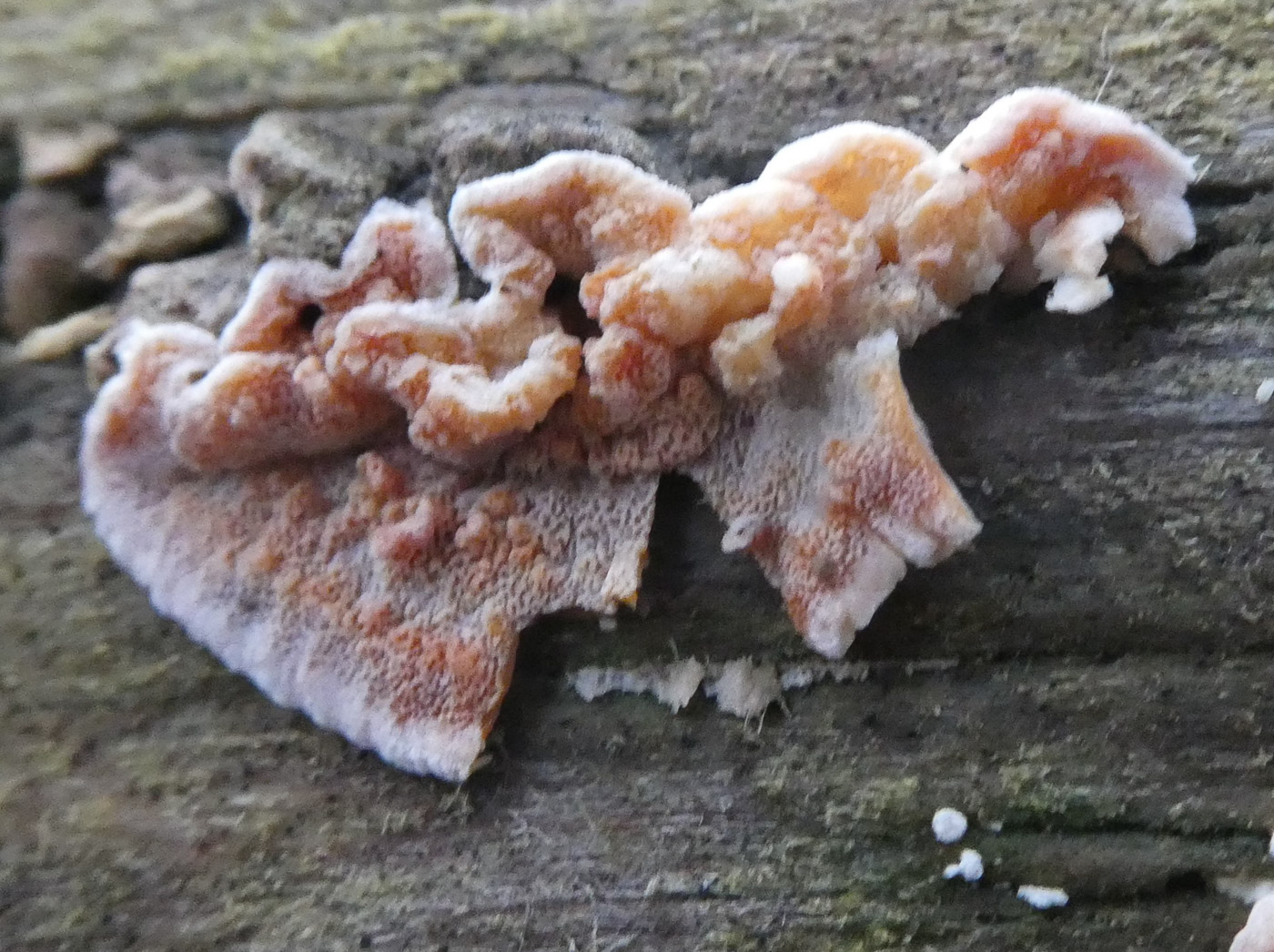
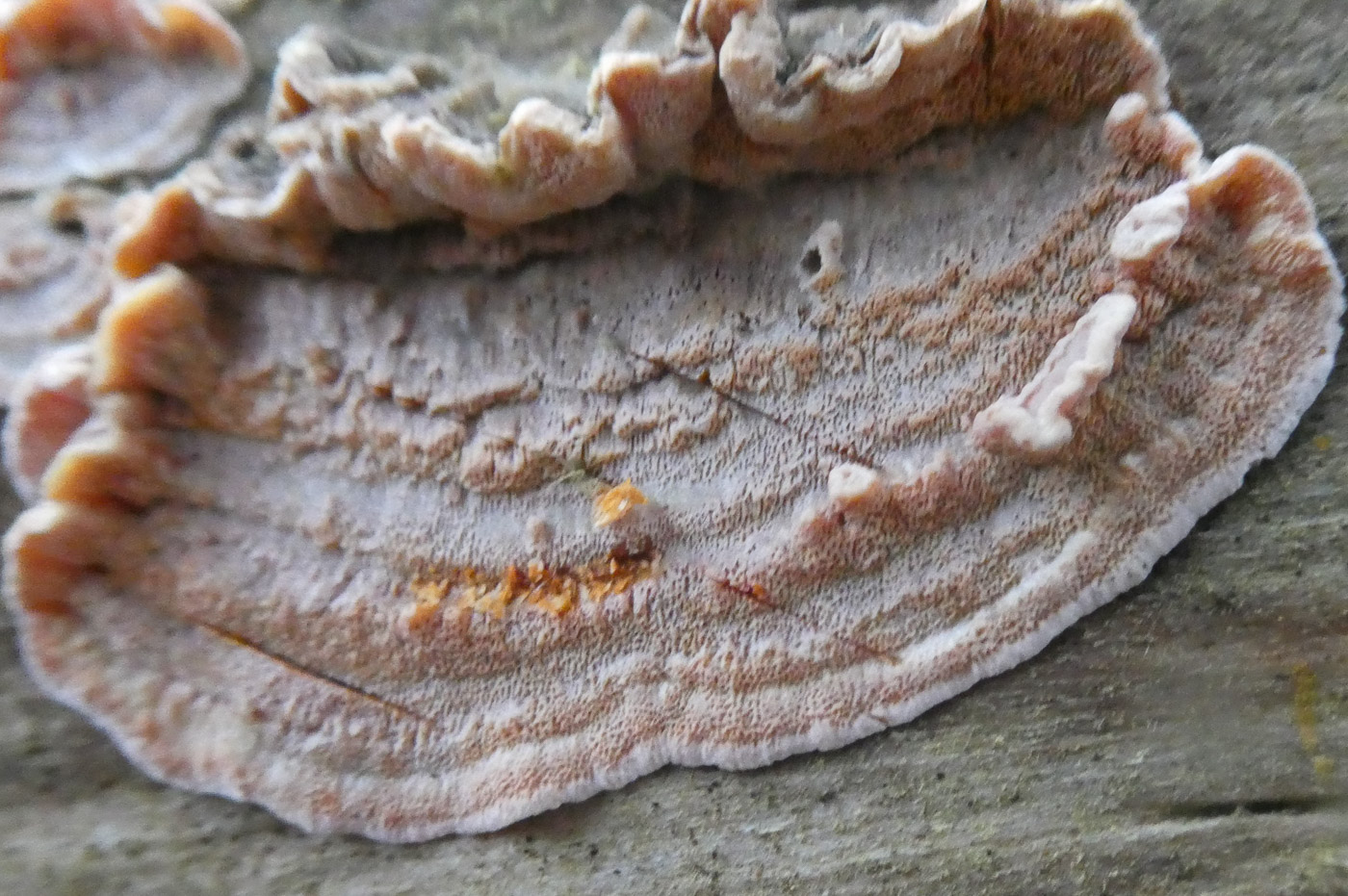 |
Skeletocutis amorpha (Rusty Crust) Mar 4, 2022. On fallen conifer at Stoke Common Jim Wills spotted several patches of this corticioid species which was unfamiliar to him. Searching through books and online, he came across this species which seemed to fit the bill, so sent Penny his photos in the hope that he could be correct, the key features being the tendency of the finely poroid undersurface to turn rusty orange as it matures, also when fresh and young the soft texture making it easily removable from its conifer substrate - though it dries hard as it matures. Photo 1 is of a fresh sample, photos 2 and 3 show the rusty orange just developing on the pores. The species is confined to conifer but is not a rarity and we have a handful of other county sites though it appears to be new to both Burnham Beeches and Stoke Common during March this year. |
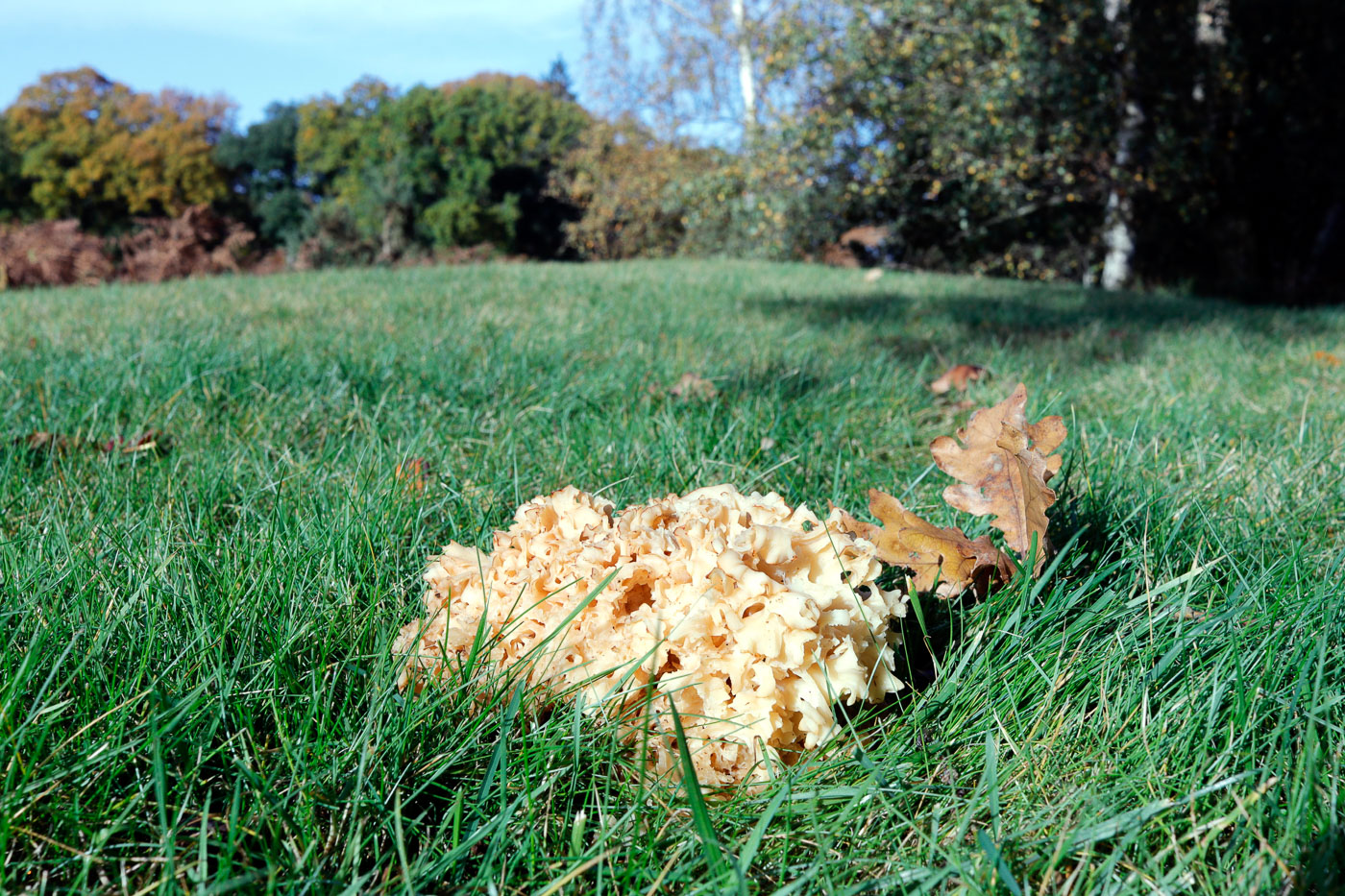
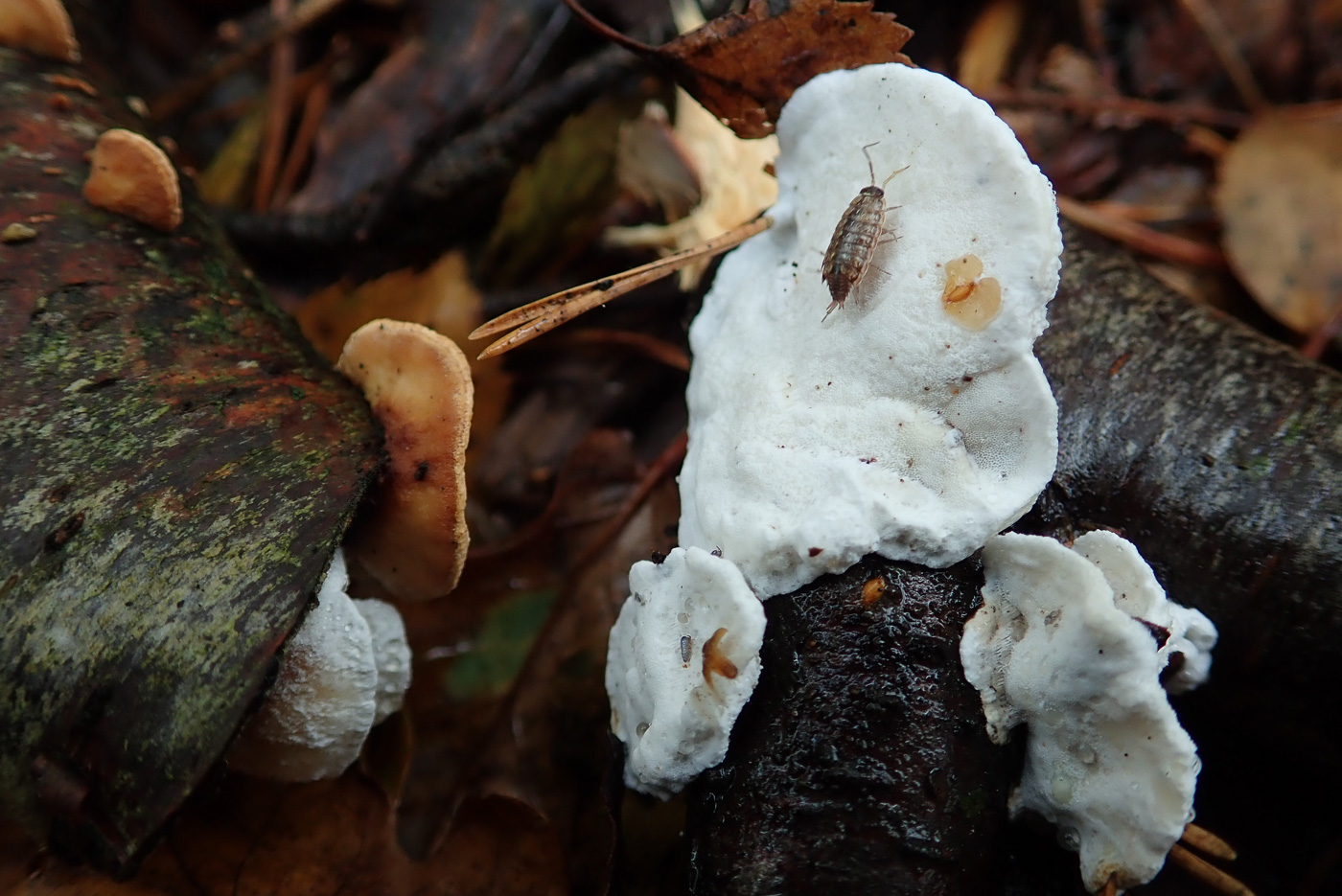
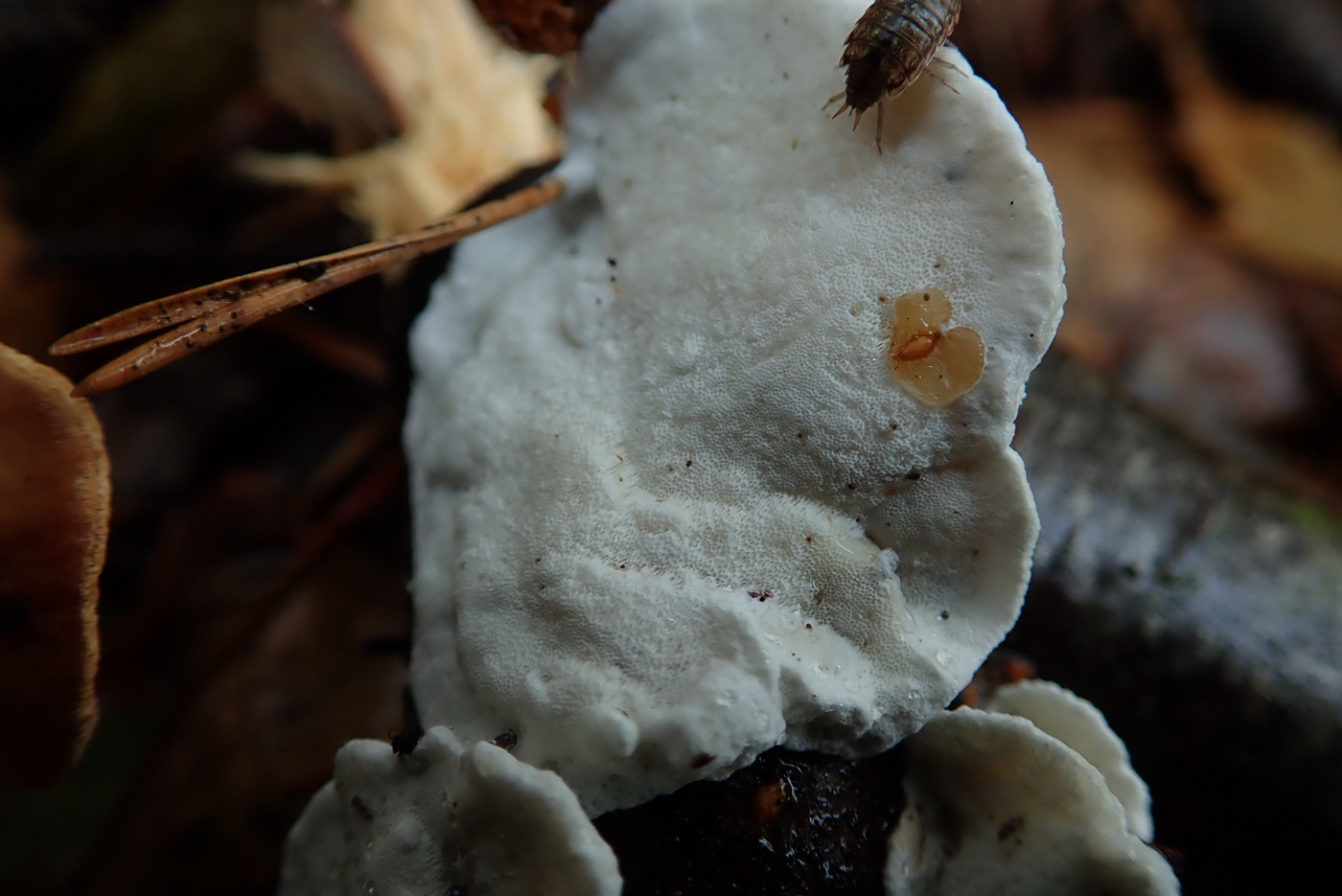
|
Skeletocutis nivea (Hazel Bracket) Oct 25, 2020. Whilst walking on Woburn Golf Course, Justin Long came across this large clump of what was clearly a species of Sparassis. However, the fairly common S. crispa is known to grow only at the base of Pine trunks or occasionally other conifers and Justin noted that there was no conifer in the area and that this was growing in grass near Oak. For this reason we decided that a DNA sequence was called for: S. spathulata, a rarity which grows with Oak, was a possibility, as was S. brevipes - not yet found un the UK. Surely this had to be one of those two and with so many strange fungi being found this Autumn we felt anything was possible! Not so because in January the results showed that its sequence was a 100% match for S. crispa. This was not a wasted exercise, however: this may well be the first time the species has been positively identified growing with Oak, casting doubt on the previous few records of S. spathulata in the UK. The wonders of modern science!No Nov 3, 2020. On a deciduous stick in Burnham Beeches Penny C. found this species, notable for its white tiny pores - hardly visible to the naked eye but just discernable in photo 2 together with the wood louse! Usually found growing resupinate (flat) so just showing its white surface, it sometimes forms small brackets which in time become brown, seen in photo 1. It is quite soft and easily detached from its substrate which is not necessarily Hazel as implied in the common name: it is common on many different hardwoods. |



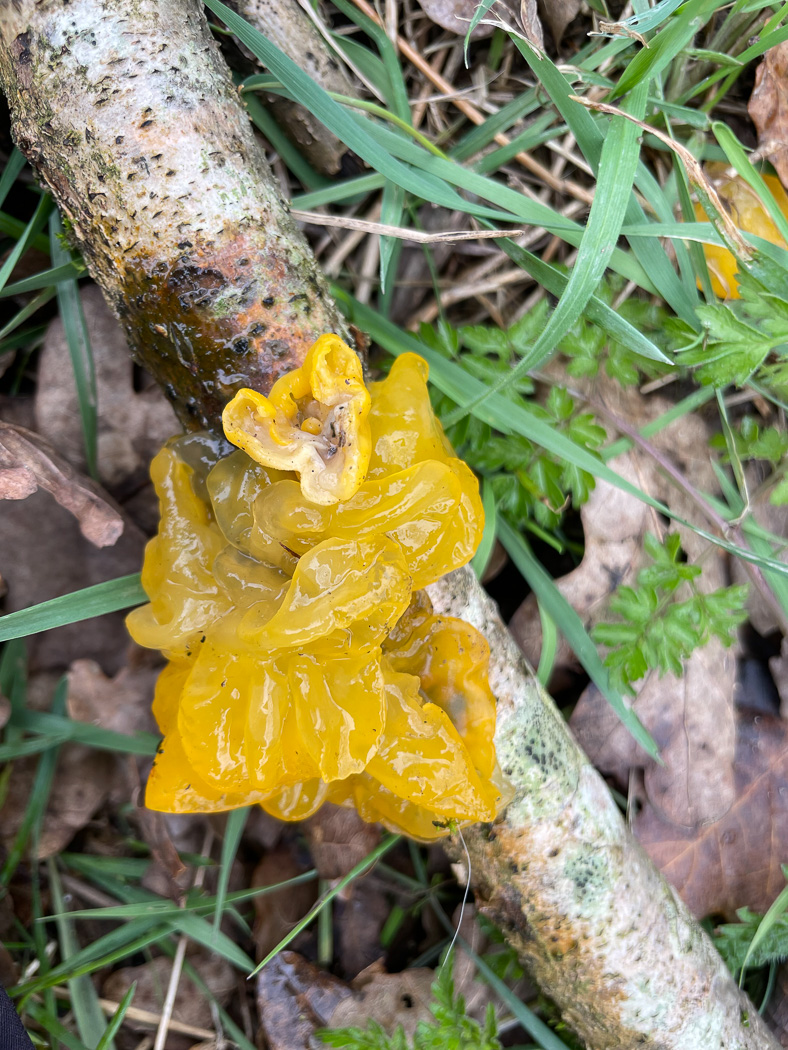
 |
Slime Flux (no Latin name and not fungal but an aggregation of various bacteria) Feb 20, 2024. In a hedge near Tinkers Wood John Catterson noticed this impressive example of what he could only think was the common Tremella mesenterica (Yellow Brain) fruiting prolifically on a stem of Old Man's Beard. He sent his photos (1 and 2) to Penny but with a query because its abundance appeared atypical and its host plant seemed strange also. With no microscopic check available, Penny also assumed it must be the Tremella but when Sarah Ebdon saw the subsequent entry in Finds she smelt a rat because this rang a bell with her. Two years previously she'd gone through this same questioning process with a similar collection which had turned out to be not fungal but a bacterial infection. She contacted John and together they returned to the spot to examine this somewhat strange and smelly growth which she then collected together with some genuine T. mesenterica nearby to facilitate a proper microscopic comparison. Conclusion: it was microscopically completely unlike anything fungal and indeed matched descriptions of Slime Flux which apparently can often attack damaged Clematis plants, especially in the Spring. Sarah's photos 3-5 show samples of Slime Flux placed adjacent to genuine much shinier T. mesenterica. We felt it was well worth including these photos in Finds as yet another example of how misleading fungal identification can be! Sarah should be congratulated on recognising this strange organism and bringing it to Penny's attention. See previous entries of Tremella mesenterica |
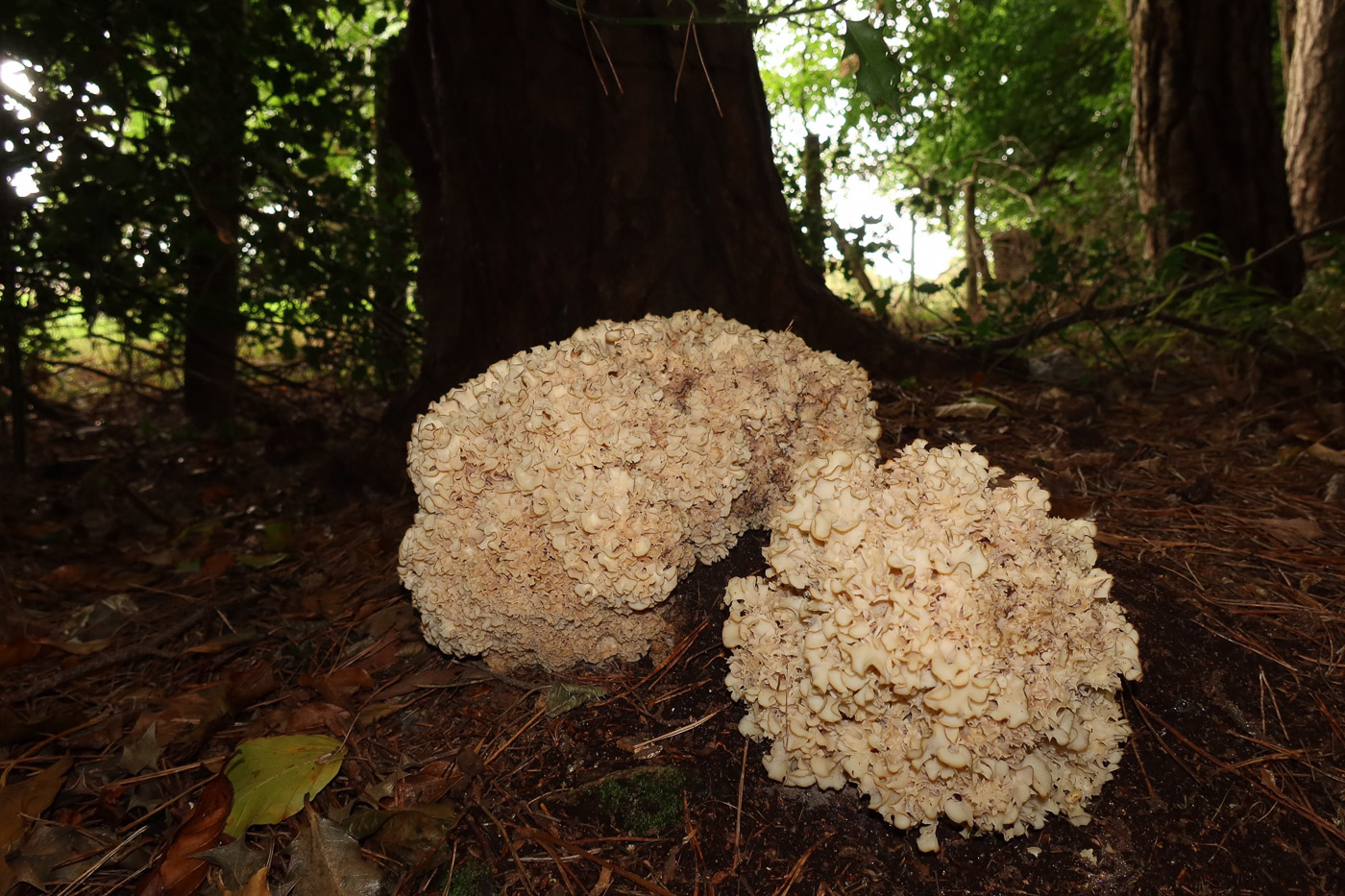

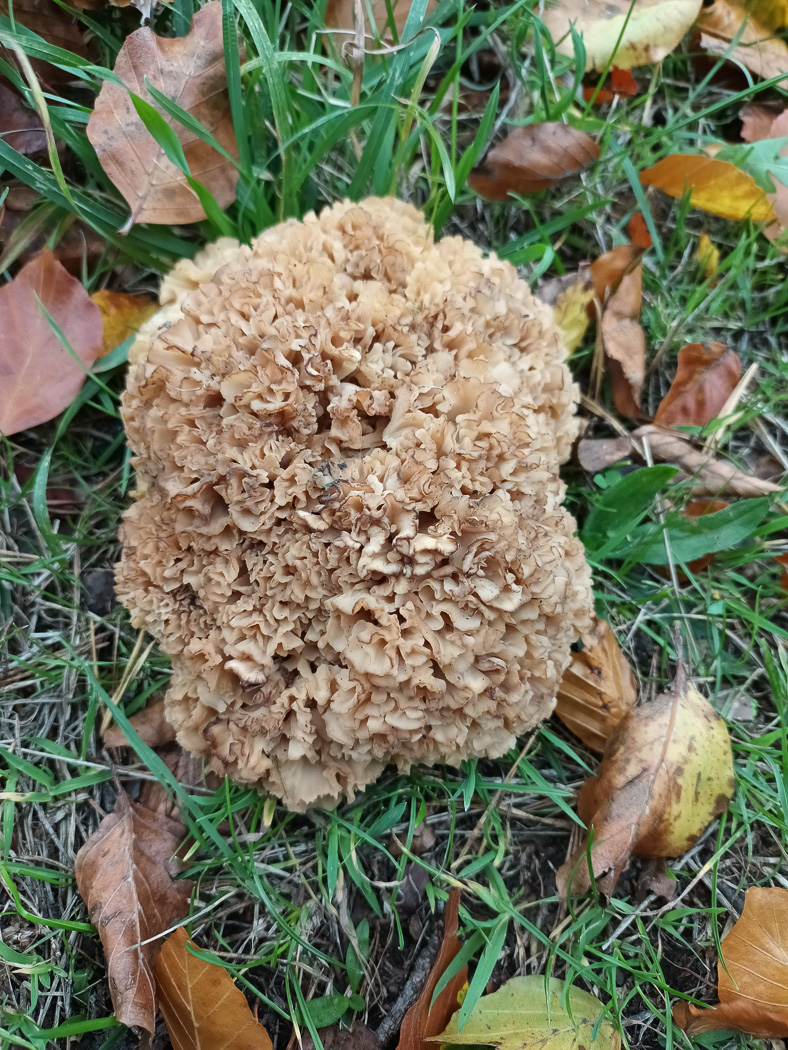 |
Sparasssis crispa (Wood Cauliflower) Sep 15, 2022. In Downley Woods (presumably at the base of conifer) Claire Williams was delighted to see this beautiful species, one which she'd not found in this area before. This large and eye-catching basidiomycete can get to anything up to 1ft 6in across - far bigger than any cauliflower- and the species is always associated with conifer, usually Pine, growing on roots or at the trunk base. If you find one on or near a deciduous tree please let Penny know! Oct 19, 2021. In Chalfont St. Peter Jesper Launder found this impressive and beautiful species which grows at the base of conifers, most commonly Pine, and can get to a huge size - several times larger than this specimen which - judging from the windswept Beech leaves in the photo - was about 20 cms across. It is related to the Polypores, and if you find it under Oak with no conifers in the vicinity you may have the much rarer S. brevipes. |
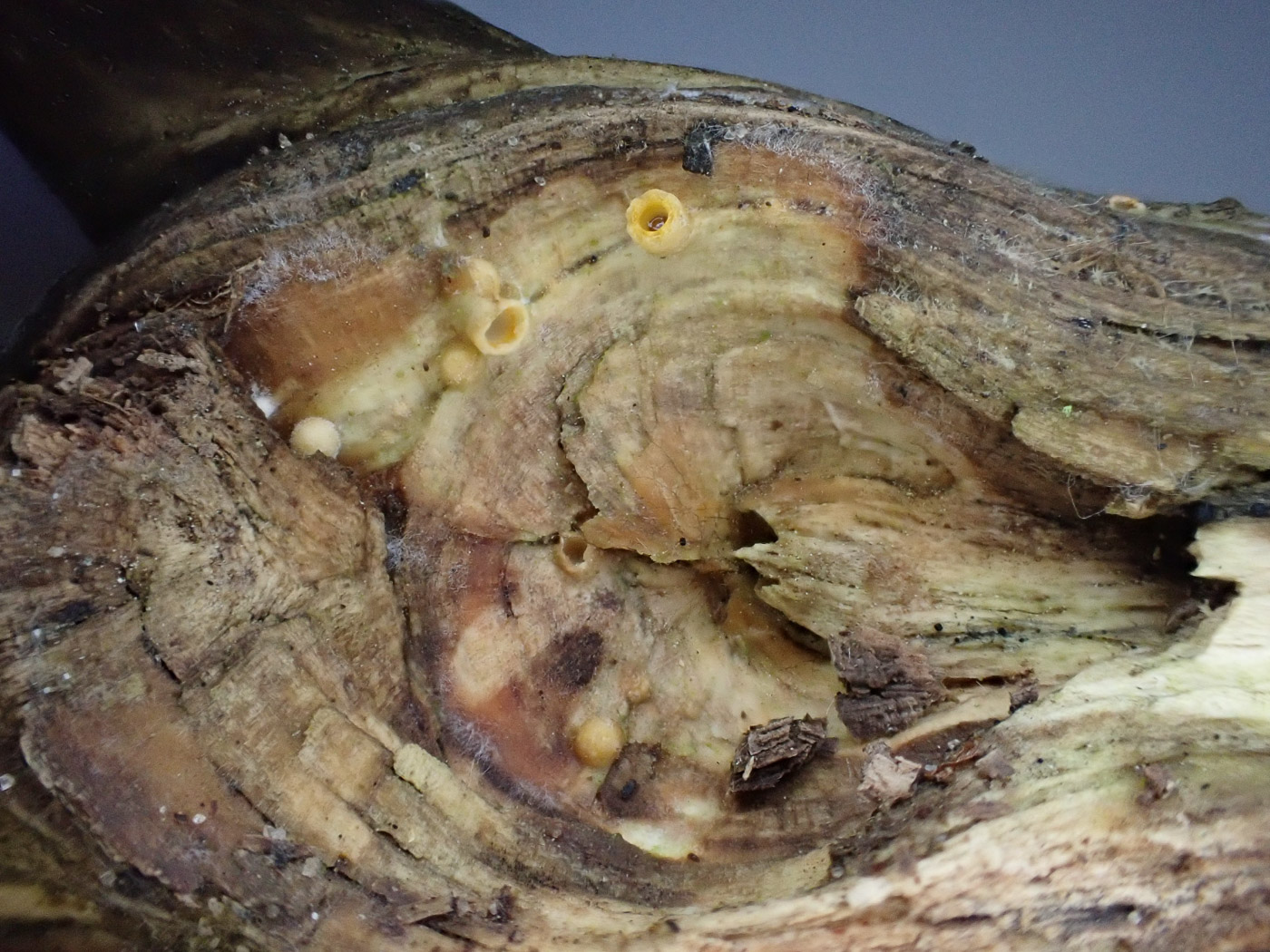
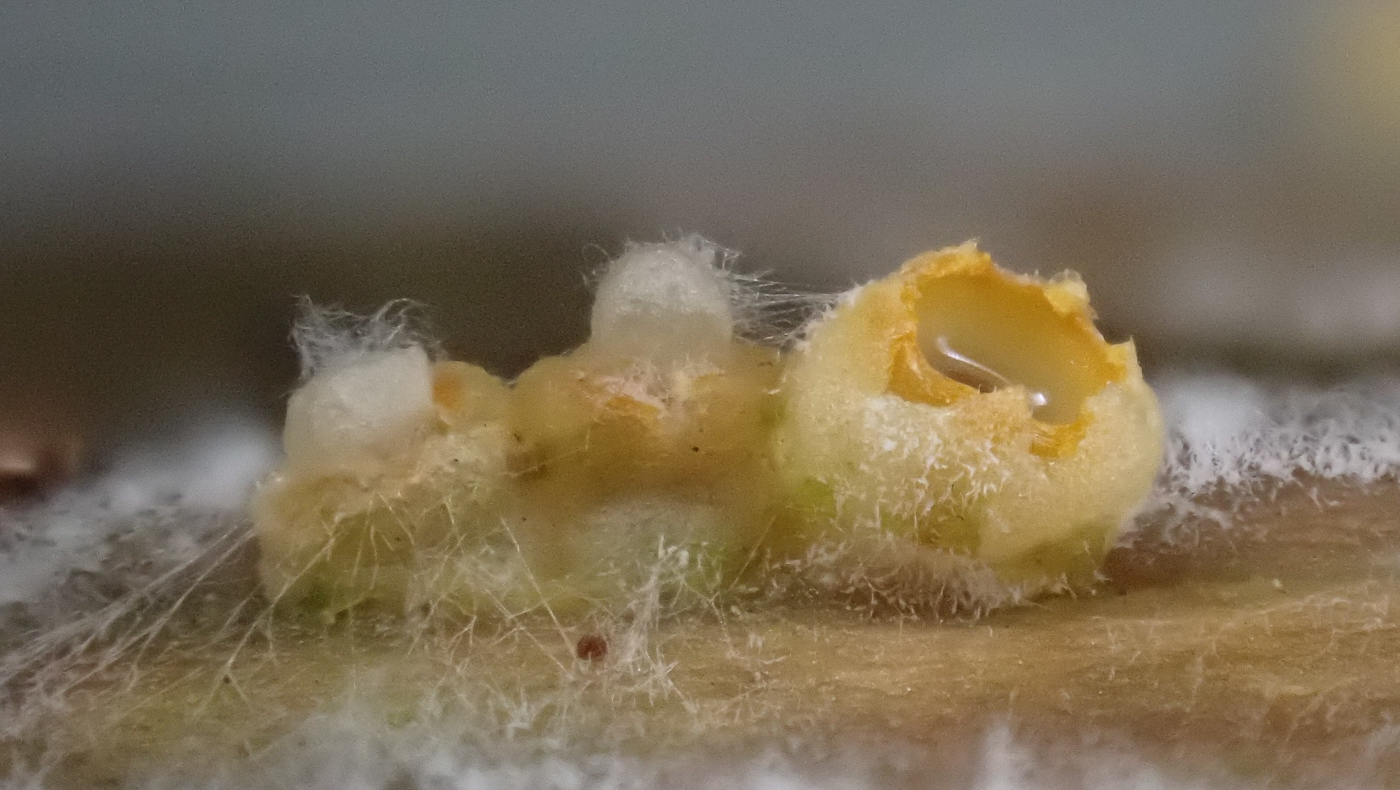
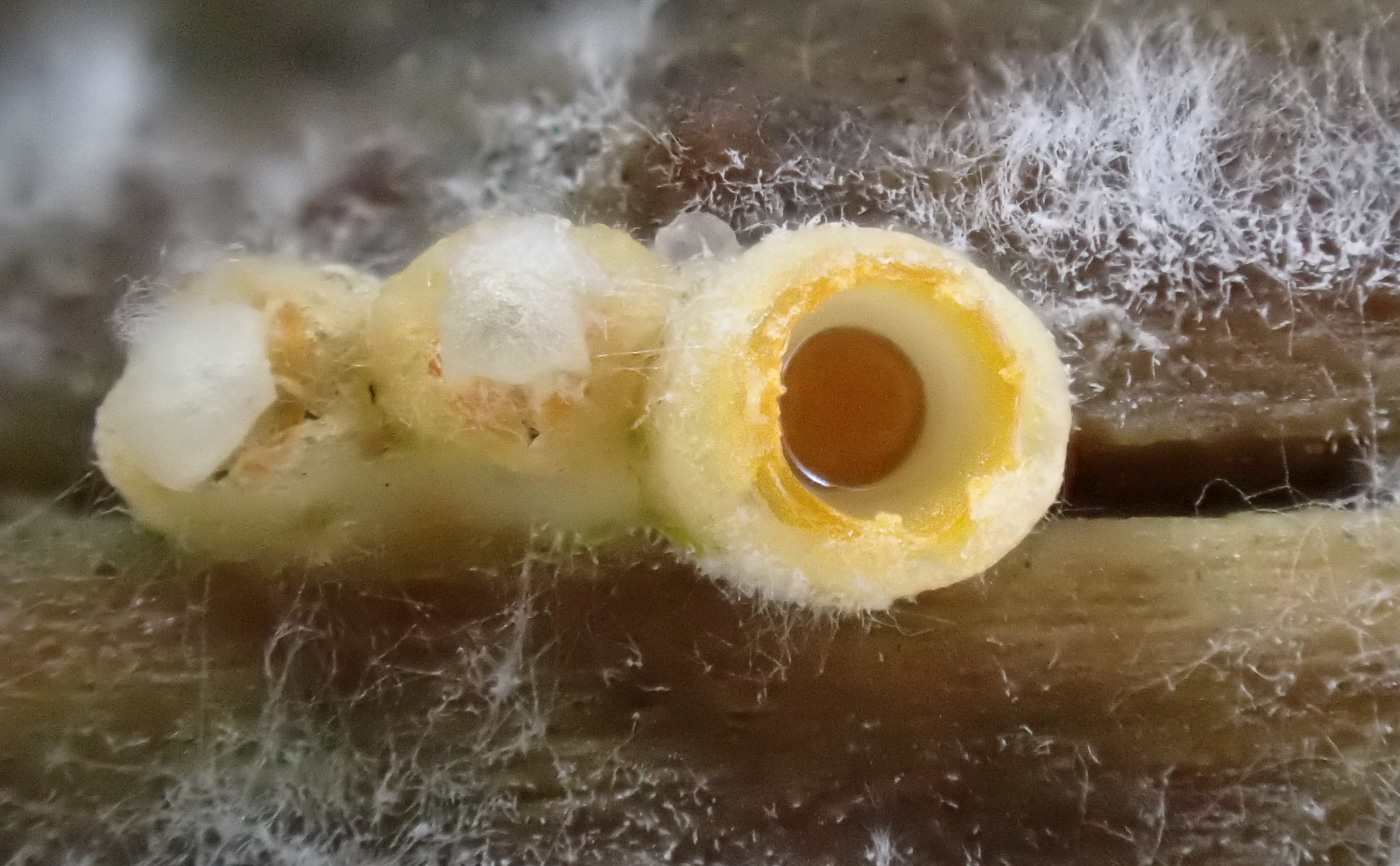 |
Sphaerobolus stellatus ( Shooting Star) Dec 8, 2022. When clearing out some old specimens at home, Stephen Plummer came across a rotting bare stick collected from Apsley Heath on a previous visit which he noticed now had some intriguing tiny fungi growing on it. At first at a loss, he then wondered if this might be related to the Birds Nest fungi and when checking it out came across a really good match for his find. This is indeed a Gasteromycete species, as are the Birds Nests, but is quite unique in its method of spore dispersal. Penny learnt that once it opens out, despite being only 2 mm across it shoots the whole of the central part (containing the spores) several metres away! To find out more, there are some videos online. Another common name for it is Cannonball Fungus. What a lucky chance to discover it! This is new to the county. |
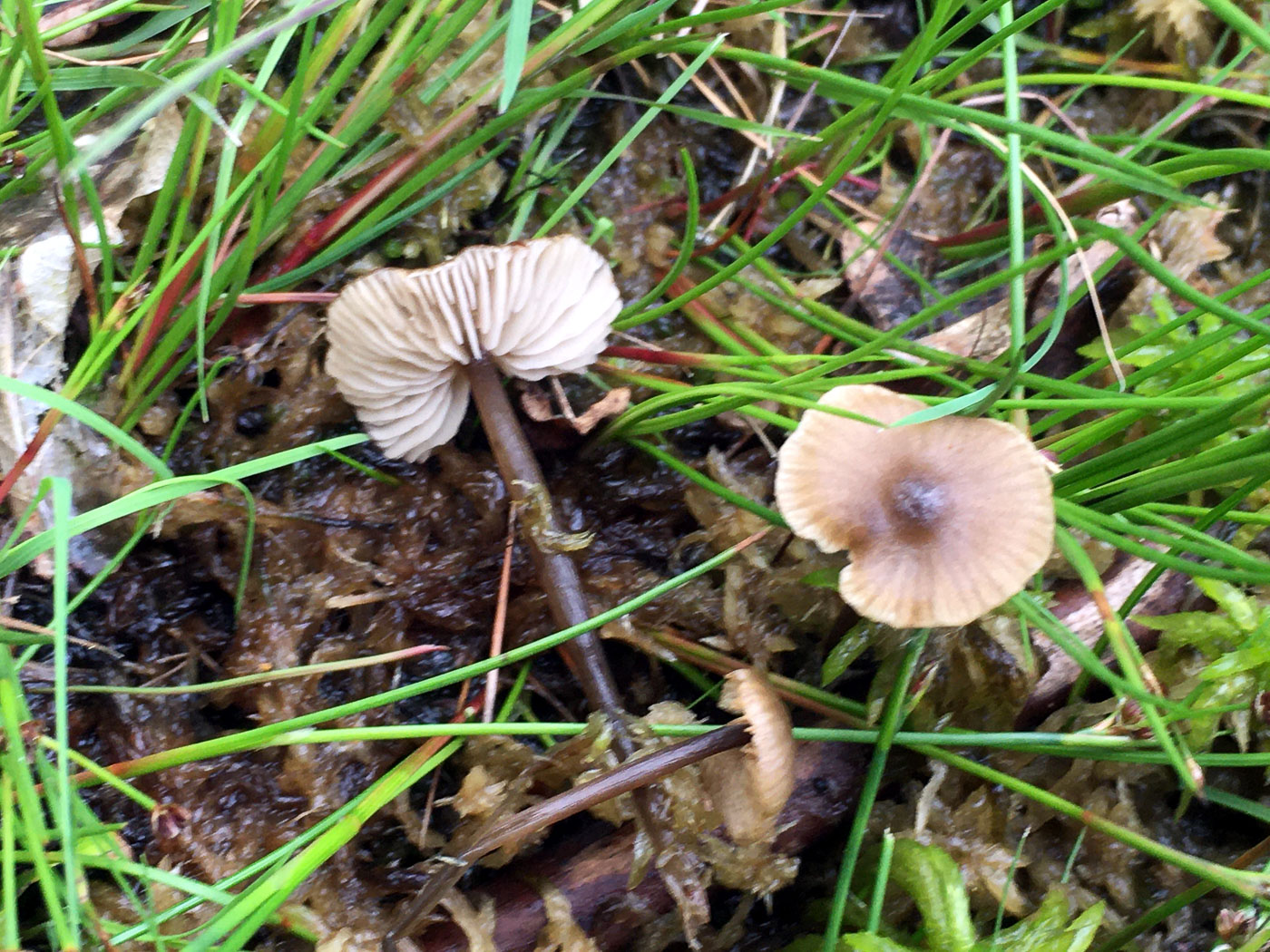
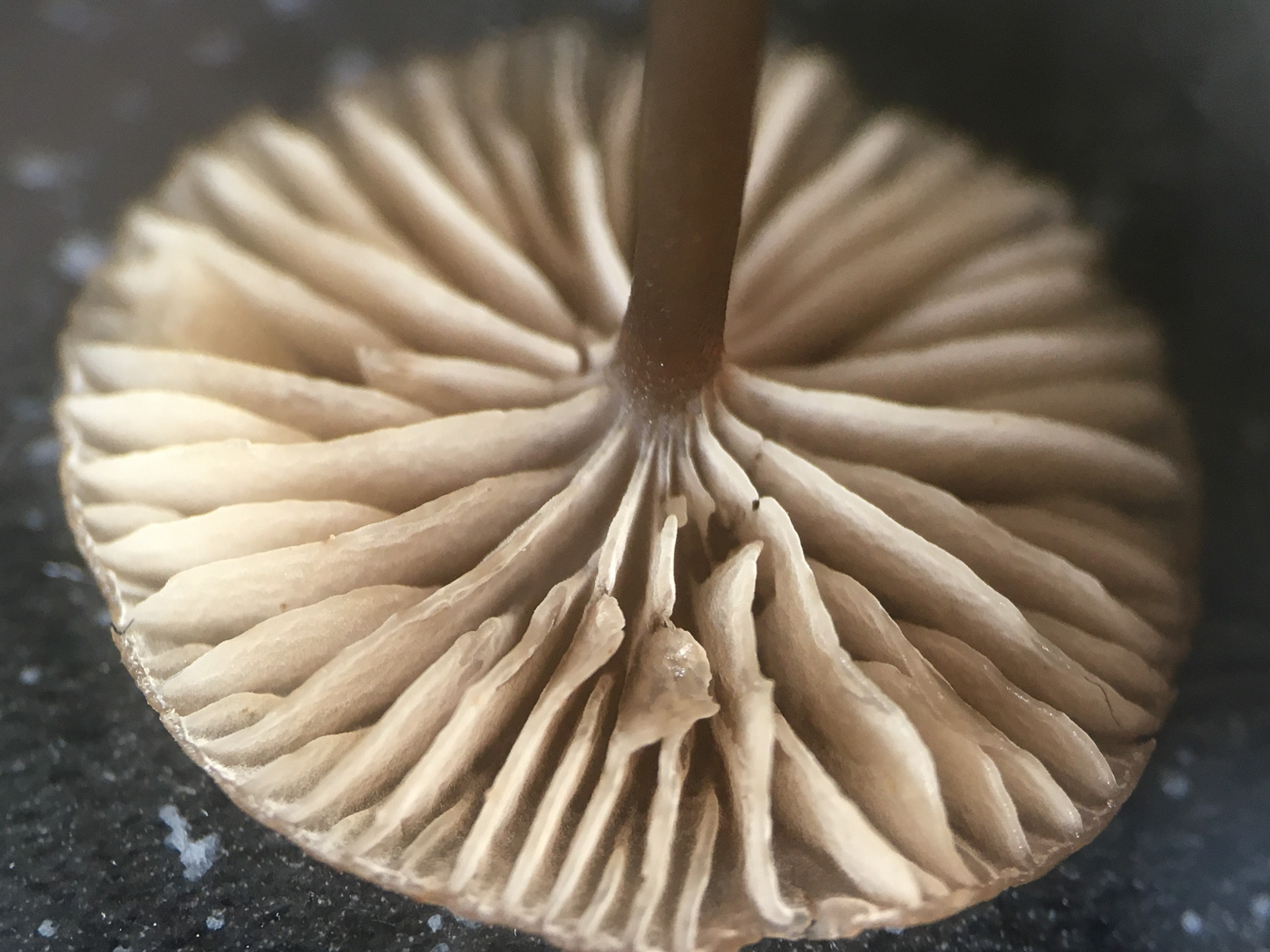
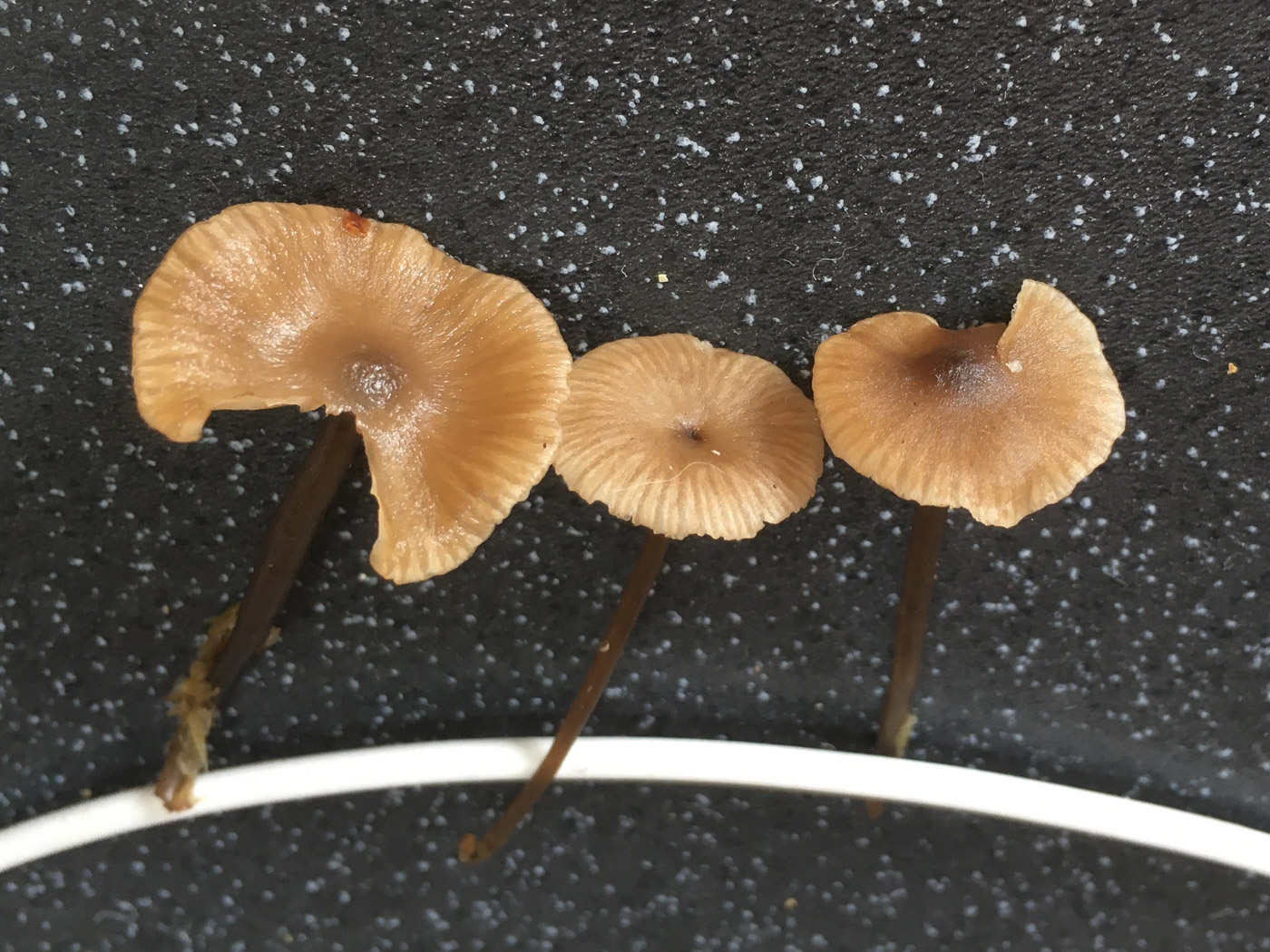 |
Sphagnurus paluster (an Agaric with no common name) Jun 26, 2021. In a boggy area in Burnham Beeches Russell Ness found this unusual species growing in Sphagnum (a previous name was Tephrocybe palustris, the species name referring to marshes / mires). This is a typical LBJ looking somewhat similar to an Entoloma but in the field has a couple of redeeming features besides the fact that it only occurs with Sphagnum: The spores are white (unlike the pink spores of Entoloma), the gills are emarginate to slightly decurrent (see photo 2) and it has a distinctive rather strong rancid smell which some describe as of cucumber! We have just three previous county records, all from various parts of Burnham Beeches. |
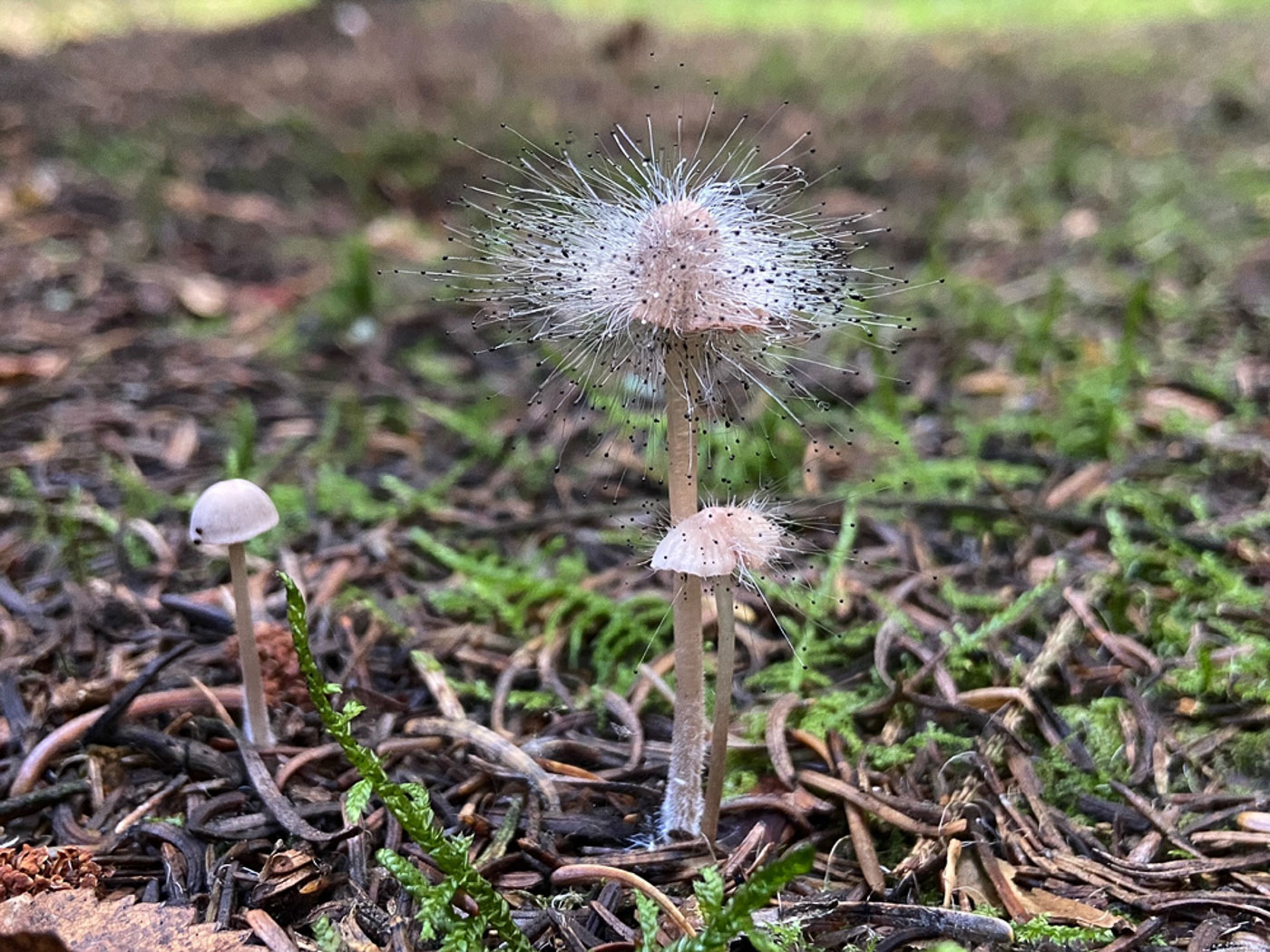 |
Spinellus fusiger (Bonnet Mould) Oct 21, 2024. At Rushmere Estate Stephen Plummer found this nice example of a fungus growing on a fungus! It occurs quite frequently on various species of Bonnet (the species was not identified here!) and occasionally on other genera as well. |

 |
Squamanita paradoxa (Powdercap Strangler) Nov 16, 2023. In a mossy patch under conifers in Bernwood Forest Jesper Launder found good numbers of Cystoderma amianthinum (Earthy Powdercap) and amongst them he noticed one cap which was not the expected cream colour but much greyer. He immediately wondered if he'd chanced upon the rare and illusive Squamanita paradoxa, the cuckoo of the fungal world! This parasitic species invades the hapless Cystoderma, takes over its scaly stem and replaces the cap with its own fertile cap instead, resulting in this bizarre-looking mushroom, half Cystoderma, half Squamanita! It only inhabits this particular Cystoderma species and was new to the county when found in Burnham Beeches in 2019 by Barry Webb. This is new to Finds and was an exciting find. |
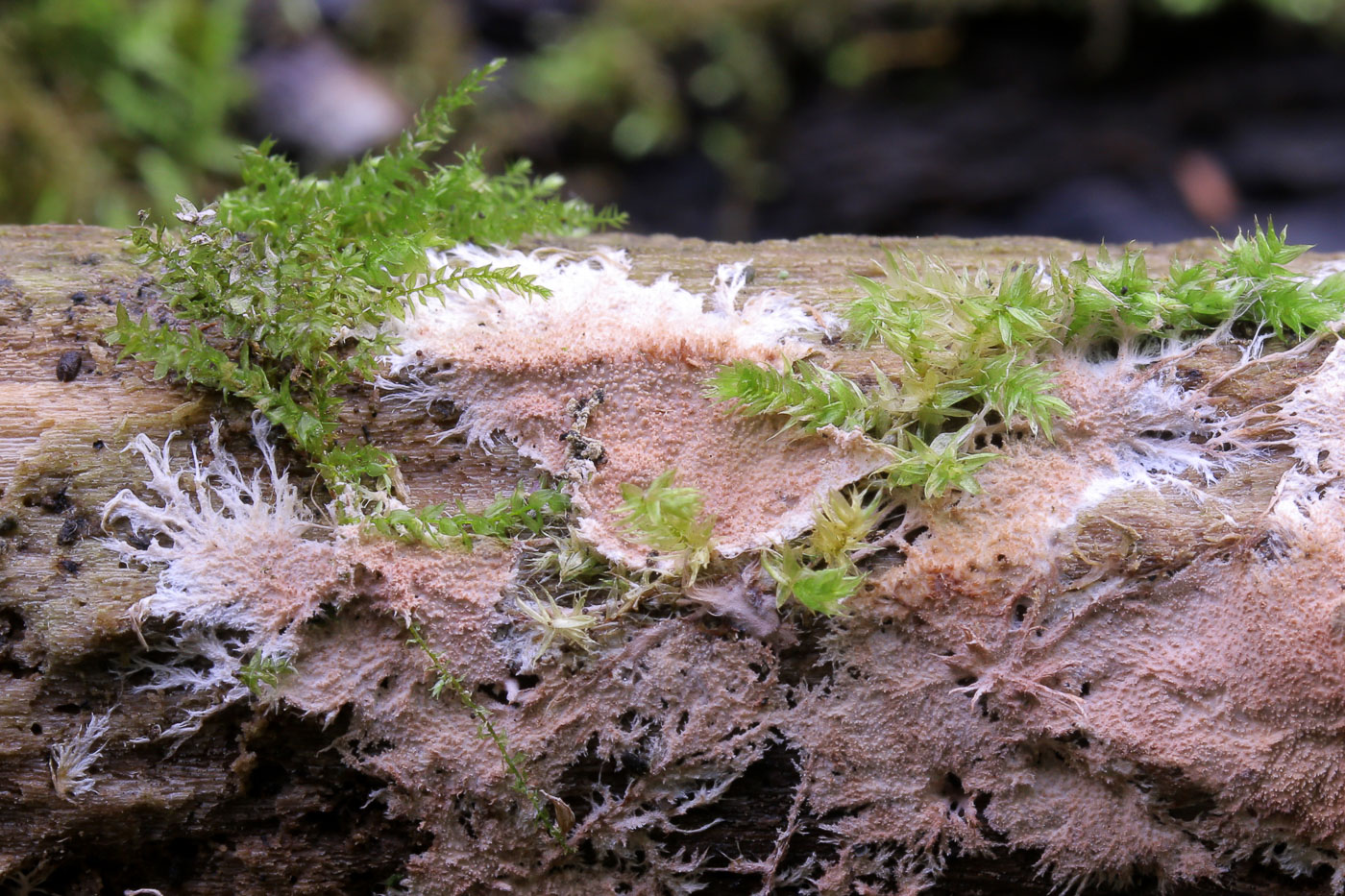 |
Steccherinum fimbreatum (a Corticioid species with no common name) Oct 22, 2022. On a deciduous stick at Dancersend this distinctive and colourful Corticioid species was found, then handed to Claudi Soler to photograph and identify later. We have just three previous records (though the species is not considered rare) and it was new to the site today. |
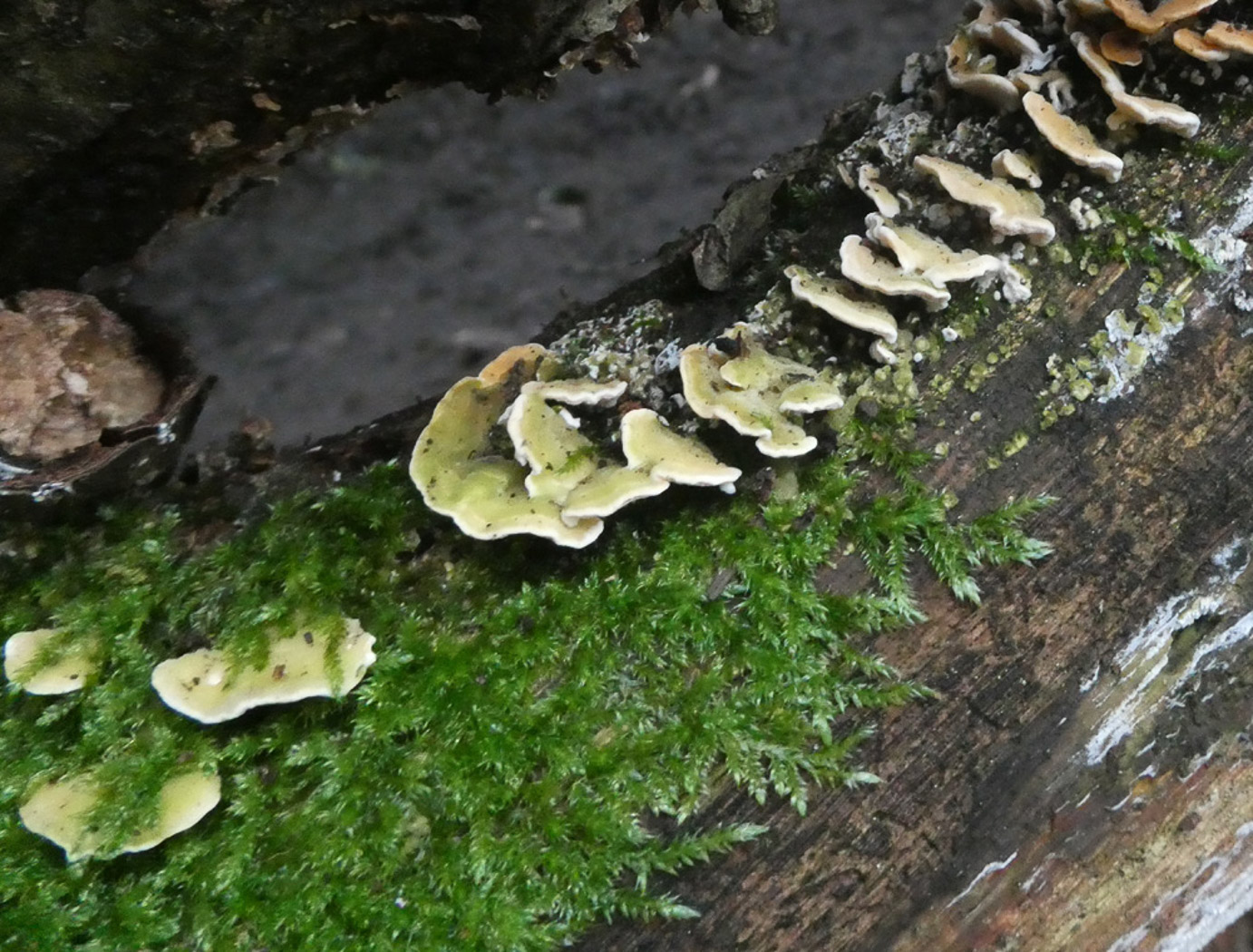
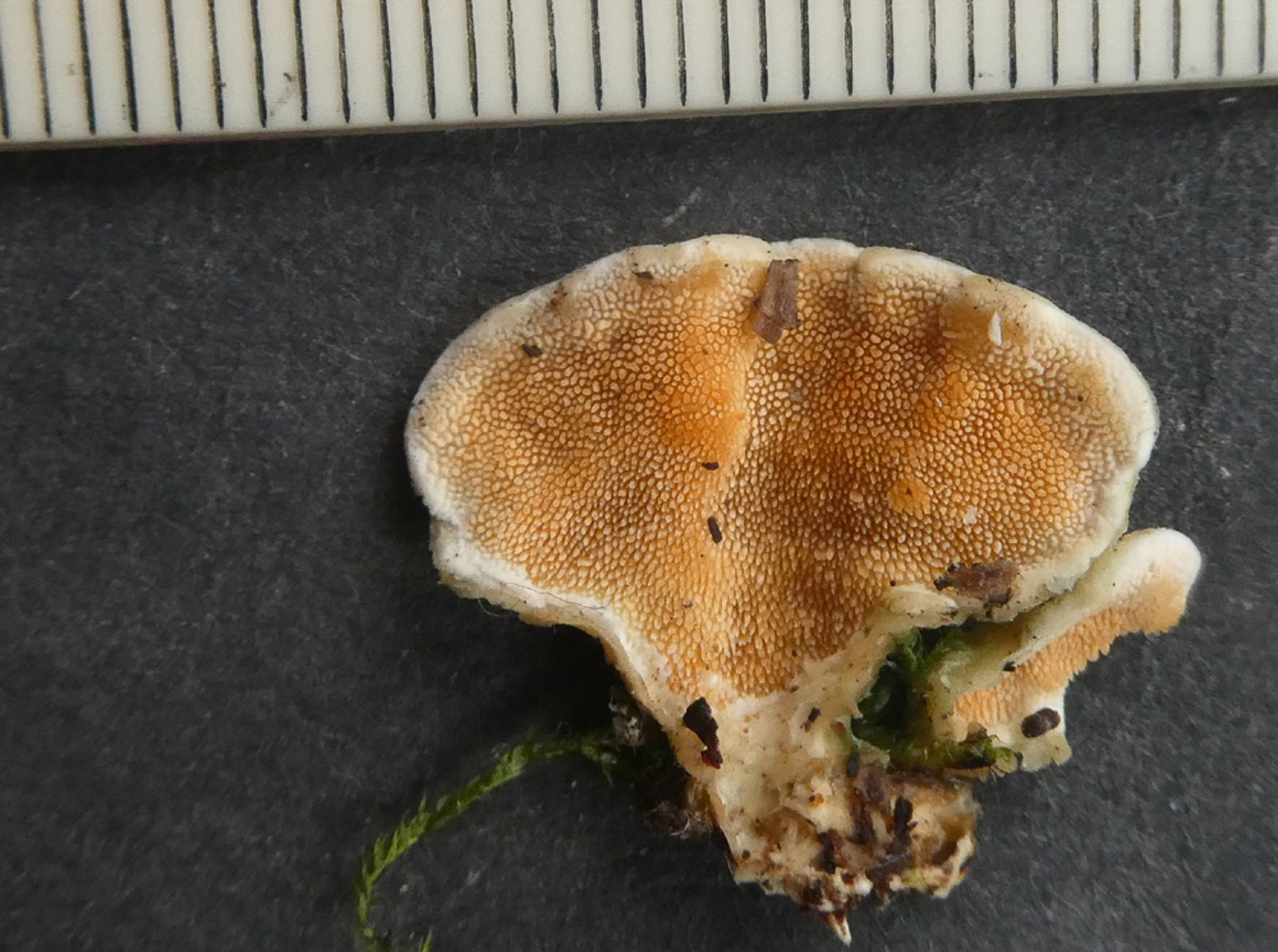
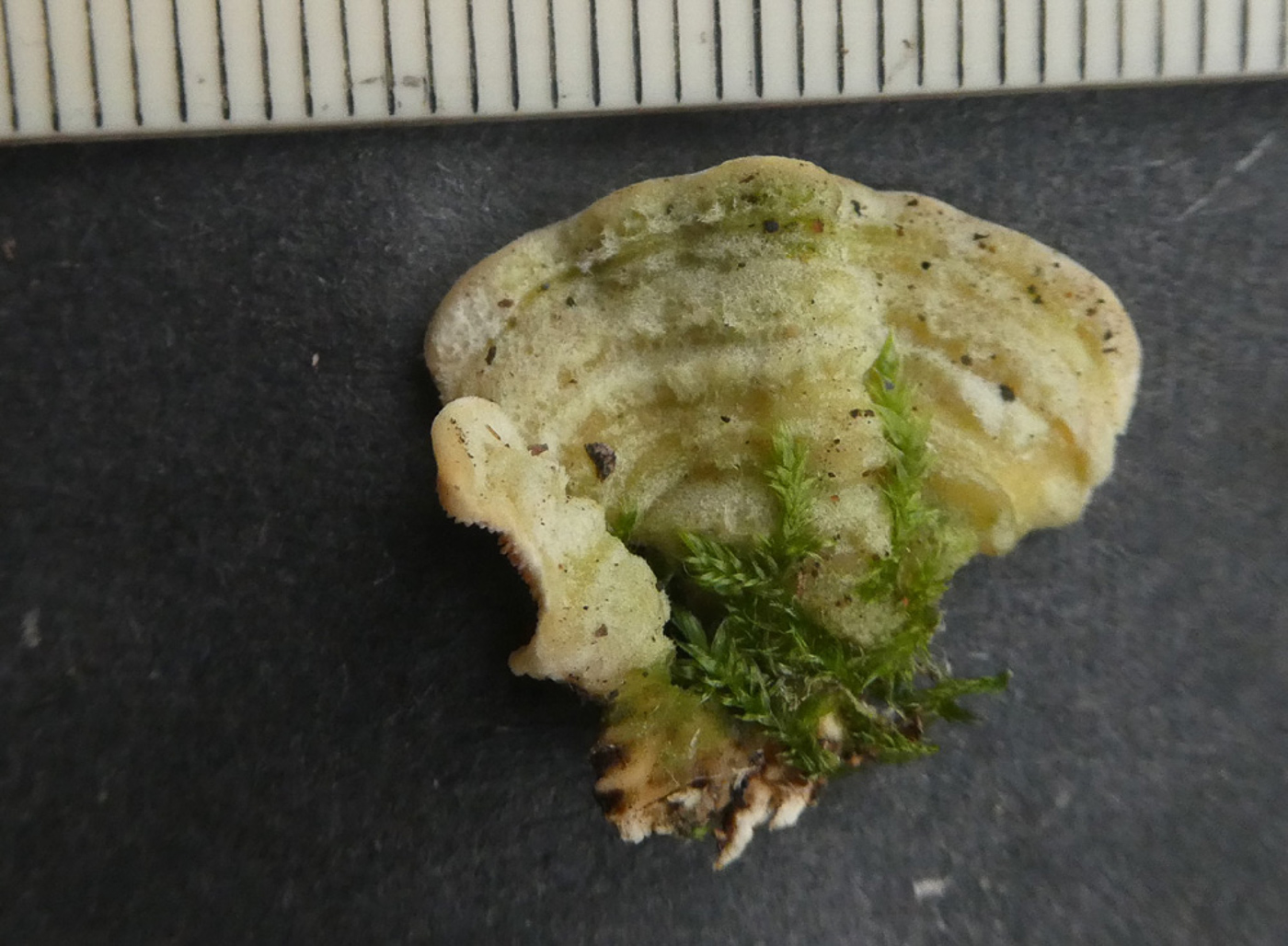 |
Steccherinum ochraceum (Ochre Spreading Tooth) Jan 10, 2022. In a wood near Chalfont St. Peter Jim Wills noticed this line of small brackets on a fallen branch, possibly Oak. Turning one over he noticed the unusual 'peg-like' orange underside so took it home to try and work out what it could be, coming up correctly with this name as a possibility. After comparing his photos with various images and descriptions online and elsewhere, Penny is happy to confirm his identification though at first she was unsure. Described mainly as a fully resupinate species (the form with which she was familiar), it can apparently also form small brackets as here, which are zoned and often green with moss / algi, also as here. This is an occasional species for which we have about a dozen records. |
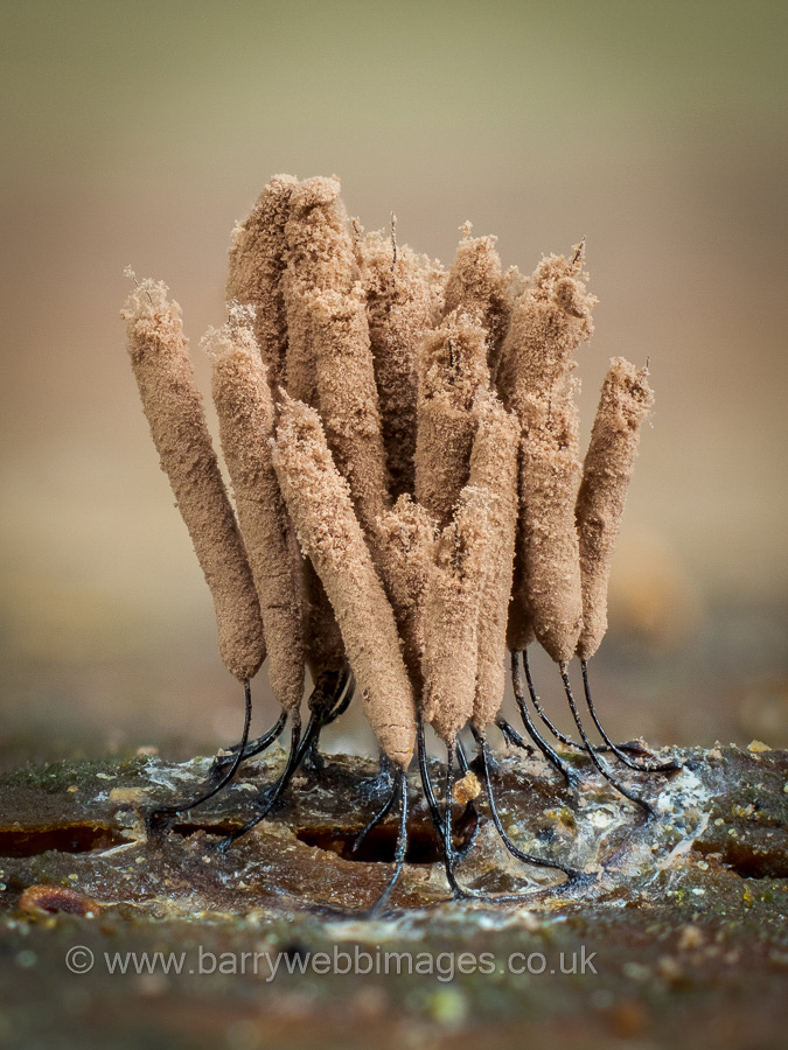 |
Stemonitis axifera (a Slime Mould with no common name) Jul 28, 2021. In Burnham Beeches on damp rotting deciduous wood Barry Webb found this small cluster of tiny 'pipe-cleaners', the sporangia being mature enough for Penny to be able to identify at home. The tiny smooth spores were diagnostic and though the species is not considered rare, this was new to the site with only one previous county record. |
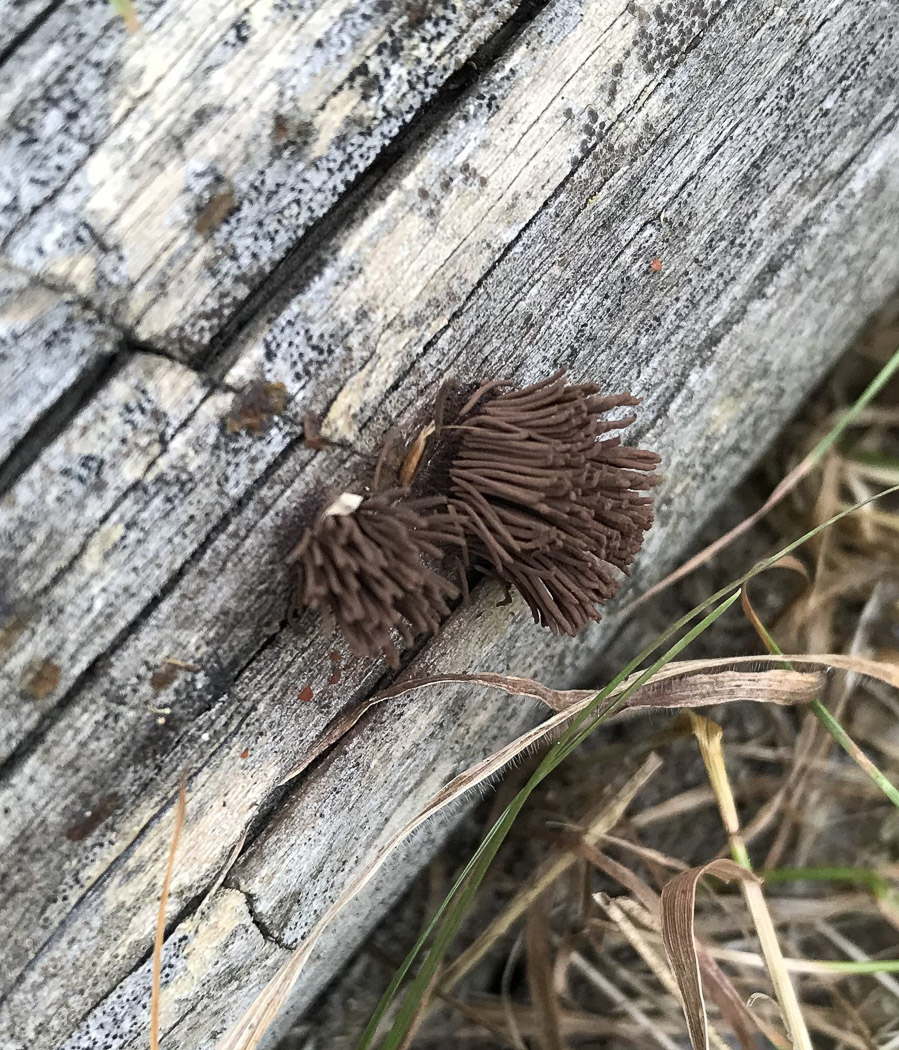
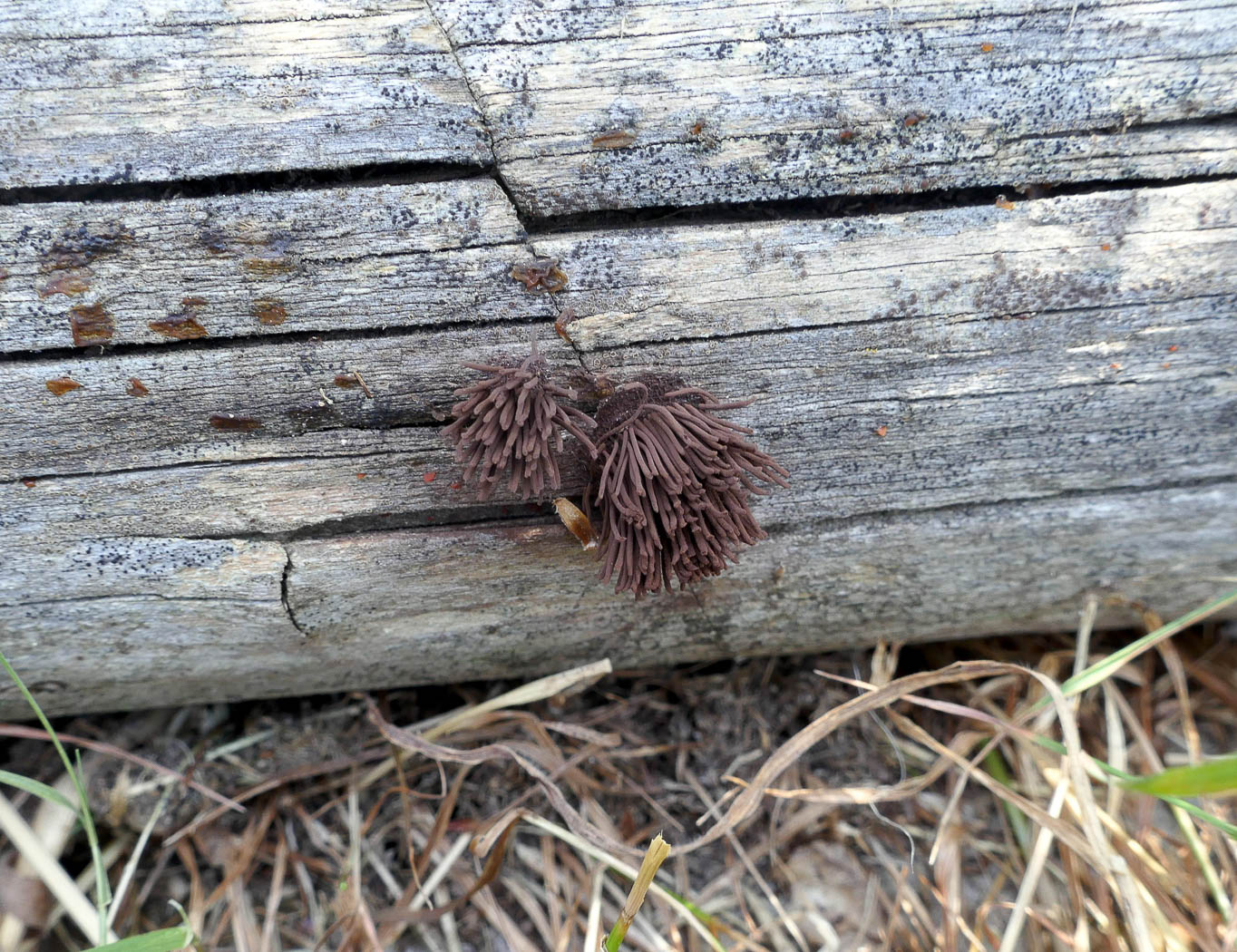
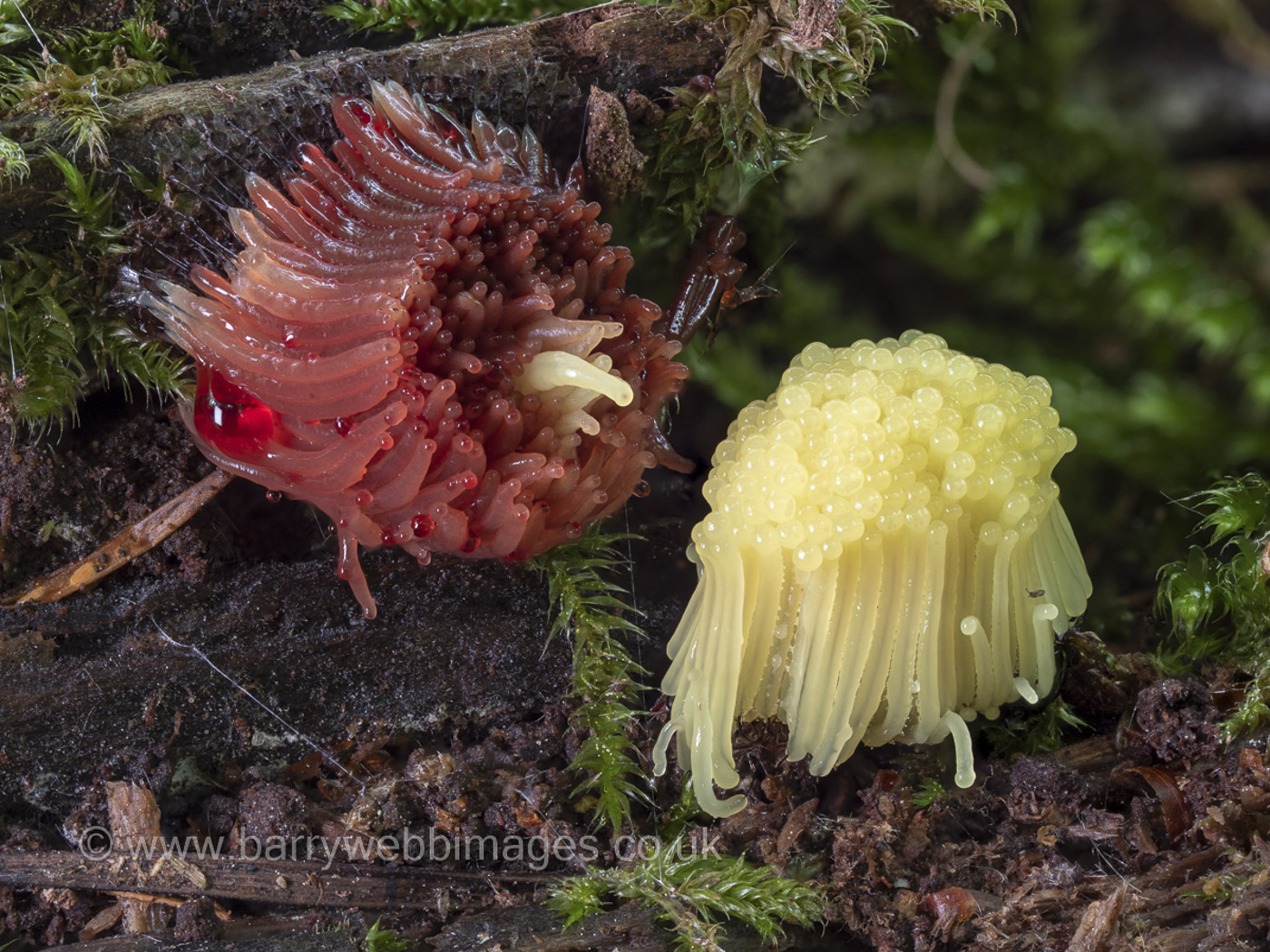
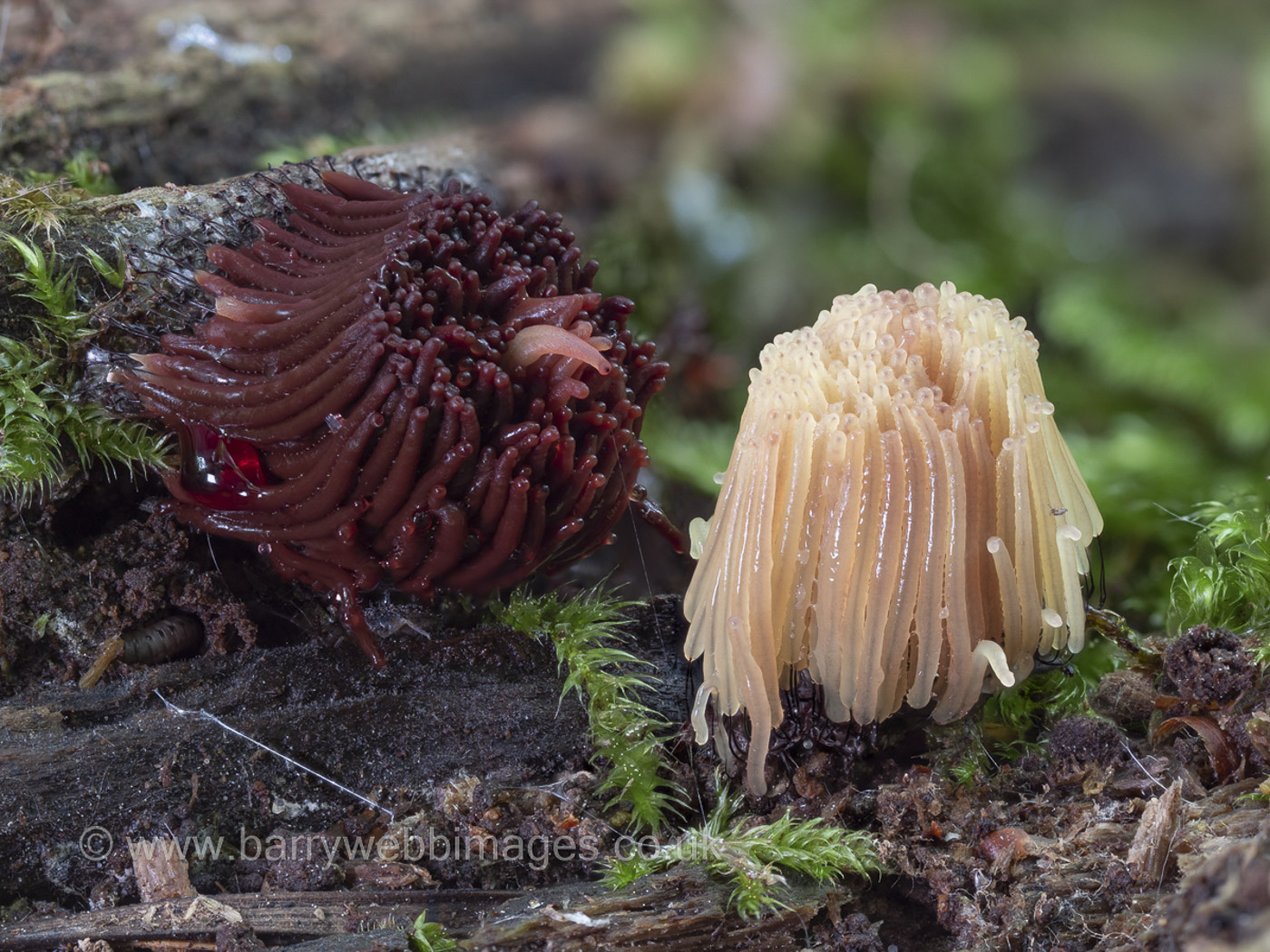
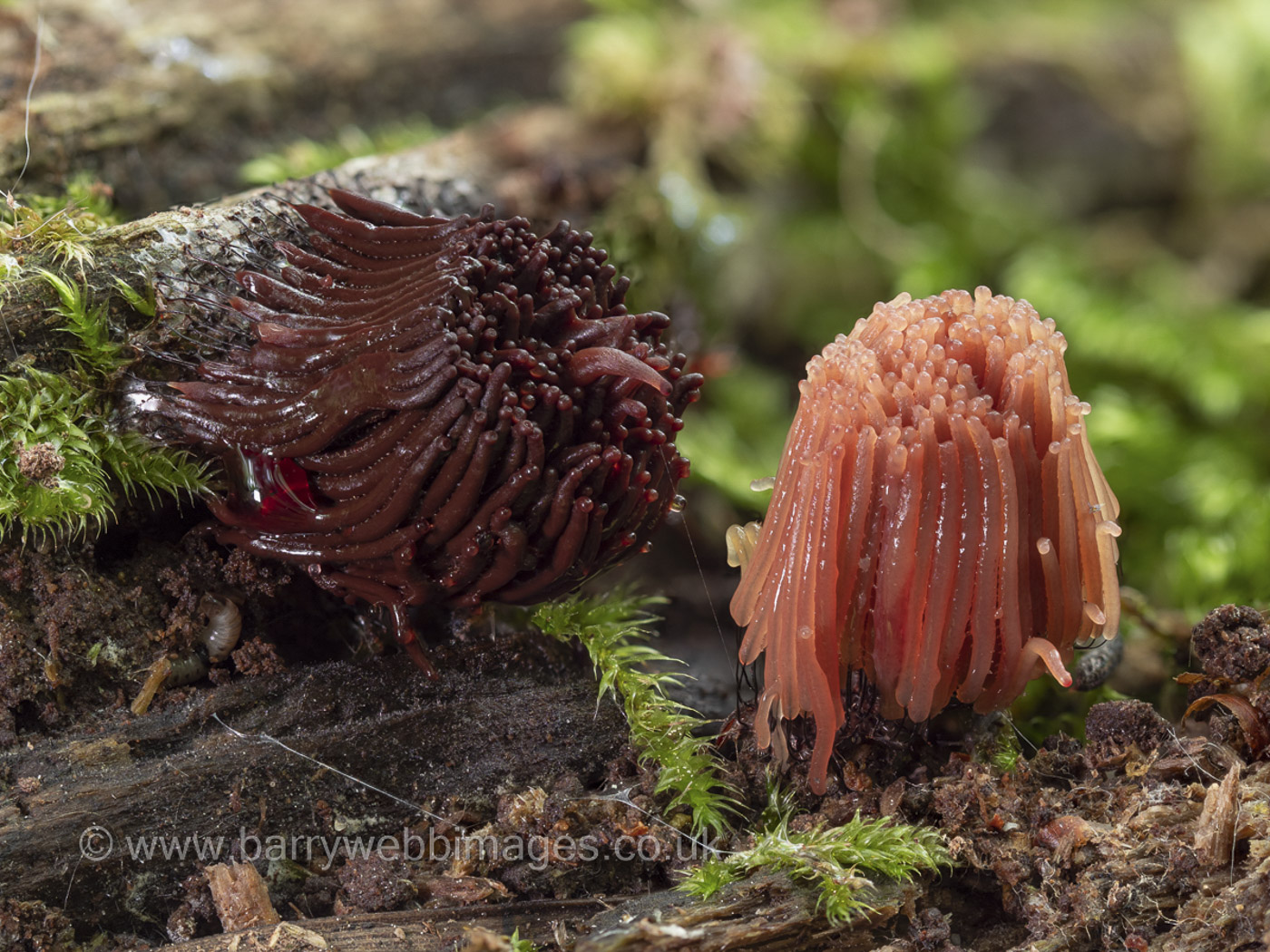
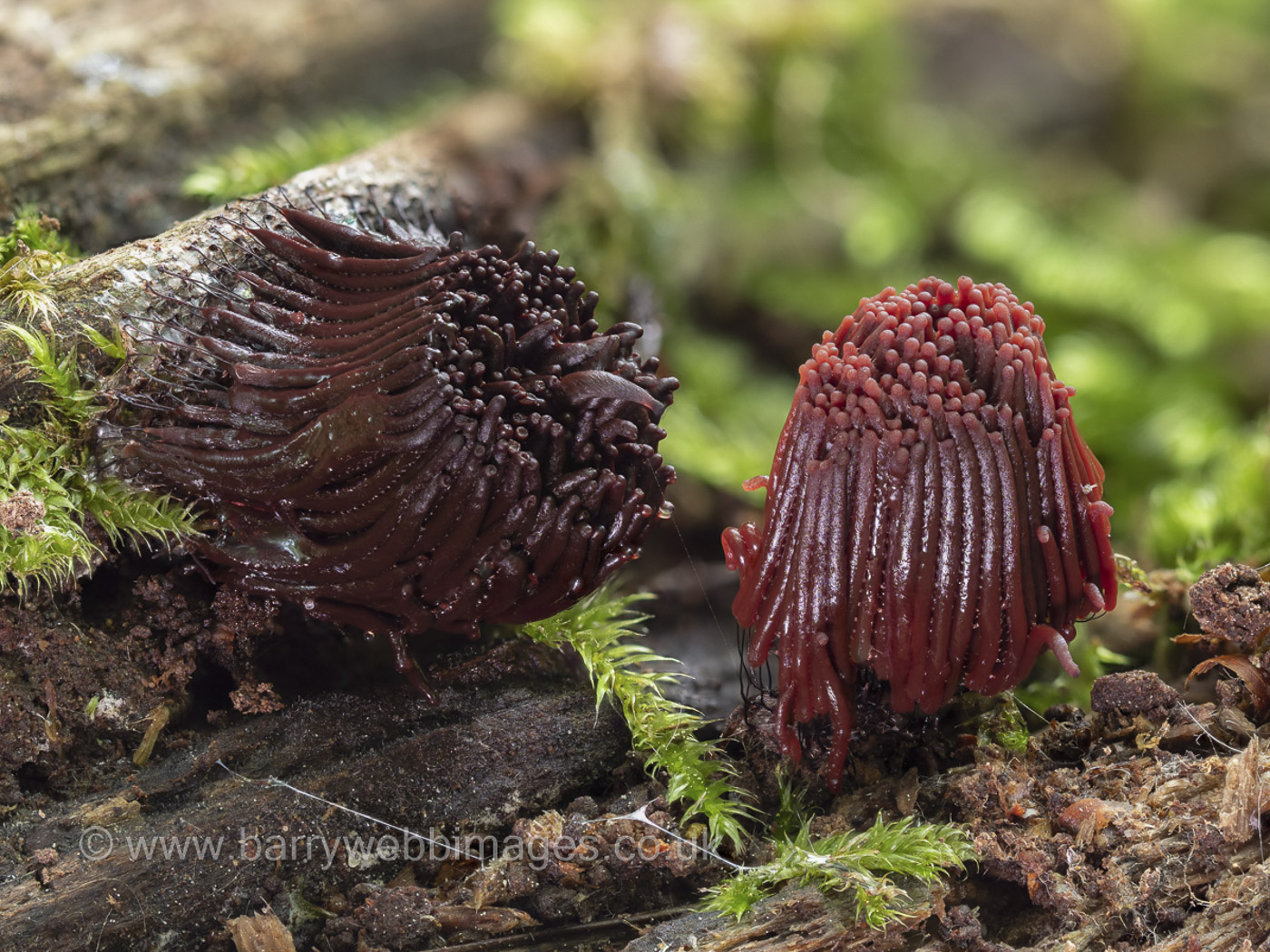
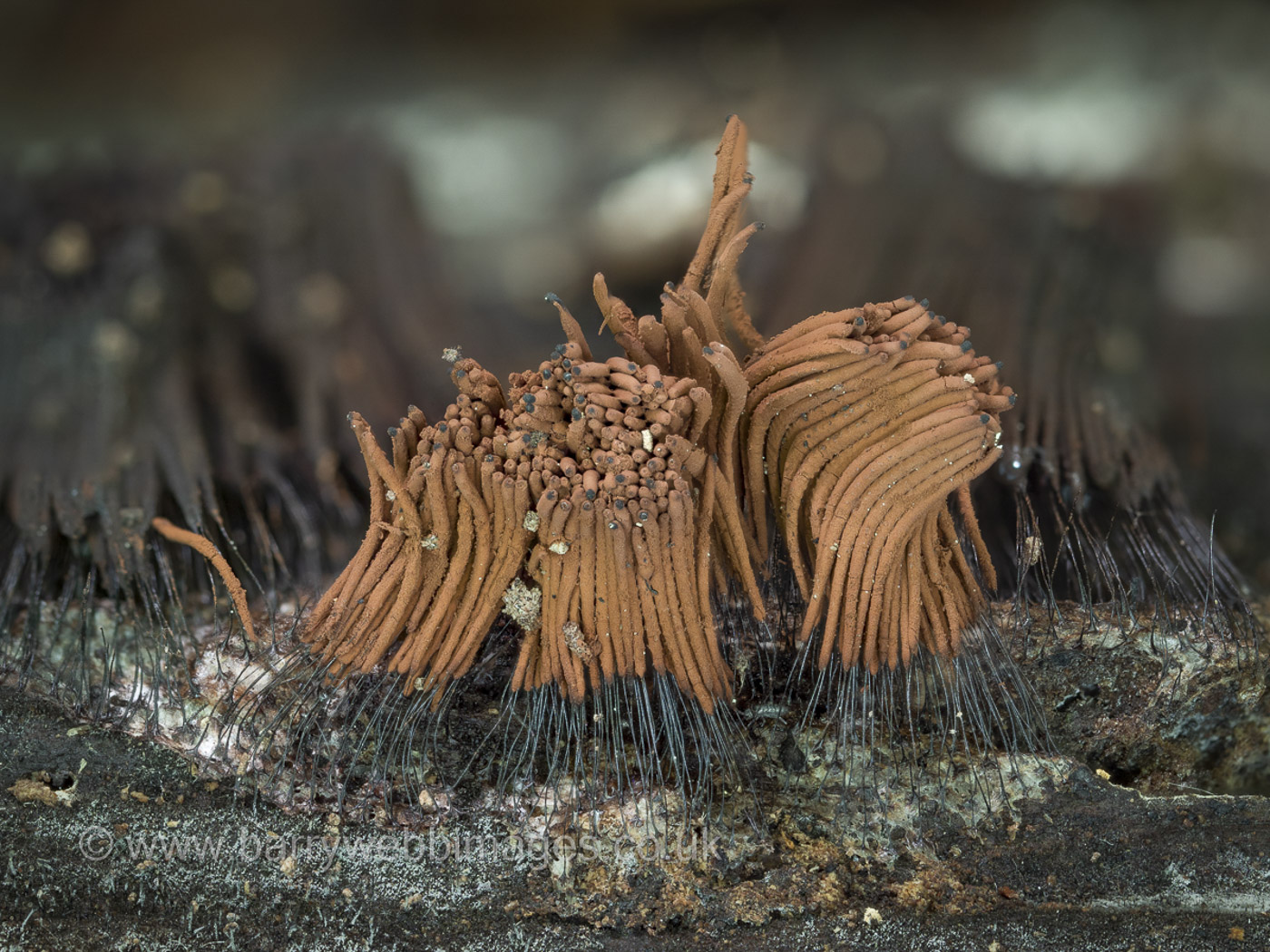 |
Stemonitis flavogenita (a slime mould with no common name) Jul 16, 2022. On an old Oak fence post in a veg patch at Stampwell Farm Jackie Ewan's daughter noticed this tiny tuft of brown clustered stems. She took the photo to show to Jackie who, two days later found the tuft still there, noted the very short stalks in relation to their total height (10mm) and checked the spore size which were suitably small, thus confirming the species. This is not as common as S. fusca which is darker brown, has a stalk about half the total height (up to 20mm) and larger spores. Jun 6, 2021. Barry Webb found a rotting fallen Birch trunk in Burnham Beeches with this Stemonitis species (at this stage unidentified) just starting to develop from the plasmodium (slimy) stage when the transformation in colour, shape and texture can be quite dramatic. He took this amazing set of photos over the space of several hours apart from the final one - taken when a group of us visited the site 4 days later when Penny took a now fully mature specimen to identify to species with a scope (only possible at this stage). S. flavogenita is alone in the genus in having bright yellow plasmodium rather than the normal white (as its Latin species name implies), but if not seen at this initial stage (just a slimy fragile shapeless mound) this useful clue is missed as all species tend to go through the same colour changes once the stalks and pipe-cleaner shape have formed: first yellowish then gradually pinkish and eventually some shade of cocoa brown - all in a matter of a few hours once it starts - before drying off completely as in the final photo here. The species is not rare but also not the commonest of the genus which is S. fusca - seen also on June 9th nearby, the photo also on Finds for that date. |
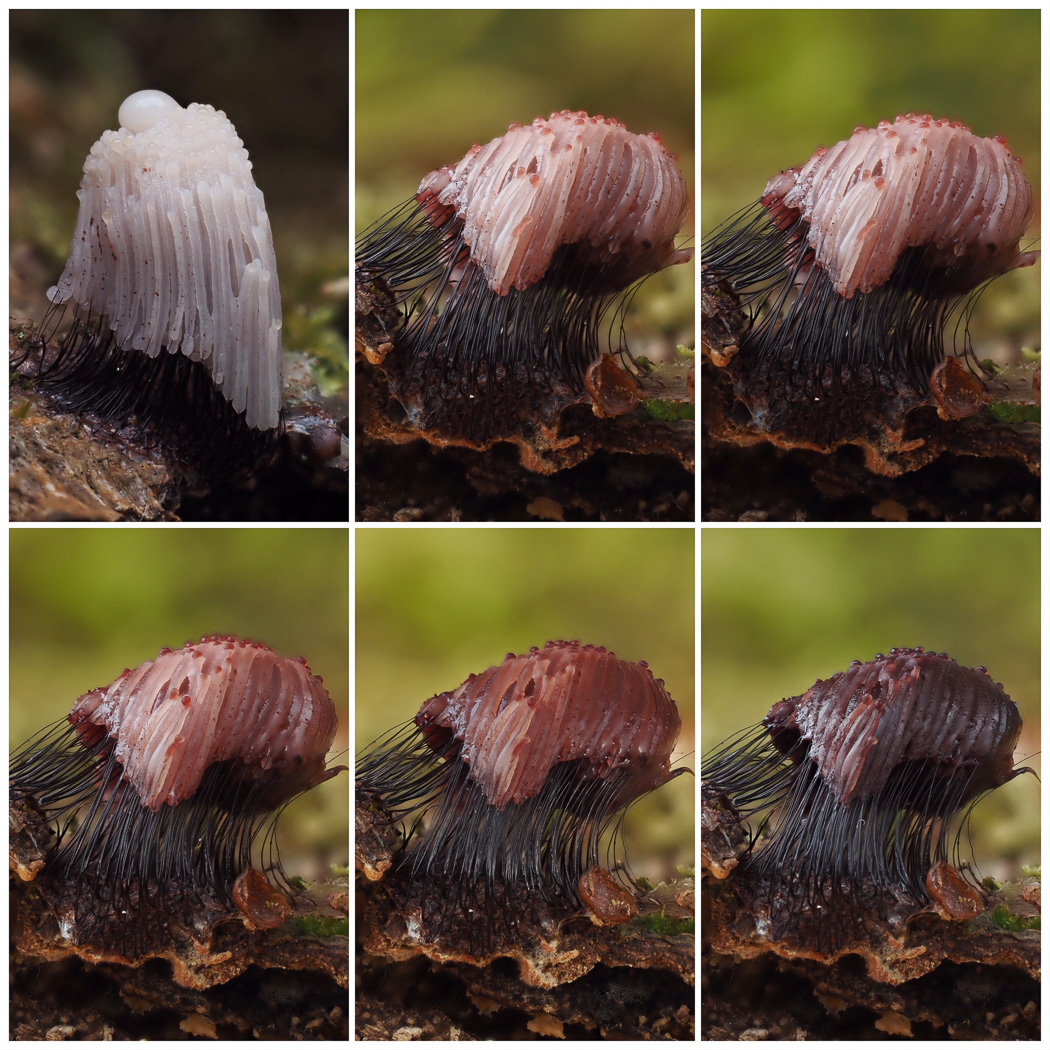
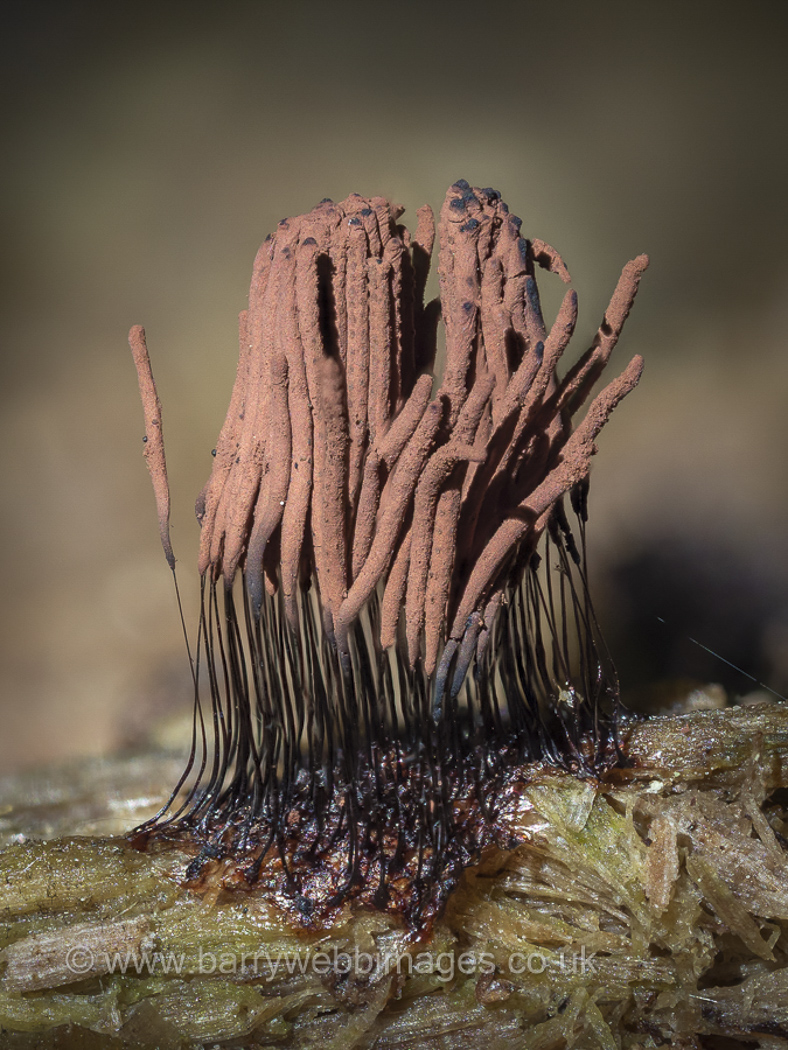 |
Stemonitis fusca (a Slime Mould with no common name) Sep 13, 2021. On a fallen Beech trunk in Naphill Common Claire Williams found several different species of Slime Mould, and took this remarkable series of photos over a period of 4 hours showing just how quickly these organisms can develop once they settle down. Penny has named the species purely from the long stalks shown here which are up to half its total height (whereas other species in the genus have stalks of a lesser proportion) so the determination has not been confirmed microscopically. Jun 9, 2021. On a rotting bare Birch trunk in Burnham Beeches Gill Ferguson found these little clusters of chocolate pipe-cleaners. Although nearby was a trunk with Stemonitis flavogenita, it could not be assumed that this collection was the same species, so Penny collected samples of both to examine at home. This second collection turned out to be the commonest species within the genus, characterised not just by microscopic differences but also by having a notably shiny black stalk forming up to half the total height (in S. flavogenita the stalk is only up to one third). (Photo Barry Webb) |
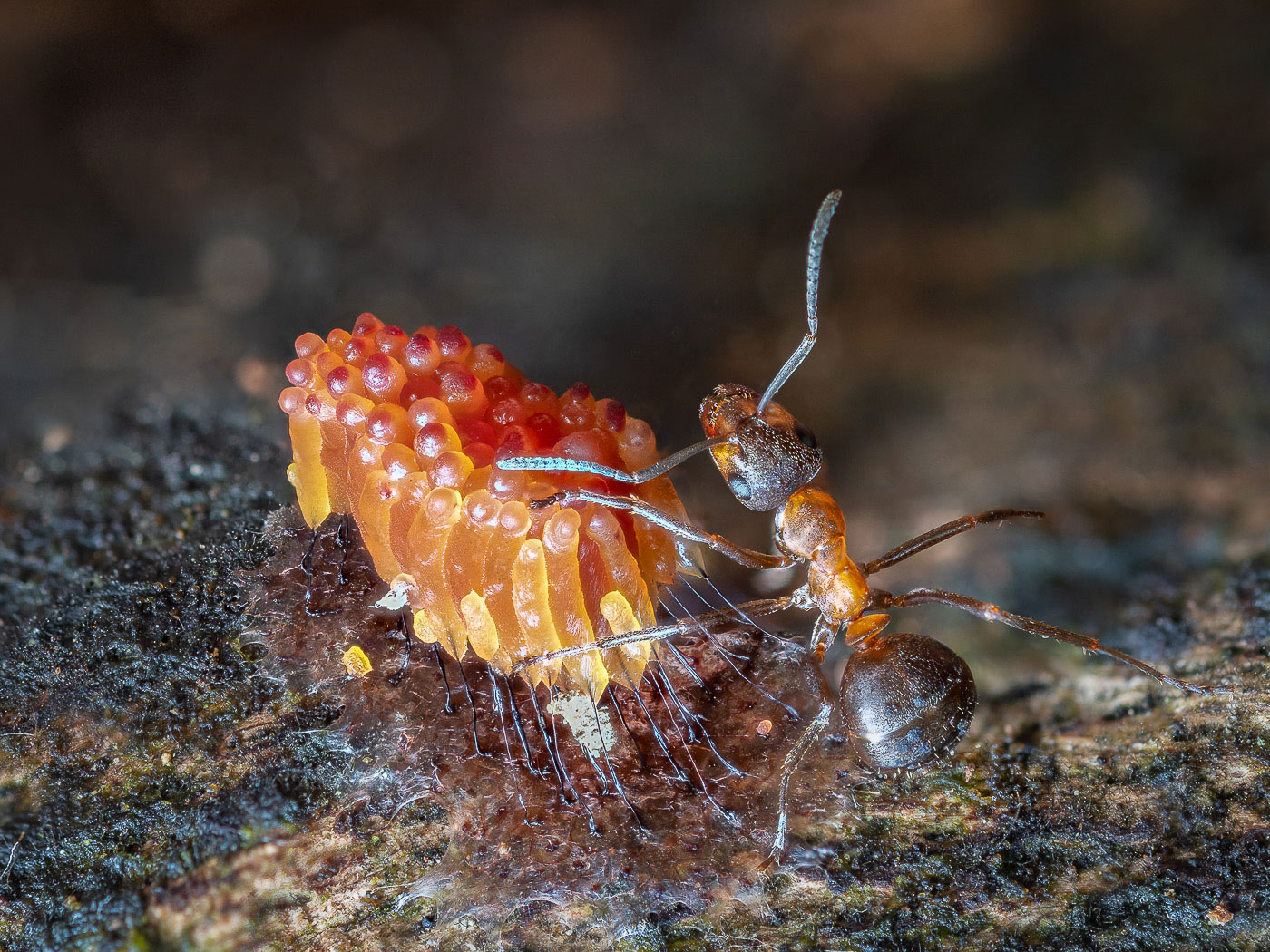 |
Stemonitis sp. (a species of Slime Mould) Sep 28, 2020. Gill Ferguson took this delightful photo in Burnham Beeches where Wood Ants abound. This one was clearly about to devour the Stemonitis which is at a transitional stage between the slimy Plasmodium stage and the mature dry brown fluffy stage. It is only at this later stage that the genus can be identified to species, but at least one can clearly recognise the genus by the general shape with the long thin dark stalks and suasage-like tops. |

 |
Stemonitis virginiensis Stemonitis virginiensis Jul 15, 2023. In Burnham Beeches on fallen moss covered Beech Barry Webb found this still immature Stemonitis (at this stage not identifiable) and returned later to take photo 2 when it had matured. Features to note in this rare species are its short and shiny black stalks and brown colour with a lilac tint compared to others in the genus when mature. It also has rather smaller spores which have a clear reticulation as well as some spines, This is new to the site and to the county. |
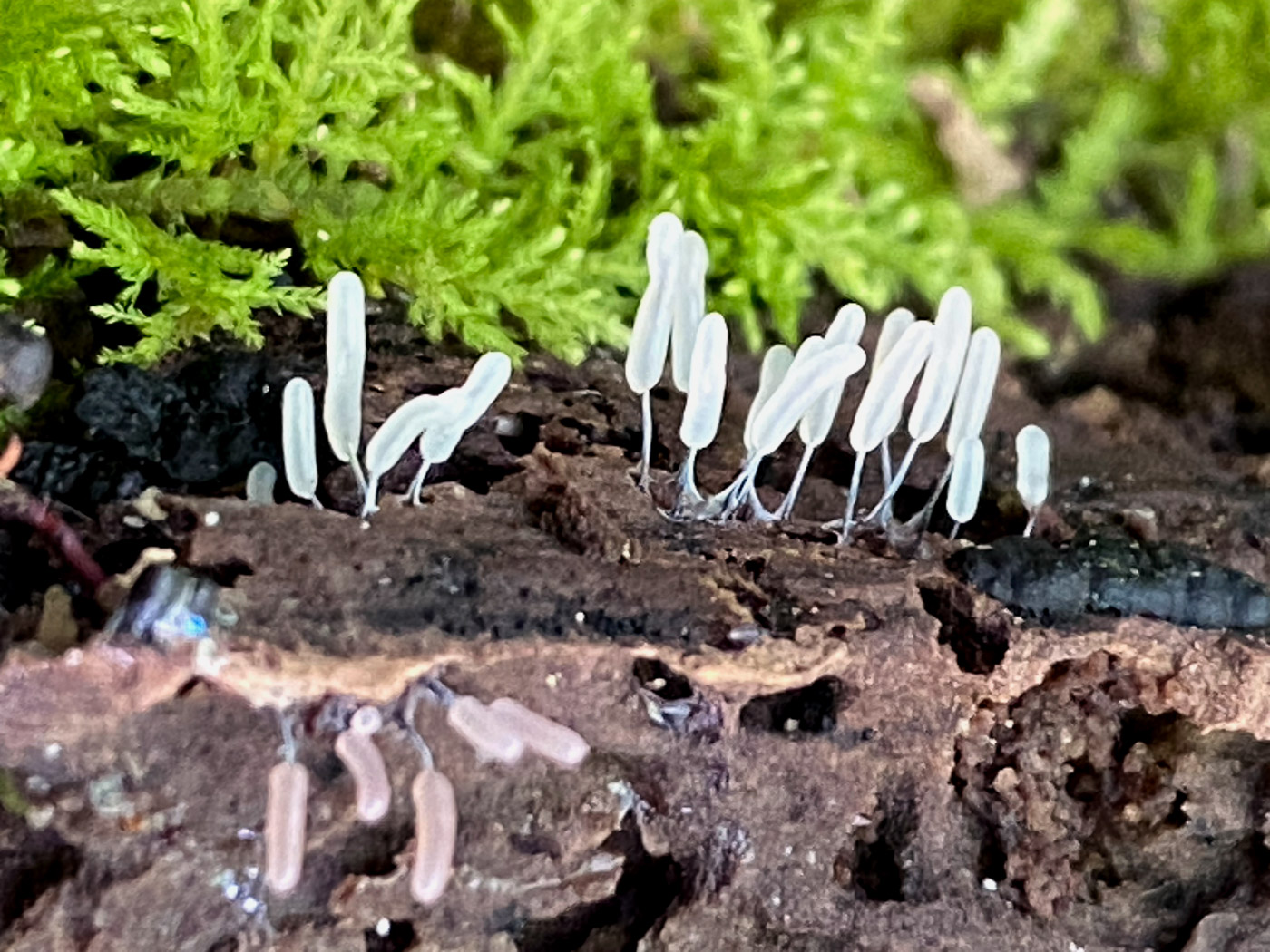 


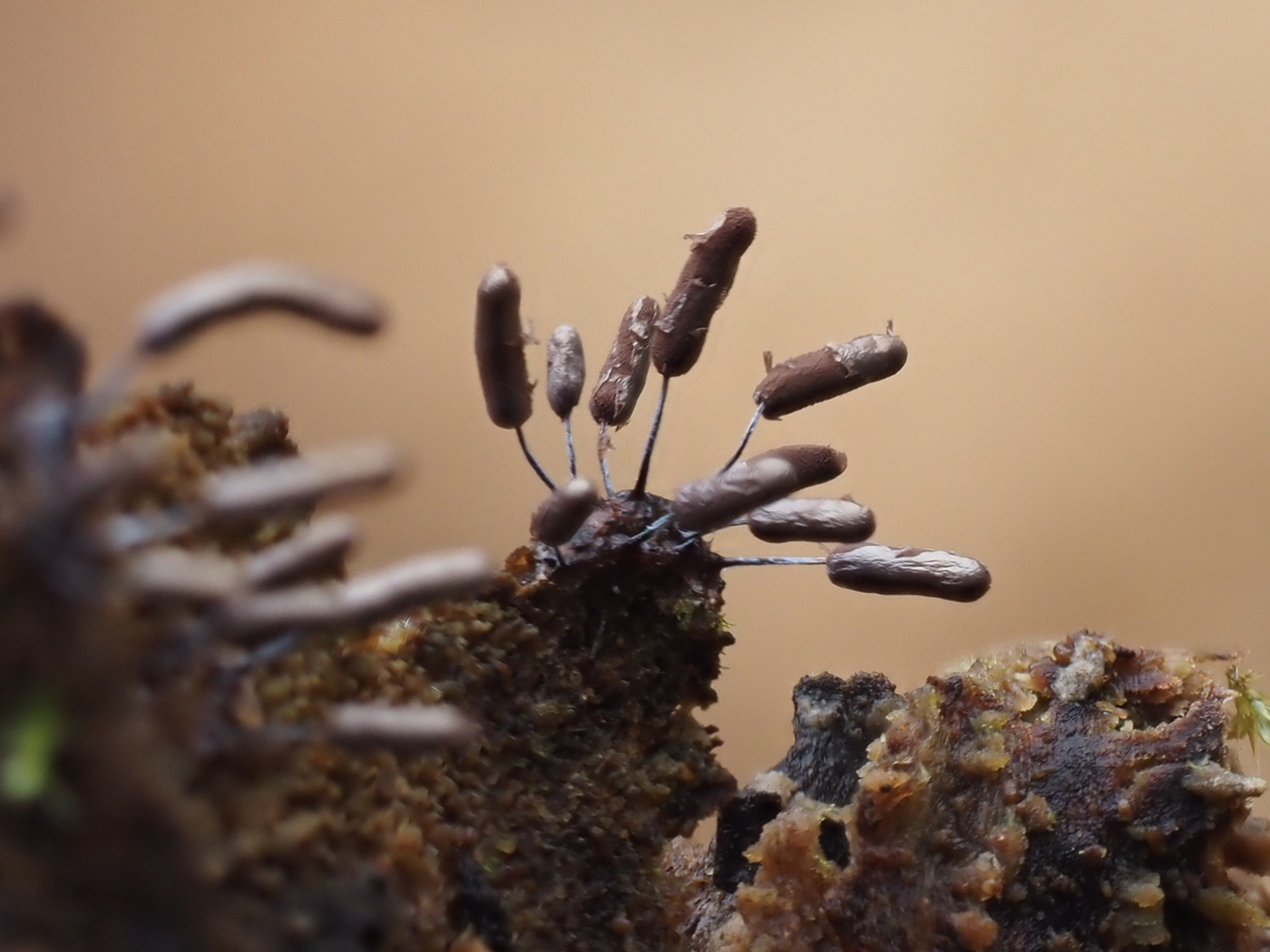
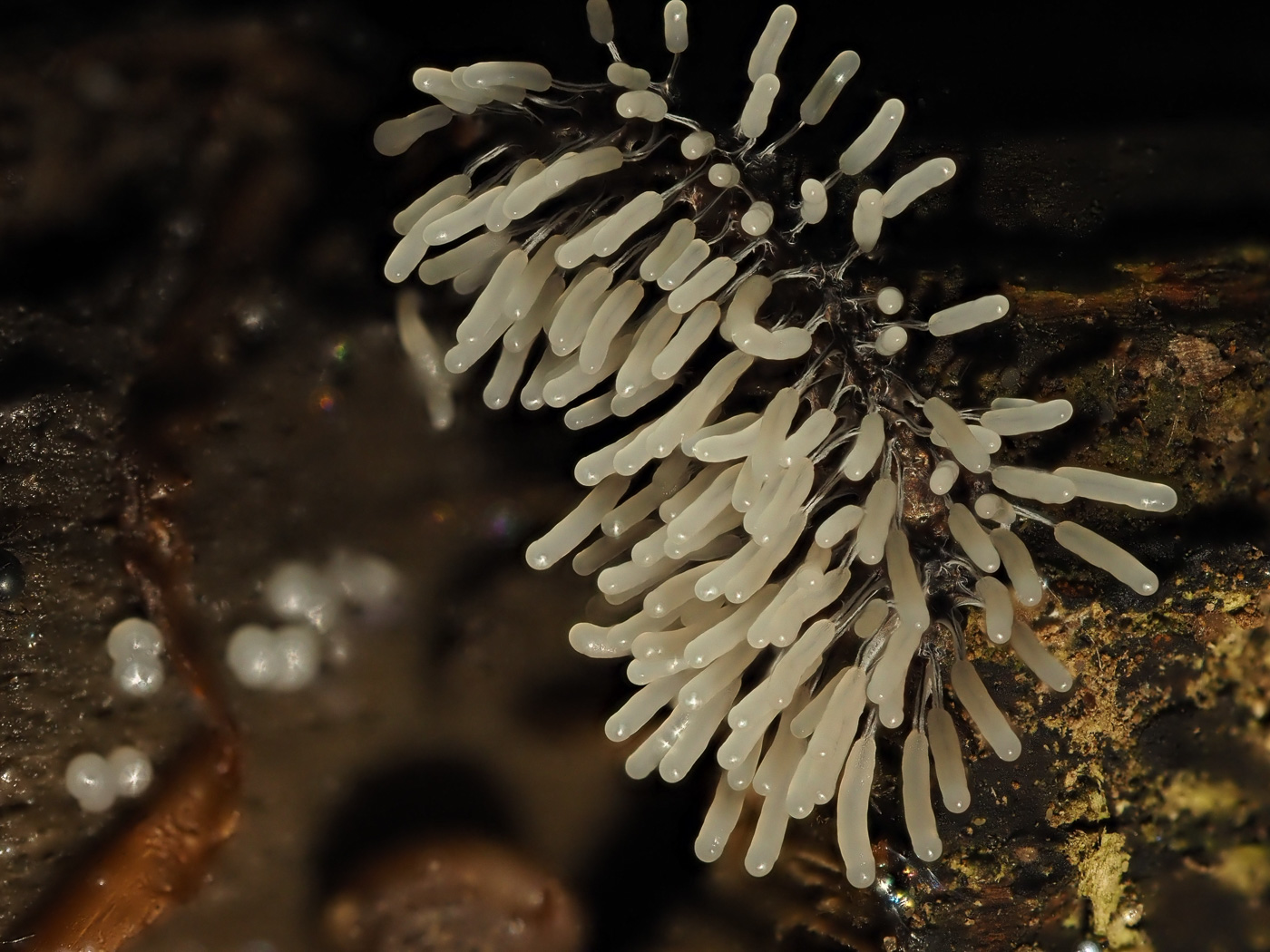
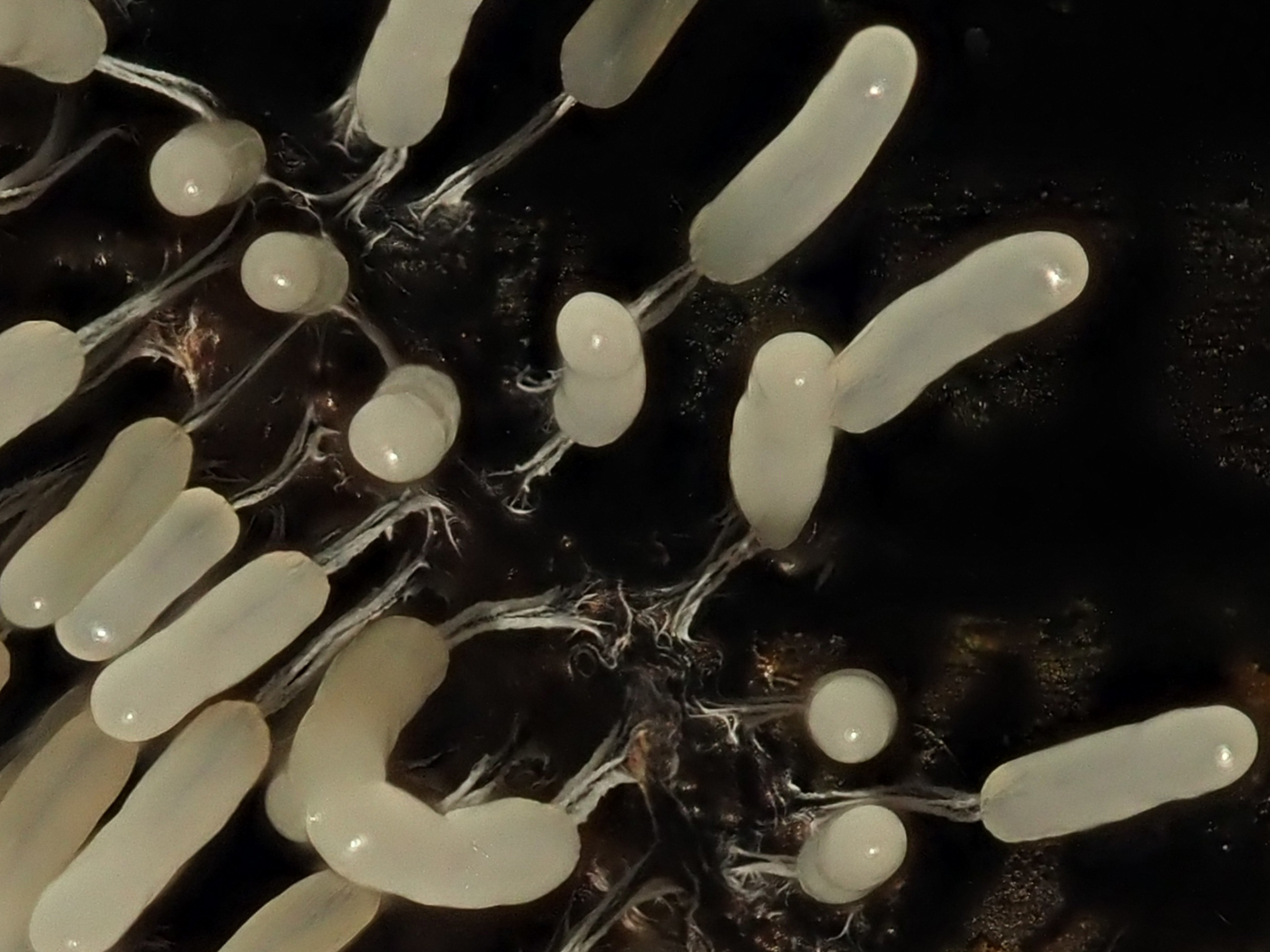
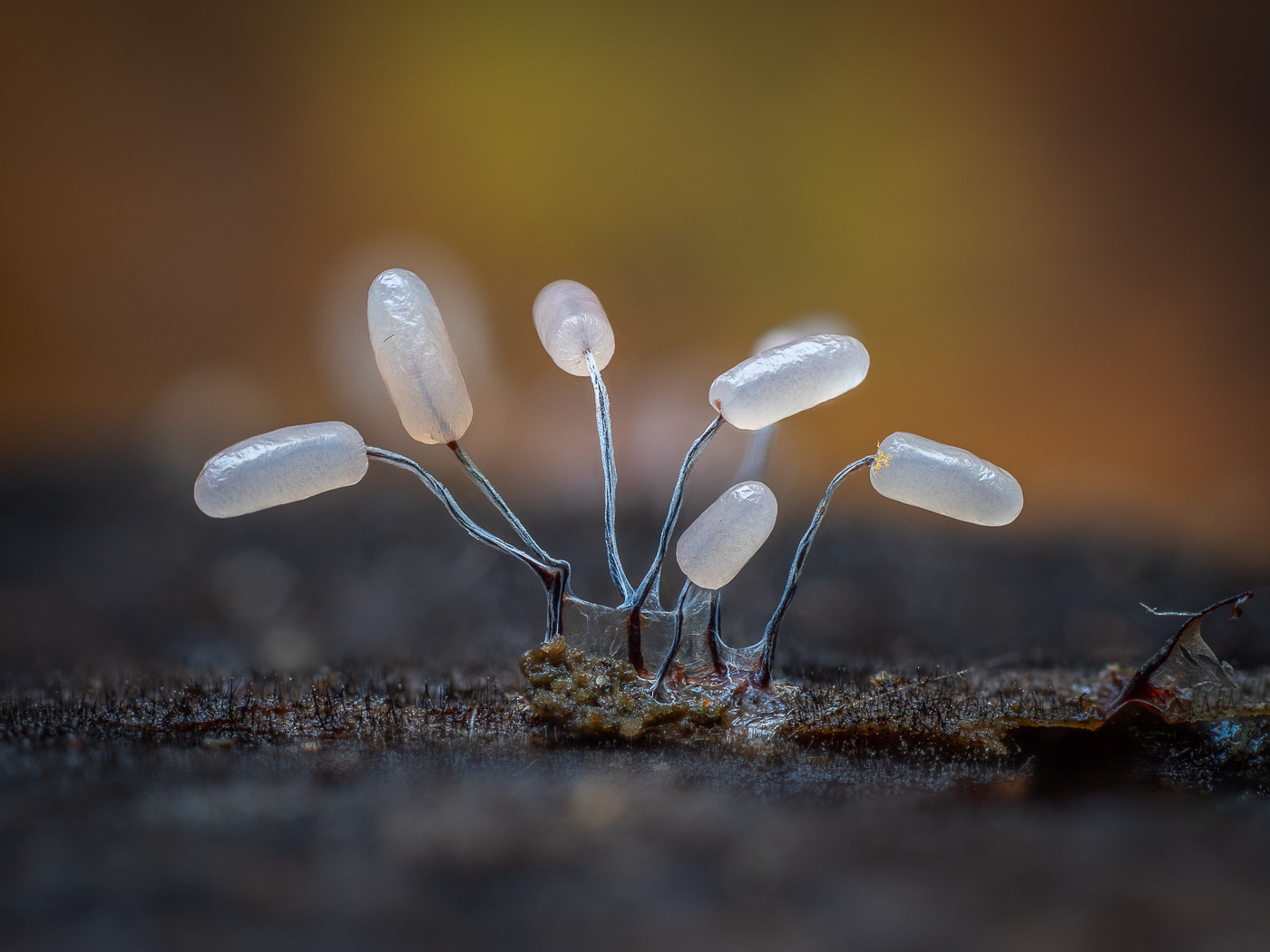
|
Stemonitopsis typhina (a Slime Mould with no common name) Jun 16, 2024. In Bernwood Forest Chris Grimbly found this tiny patch of mini loofahs on rotten wood. Each stalk and head is up to 5mm tall at most, the species recognisable at this immature stage by the shiny coating on the stalk (see other images for more detailed view of this feature). This collection will soon have turned first pink then rusty orange and finally black - the colour of the spores at maturity. The species is quite common but easily overlooked for obvious reasons. Jul 10, 2023. In Gussett's Wood on a bare and very rotten Beech trunk Penny spotted these little beauties which at this stage were pink but already recognisable as this species, having developed their stalks with a shiny coating reminiscent of the seam on old fashioned silk stockings. Each individual was no more than 3 mm high. Knowing they would mature quickly if undisturbed, she carefully extracted the specimens en mass on the rotten wood without touching them, got them home undamaged and left them outside overnight on damp kitchen paper in a covered pot. Photo 2 shows the now maturing shiny black sausages on their stockinged stalks the following morning. Photo 3 shows the same collection a few days later when almost fully mature, taken by Barry Webb. See the Masterlist for more images. Sep 13, 2021. On the same fallen Beech trunk in Naphill Common as her series of Stemonitis photos above, Claire Williams also found these almost mature little specimens belonging to a related genus. The species can be recognised at this stage by its sausage-like shape and typically by the flaking surface as it dries off. The stalk when younger is wrapped in an almost translucent white sheath which here has all but disappeared. (See Barry Webb's page in Finds for a younger example.) Jun 30, 2021. On rotting wood in Downley Woods Claire Williams found this collection of tiny pale shiny tubes on short stalks and, realising it was a slime mould, she posted it onto the Slime Mould Facebook page where it was named for her. Her photo shows it still immature and white like its plasmodium and with a distinctive layer of pale slime covering the black stem (often described as like old fashioned silk stockings with a seam running down them (photo 2) - unique to the species). Later the tubes turn pink then brown and dry off becoming powdery and very similar to the related genus Stemonitis. See further images online and also in Barry Webb's page in Members' Finds. Oct 19, 2020. Barry Webb took this beautiful photo of a very common slime mould found on a damp Beech branch in Burnham Beeches. Each sporocarp (fruiting body) is no more than 5 mm high and its shape resembles the similar genus Stemonitis but the species is characterised by these persistently silvery shining cylindrical heads and beneath them a stalk which reminds of silk stockings, the central black core looking like the seam! |
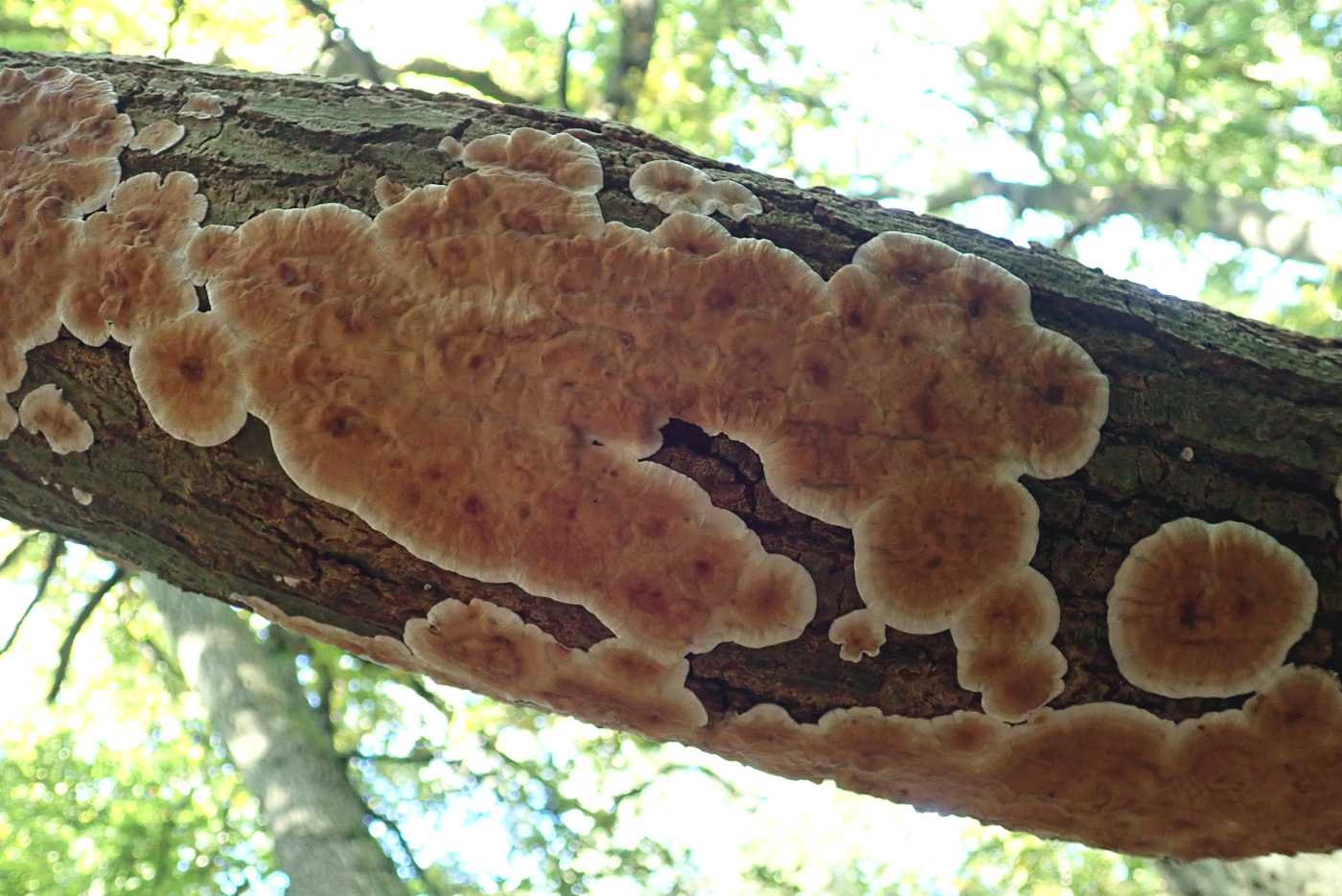
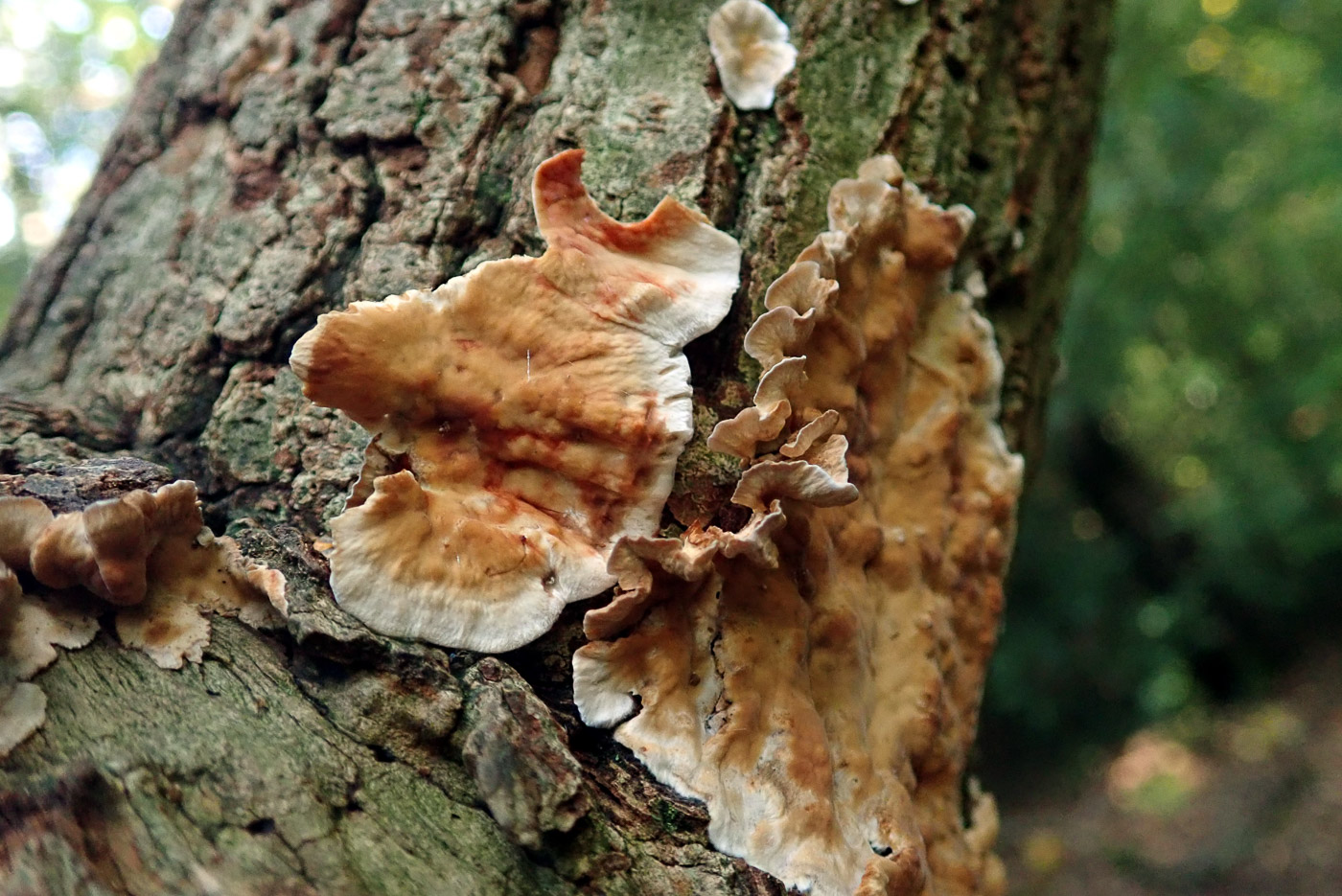
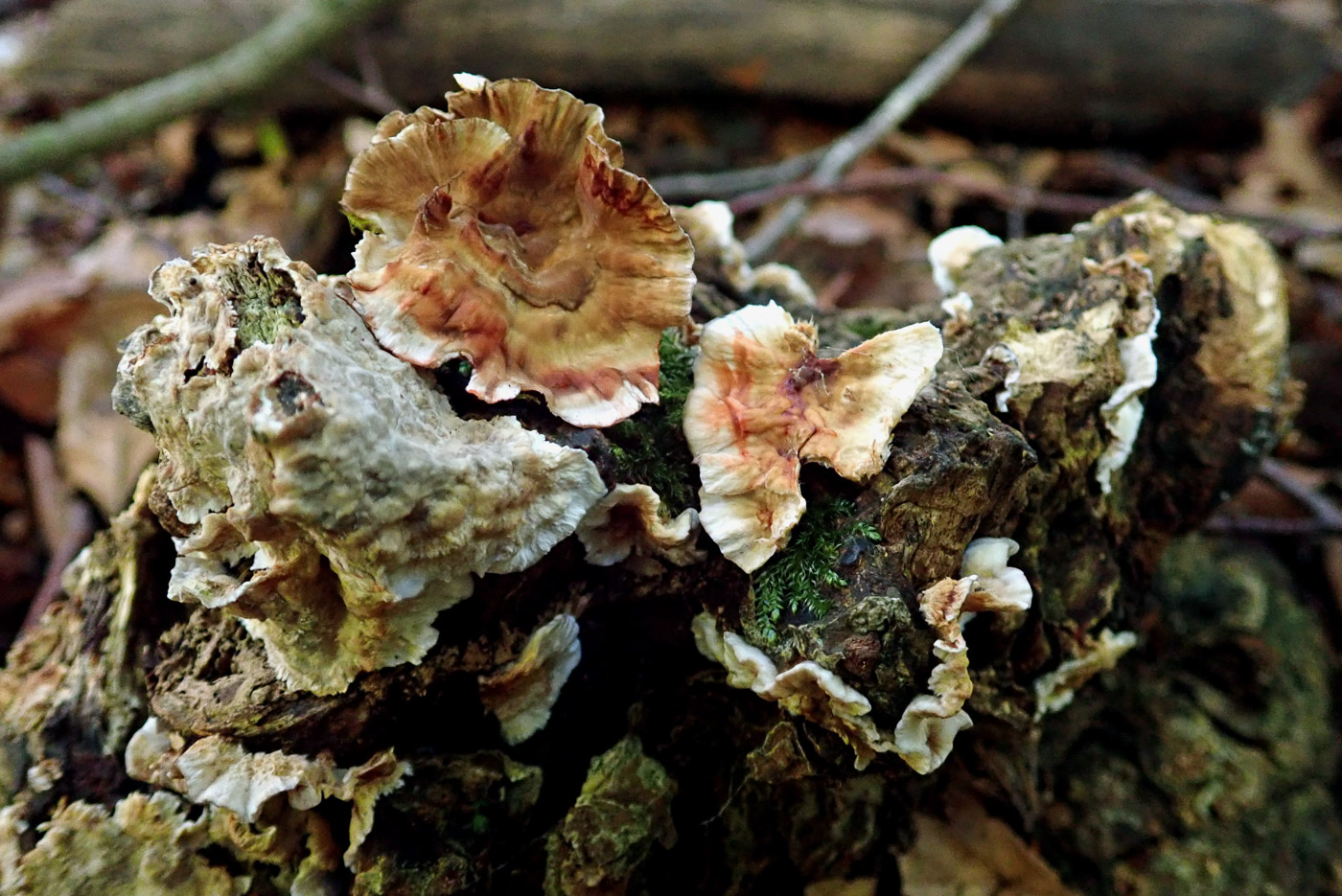 |
Stereum gausapatum (Bleeding Oak Crust) Oct 11, 2020. This fine colony of Stereum was fruiting on standing Oak in Pullingshill Wood, found by Penny Cullington. The white rim and dark ochre bumpy centre is characteristic and it tends to grow resupinate (flat) rather than forming brackets like S. hirsutum. This is the rarest of the three resupinate Stereum species (which all turn red when damaged) and is only found on Oak, so if you find a similar species on conifer it will be S. sanguinolentum and on some other deciduous tree it will be S. rugosum. |
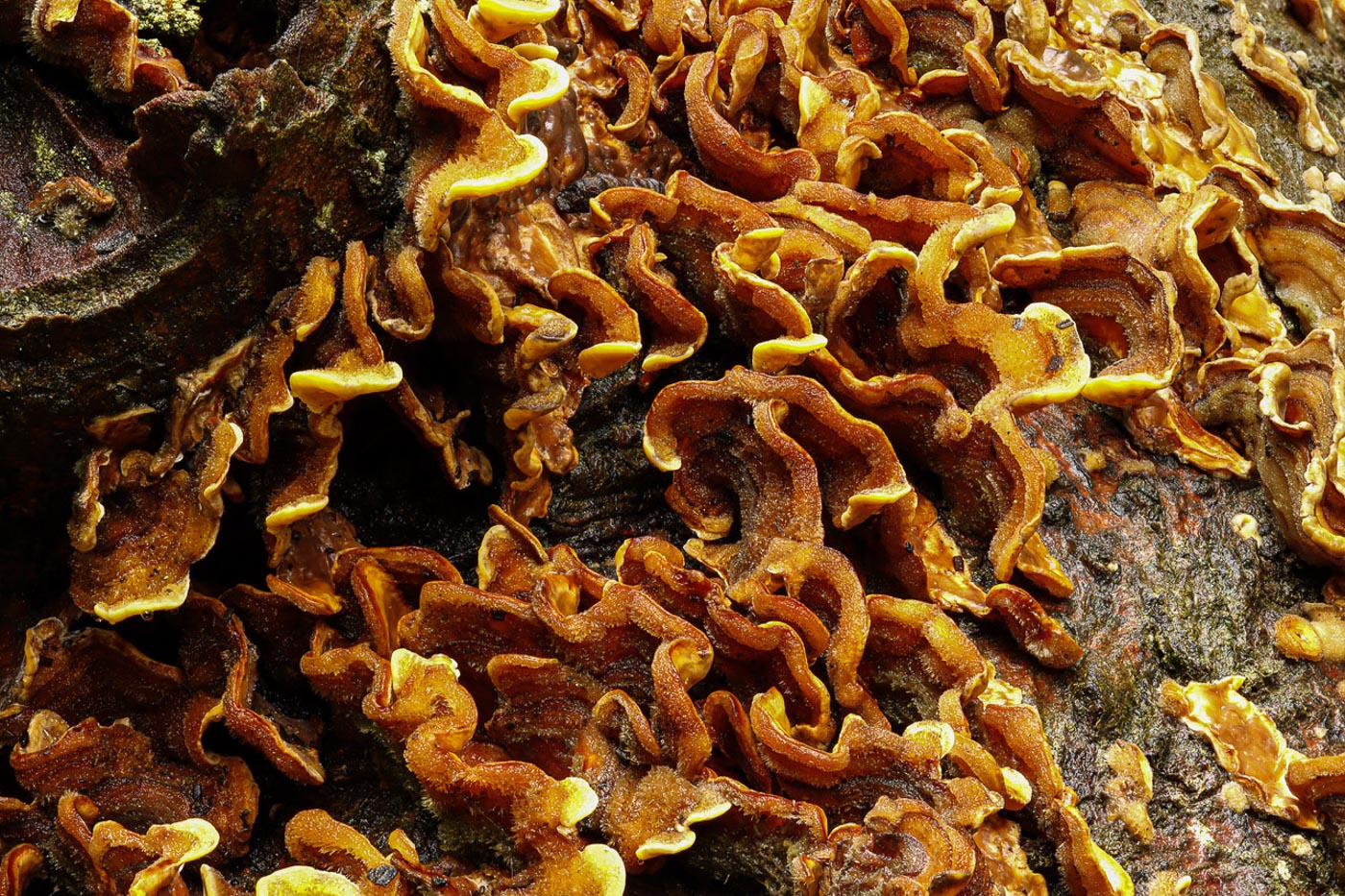 |
Stereum hirsutum (Hairy Curtain Crust) Sep 24, 2020. Paul Goby found this, one of our commonest brackets on fallen deciduous wood, on Beech at Naphill Common. It grows in tightly clustered colonies of little brackets - each one up to 3 cms across, at any time of year given suitable conditions. Note the zoned top surface where when fresh one can see the finely hairy covering (here clearly visible on the top left fruit body). Note also it has an almost smooth under-surface which is more-or-less concolorous with the top - unlike the equally common Trametes versicolor (Turkeytail) with which it is frequently confused and which is cream to white with distinctly visible pores underneath. |
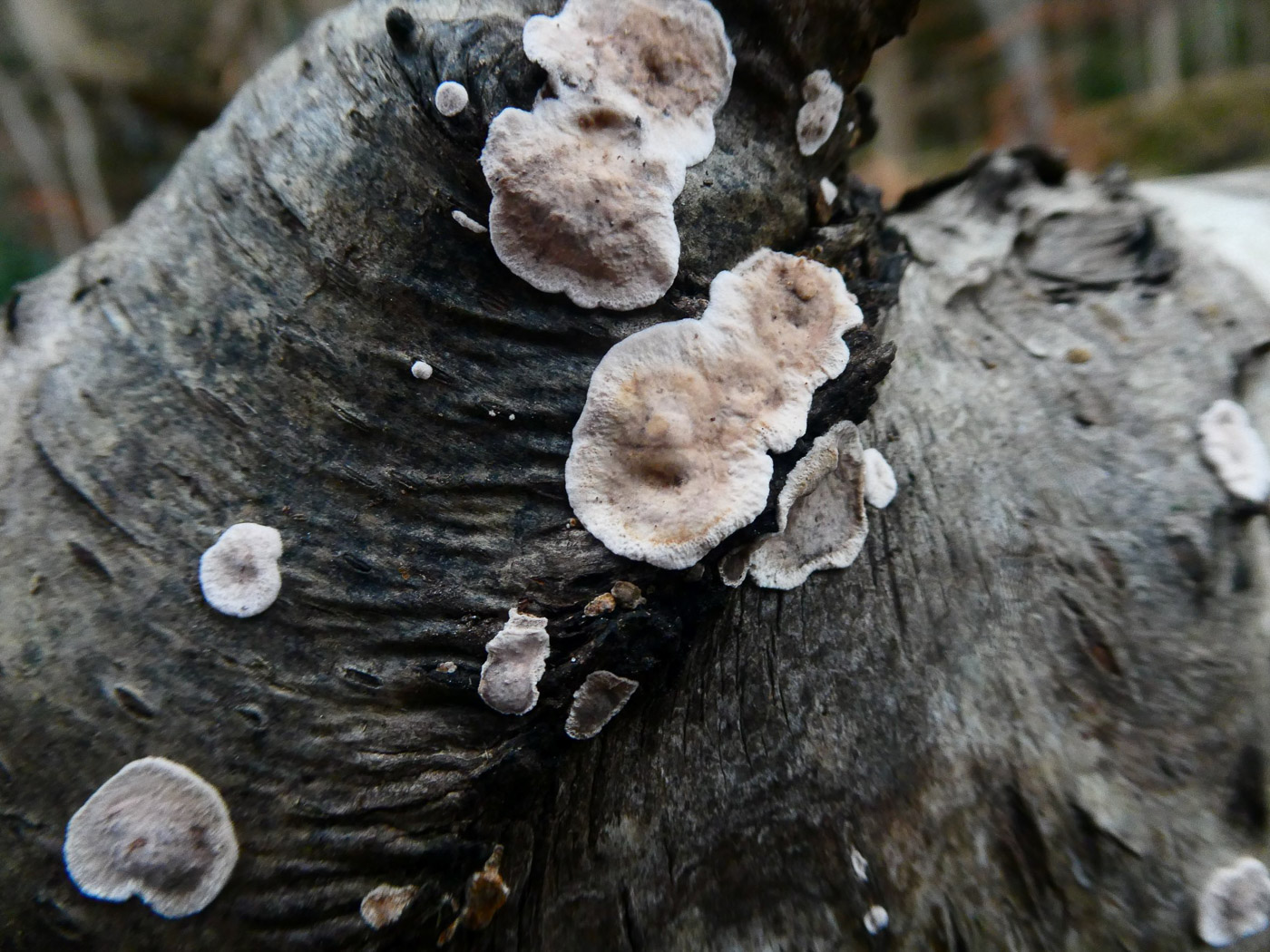
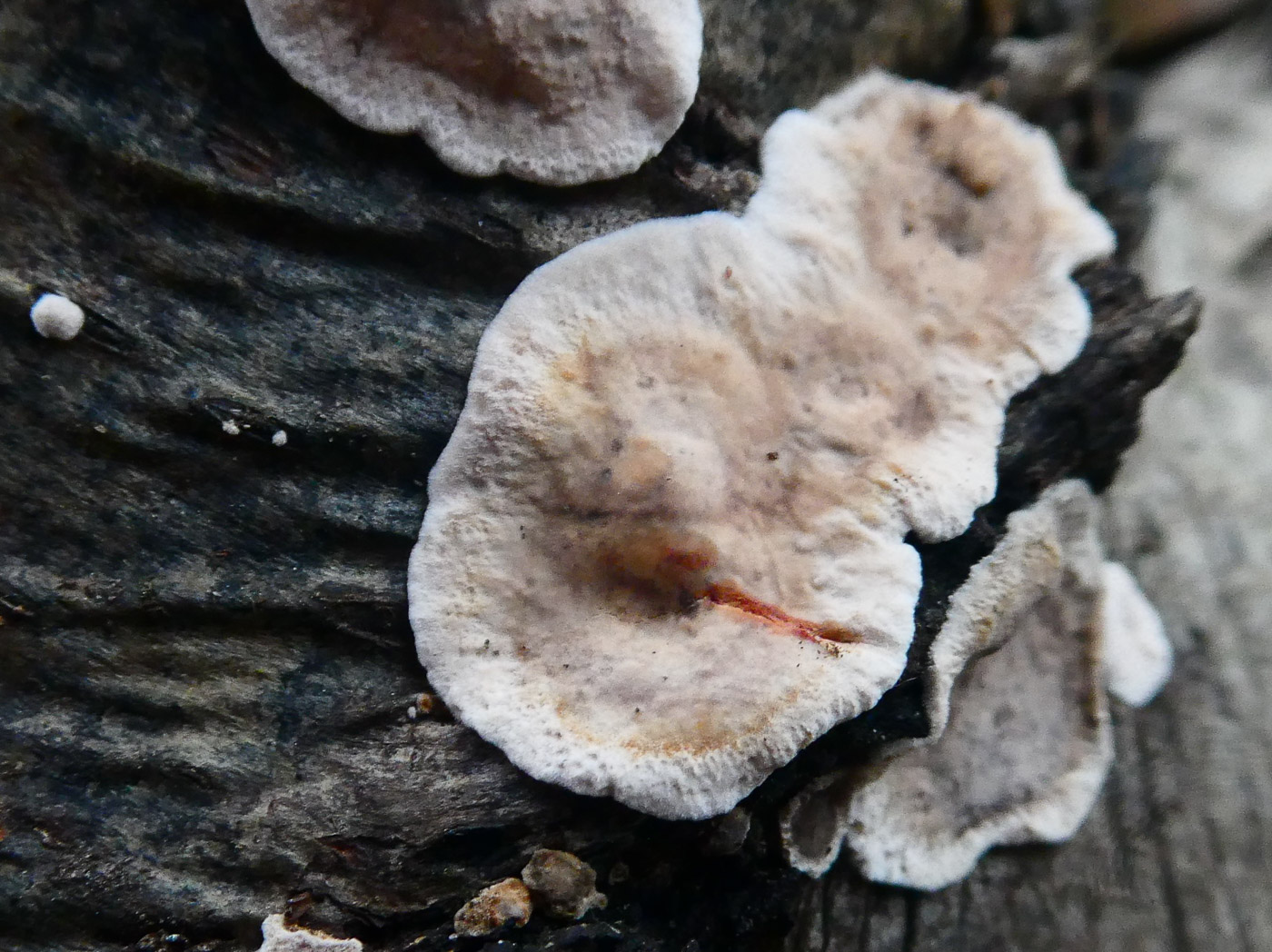
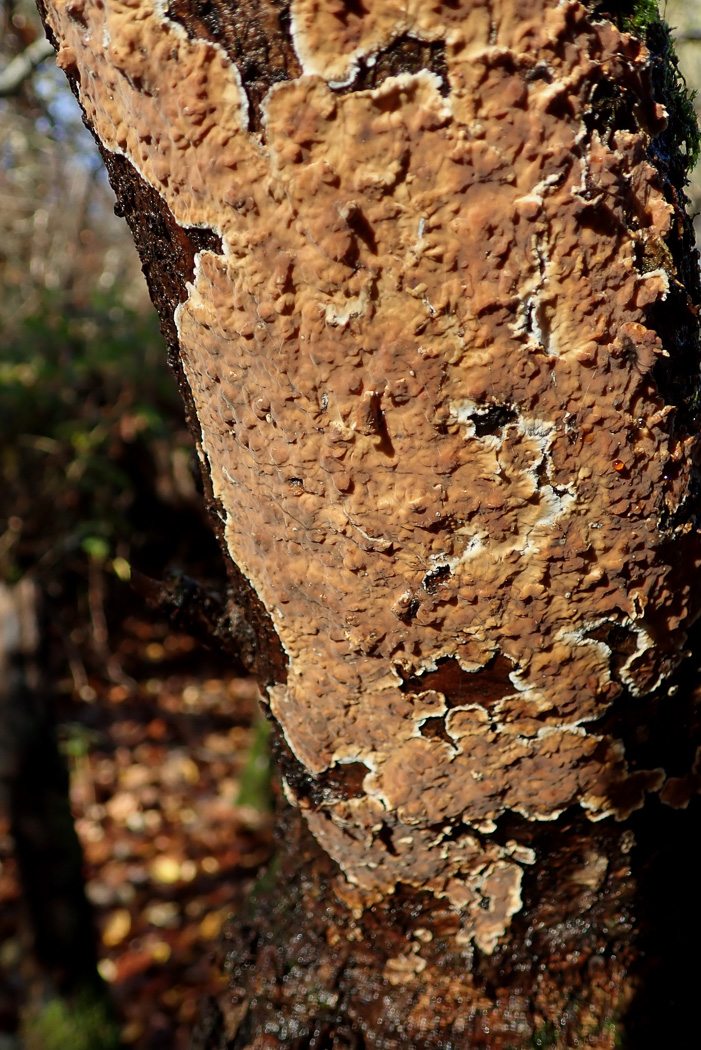
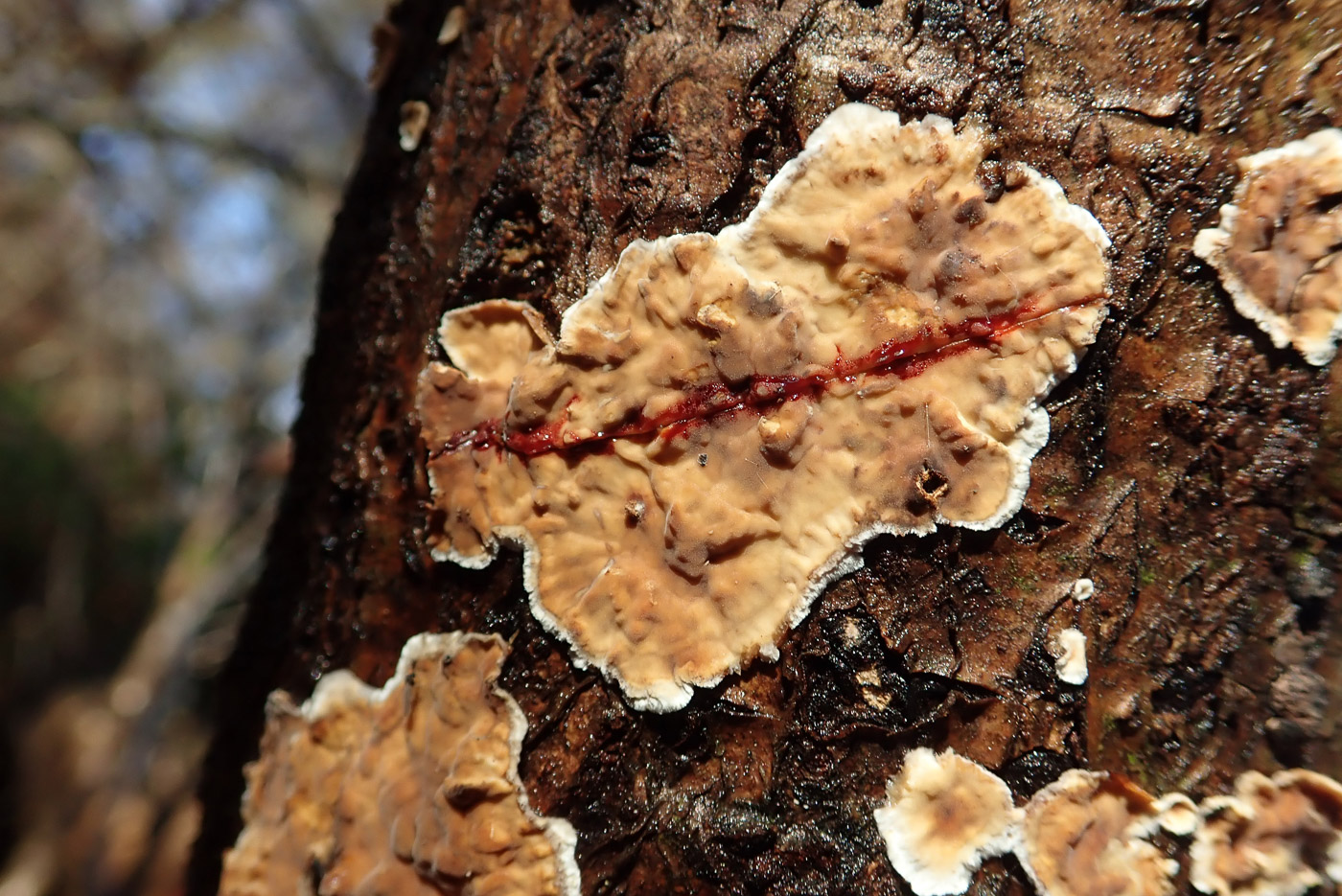
|
Stereum rugosum (Bleeding Broadleaf Crust) Jan 22, 2022. In Stoke Common Jim Wills noticed fresh material of this flattish species fruiting on Birch. It tends to form irregular patches which sometimes join up to make quite big patches, usually remaining pale pinkish and flat.The photos show the species both before and after damaging, demonstrating the typical reddening which happens within seconds when the specimen is fresh. Two other Stereum species also redden in this way: S. gausapatum, typically on Oak, tends to turn yellow and a bit curly at the edges; S. sauinolentum is easinger to be sure of because it is only found on conifer. None of them redden once dry and past their sell-by date! Examples of all three can be found in Finds 2020. Nov 15, 2020. Penny C. found this large pinkish patch on a standing dead Birch trunk in Penn Wood. Unlike the very common S. hirstum (see photos dated Sept 25) this particular Stereum does not form brackets but remains resupinate (flat to the surface of the wood) and the colour and texture is typically as seen here. It is common on many different deciduous woods and in dry conditions can be much paler than this and also somewhat reluctant to 'bleed' when damaged. S. gausapatum (see photos dated Oct 11) is similar but more uneven and bumpy and is only found on Oak. Today's find was fresh and damp and when cut by Penny it bled most enthusiastically! |
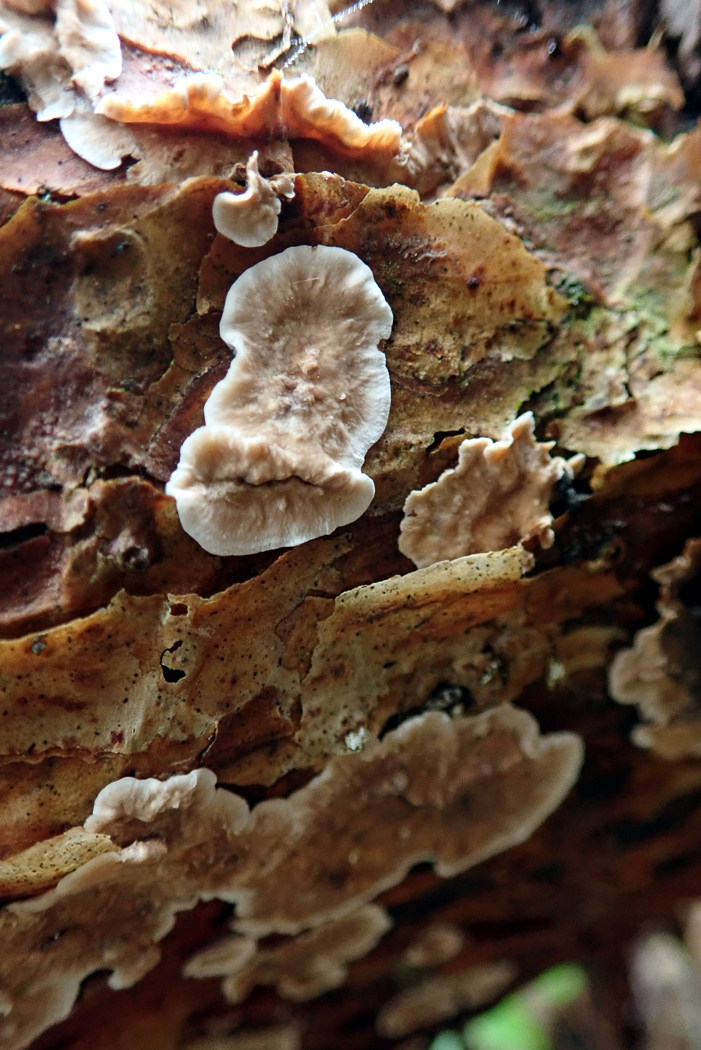
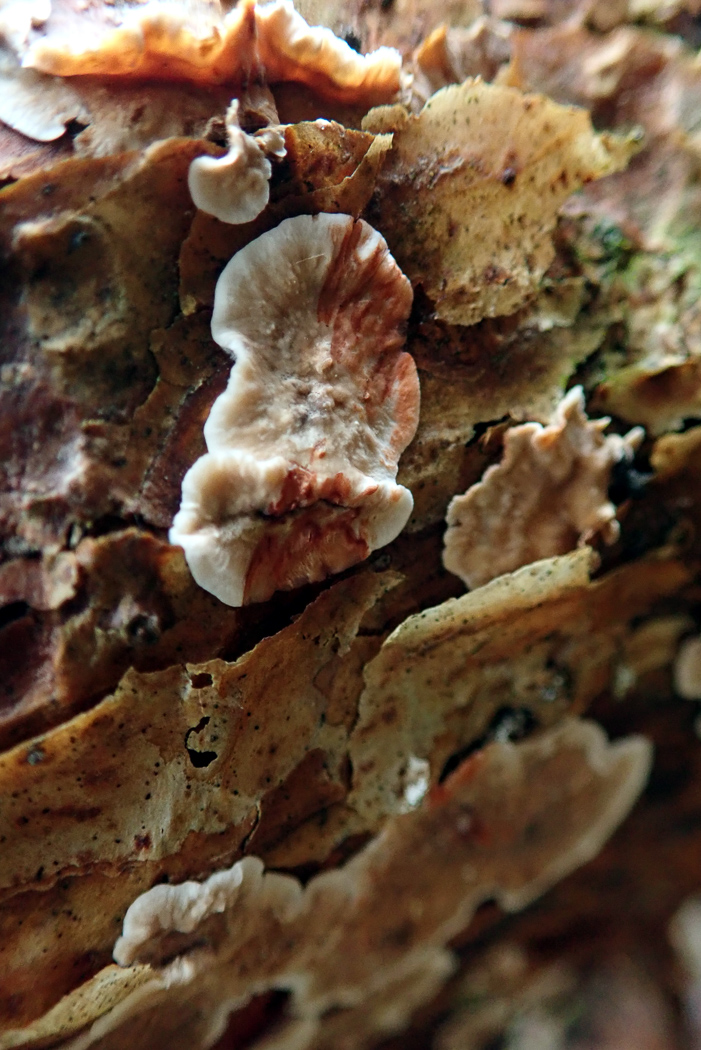 |
Stereum sanguinolentum (Bleeding Conifer Crust) Nov 30, 2020. On a fallen Pine trunk in the Mire at Burnham Beeches Penny C. found a species she had been on the lookout for this season but had failed to find till now. This species of Stereum is similar to the two other reddening species (see also S. gausapatum dated Oct 11 and S. rugosum dated Nov 15) but is the only one found on conifer - both the other are found on deciduous wood. S. sanguinolentum tends to bleed very readily when scratched as can be seen in the before and after photos taken only seconds apart! All three species are quite common. |
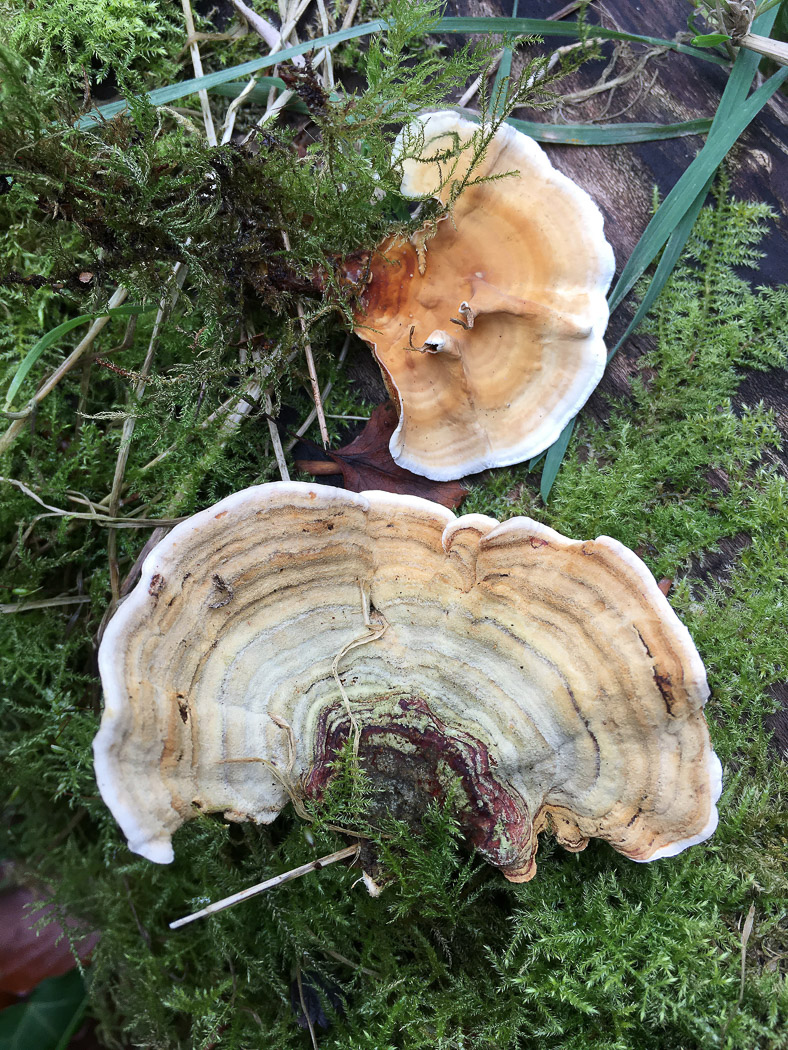
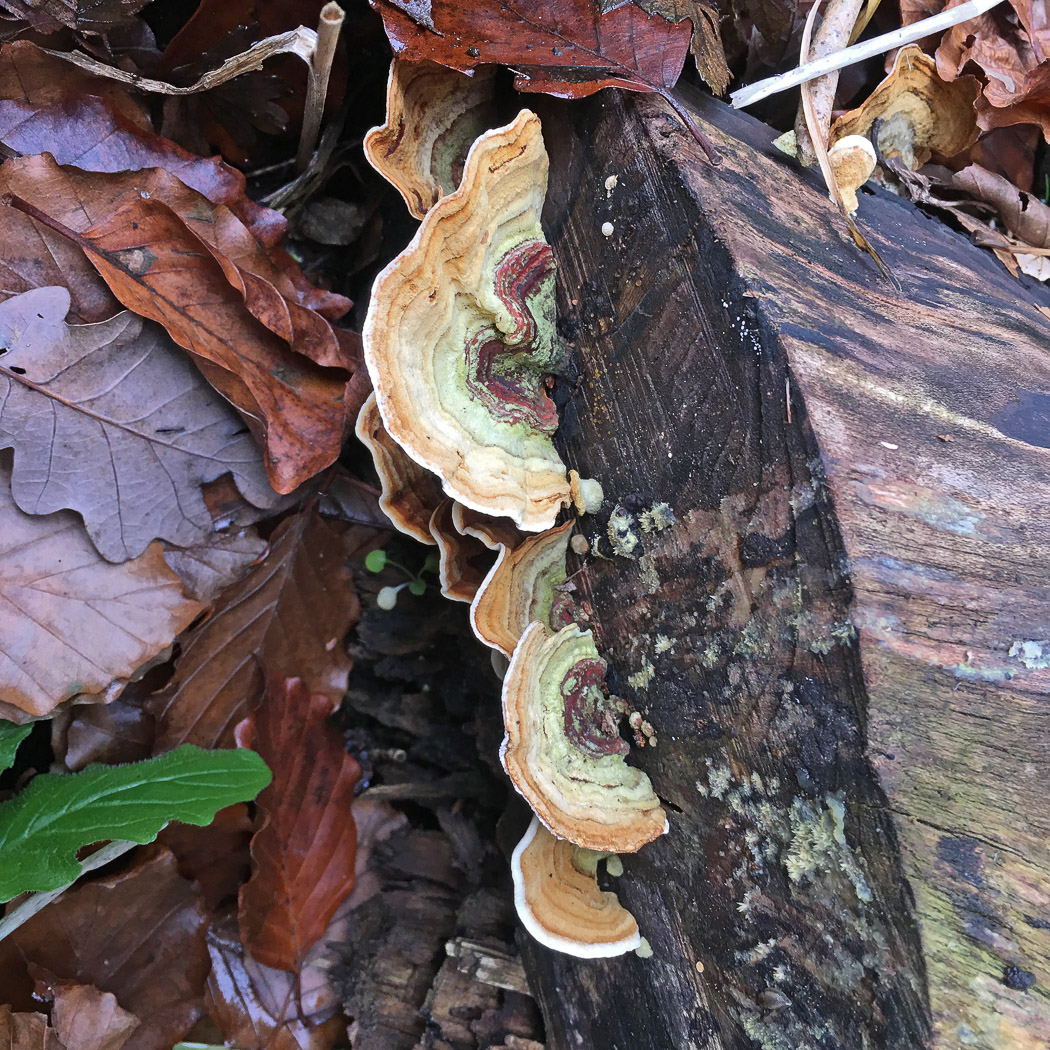
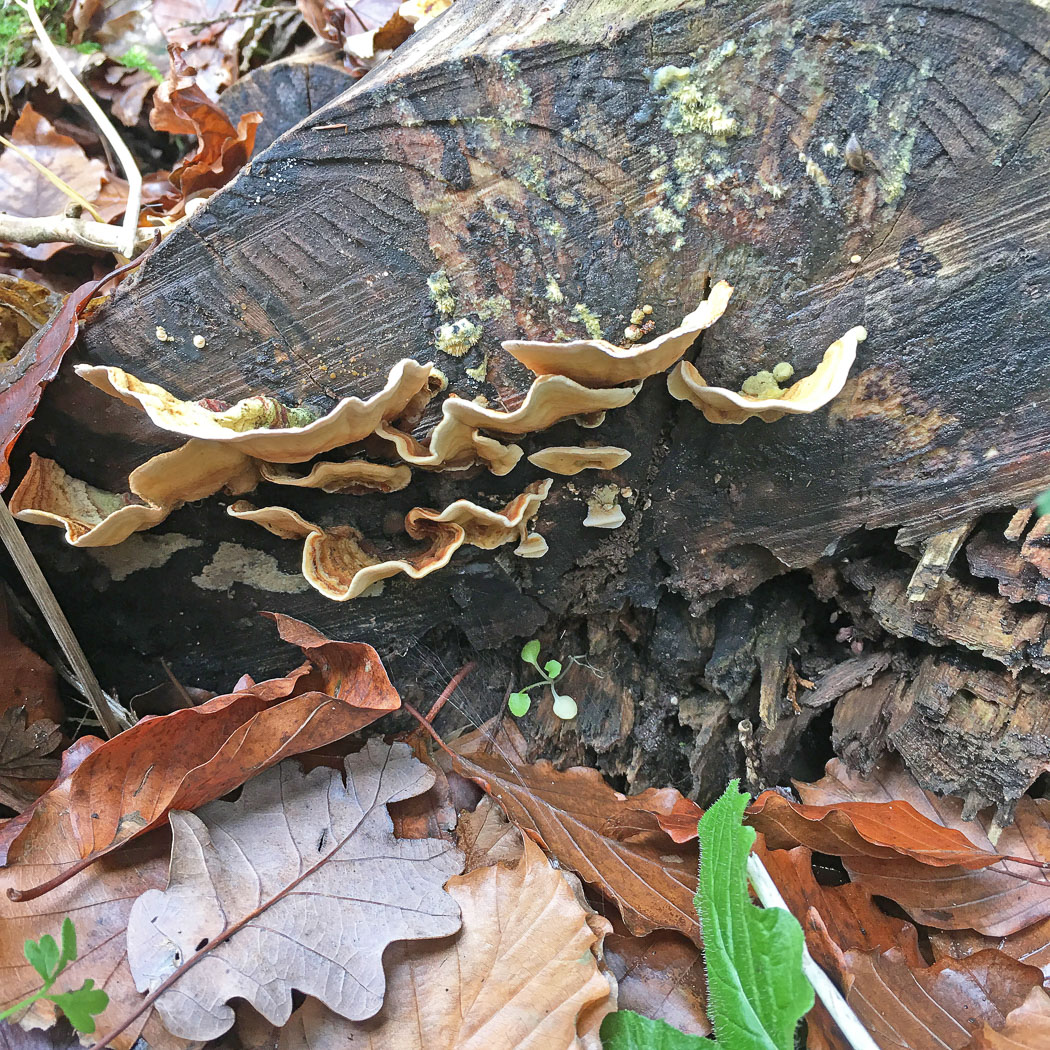 |
Stereum subtomentosum (Yellowing Curtain Crust) Nov 16, 2020. Derek Schafer found this bracket, new to our list, on a bare deciduous log in Hockeridge Wood. It's a species very similar to the much more common S. hirsutum and also found on fallen deciduous branches. It tends to be thinner fleshed and is much flimsier but the two species can be difficult to separate unless - as the common name suggests - one can persuade the edge of the bracket to stain yellow when damaged - something which doesn't occur in S. hirsutum. Biting the edge often works but from these photos I don't think Derek can have tried this today! |
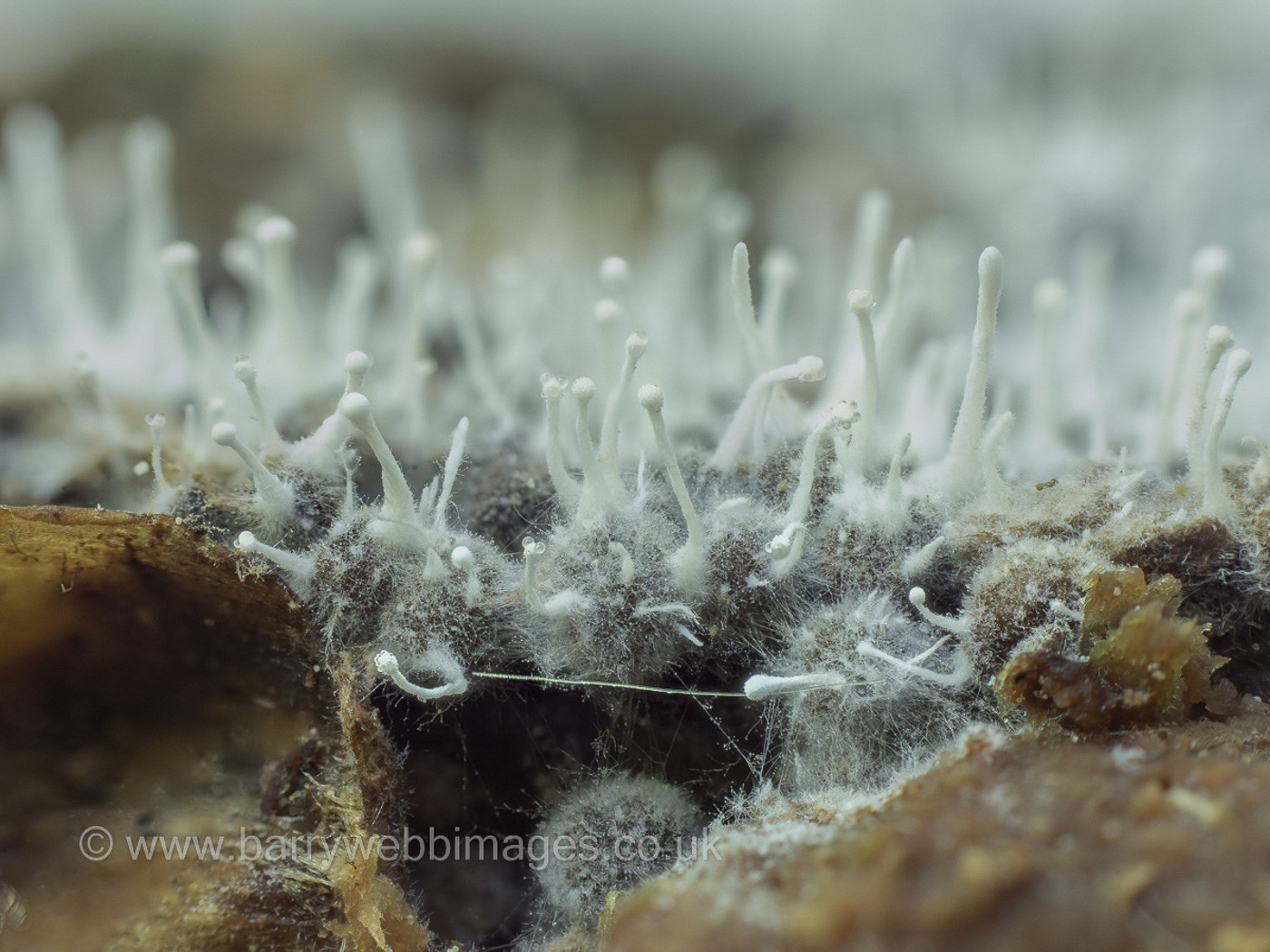 |
Stilbella byssiseda (a species of Hyphomycete with no common name) Jun 9, 2021. This rare species was noticed liberally smothering a colony of the slime mould Cribraria argillacea which a group of us saw at Burnham Beeches. With a hint to its possible identity from expert Kerry Robinson, Penny was able to name it at home later. It is described as occurring solely on two species of slime mould, one of these being C. argillacea, and is new to the county. (Photo Barry Webb) |
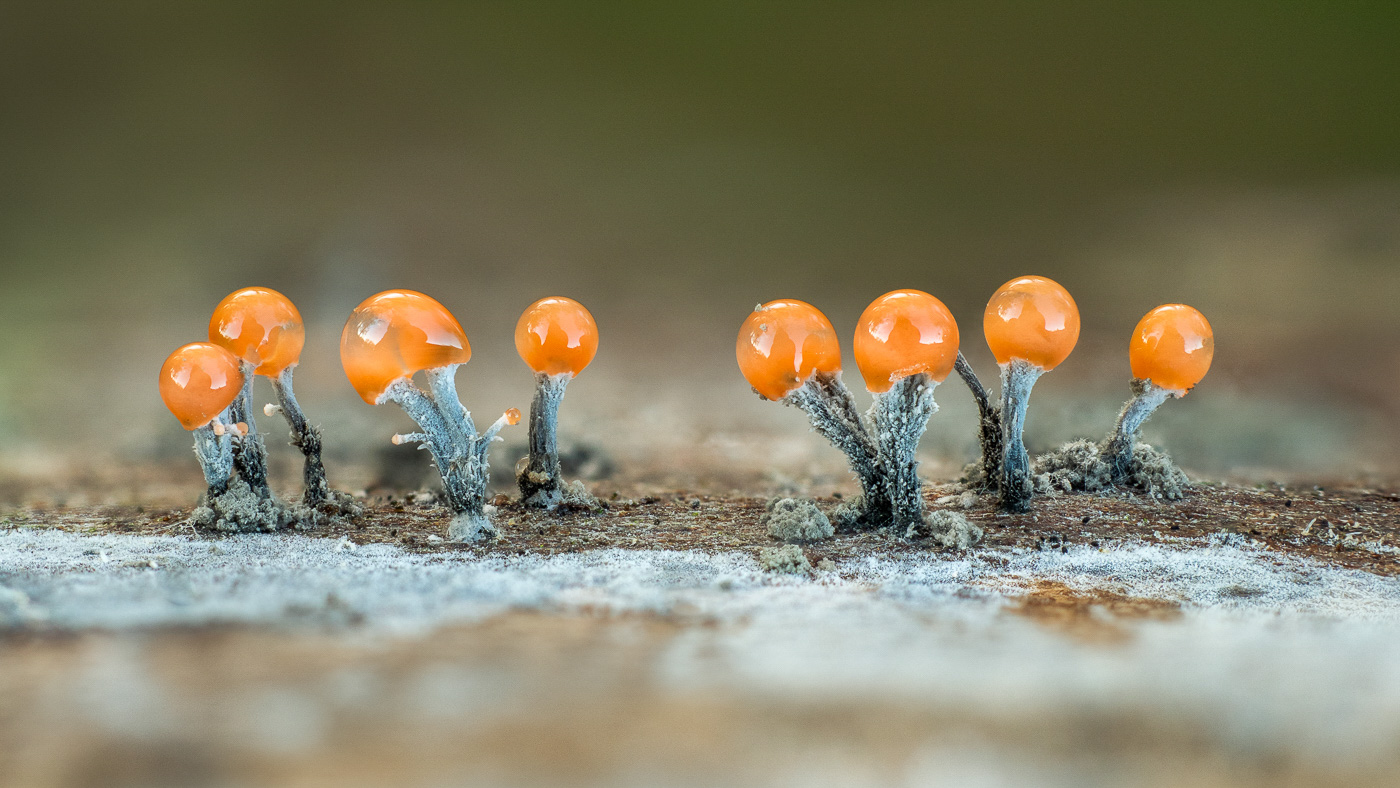
|
Stilbocrea (= Nectria) gracilipes (a fungus with no common name) Nov 19, 2020. On the underside of a fallen Elm branch in Hedgerley Green Barry Webb found this intriguing fungus which - for obvious reasons - he initially thought was likely to be a species of Slime Mould, but not so. These tiny fruiting bodies were only 3-4 mm tall and the orange tops Barry described as almost liquid. At a complete loss as to what it might be, Penny C. trawled through possible sources of photos online to find anything at all similar and eventually hit lucky! Information, however, was in short supply but it appears that this could be an early asexual stage of a species of Nectria (as in the genus of the very common Coral Spot). She could only trace one previous British record from 1998! |




 
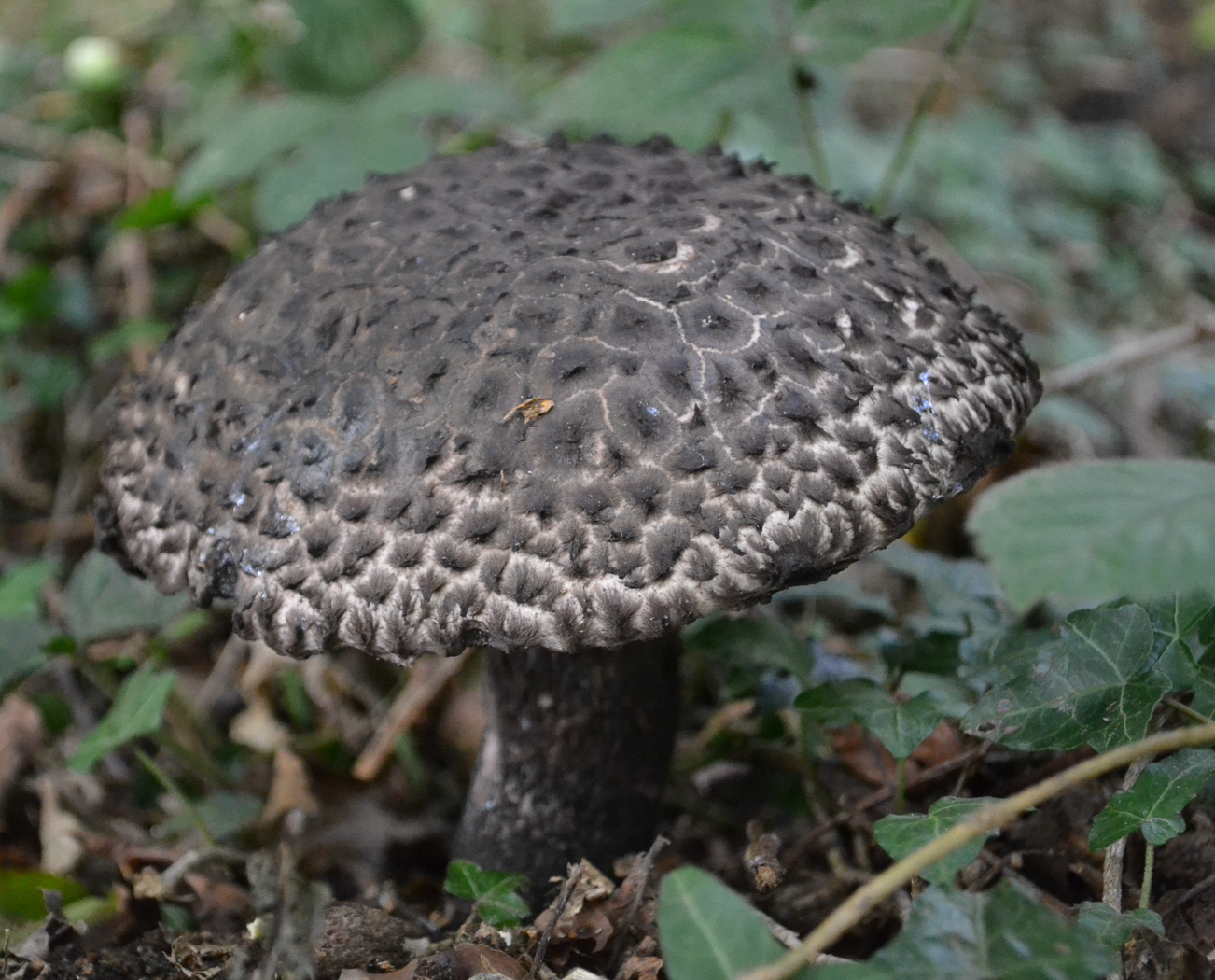
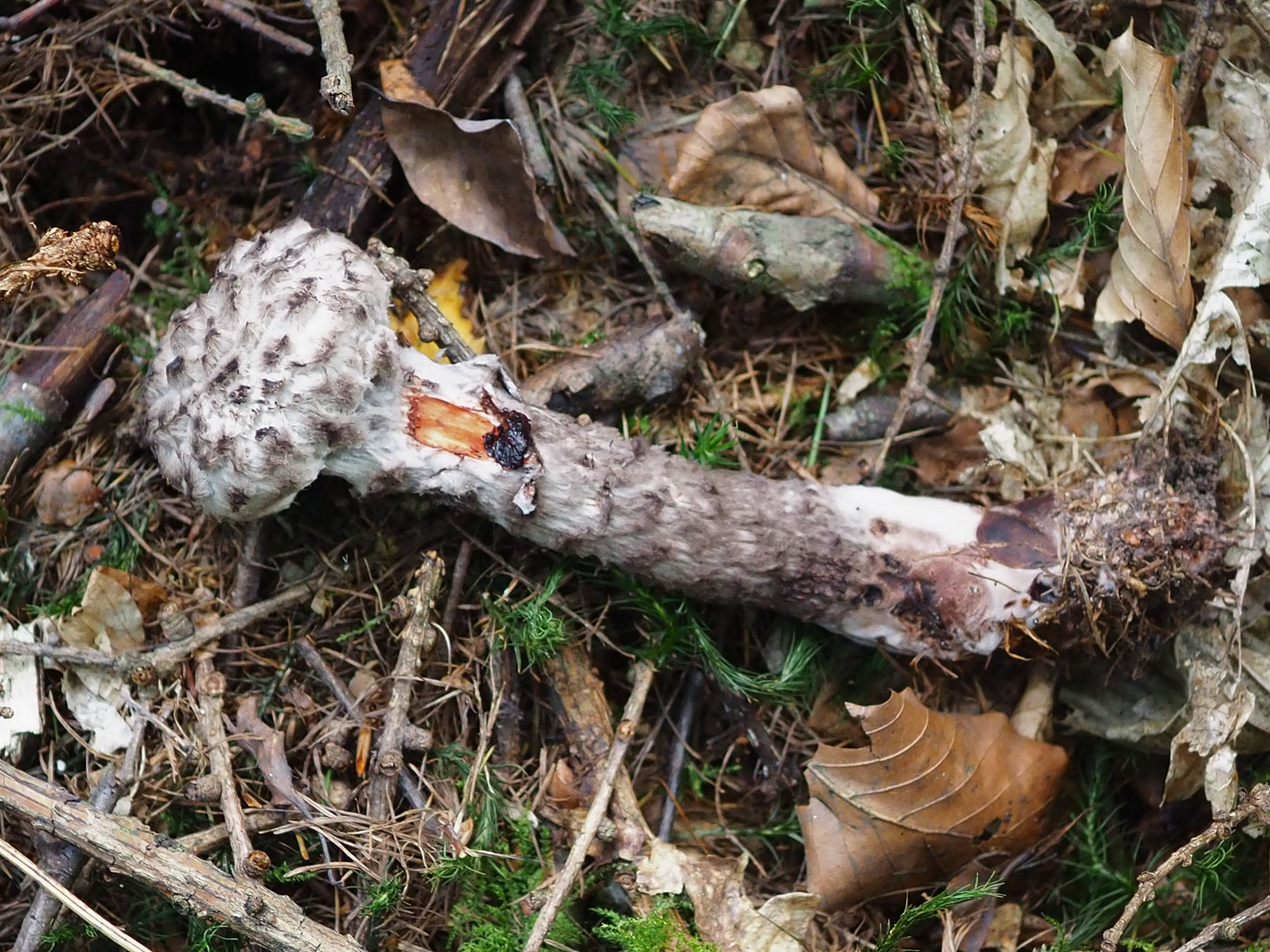 |
Strobilomyces strobilaceus (Old Man of the Woods)
Oct 11, 2023. After a tip-off from a friend, Sarah Ebdon went in search of this unmistakeable and charismatic Bolete in Penn Wood, and sure enough there it was in the spot she'd found it before under the Larches. In photo 2 one can see a damaged bit of cap and pore surface showing the typical reddening when the flesh is exposed to air - not that one needs this extra clue to confirm the ID with such a distinctive species, but every little helps! See the Masterlist for further examples. Aug 20, 2023. In Penn Wood Jackie MD and Justin Warhurst were delighted to come across this unusual and charismatic mushroom which is unmistakable and always a delight to find. Though the pores are not on show here, this is a Bolete but its woolly blackish scales on a white background are unique - more akin to a Parasol maybe - and the flesh turns red when exposed to air. It often lurks in shady spots under deciduous trees but blends well into the background. (The photos are Justin's.) Jul 24, 2023. In Burnham Beeches Barry Webb found this uncommon Bolete making a bid for freedom from under a mossy log. Unique amongst Boletes, it has a thick coating of furry scales on both cap and stem, the dirty white pores and flesh stain first red then black and its spores are subglobose - entirely different in shape from other related genera. The only member of this genus known in the UK, once seen never forgotten! Aug 23, 2020. This quite rare and strange-looking bolete was found by Tim Harrison in Hobbshill Wood near Great Missenden under Beech (photograph Tony Marshall). Apparently not recorded in this specific area for 19 years or so, it has been reported from other woodlands this autumn and is definitely one to look out for. The second photo of young material was found under mixed trees including Larch and Birch at Penn Wood on September 16th by Sarah Ebdon (photo John Catterson). It shows one of the unusual features of the species: when scratched the flesh quickly stains red then black. |
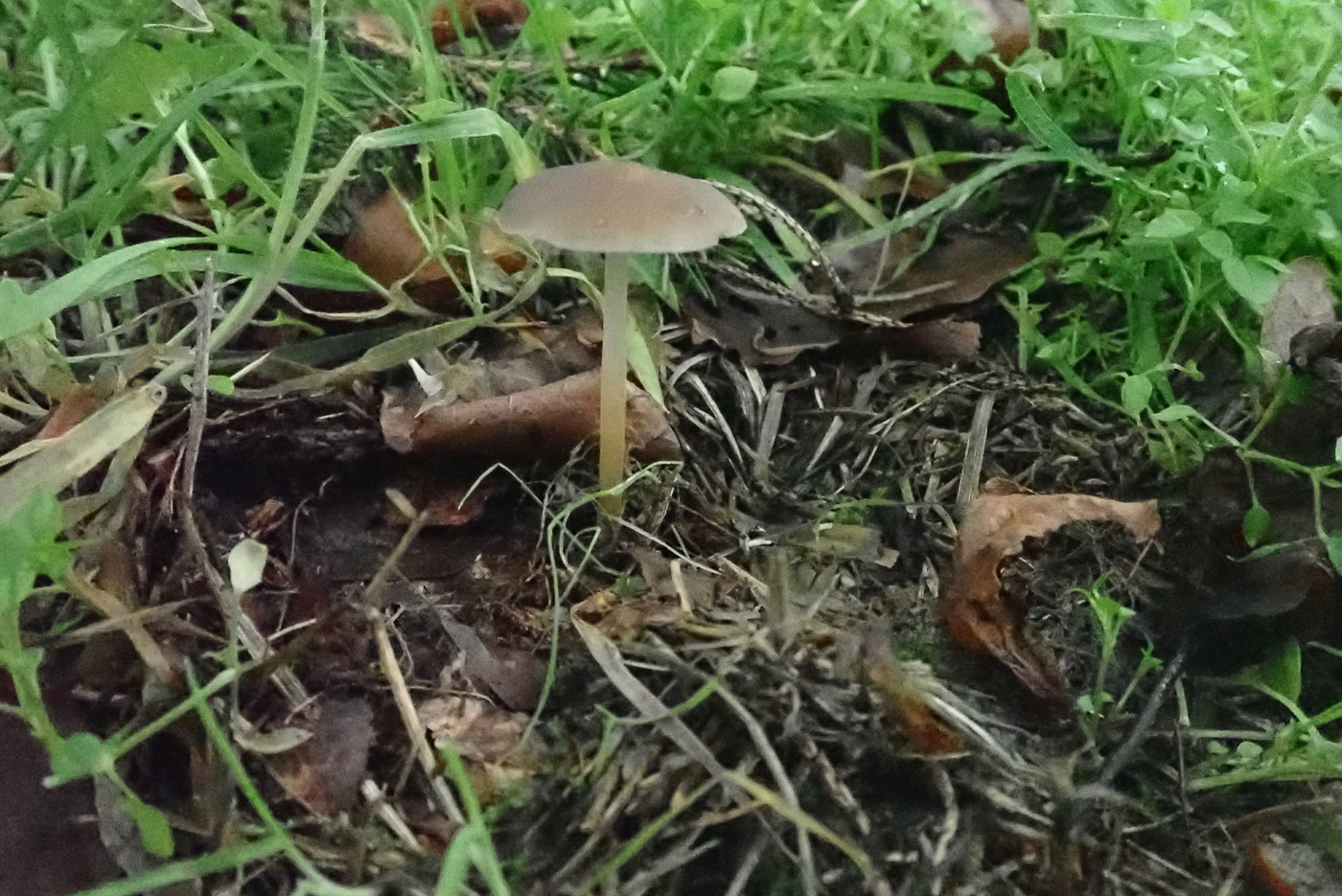
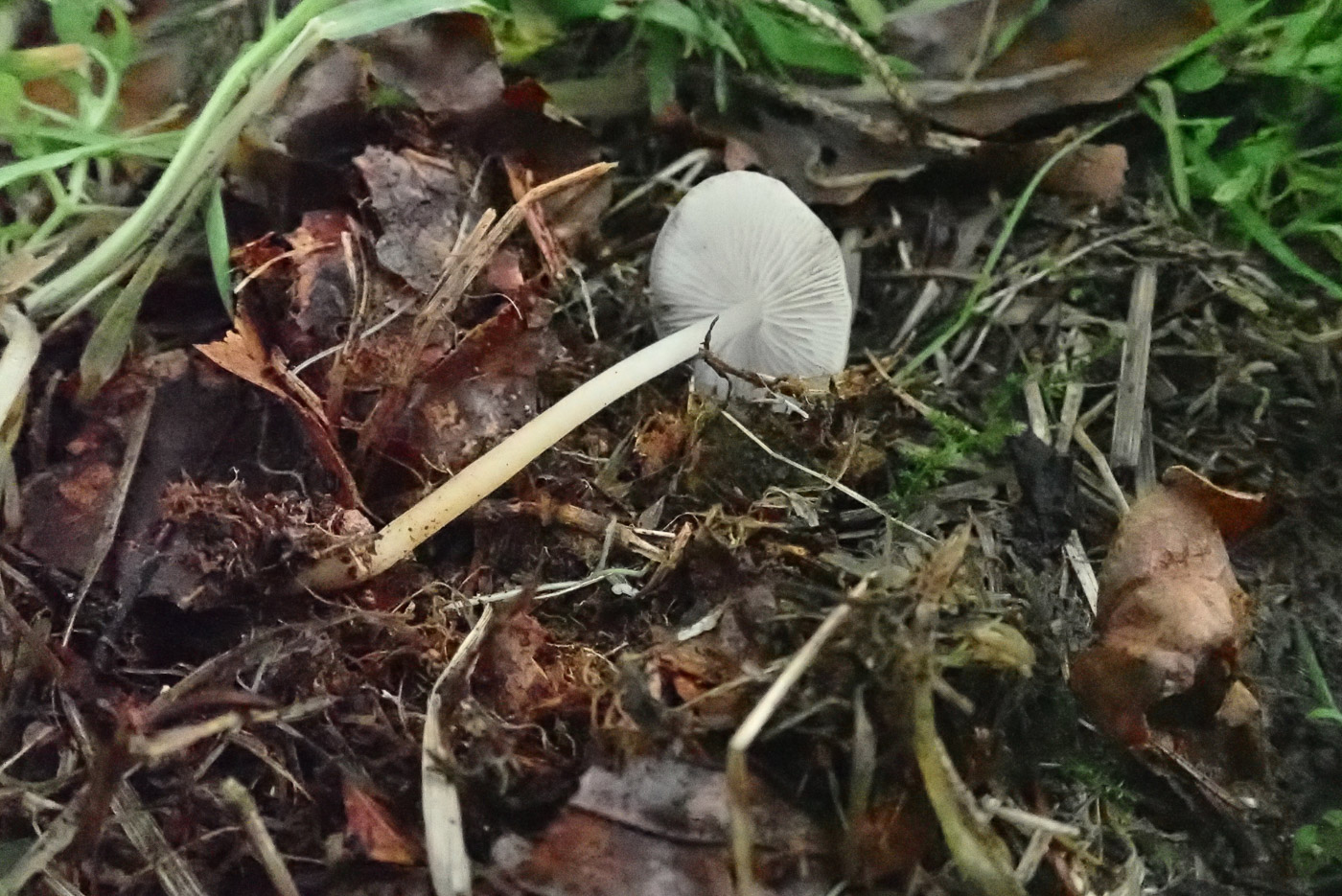
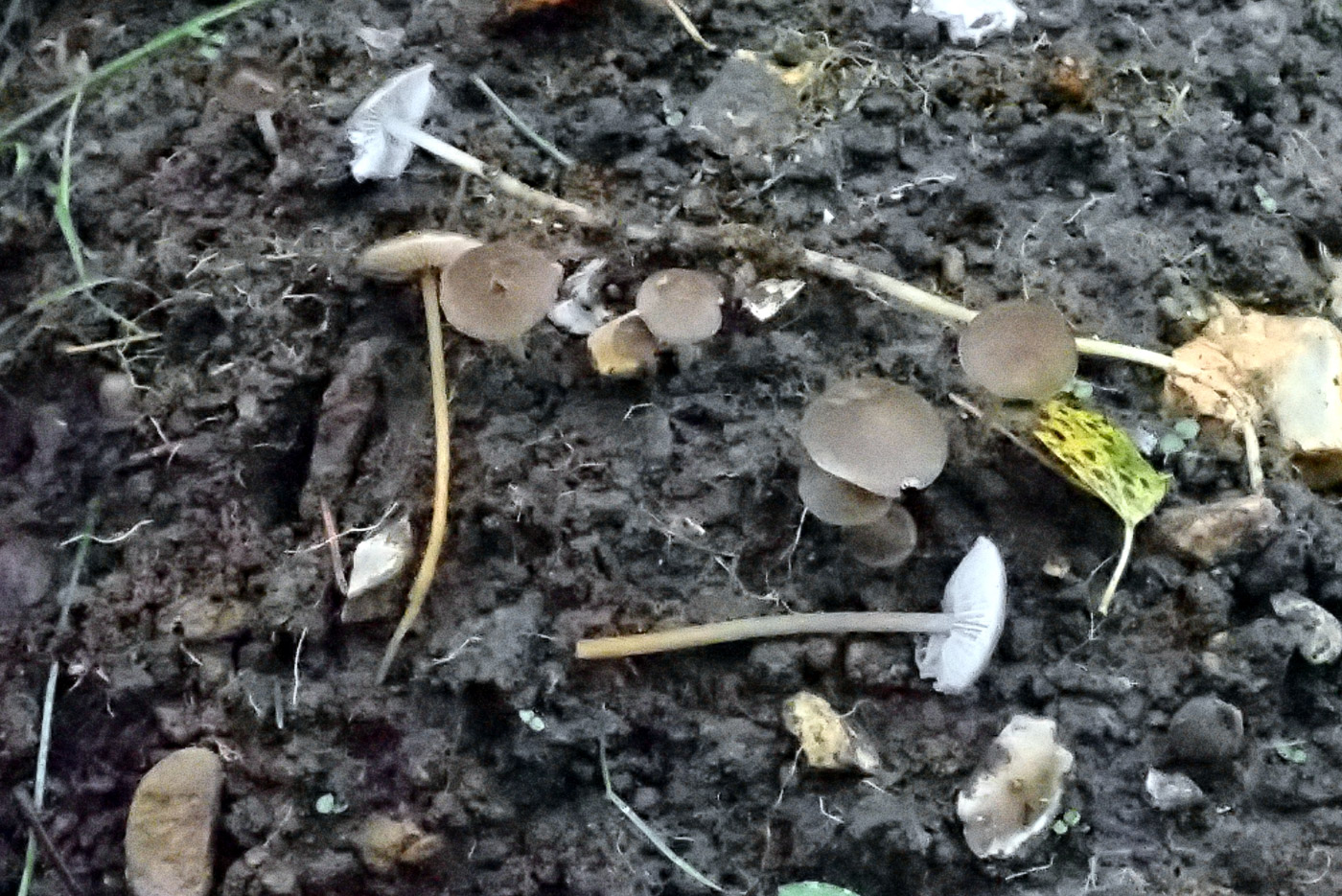
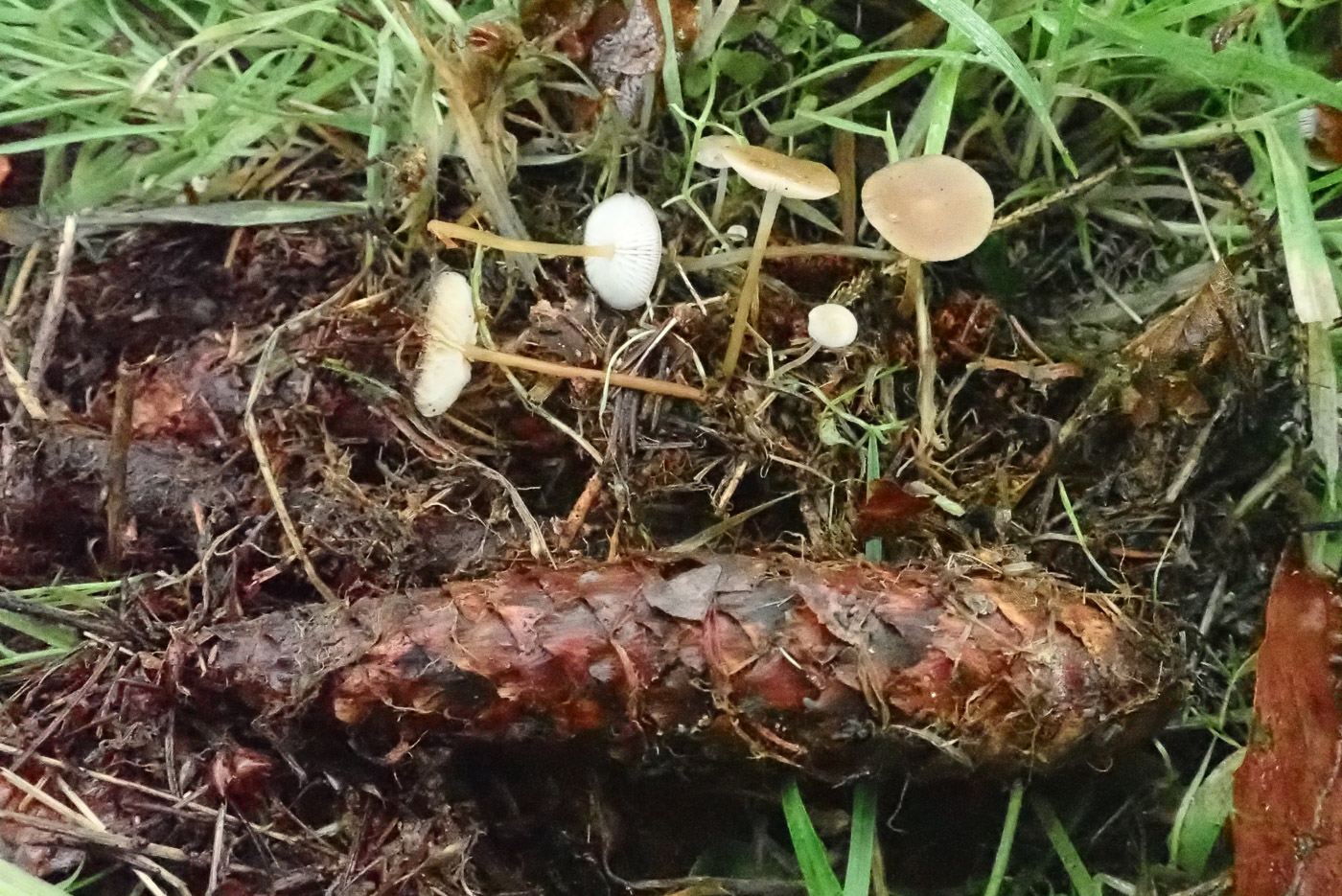 |
Strobilurus esculentus (Sprucecone Cap) Jan 1, 2022. Under a large Spruce at Turville Heath Penny found just the one specimen of this rather Mycenoid species which can mislead. One look at the very distinctive gill cells is enough to confirm its identity, however. Nov 13, 2021. At Turville Heath Penny noticed a group of brown capped Bonnetlike mushrooms growing out of a molehill and investigated further. On pulling one out of the loose soil she found a surprisingly long root! (See the specimen lying left to right along the top in photo 1.) It then dawned on her that the nearest tree was a Spruce and maybe under the molehill was a cone on which the mushrooms were growing. Later on under another Spruce she found more of the same and this time was able to excavate the cone (photo 2). The genus Strobilurus produces small mushrooms very similar to the genus Mycena and which grow on either Pine or Spruce cones. Today's species only occurs on Spruce cones and has amazing and unmistakeable gill cells with thick walls and crystals like the genus Inocybe (Fibrecap). Both today's collections were checked because Penny had no idea they could produce a long root - a fact not mentioned in reference books. |
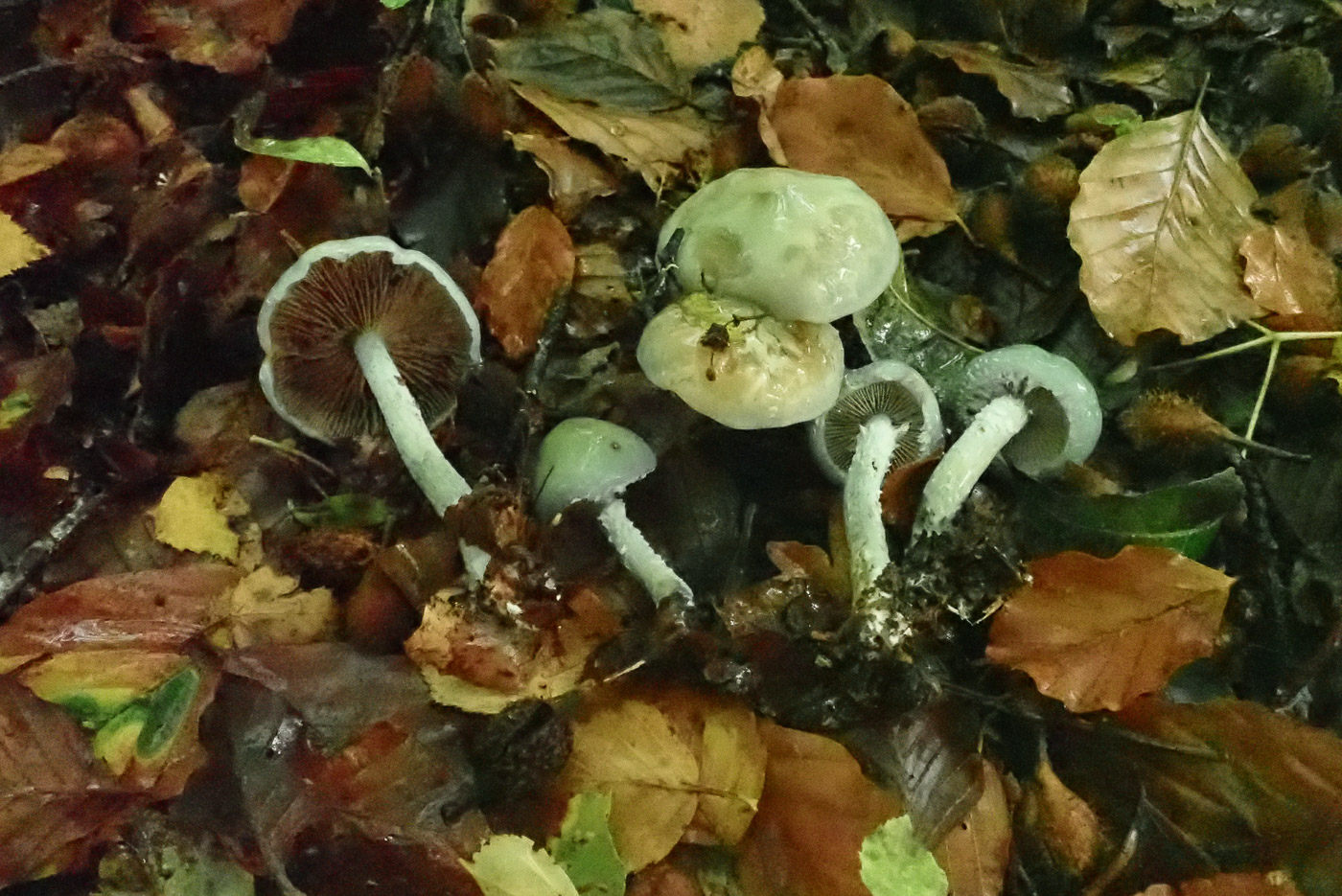
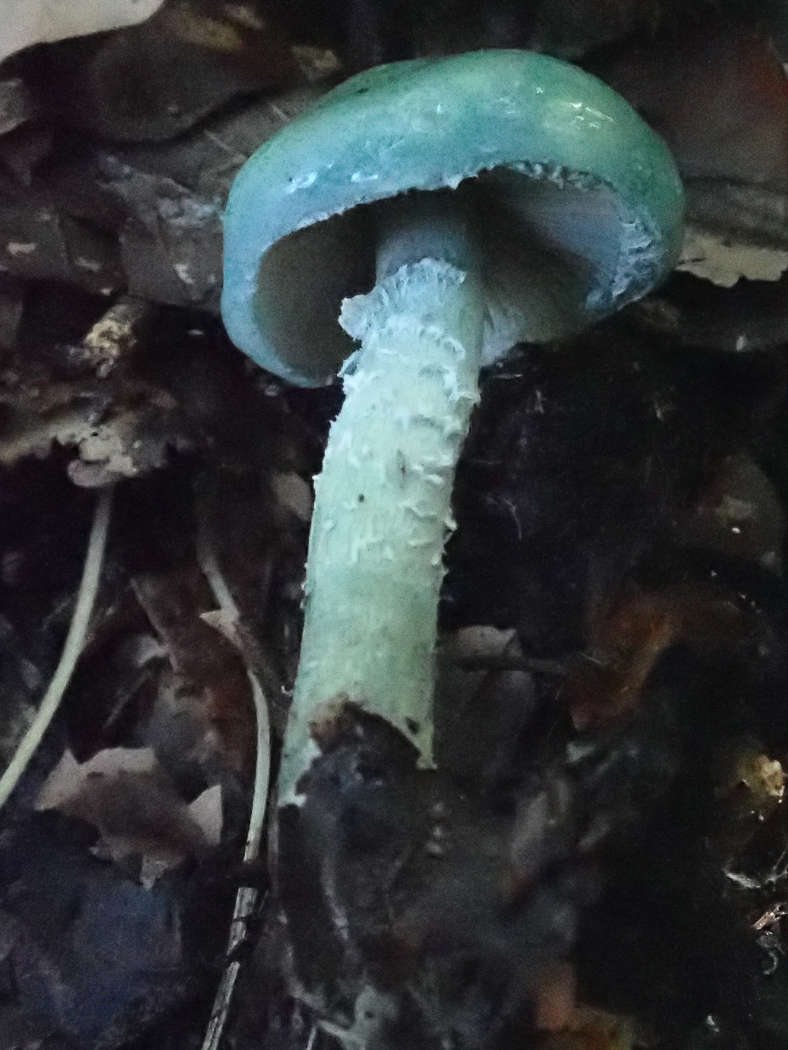
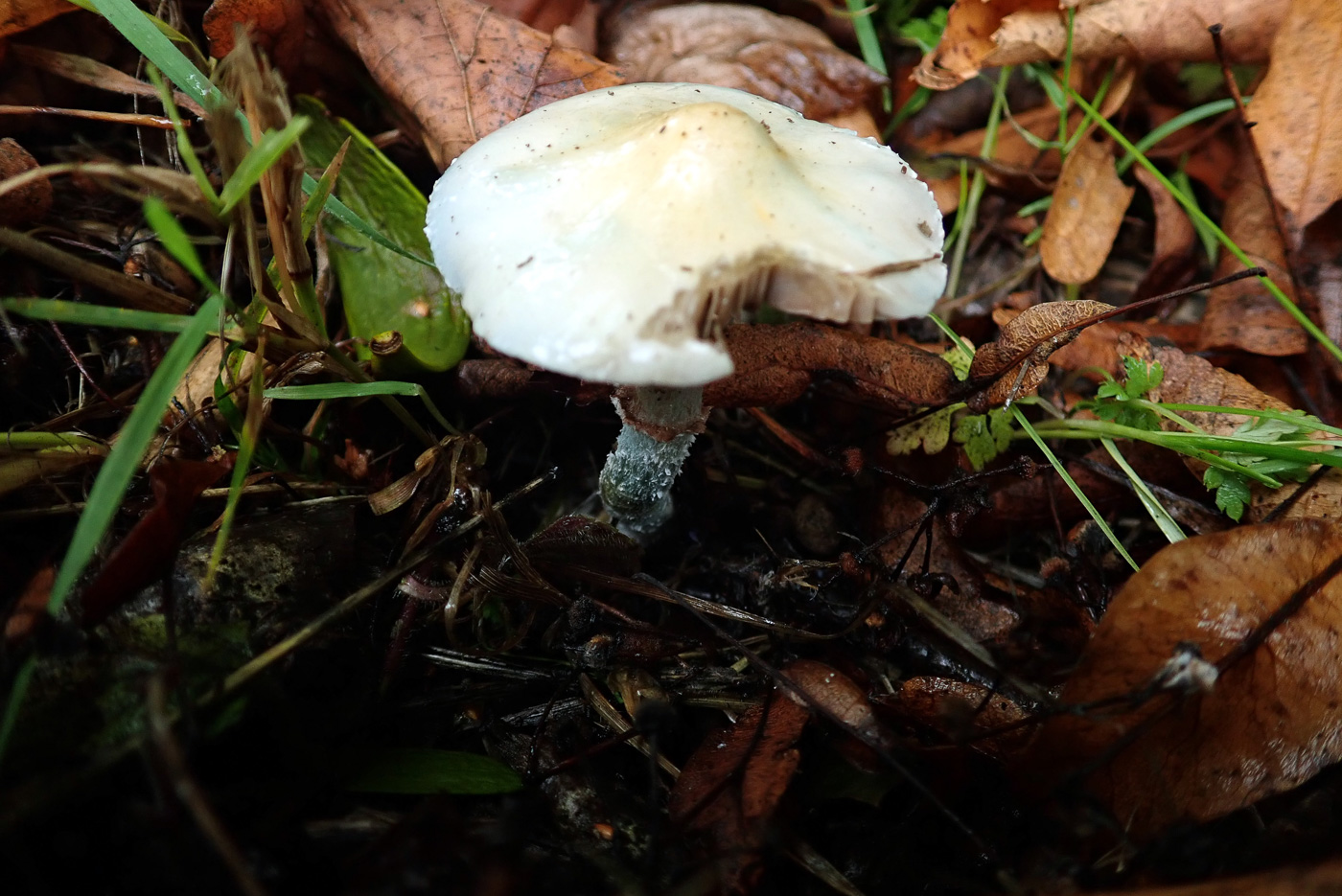
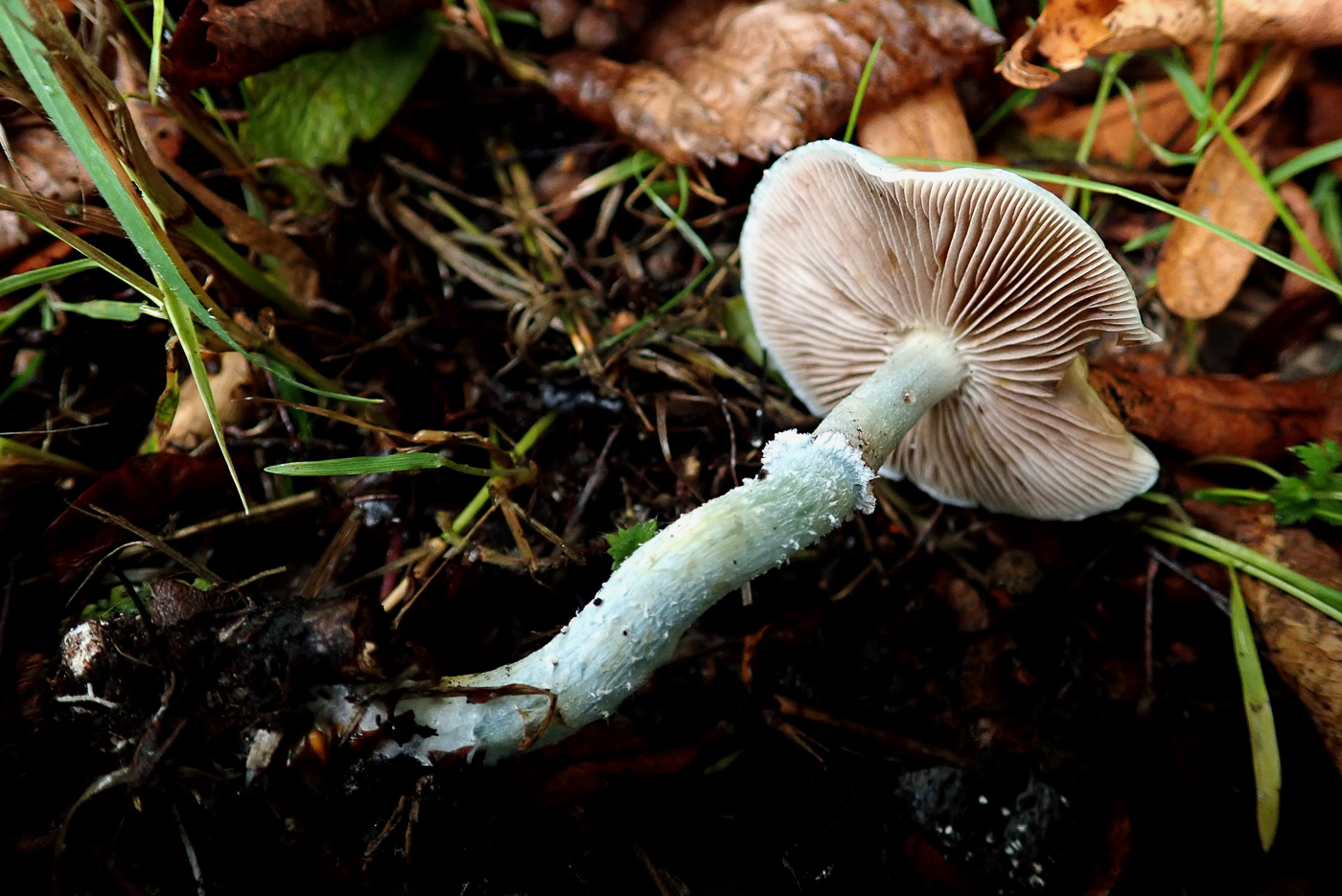
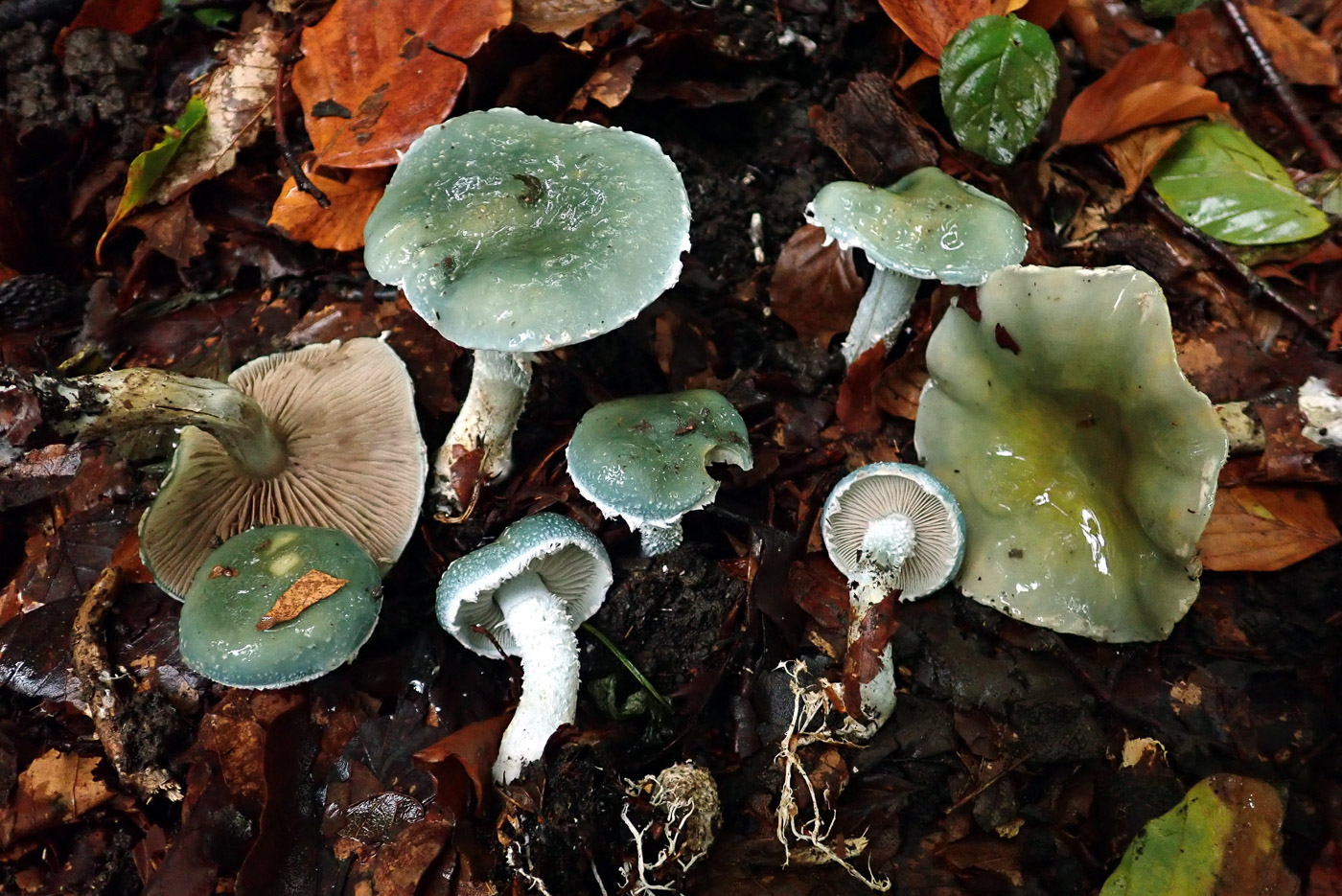
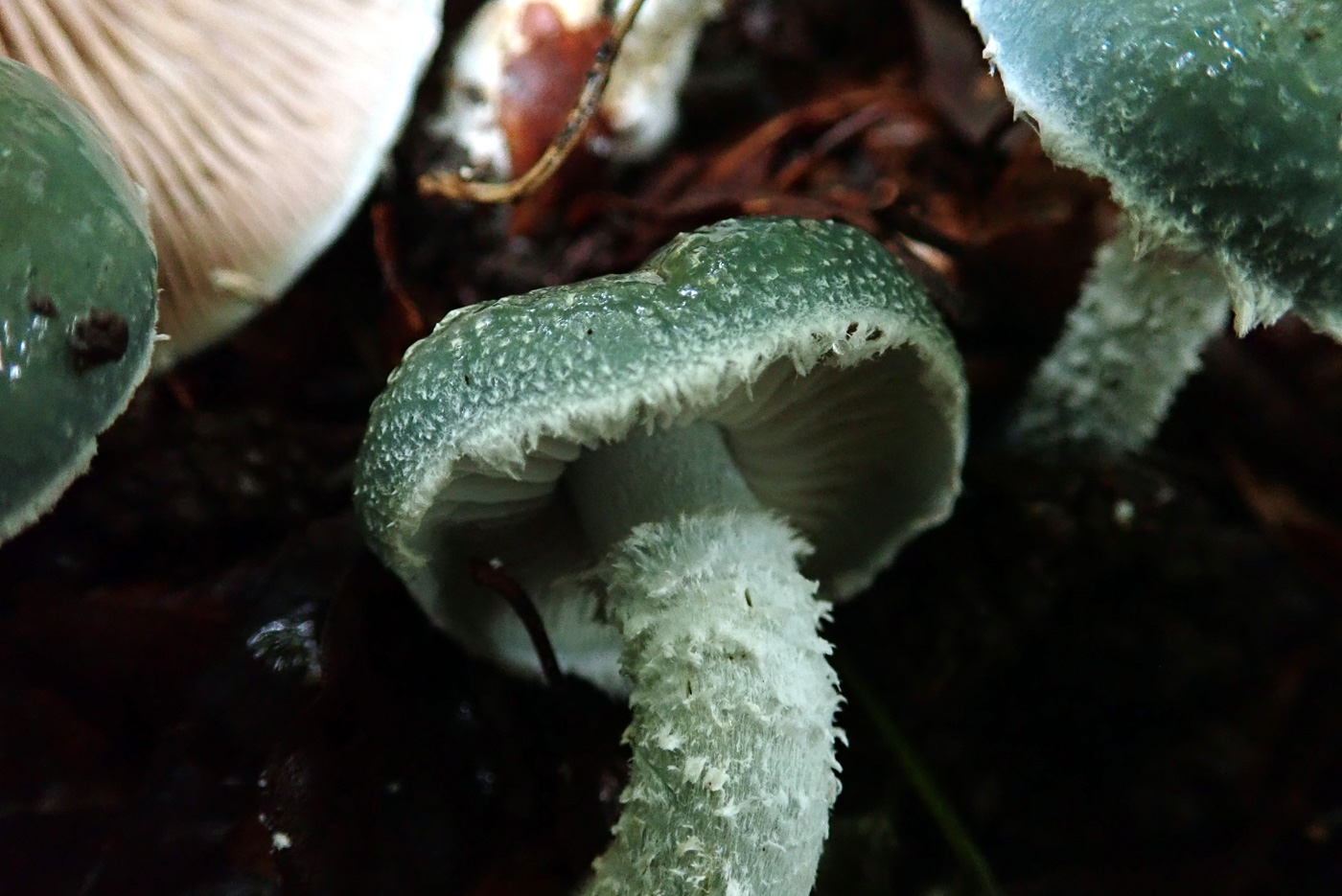
|
Stropharia caerulea (Blue Roundhead) Oct 20, 2021. In a rather wet Gussets Wood Penny found this rather faded collection of a beautiful blue green quite common species which develops dark brown gills and often has a floccose stem with a ring (though this can disappear with age or weather). A little further on she found a better specimen (photo 2) showing off its stunning colour. This is mainly a species of grassland / grassy verges but often also occurs in woodland litter where often mistaken for the even more impressive but considerably rarer woodland species S. aeruginosa (Verdigris Roundhead). That species should really only be claimed if proven to have different microscopic features from today's species. Sep 30, 2020. This common grassland species was found by Penny Cullington at Turville Heath. Sadly this was a singleton with a typically faded cap which when young and fresh is a beautiful blue-green. Caps are smooth and sticky, gills start out pale buff but gradually darken as the dark brown spores mature, stems are striking with a white edged blue ring and below this more blue flecked with white. A very attractive species. Oct 14, 2020. We do have a singleton of this species already (dated Sept 30), but this was such a stunning collection, found by Penny Cullington in Kings Wood, that it deserves an entry of its own. Found in both grassy habitats and woodland litter, when in pristine condition as here it is one of the most eye-catching and attractive mushrooms. The largest cap, just beginning to fade, was about 4 cms across. The gills, at first pale beige, end up considerably darker as in the left hand upturned fruitbody, and the coarse white fluffy edge is often soon lost in rain. The stem is also white fluffy below the ring zone but smooth above this (seen in photo 2). |
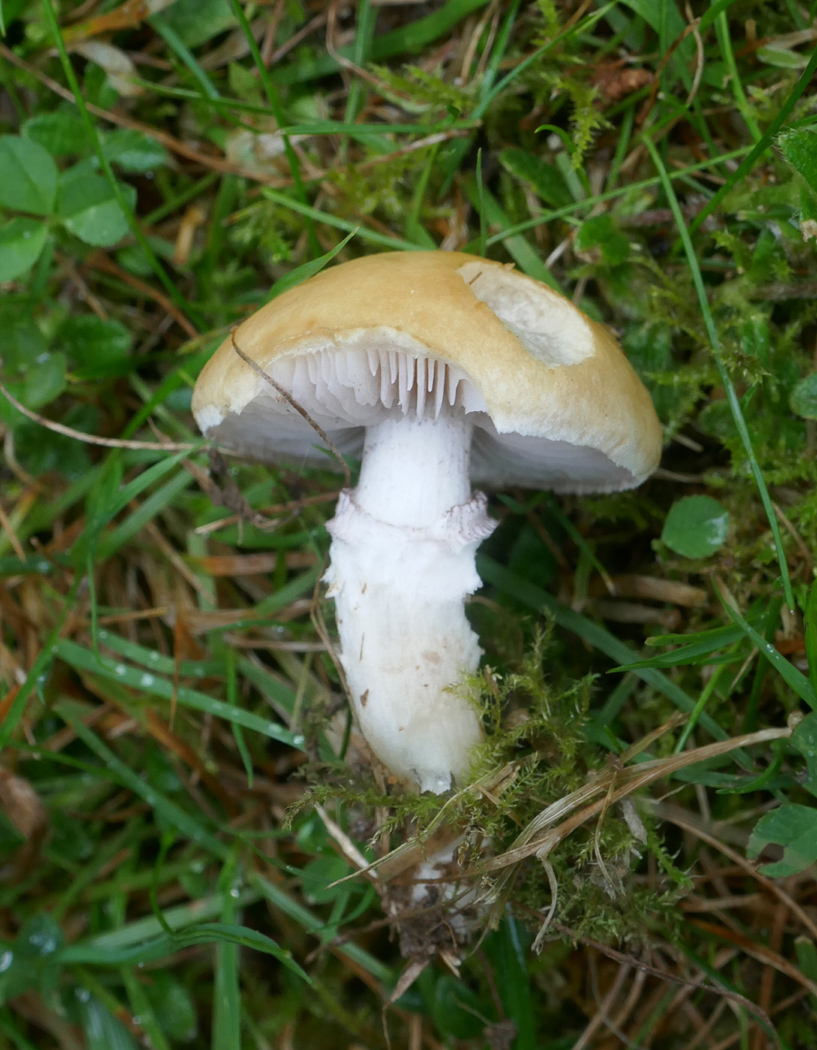
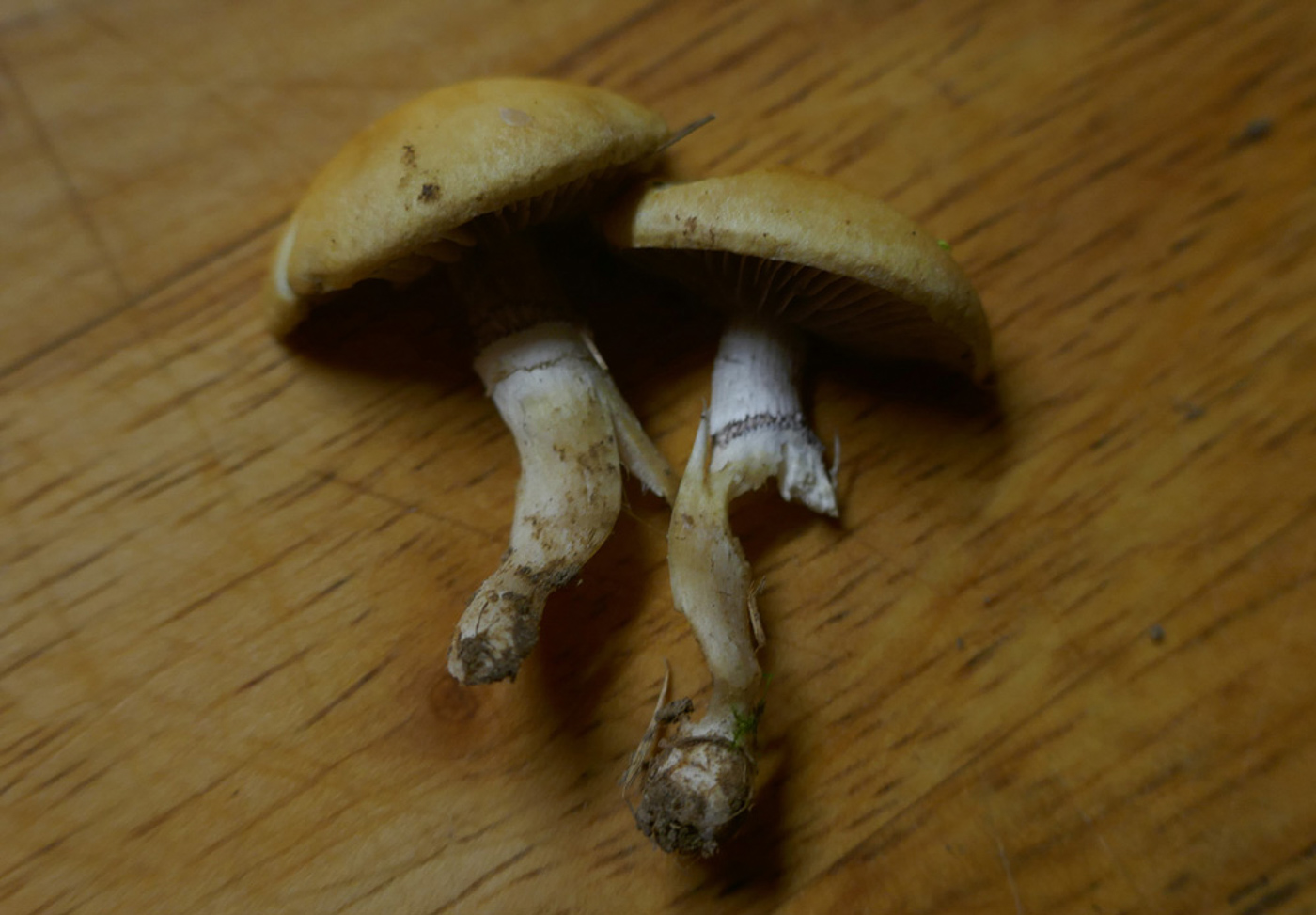 |
Stropharia coronilla (Garland Roudhead) Sep 30, 2024. In a grassy part of Stampwell Farm Jackie Ewan recognised this quite unusual grassland species though she'd not seen it here very frequently. It was a species Derek used to record regularly from his paddock in Oving but we have no records of it since 2011. The yellow cap and distinct grooved ring on the stem which gradually becomes coloured with the dark spores (hence the name garland) are the distinguishing field characters to look for, then confirmation from the microscopic characters is needed if in doubt. This is a new species for Finds. |
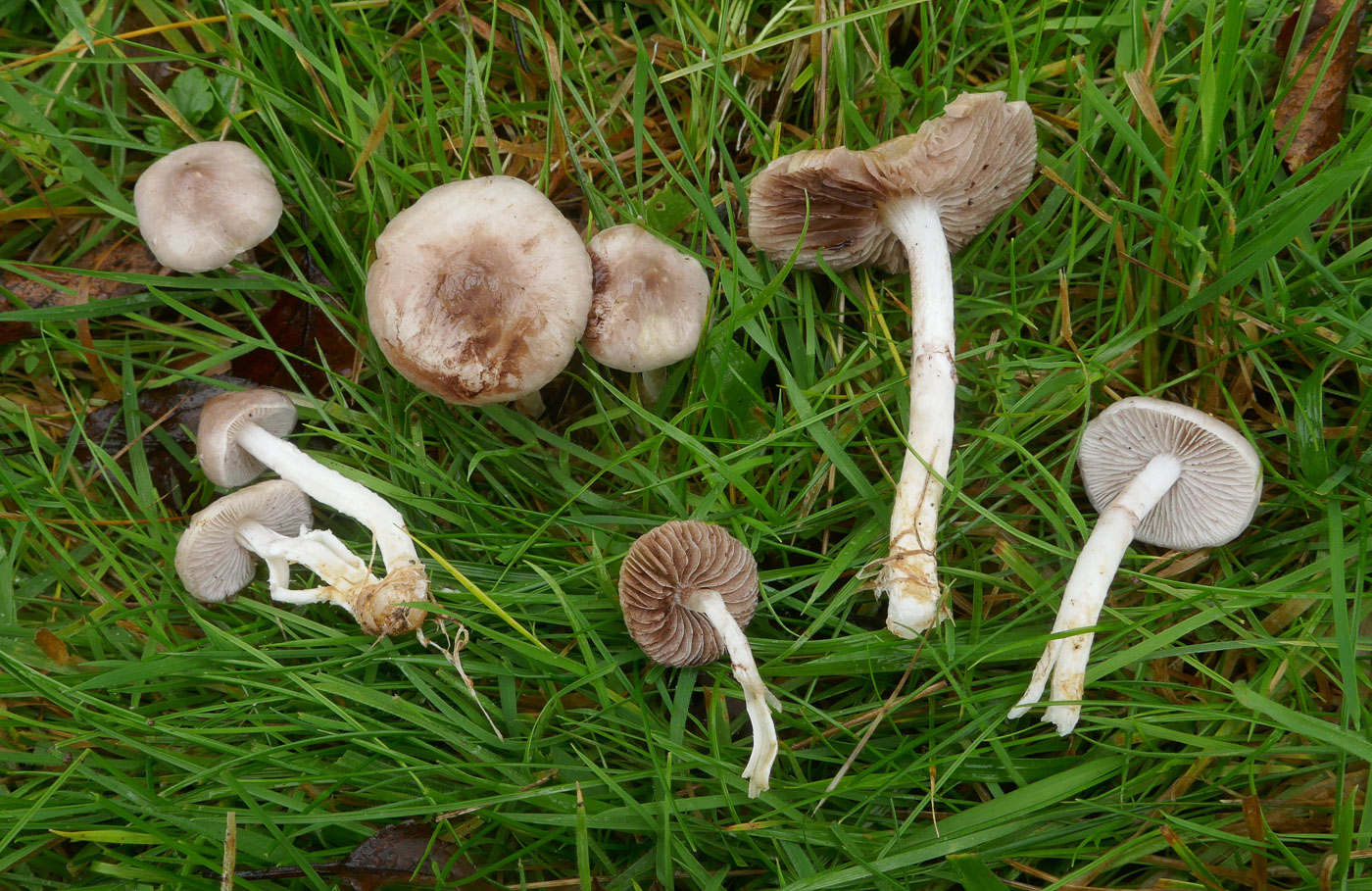 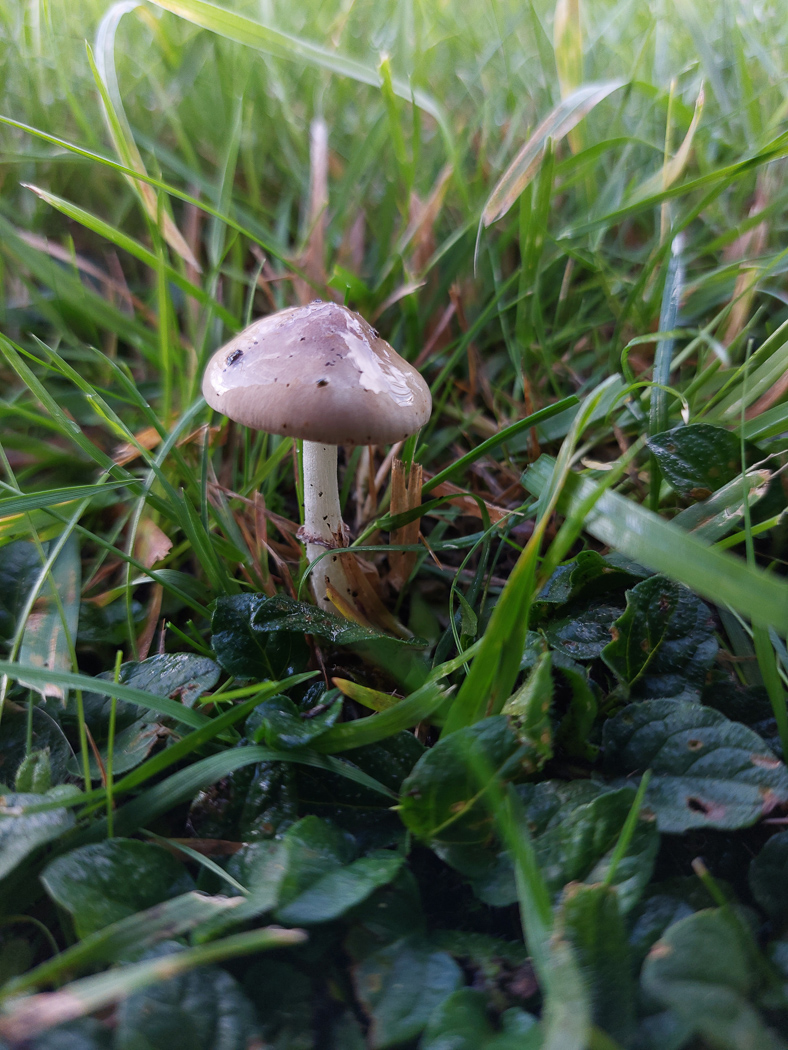
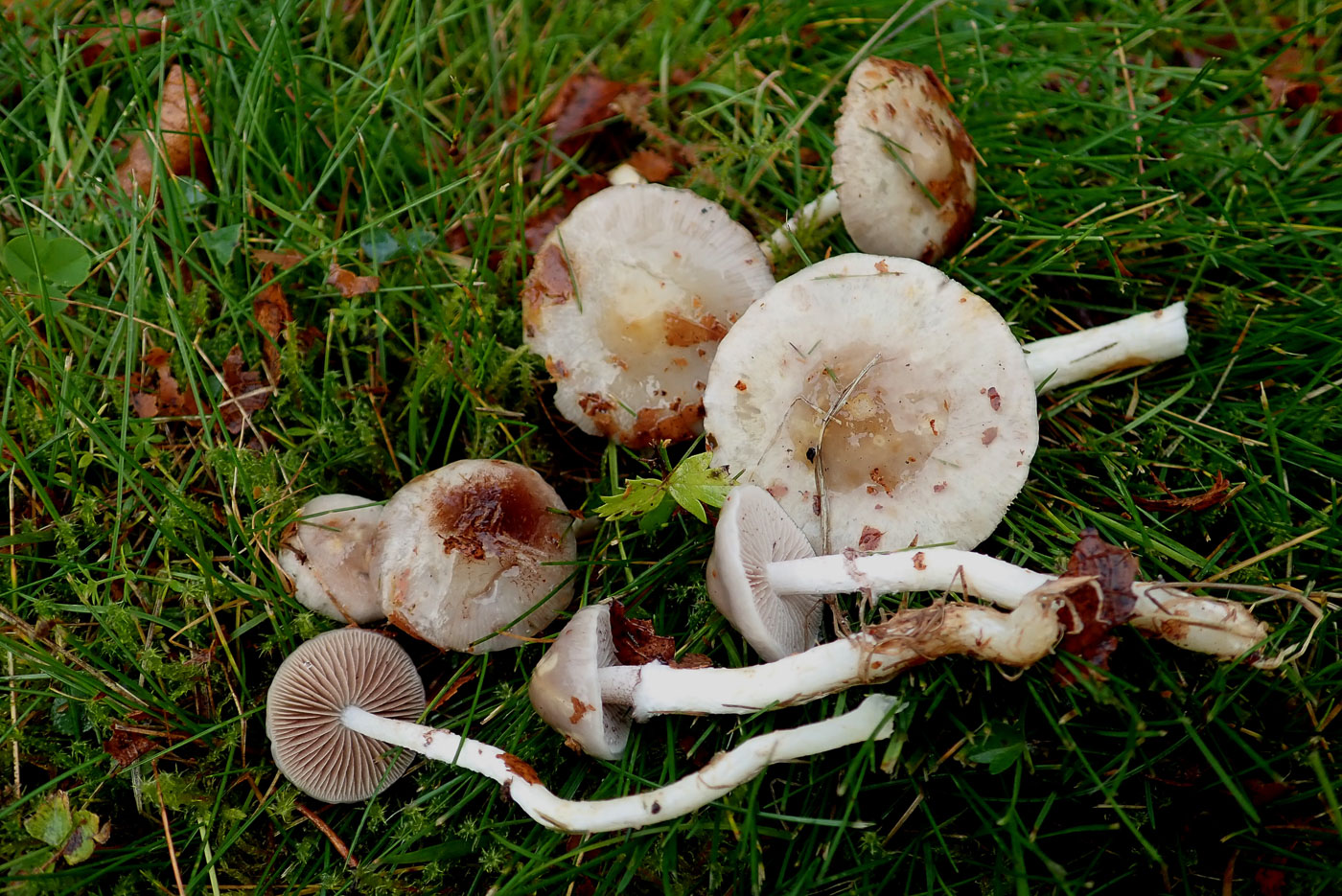
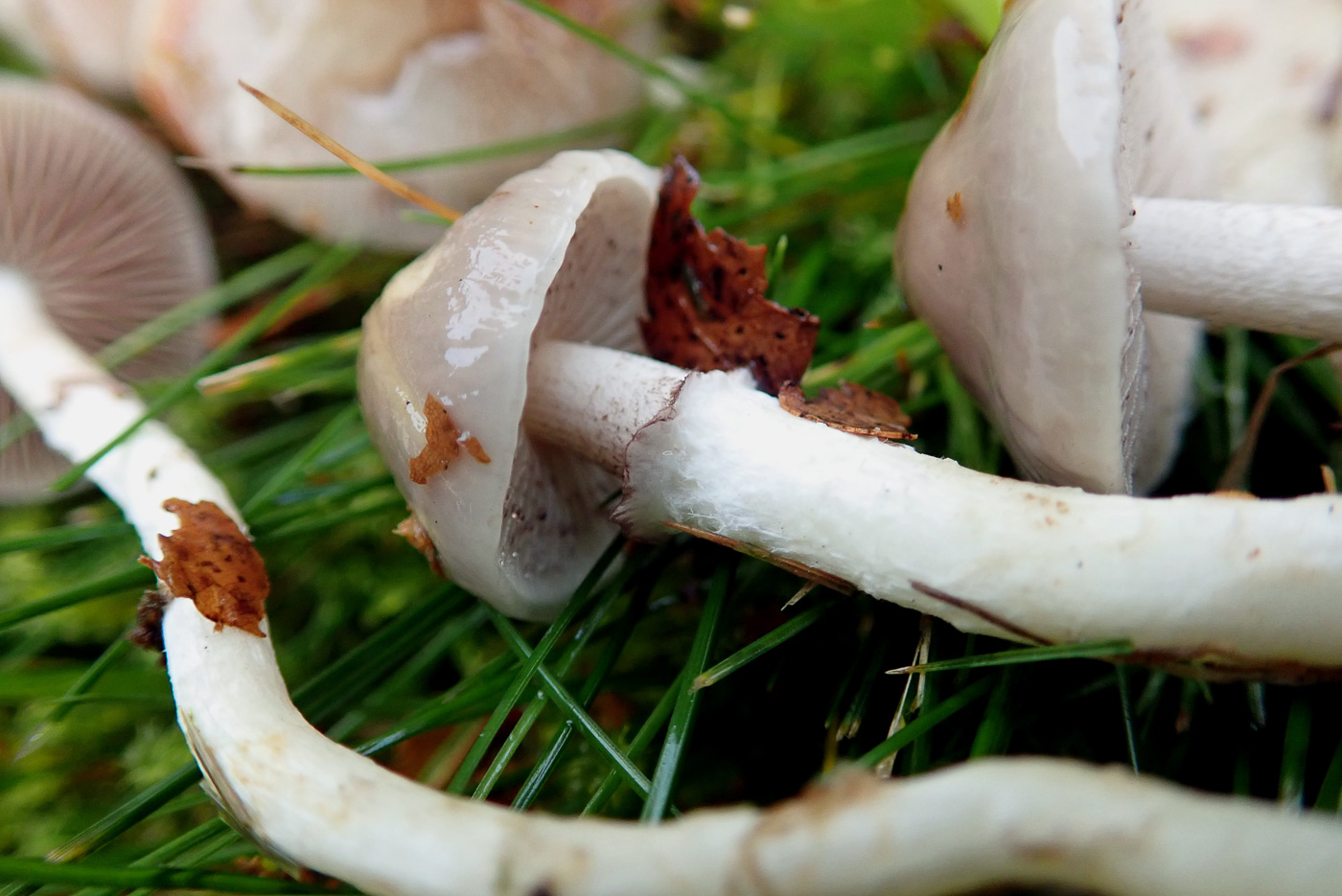
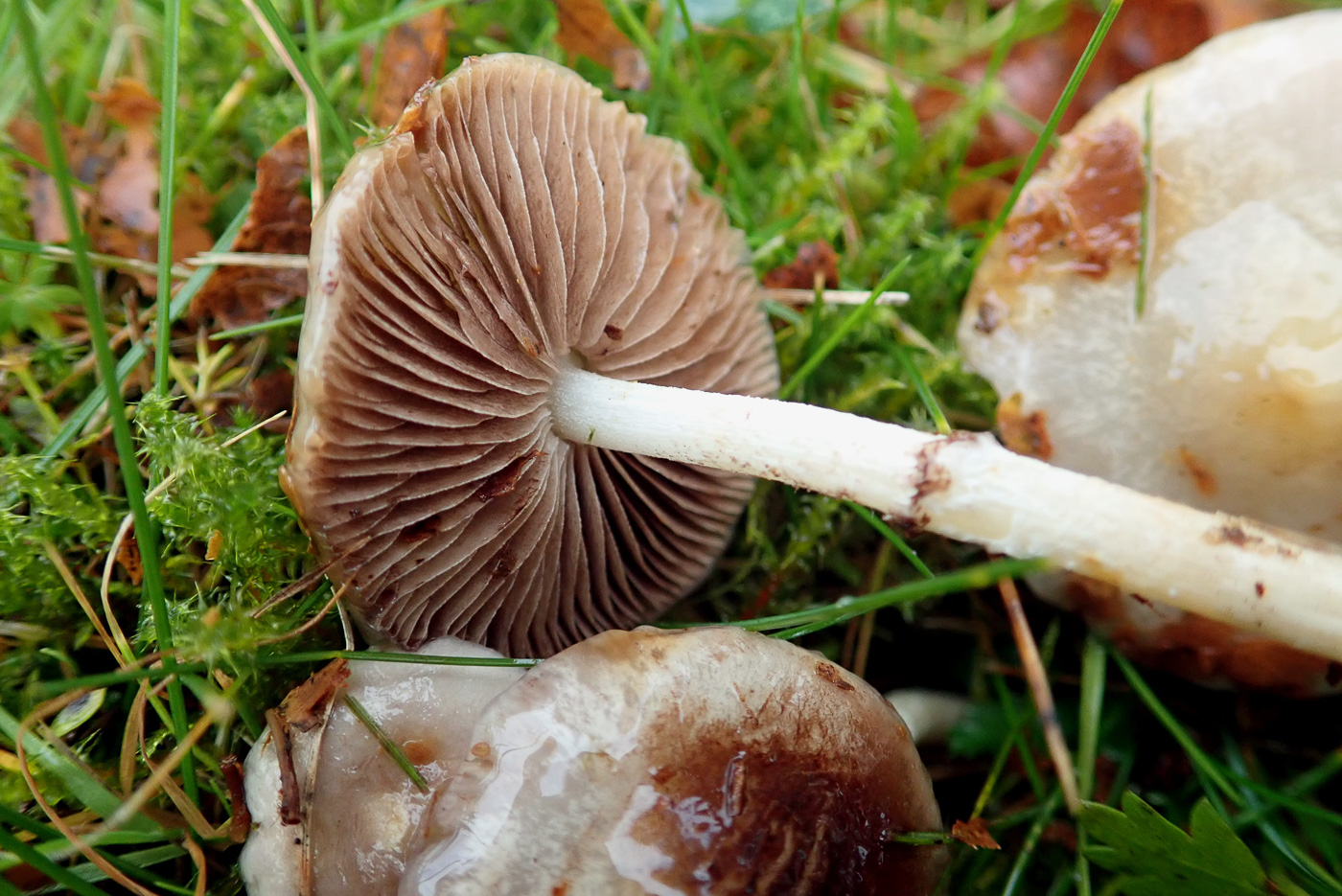
|
Stropharia inuncta (Smoky Roundhead) Oct 15, 2024. At Stampwell Farm in a grassy area Jackie Ewan noticed this rather innocuous-looking collection. This is a species which can confuse and is very different from the distinctively coloured blue-green grassland Roundheads. Its viscid surface, gills which eventually darken as the spores mature, and stem with a somewhat ephemeral ring - seen in the RH specimens here - are all good pointers to recognise in the field, though it is less common than the blue-green members of the genus. Oct 23, 2022. In Granborough churchyard Jesper Launder found this singleton in a grassy area. For this genus it is a somewhat small and dull-coloured species - several are brightly coloured - and for that reason it often evades recognition in the field, but it has the typical slimy cap and grey gills with a ring on the stem. Oct 27, 2020. In Fingest Churchyard Penny C. found this quite unusual Stropharia, one which lacks the beautiful blue-green colours of the closely related S. caerulea (see photo dated Oct 14) which was also in the churchyard today but so faded after rain that it was almost as dull grey as our S. inuncta. The species is recognised by its sticky grey cap which is slightly darker and browner in the raised centre, the gills start out pale but end up dark brown like the spores, the stem is white and smooth apart from the distinct membranous ascending ring which becomes coloured as the spores drop and adhere to it. Photos 2 and 3 show these features quite well. |
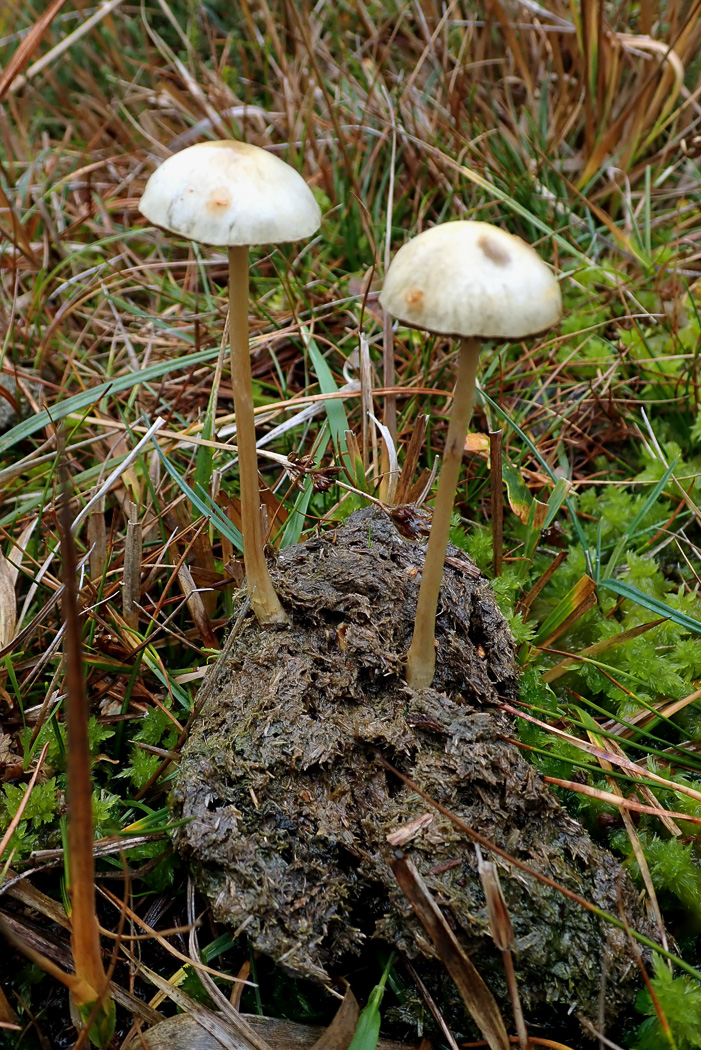
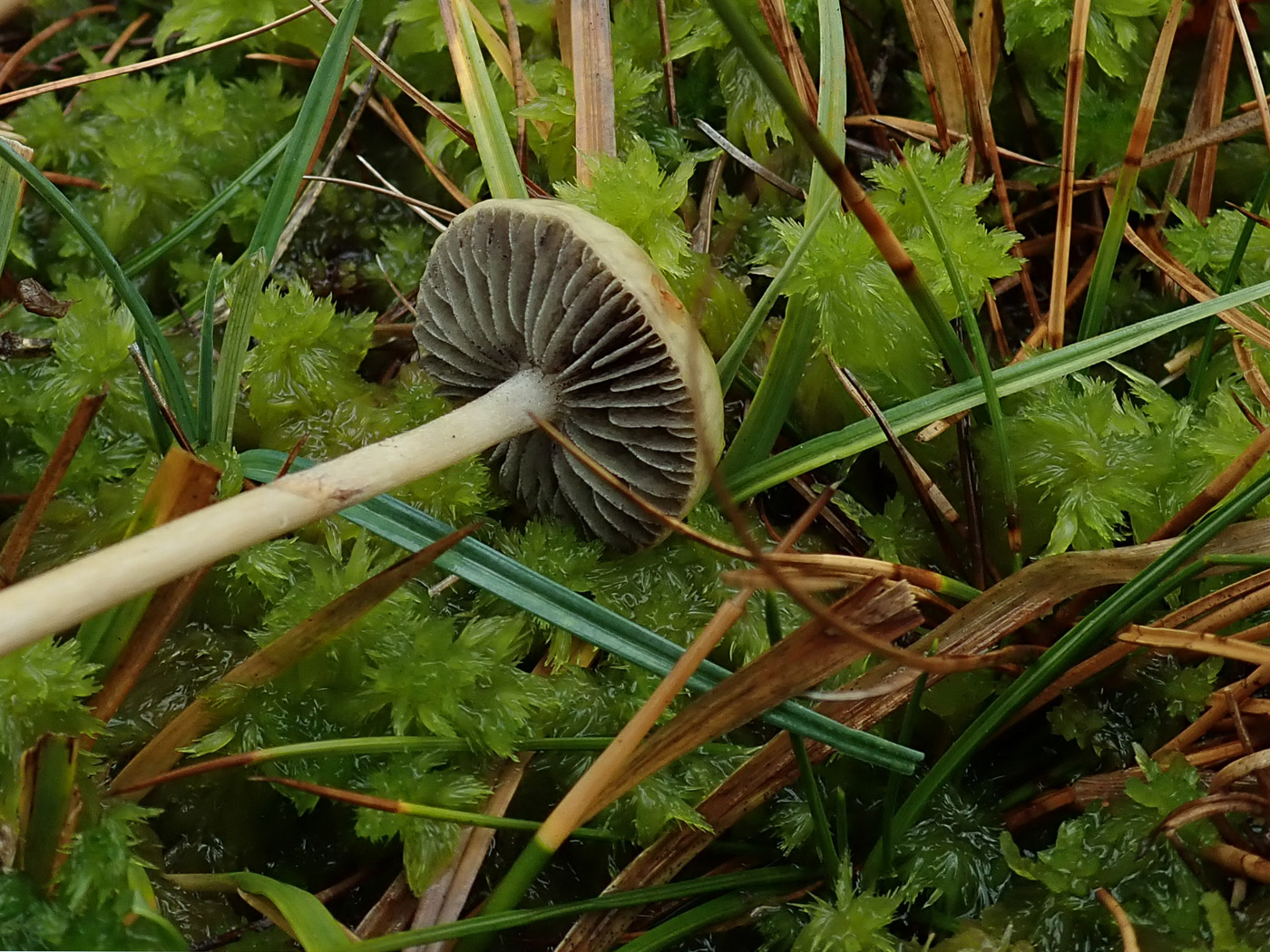 |
Stropharia semiglobata (Dung Roundhead) Nov 3, 2020. We have almost no dung fungi amongst our species list (there are many), but the cows had been busy in the Mire at Burnham Beeches where Penny C. found this common species - given its chosen substrate. Caps are pale, rounded and also sticky (as with most members of this genus), gills are grey and somewhat ventricose (convex) and stems are long in proportion to the cap and have a ring which cna quickly disappear, especially in wet weather. Not surprisingly, therefore, there's only the smallest hint of a ring zone visible in photo 2 here. |
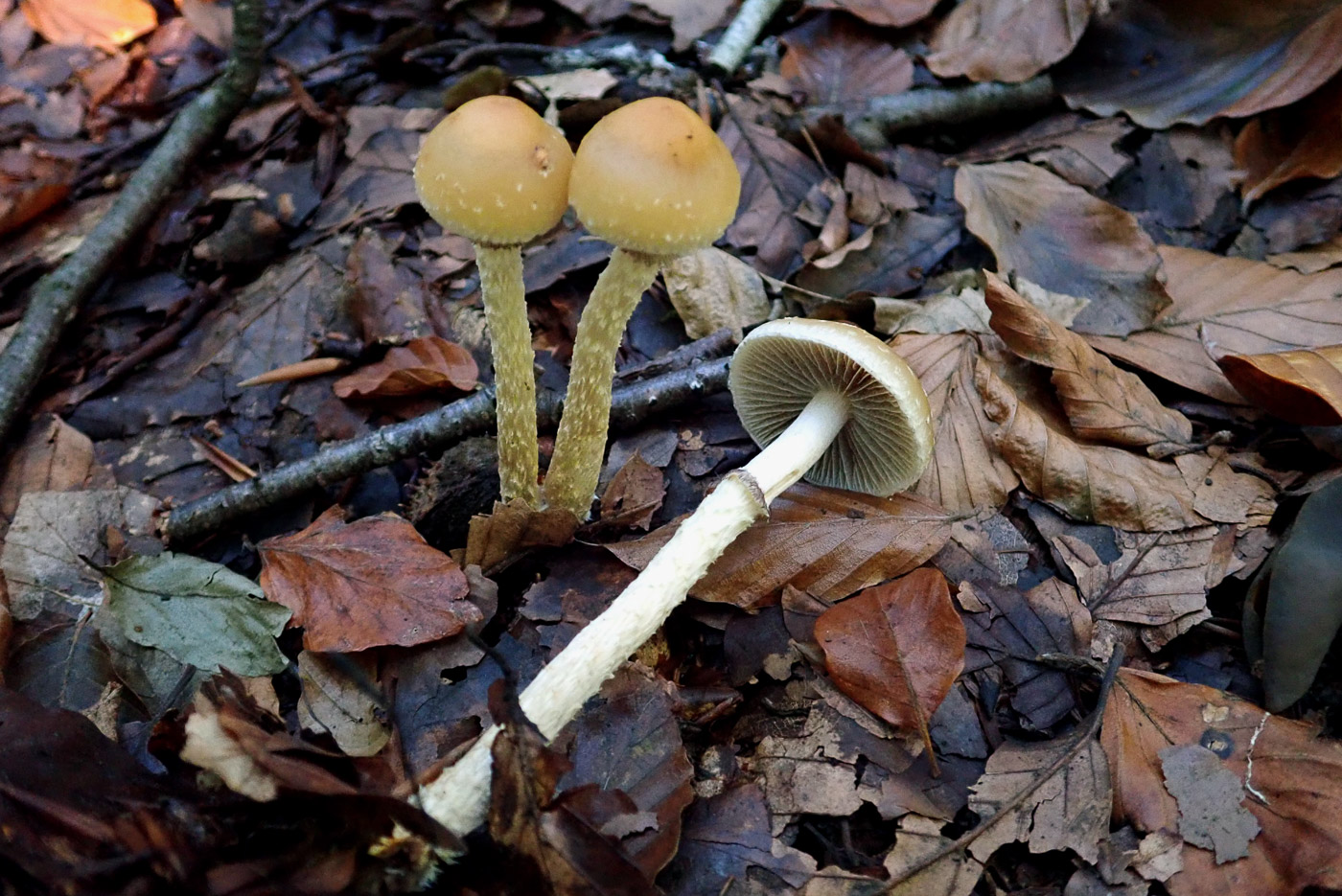
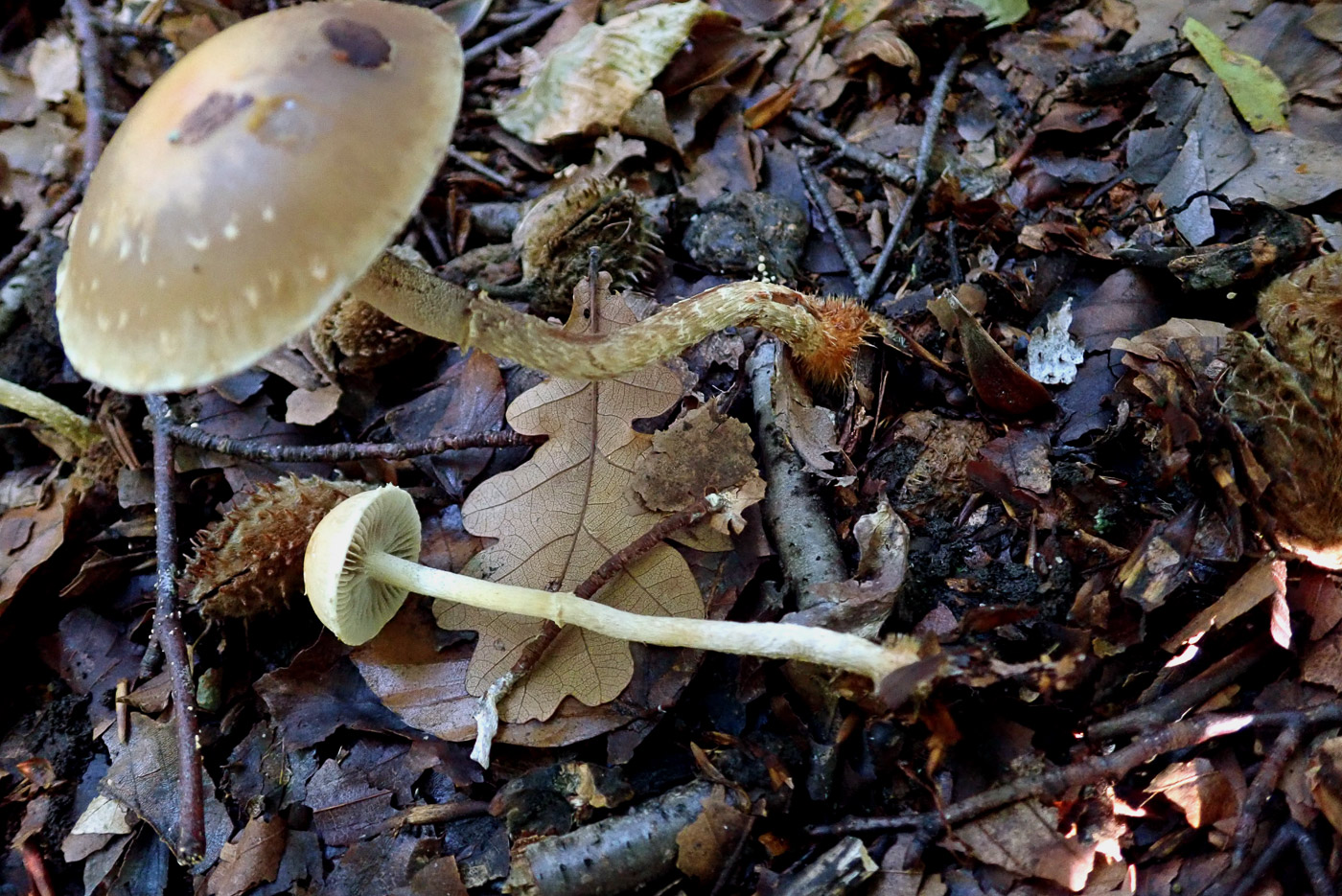
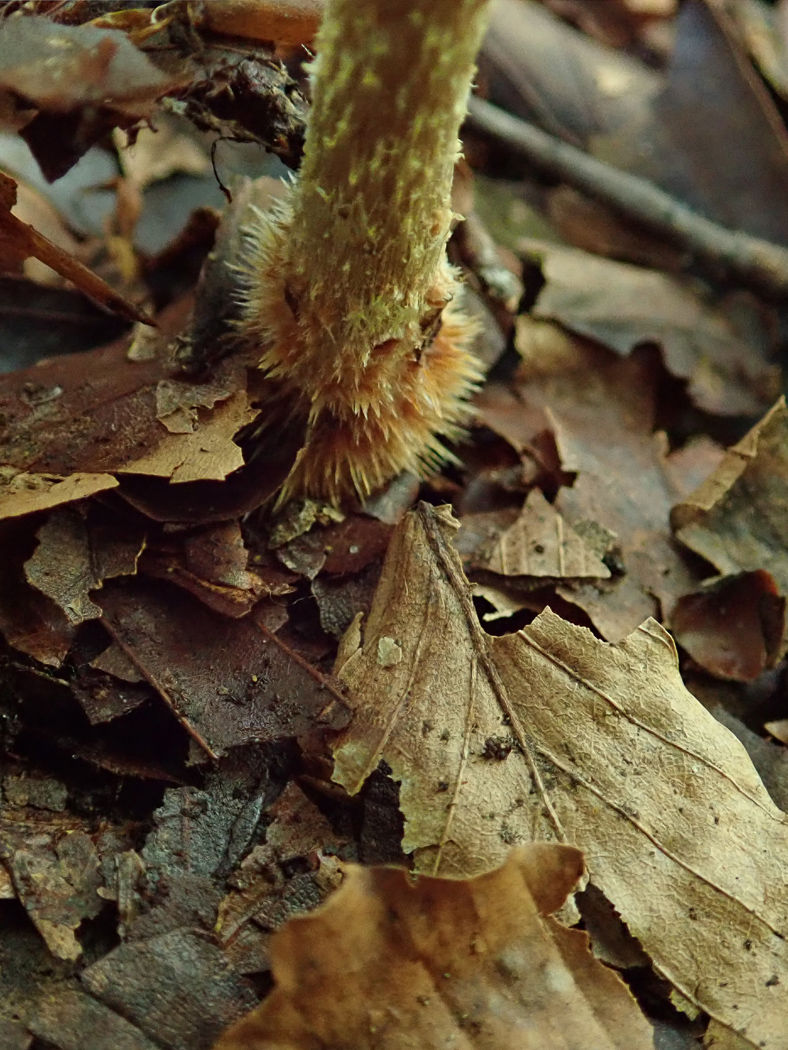 |
Stropharia ( / Leratiomyces) squamosa (Slender Roundhead) Oct 11, 2020. This species was found in two different locations in Beech litter in Pullingshill Wood by Penny Cullington. Not common but occasional, the rather nondescript cap colour of the species is possibly the least interesting aspect of the fungus, but note the white flecks of veil on the outer cap and the tall stem in proportion to the cap size (which is no more than 3 to 4 cm across) The stem has a ring which gradually becomes black as the dark spores drop onto it, and below this there are belts of flocculose white veil (seen best in the larger specimen in Photo 2) and at the stem base it becomes orange with fine mycelial hairs (seen in Photo 3). |
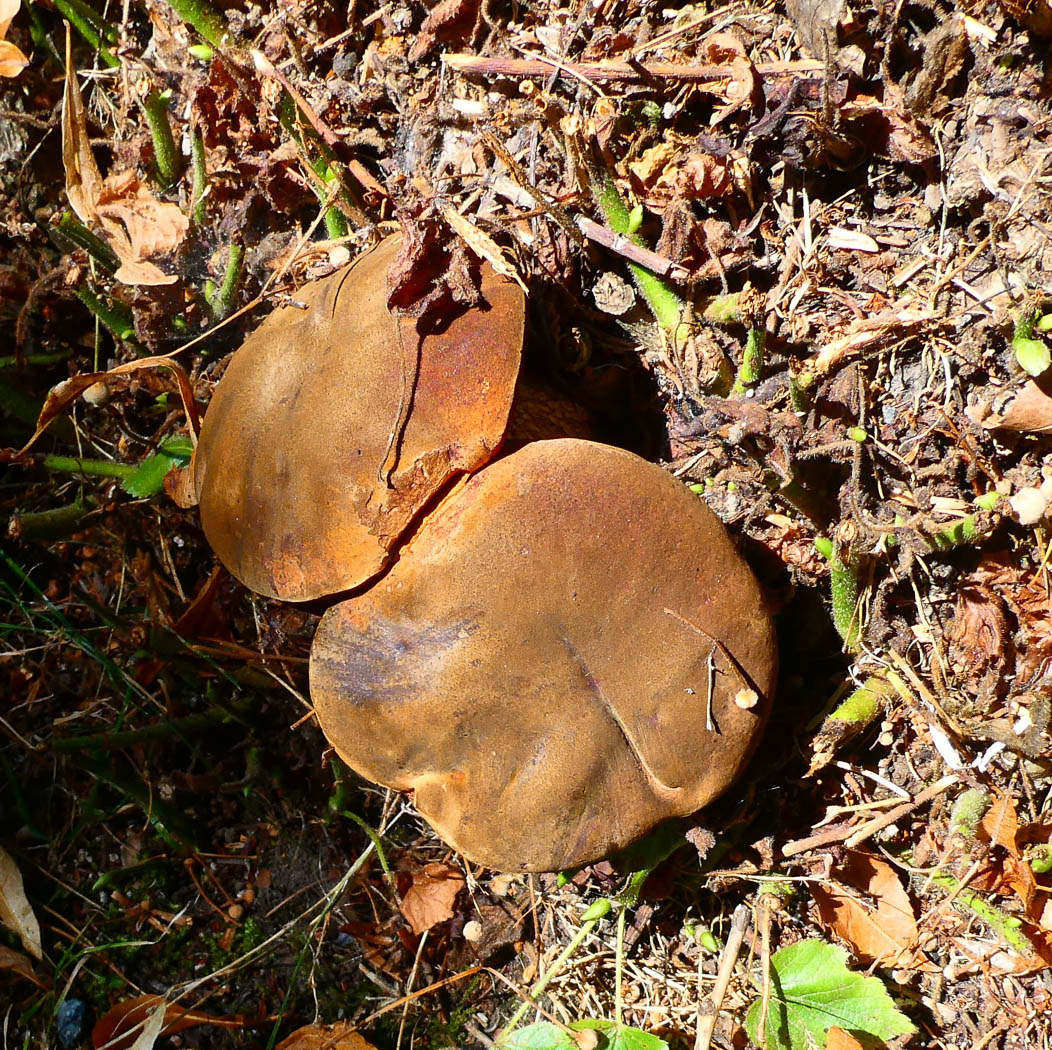
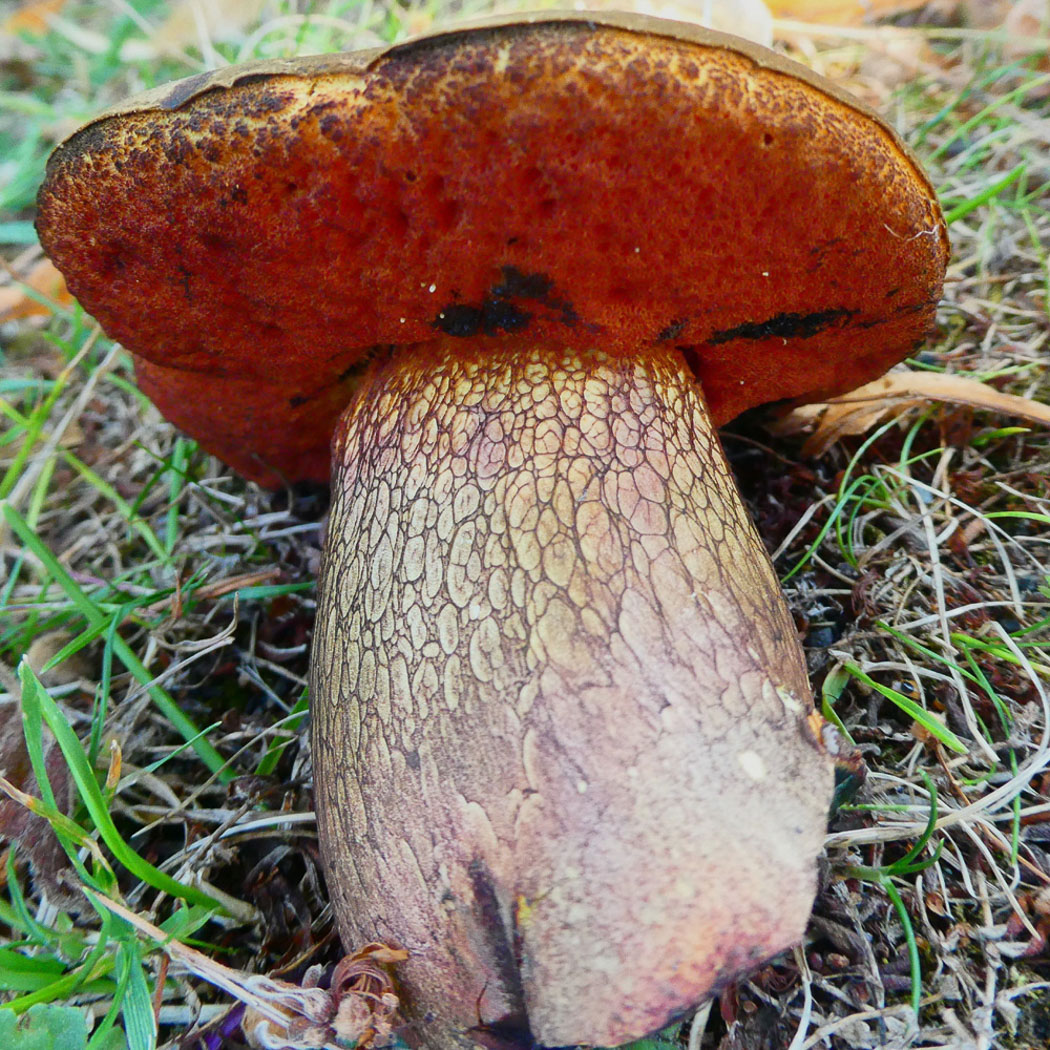
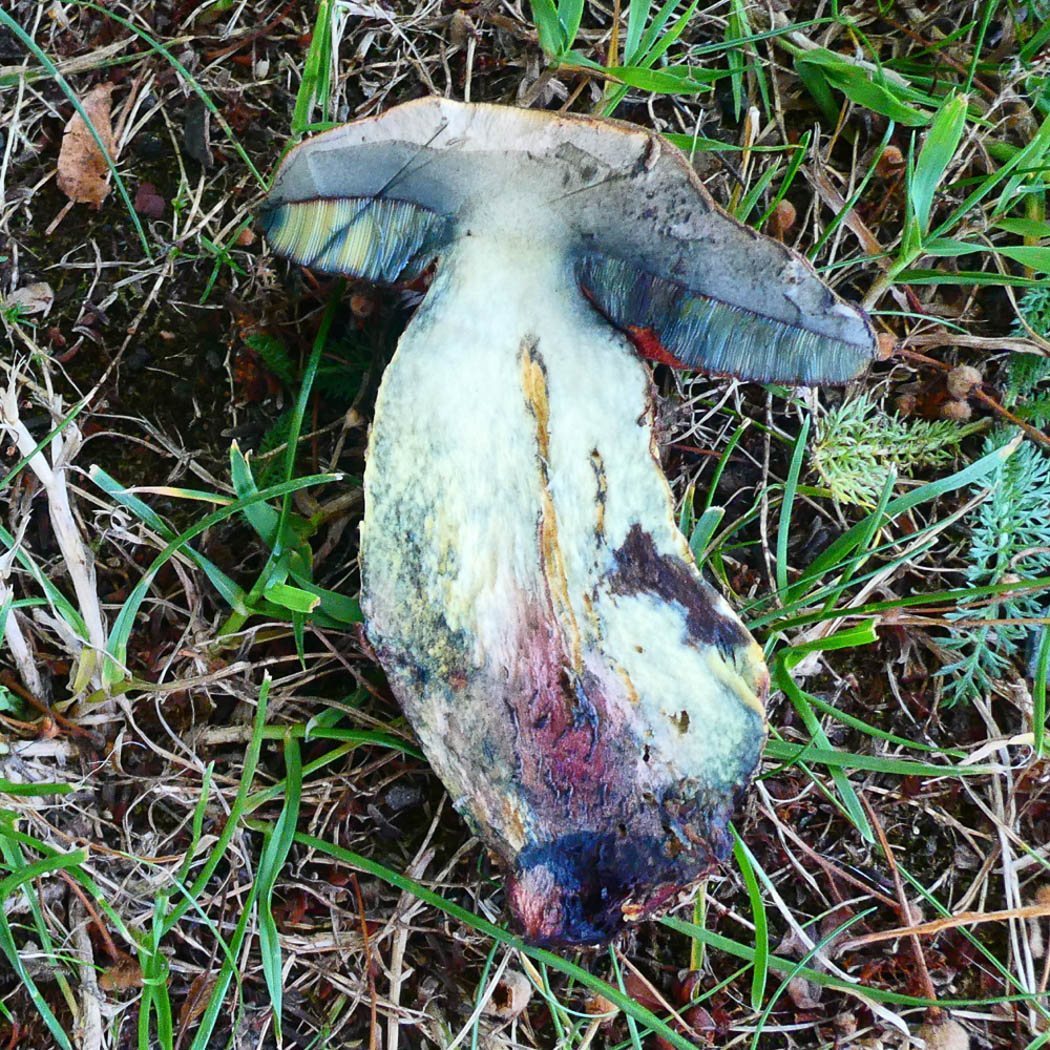
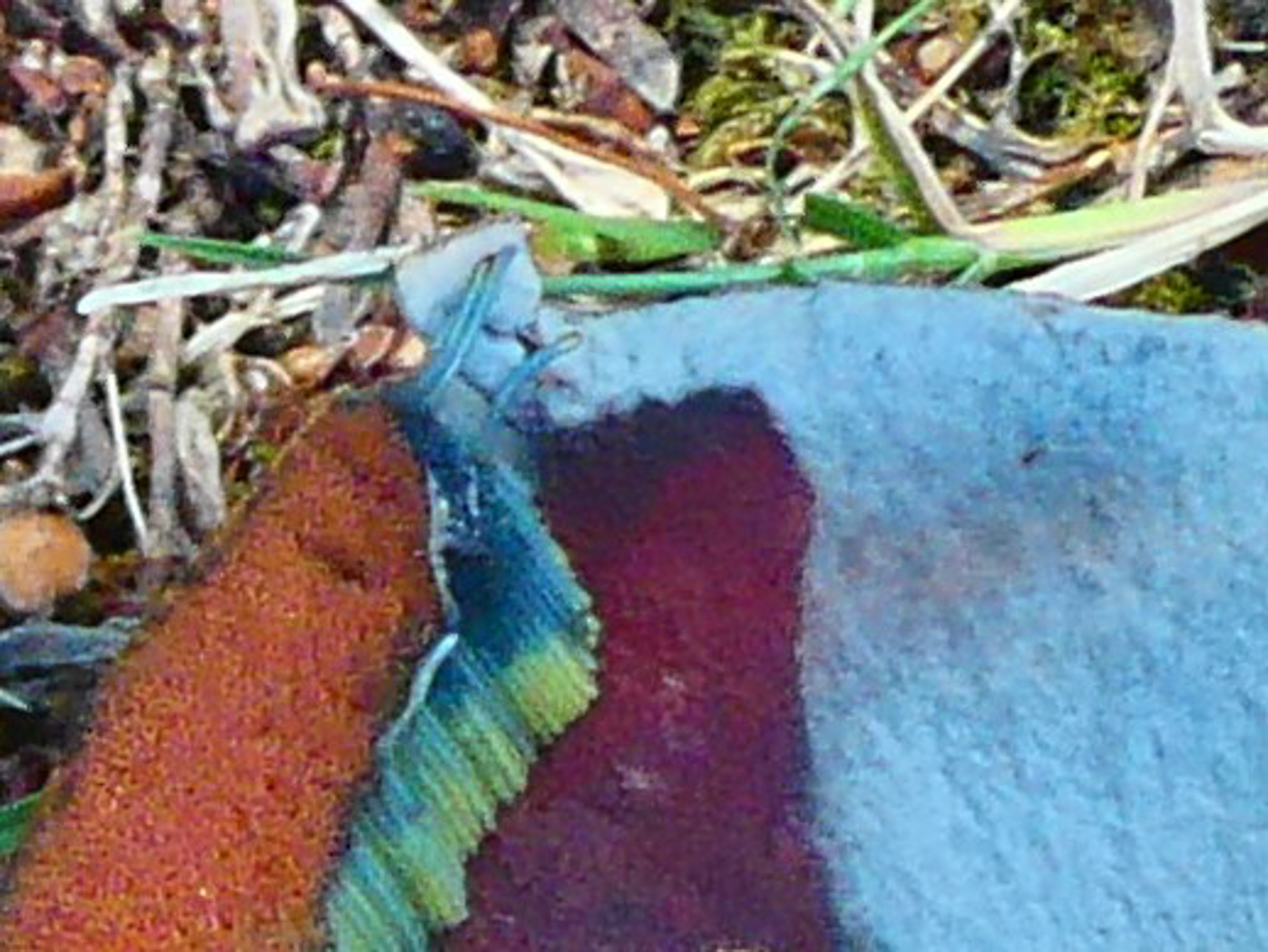 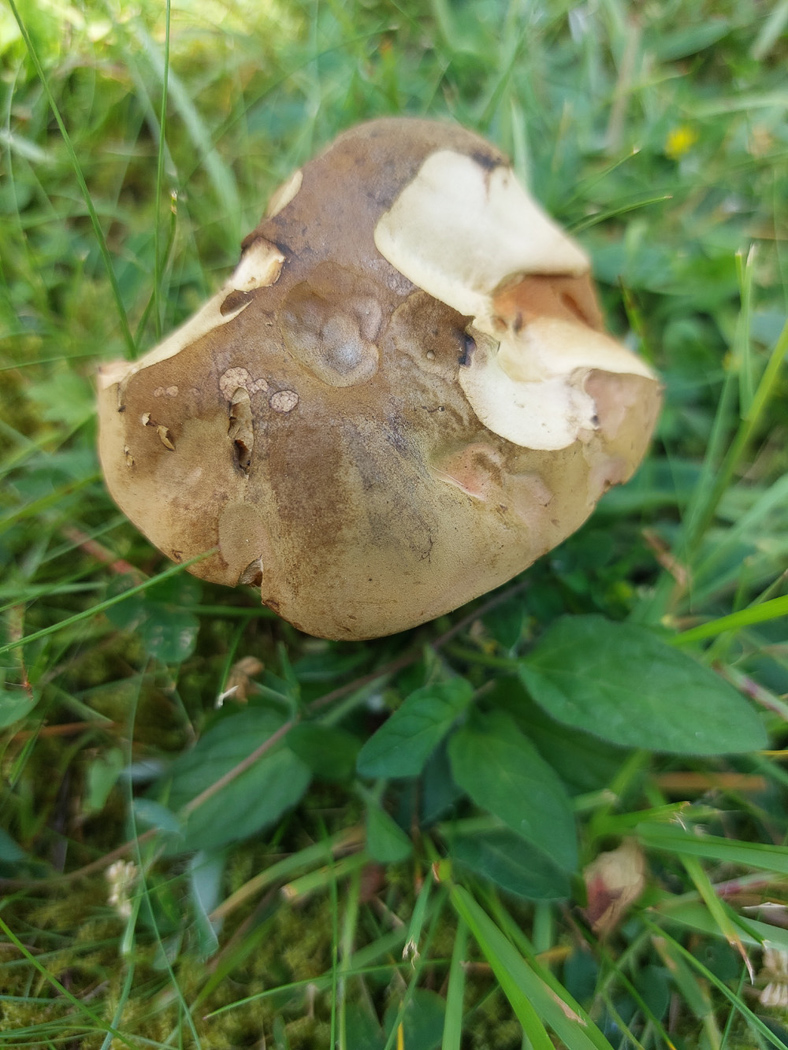
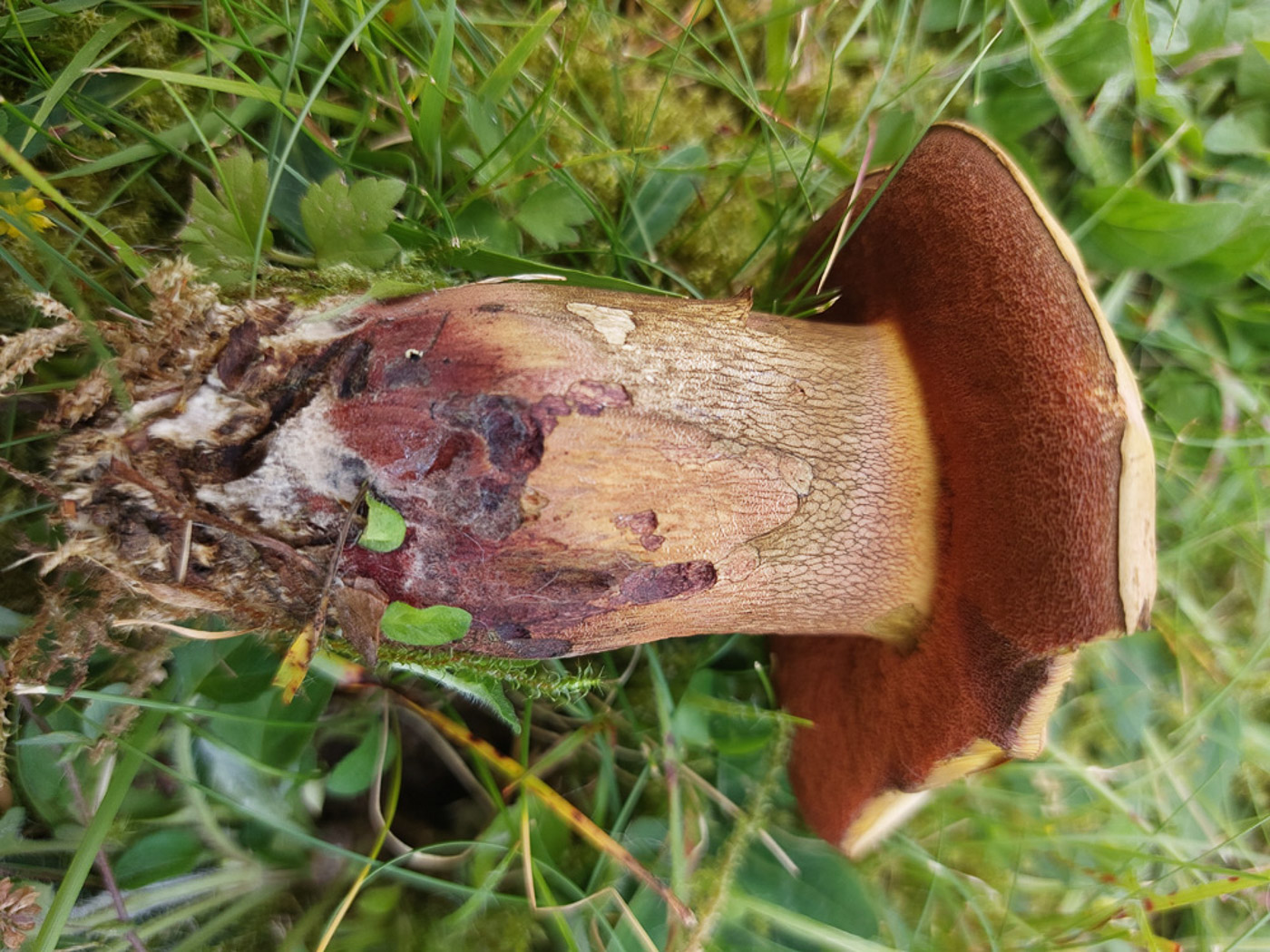
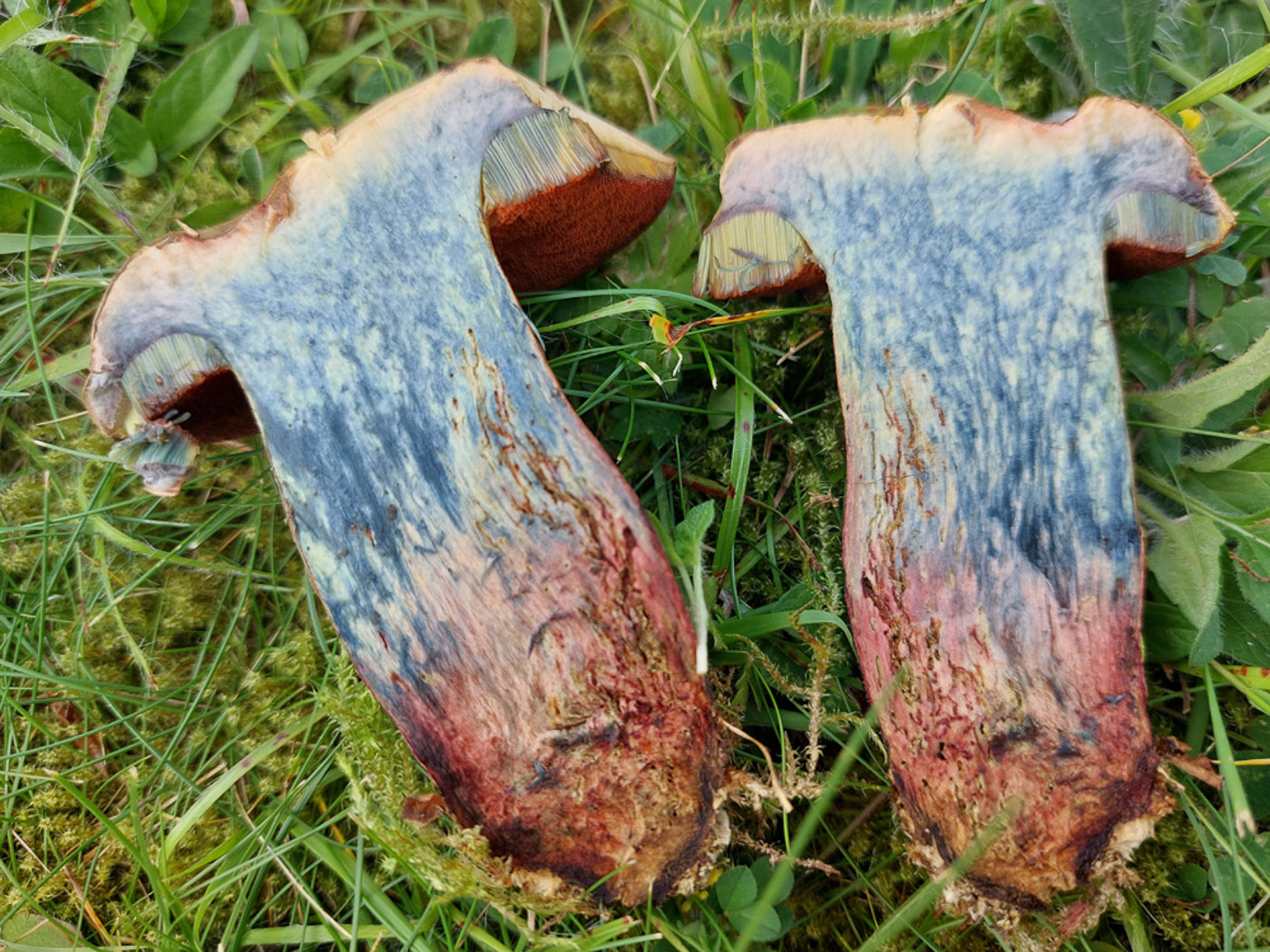 







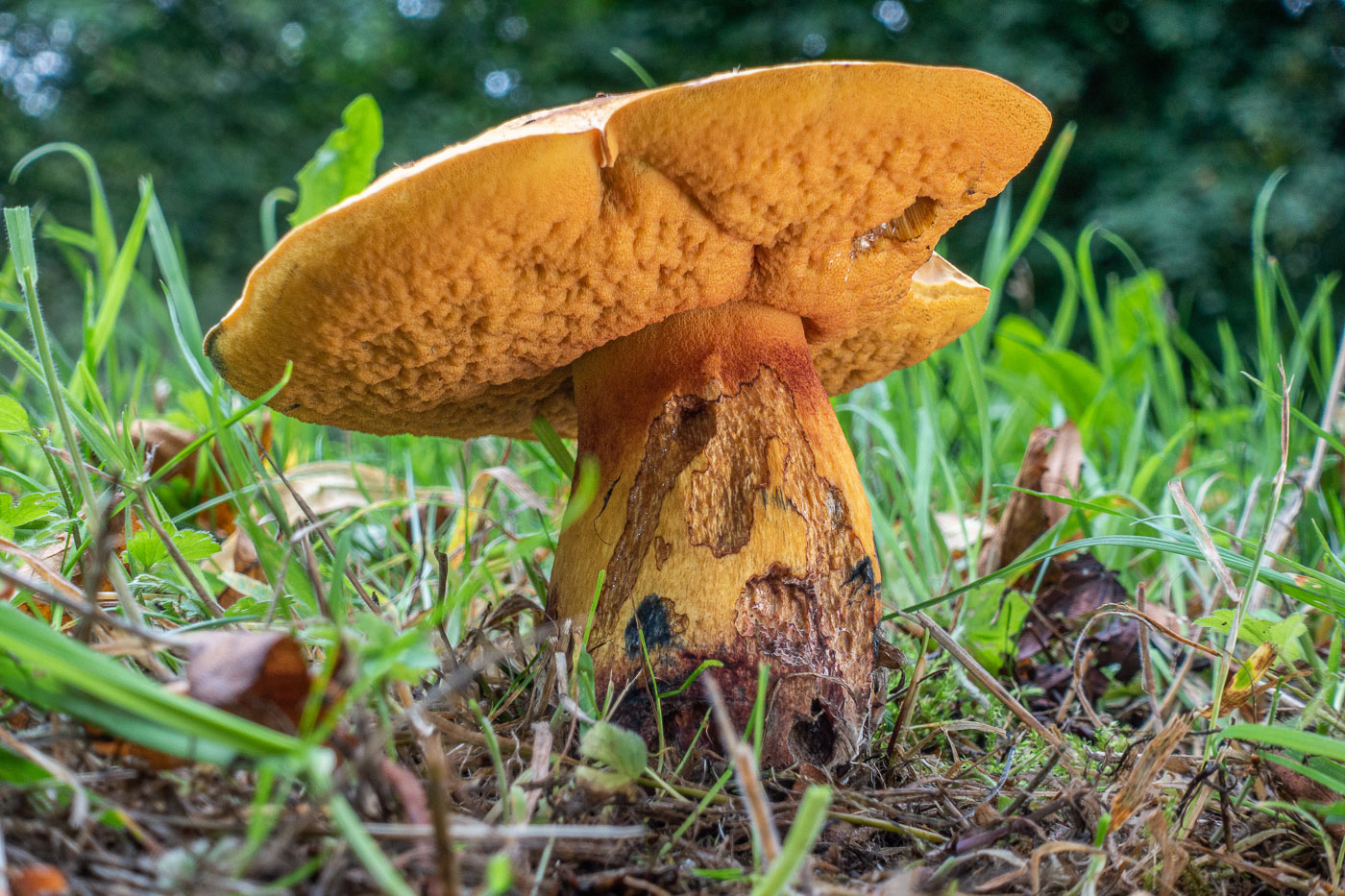
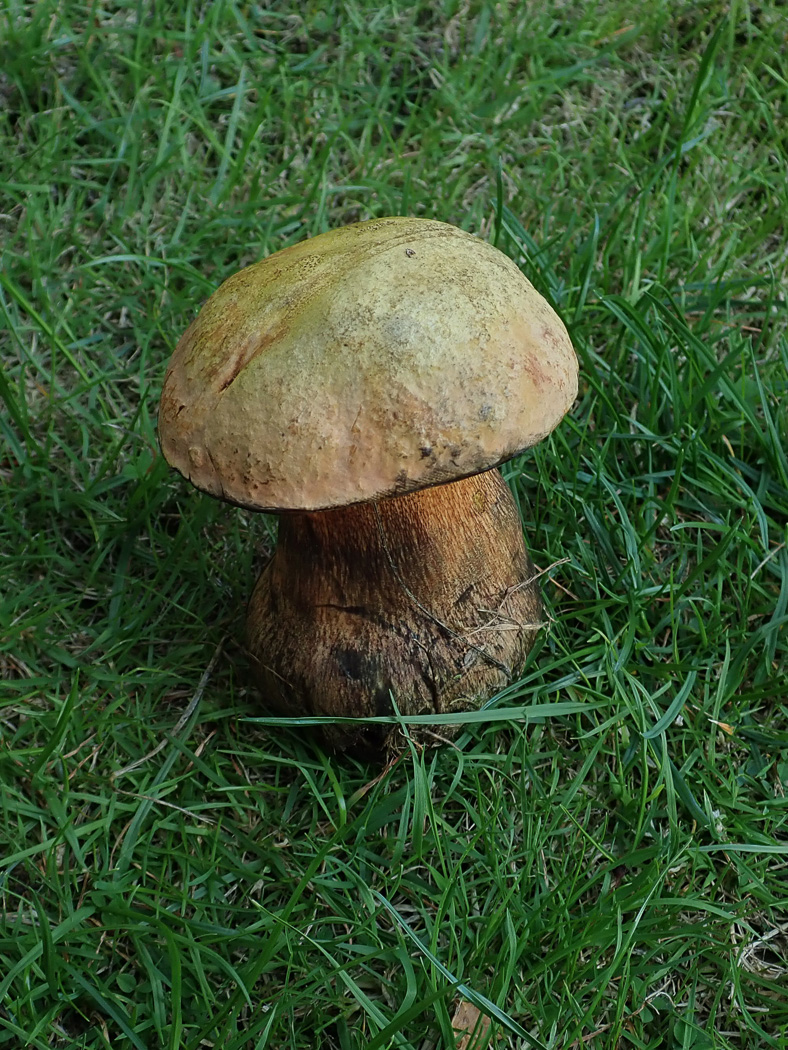
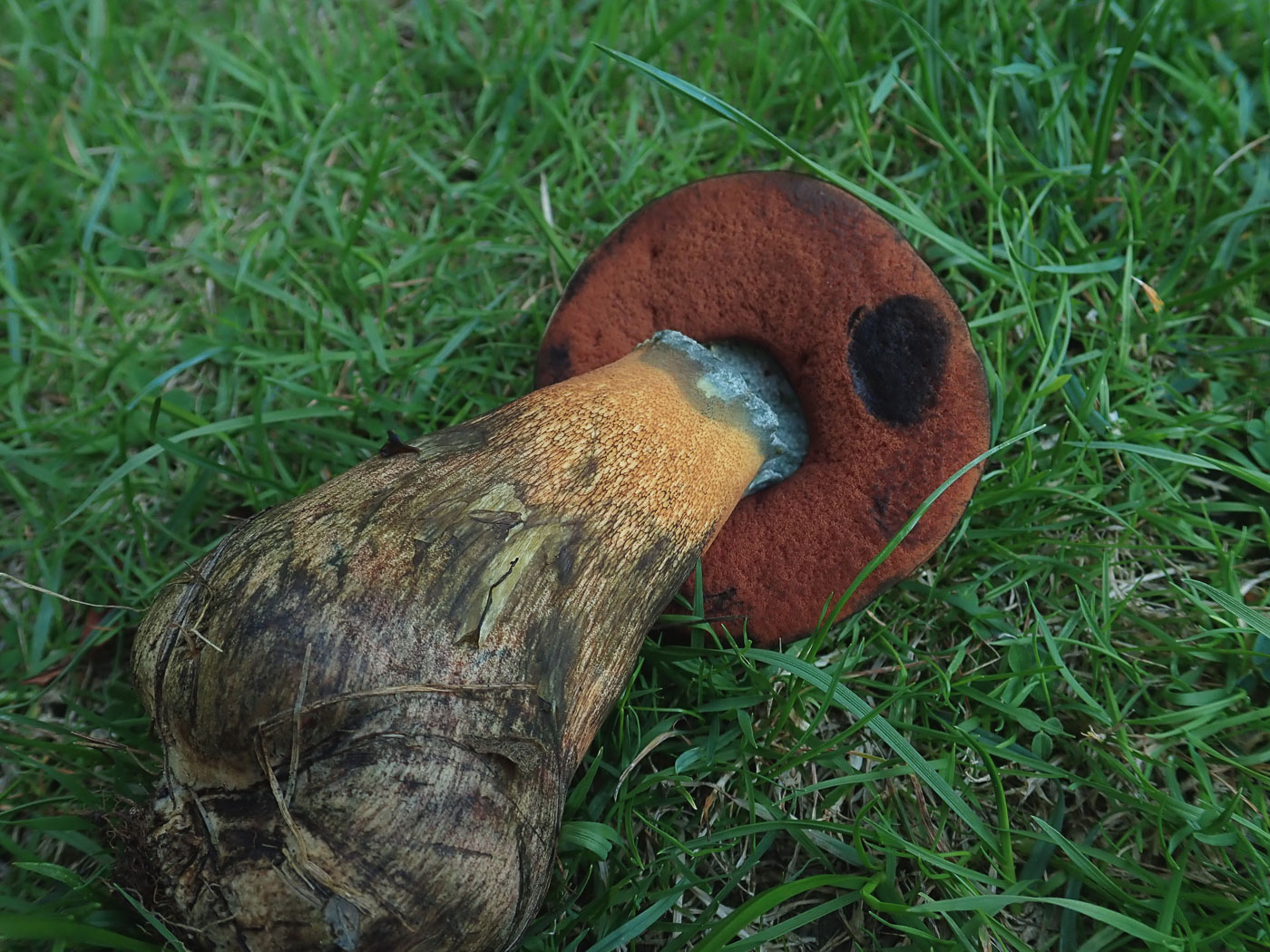
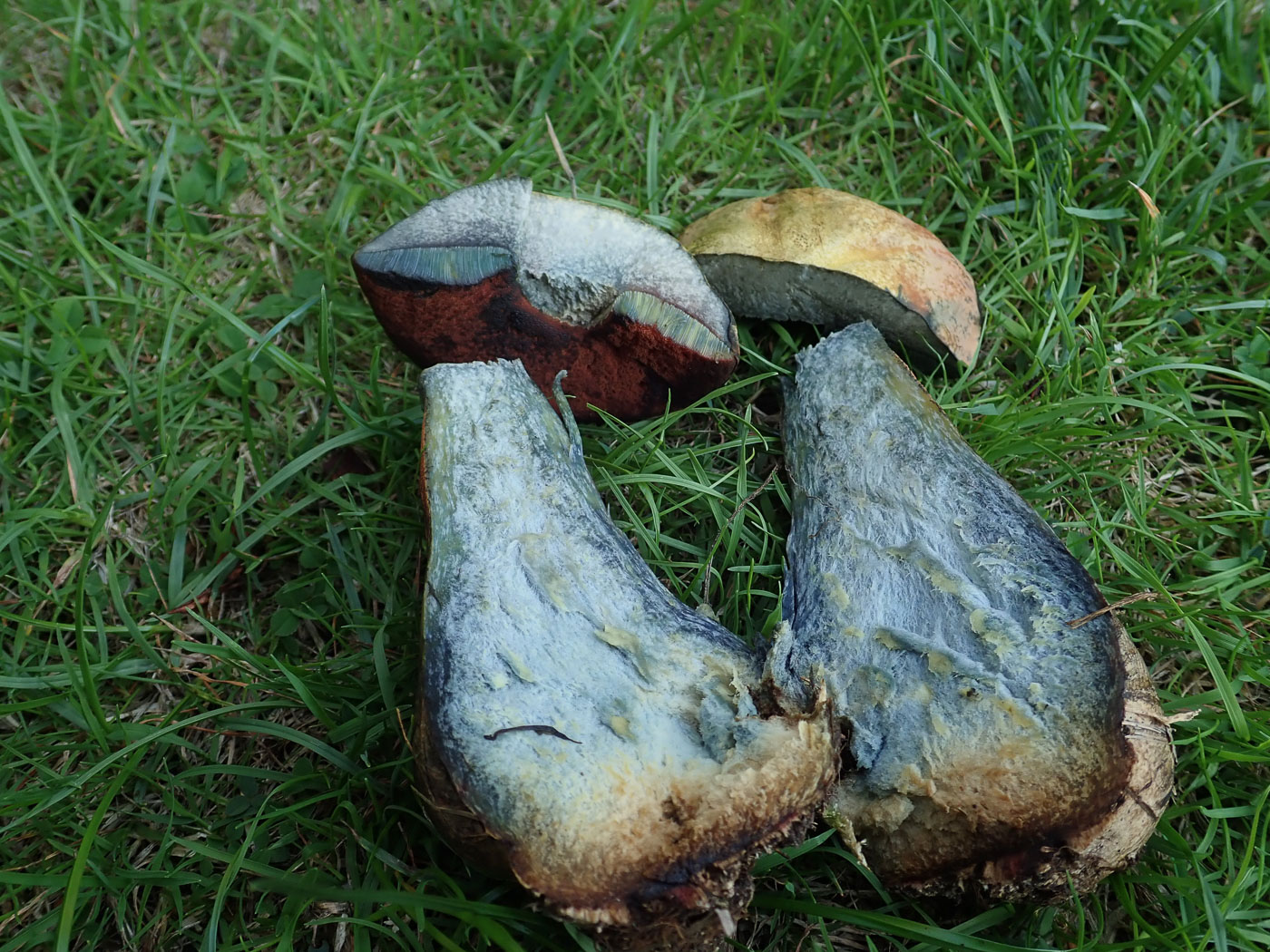
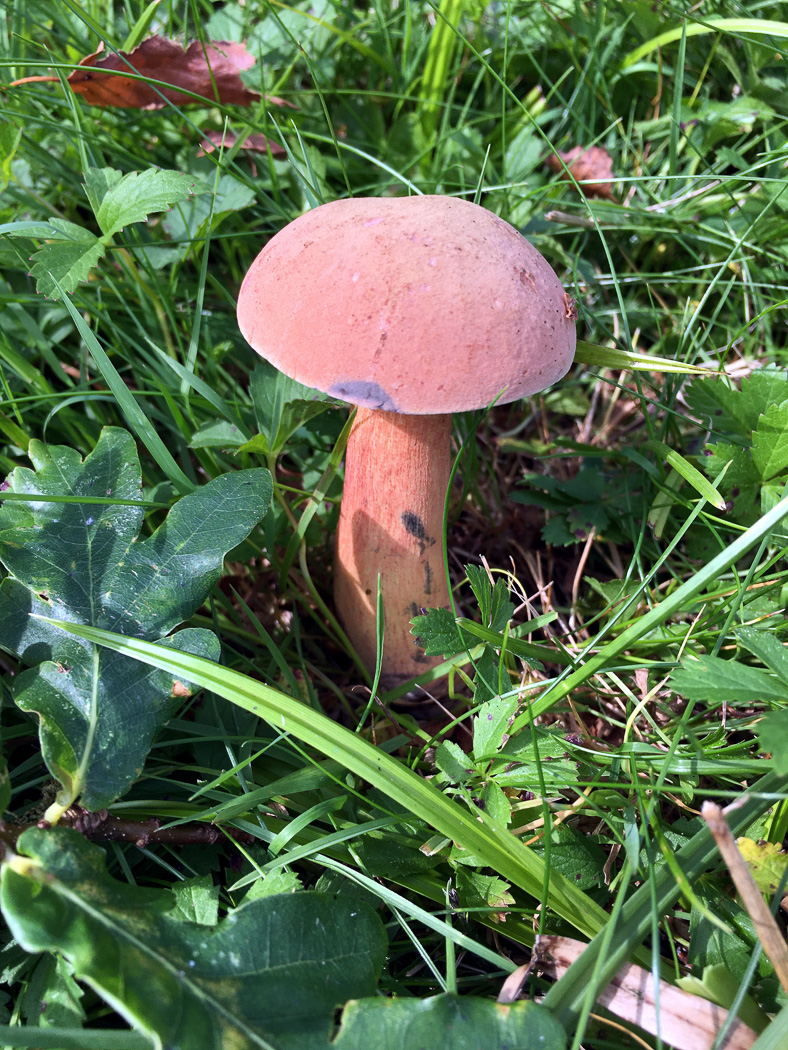
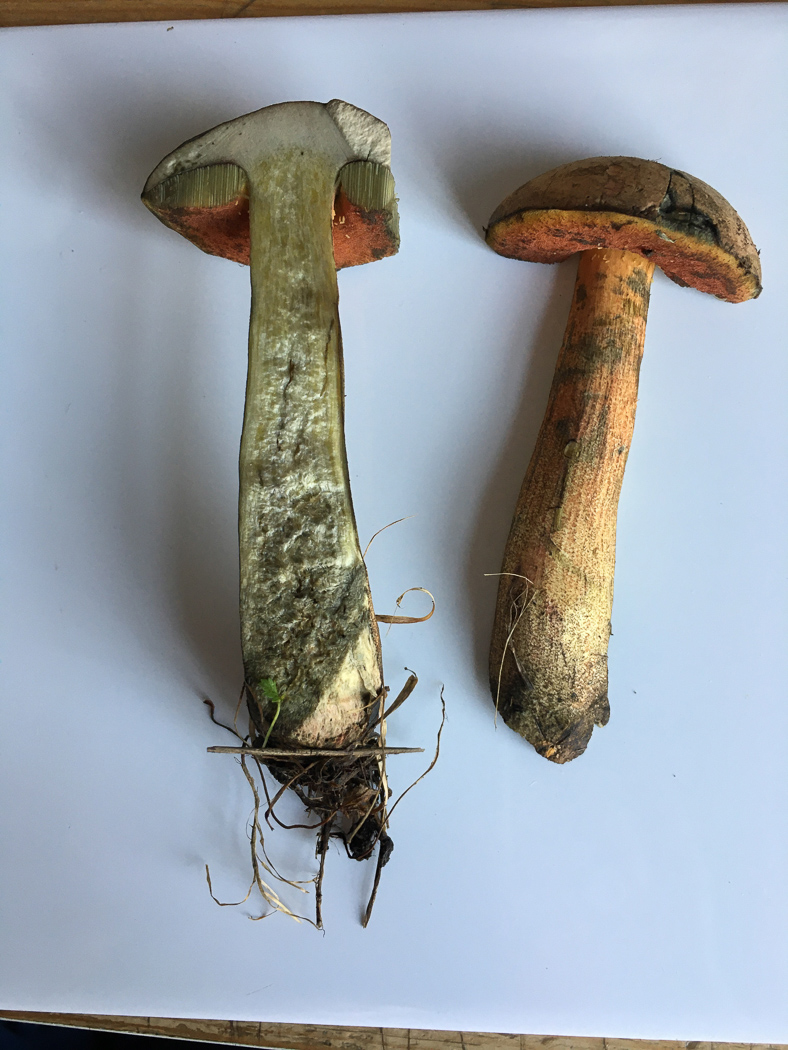
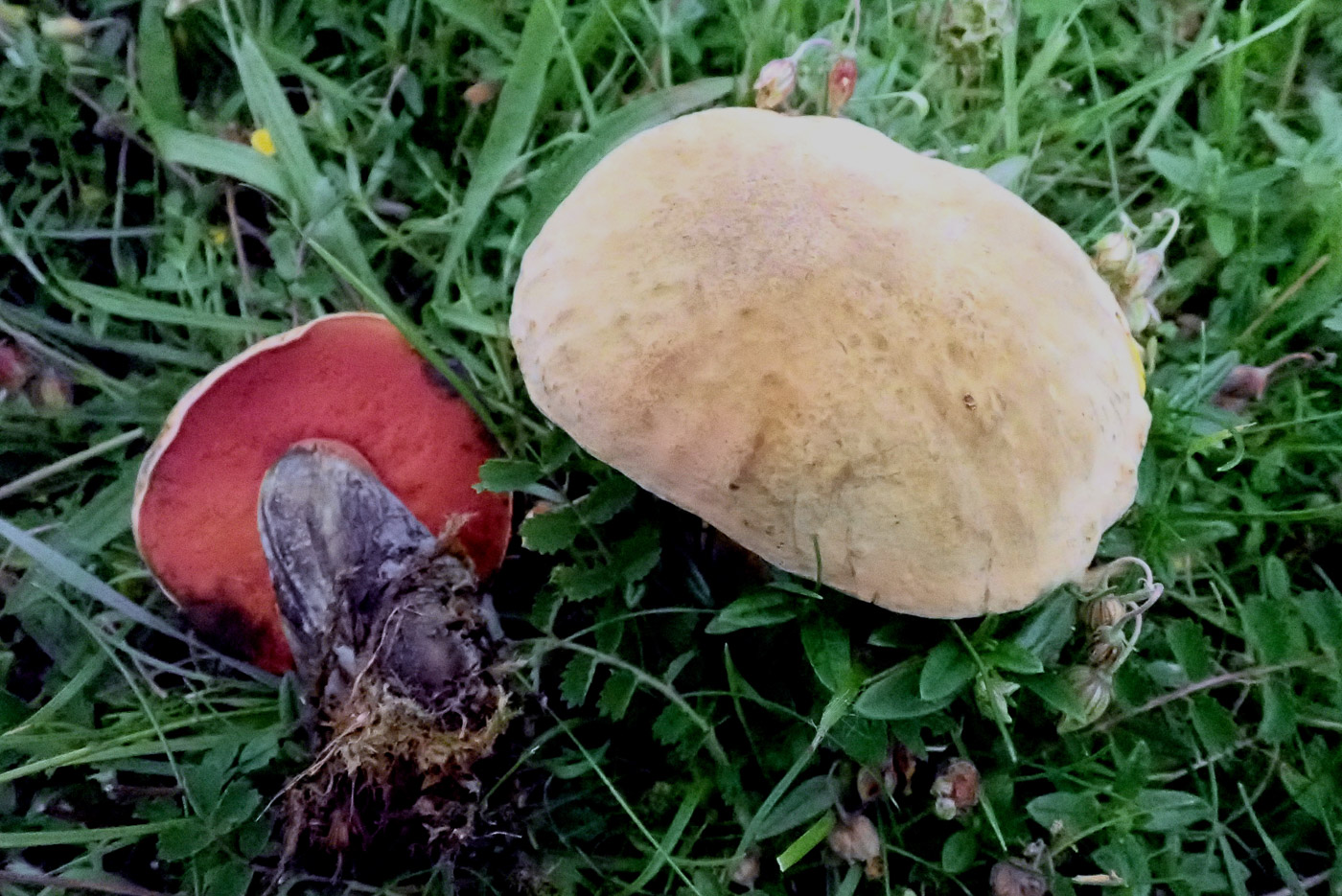
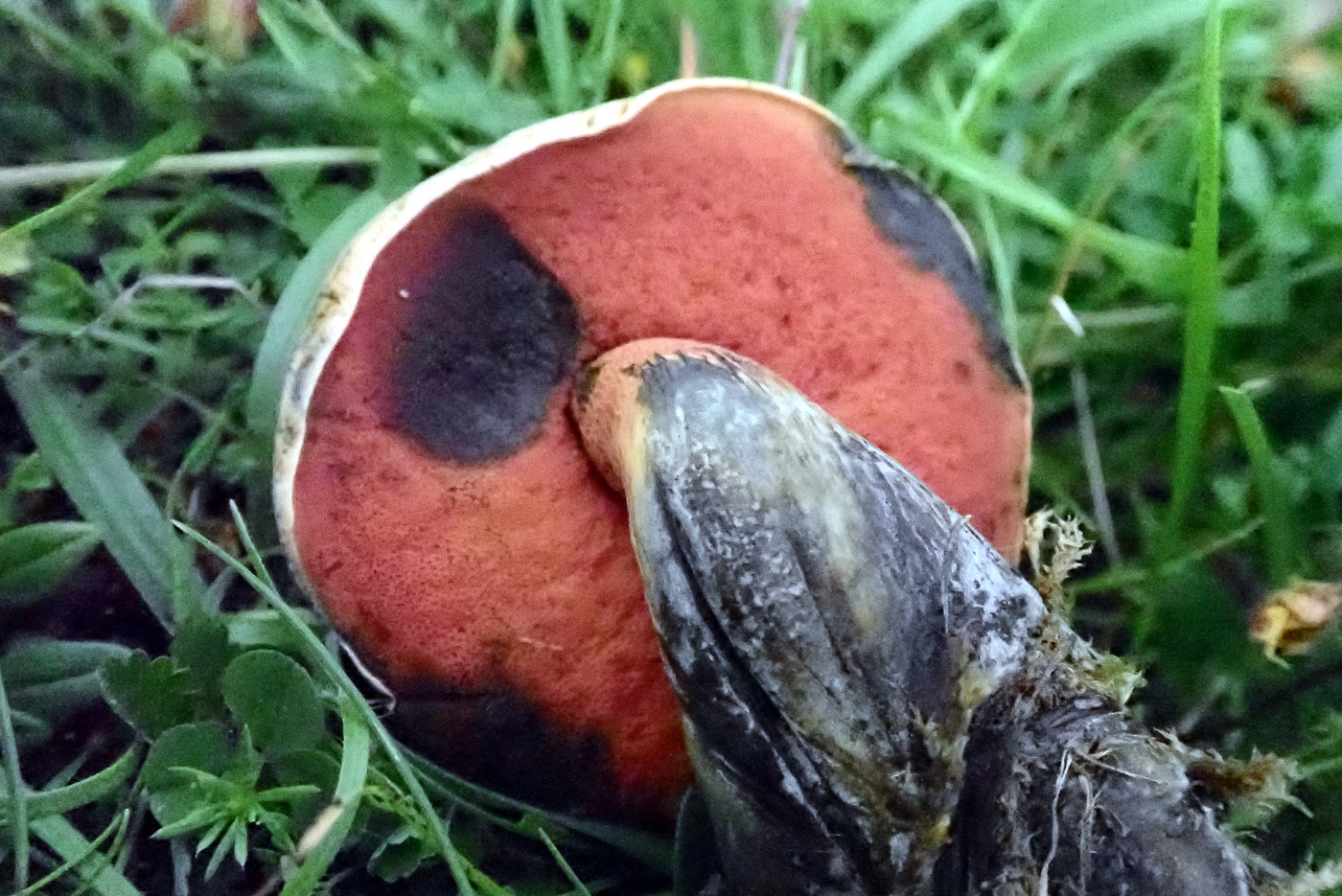
 |
Suillellus luridus (Lurid Bolete) Jul 30, 2024. In a roadside verge in Chalfont St. Peter Jim Wills came across a group of ten boletes fruiting in soil under Lime, his photo 1 is of a conjoined pair. The colour of the pores and bluing flesh when exposed to air quickly limited the possibilities so he took one home to work out which of the three likeliest candidates it was. The impressive and prominent network (see photo 2) covering the entire stem eliminated Neoboletus luridiformis (Scarletina Bolete) - by far the commonest of our red-pored boletes, and also pointed to S. luridiformis rather than S. queletii (Deceiving Bolete) - another contender which also has a network but it is less well defined and tends to be only in the lower stem. Jim placed a drop of Melzer's reagent on the lower stem flesh (see photo 3) which turned deep blue further confirming it was one of these two species (N. luridiformis flesh turns dirty brown ie a negative reaction). Both species are positive with Melzers and have some beetroot red colour in the lower stem flesh but this is much more marked in B. queletii which furthermore has an abruptly tapering and rooting stem base - not seen here. B. queletii is the rarer of the two species but was much in evidence last summer in our area. So both are well worth looking out for now. Incidentally, photo 4 is a good example of how to separate the genus Xerocomellus from other bolete genera: when the tubes (under the cap flesh) are pulled apart the individual tubes remain intact in all boletes except Xerocomellus where they rupture. Jun 7, 2024. Under Birch along a roadside verge in Beaconsfield Jesper Launder spotted this Bolete, and upon examining it was not surprised to find it was this species - one which he's noticed tends to fruit earlier than others belonging the Bolete genera. All the distinguishing features of the species are visible here: palish cap, pores with an orange tinge, stem with a clear network and beetroot red flesh at the base, flesh quickly blueing above this when exposed to air. The species seems to be becoming more common; it occurs in mixed broadleaf woodland and also with Helianthemum (Rock Rose) where no trees are present. Jul 19, 2023. In Kings Wood, Tylers Green, Penny spotted this immature Bolete under Beech and on collection (photo 2) the red pores and strong blueing on the stem became apparent. On cutting (photo 3) the blueing of the flesh was less instant, also less intense than one would expect for Neoboletus luridiformis (Scarletina Bolete - by far the commonest species with these striking features) and this together with the cap colour - somewhat pale for that species - suggested this was more likely to be the much less common S. luridus. (Both species were until quite recently in genus Boletus.) On checking at home the clear brown reticulation (mesh) visible on the upper stem (photo 4) confirmed her identification - N. luridiformis lacks a reticulation on the upper stem but instead has tiny red 'floccules' (dots) on a yellow background. Photos 5 and 6 are also Penny's of a mature collection found at Marlow Common also under Beech two days later. May 21, 2023. In Seer Green under Birch and Willow Jesper Launder found this substantial Bolete, one with several revealing features including orange pores, a network on the stem and distinct blueing in the flesh when exposed to the air (photo 2). Previously in genus Boletus, it is not one of our commonest species though Boletes tend to fruit early in the season but not as early as this! See the Masterlist for other examples. Sep 13, 2022. In Turville Heath in the avenue of Limes Rob Corran found this unusual bolete (previously in genus Boletus) - one that Penny's not found here though she visits quite regularly. The species has similarities with the much more common Neoboletus luridiformis (Scarletina Bolete) - hence its Latin species name (though Penny hears rumours this is about to change!) but the pores are more orange than red and the cap colour, though very variable, is generally paler. If in doubt, a drop of Melzers Iodine on the stem flesh turn blue-black in today's species but remains brown in N. luridiformis. Many of our records for S. luridus are with Helianthemum where it is sometimes fruits in abundance wherever that plant grows. In such habitat it is easy to identify with no likely lookalikes to confuse, but when in deciduous woodland more care is needed. In fact Penny's husband Paul brought back a sample collected with Helianthemum the following day, hence the additional photos 2-4 which show more features. Sep 6, 2021. In Wotton Park Estate Joanna Dodsworth found another singleton Bolete in grassy soil under Oak. Also previously in the genus Boletus, the species is less common than C. radicans above and very different in appearance. A smaller species though still solid, the cap colour is somewhat variable from yellow ochre to peach or reddish to olive brown and the pores are orange red, often more yellow around the rim (seen in photo 2) and strongly blueing when damaged. The stem flesh also tends to blue but can be bright beetroot at the base. It occurs in open deciduous woodland and also quite commonly with Helianthemum (Rock Rose) wherever that plant abounds (see also dated Jul 13 for an example with Rock Rose). Jul 13, 2021. Prompted by husband Paul who reported dozens of fruit bodies of this species growing with the Helianthemum in Aston Rowant Reserve (Oxfordshire, however), Penny visited Coombe Hill - another good Helianthemum site but in Bucks - and was suitably rewarded with our first Bolete of the season. The species is similar to Scarletina Bolete (Neoboletus luridiformis) in having red pores and flesh staining strongly blue and can also be found, as that species, in deciduous woodland, but together with Rooting Bolete (Caloboletus radicans) it has a clear affinity with Helianthemum in open grassland as indeed do many other fungi from a variety of mycorrhizal genera. This seems to be our first July record with this host but Penny suspects that it is not unusual for it to be fruiting this early as we have records as early as June when found in woodland. Photo 2 shows the instant blueing on the pores when pressed with a finger. Sep 2, 2020. More familiar as Boletus luridus, this species is appearing in remarkably large numbers at the moment. It is normally a woodland species but here was fruiting with Helianthemum (Rock Rose) at Coombe Hill, found by Penny Cullington. It can be seen fruiting in hundreds at present with Rock Rose at both Watlington Hill and Beacon Hill, Aston Rowant Nature Reserve, so well worth looking out for in this specialised habitat now. |
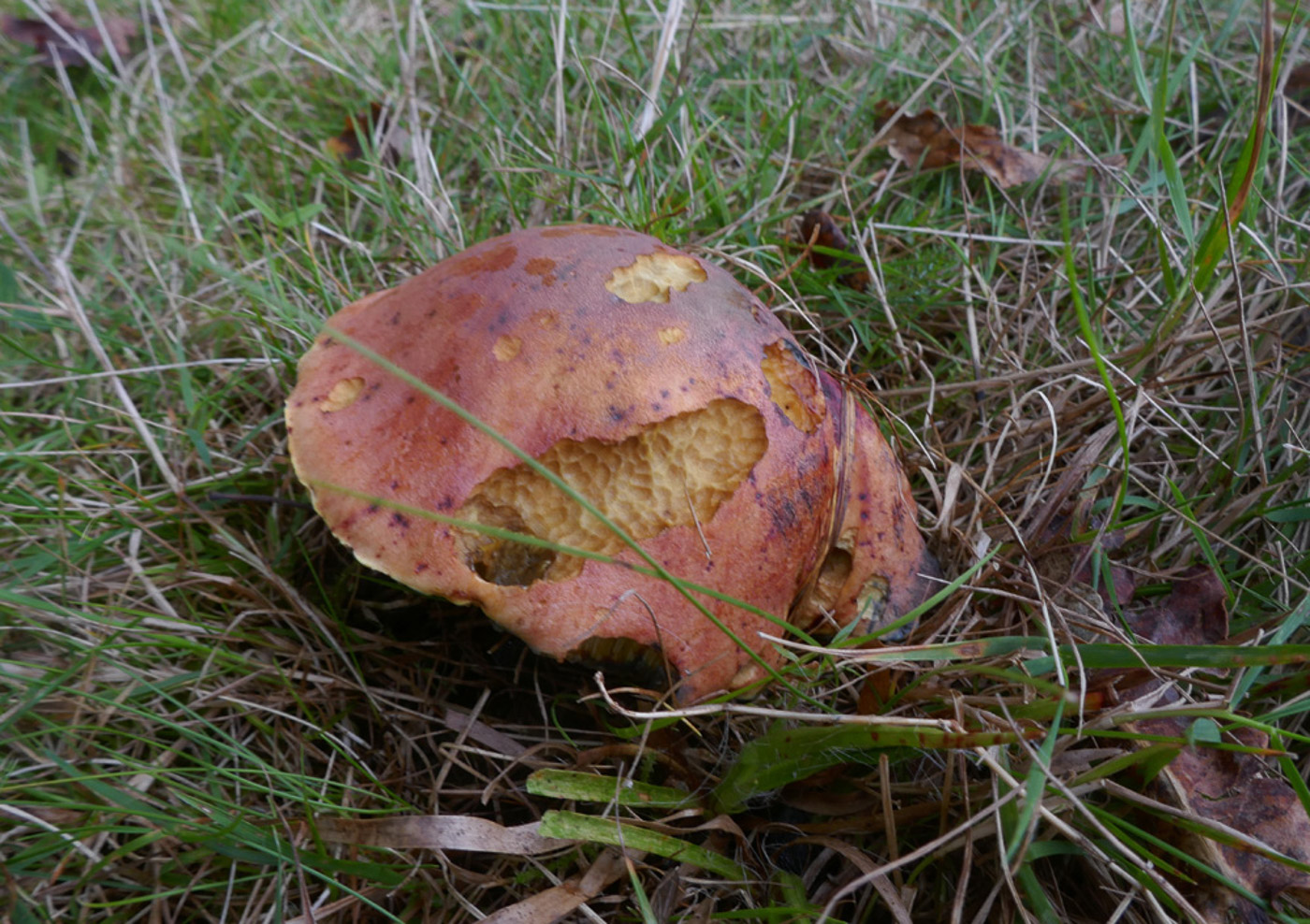
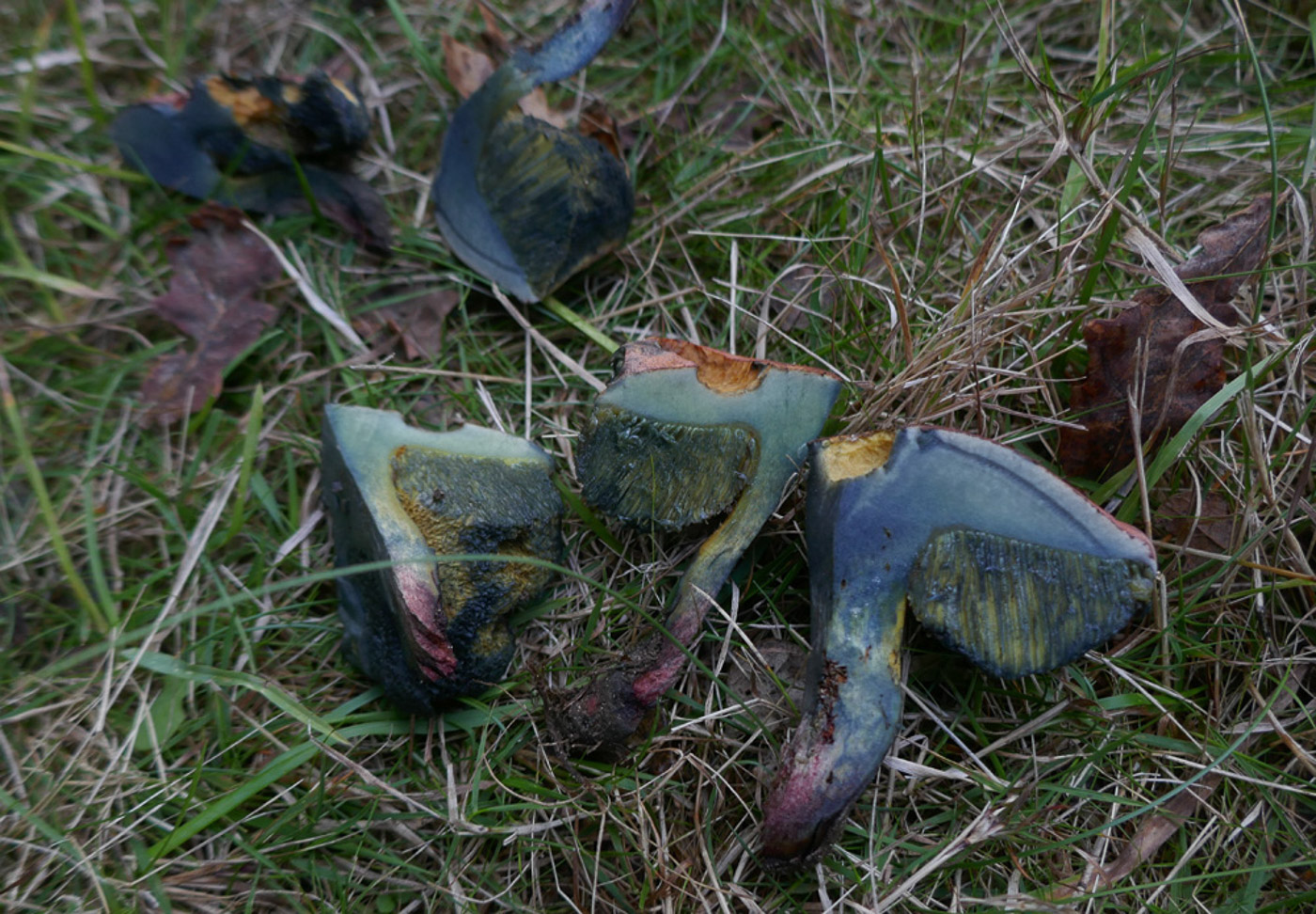 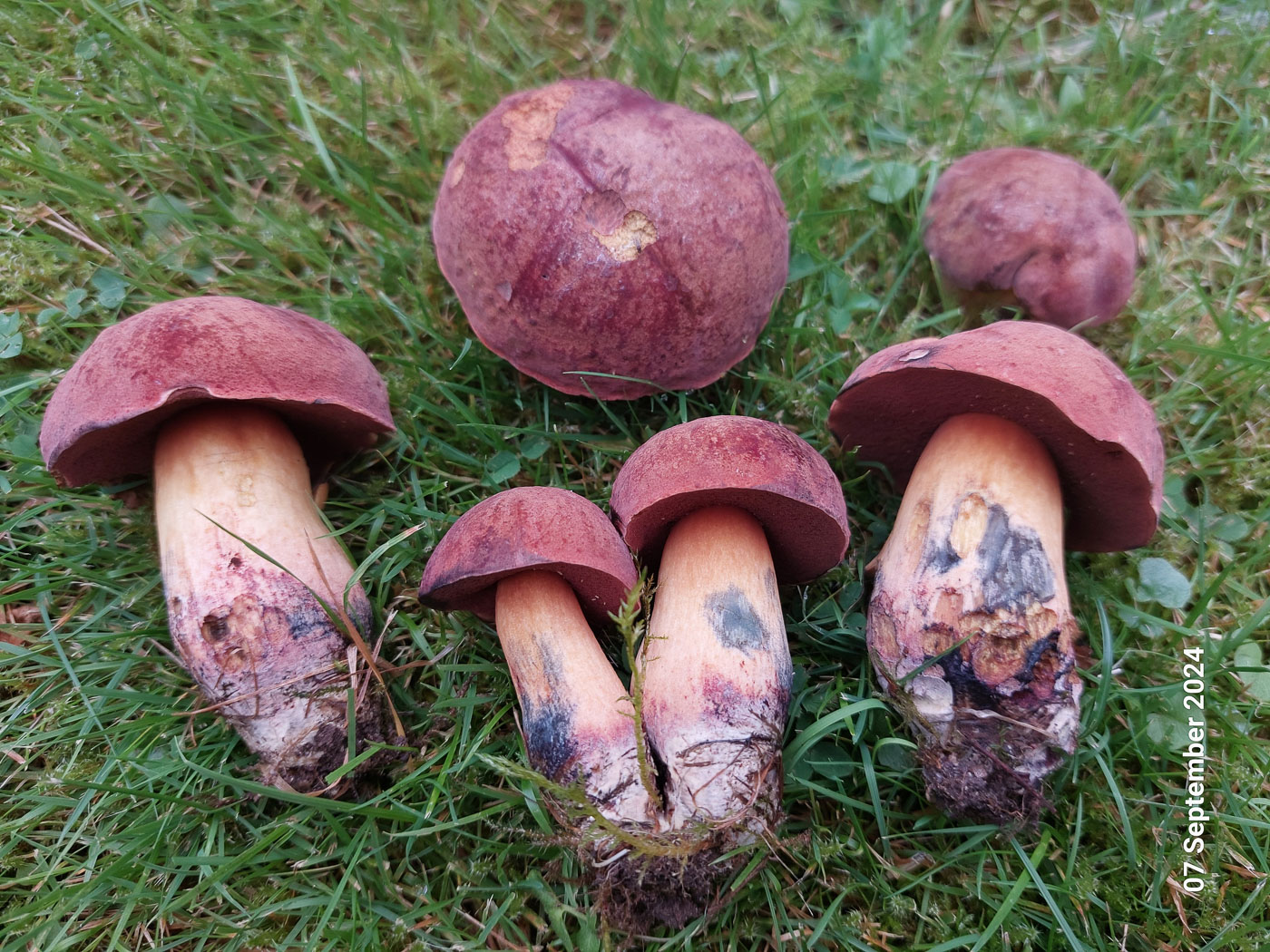 




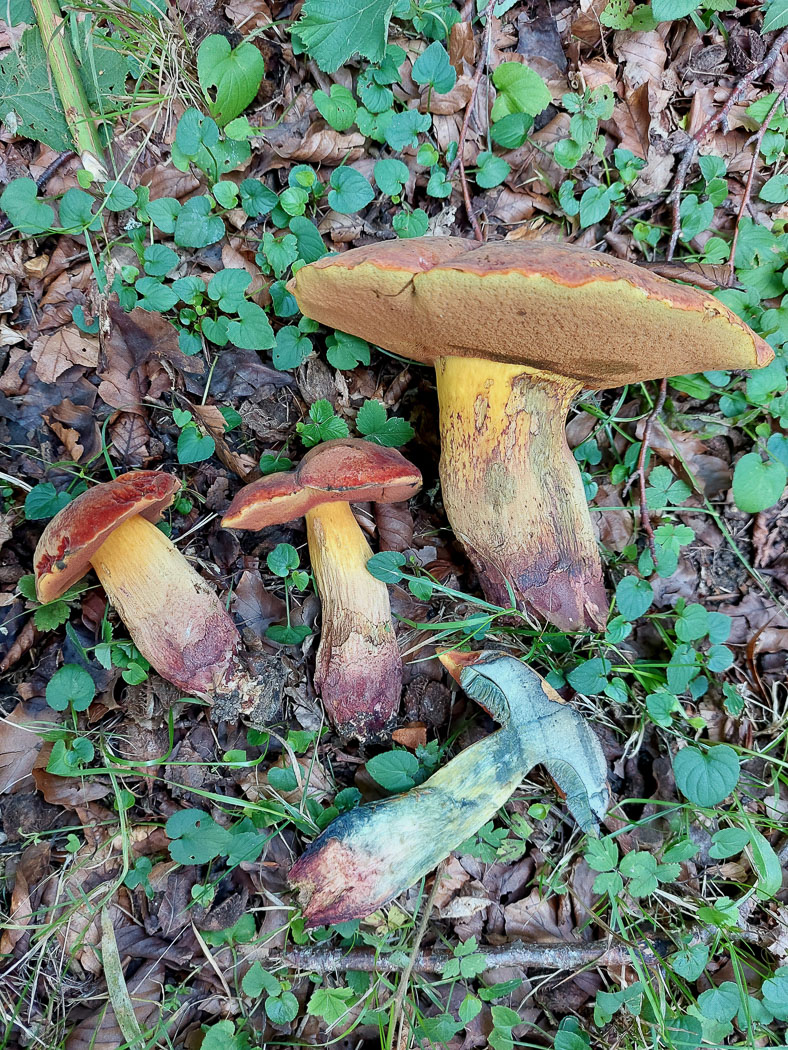
|
Suillellus queletii (Deceiving Bolete) Sep 25, 2024. At Stampwell Farm Jackie Ewan found this impressive species where she'd found it before. It was very common last year but all boletes have been in short supply locally this autumn so far. The strongly and quickly blueing flesh when exposed to air, together with the beetroot red stem base are good clues to its identity. Sep 7, 2024. In Little Chalfont Jesper launder came across about 20 fruitbodies of this impressive mushroom under deciduous trees a sure sign that the autumn season is at last on its way. This species appears to be becoming more common in our area though it may be that we are now more skilled at recognising it from the other similar lookalikes with reddish pores and blueing flesh. The tapering almost rooting stem base which shows beetroot red flesh are the pointers to distinguish it. Jul 28, 2023. At Stampwell Farm at the edge of a meadow near both Oak and Birch Jackie Ewan found a large gathering (11 fruitbodies) of this unusual Bolete, the largest being 16 cm across. The orange-tinged pores and instant blueing flesh when cut pointed to one of several very similar species, so careful checking of both macro and micro characters was needed before she could decide upon its ID. Points separating this species from S. luridus and N. luridiformis: the deep beetroot flesh at the slightly tapering stem base (photo 3), also the lack of reticulation on the stem which is yellow under the apex. Photo 5 was sent in by Jesper Launder from nearby Jordans village just 4 days later. Sep 15, 2022. In Jordans village Jesper Launder came across this group under Beech and was able to recognise the pointers which separate this species from two other lookalikes: S. luridus and Neoboletus luridiformis. All three are sizeable chunky species, have orange to red pores rather than yellow and have flesh which when exposed to air quickly turns bright blue. The stem base of S. queletii, however, differs in having bright beetroot red flesh and also tapers, often rooting into soil. It is probably the least common of the three species, usually found under beech or Oak. Nov 6, 2021. Under a Beech hedge in Beaconsfield Jesper Launder spotted this nice collection of an unusual Bolete - a genus remarkably poorly represented this autumn. Previously in the genus Boletus, one can only assume that the common name stems from its similarity to S. luridus (Lurid Bolete) which also has reddish pores but lacks the distinctive tapered rooting stem base where the flesh is deep beetroot red to blackish red. We have around ten previous county records. |
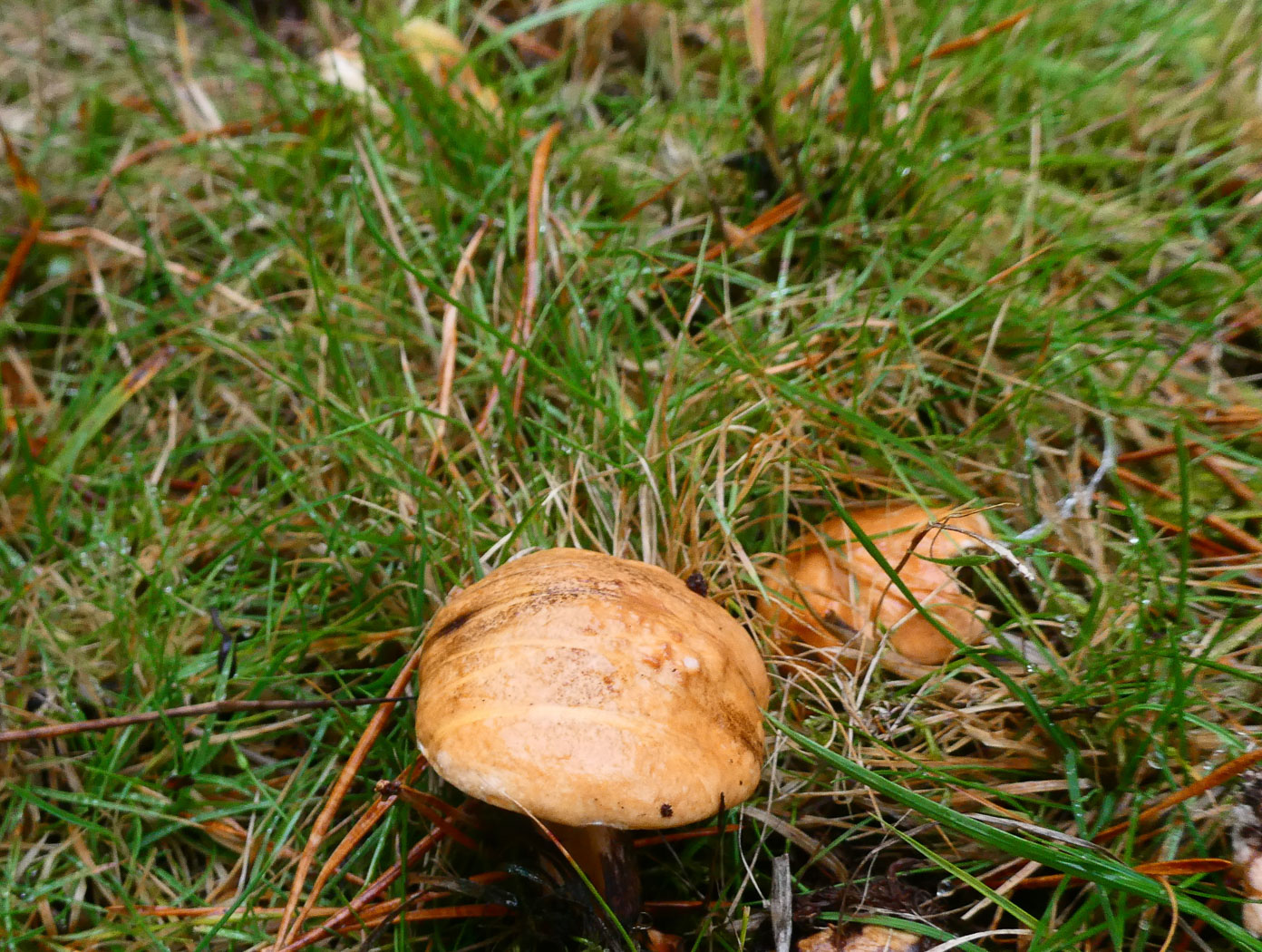
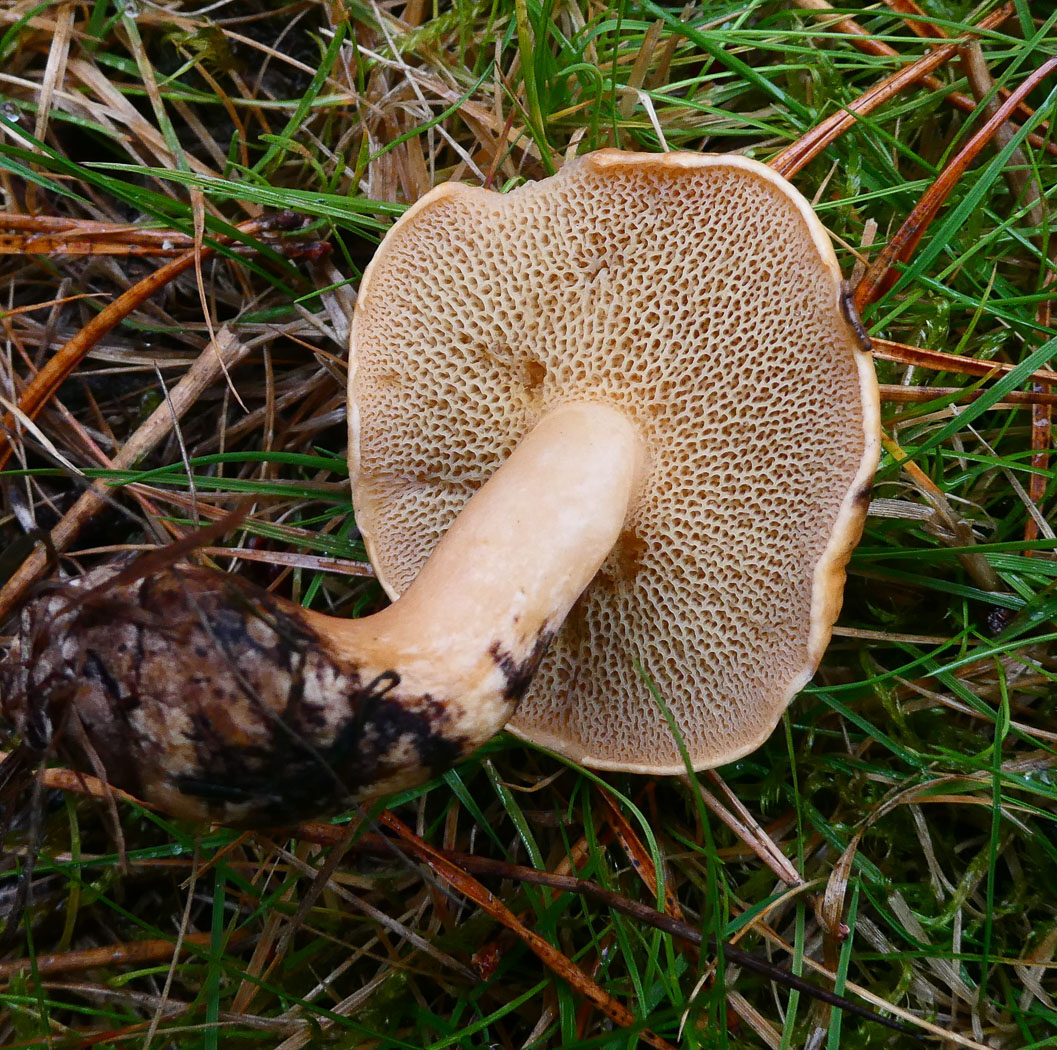 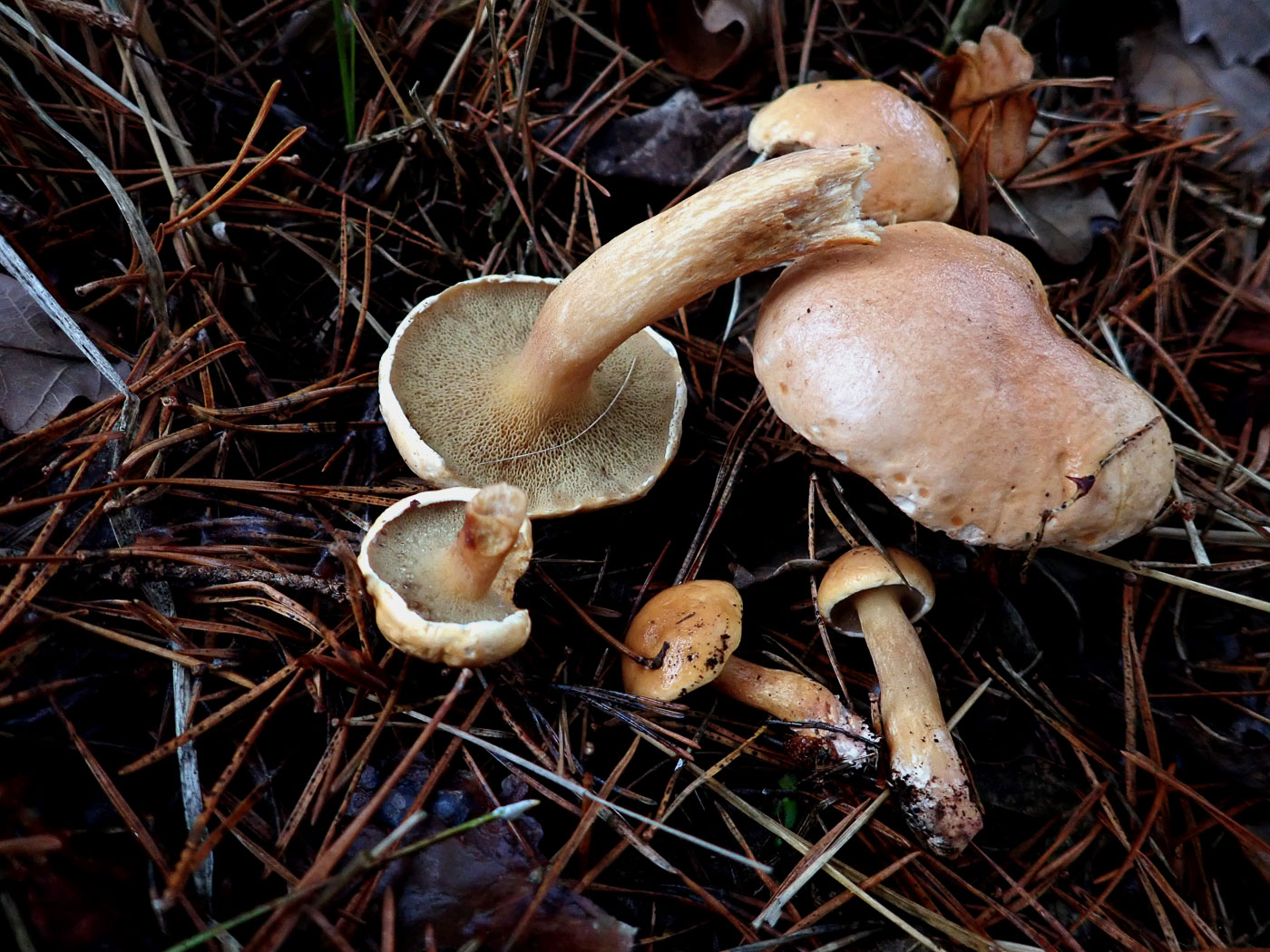
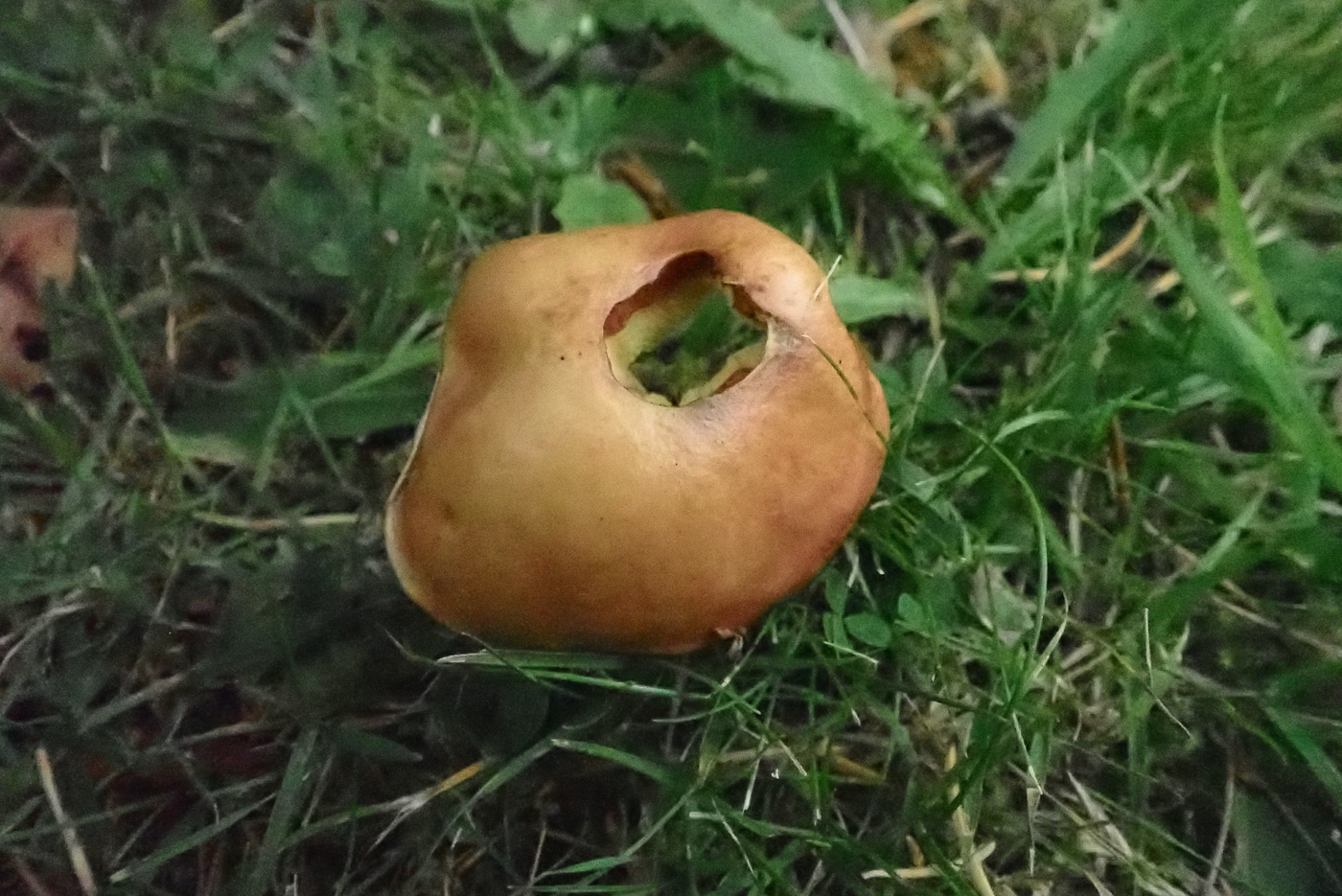
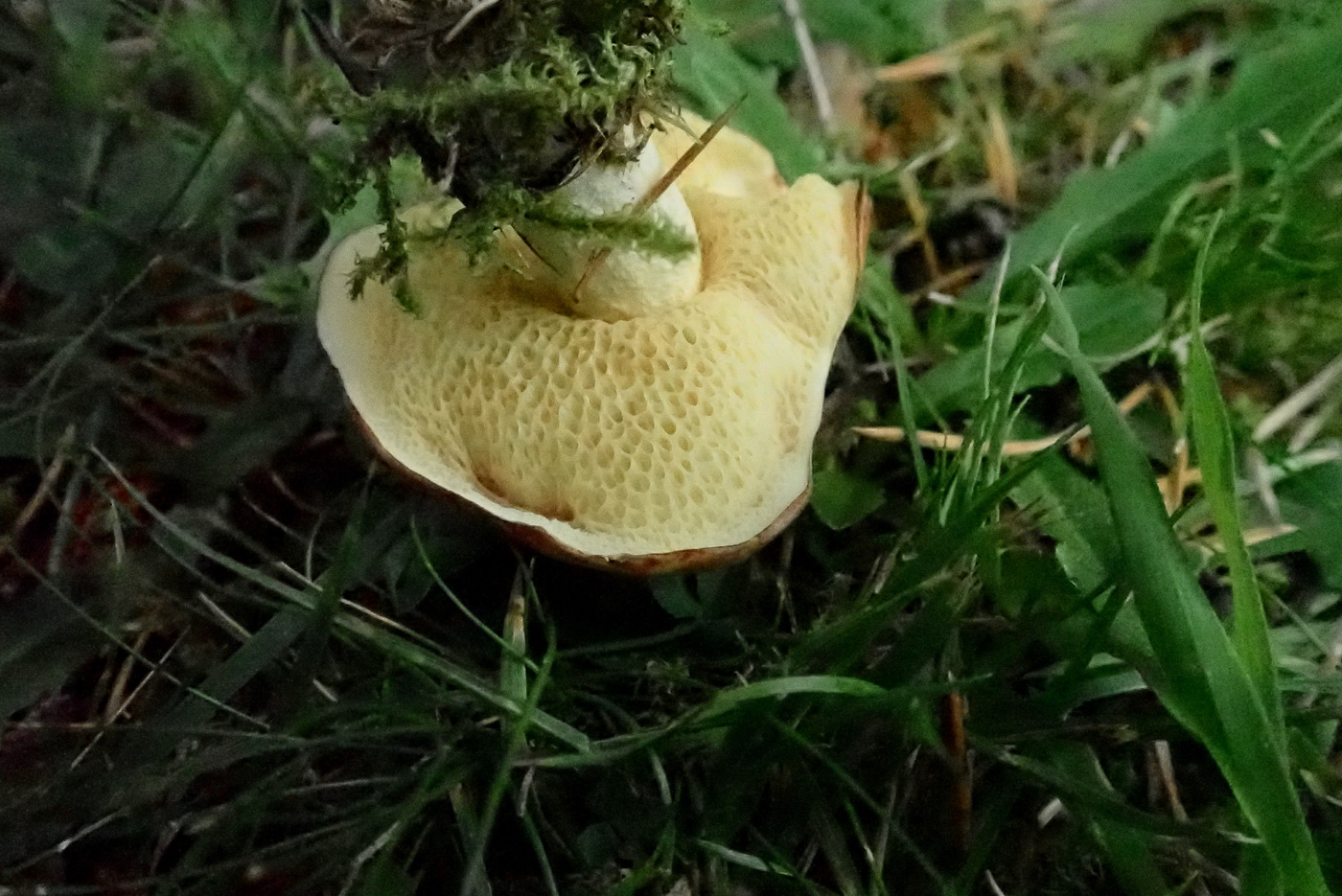
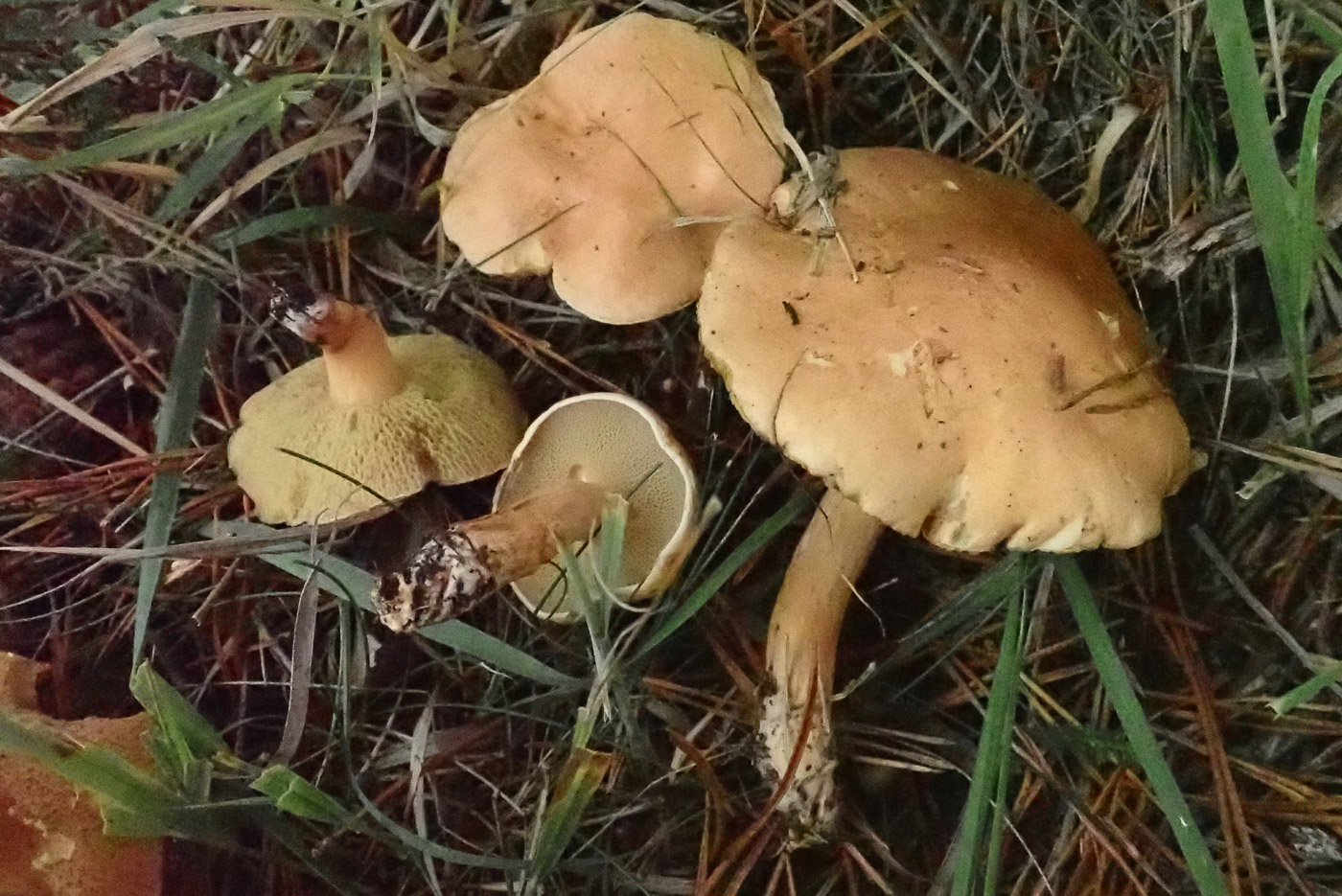
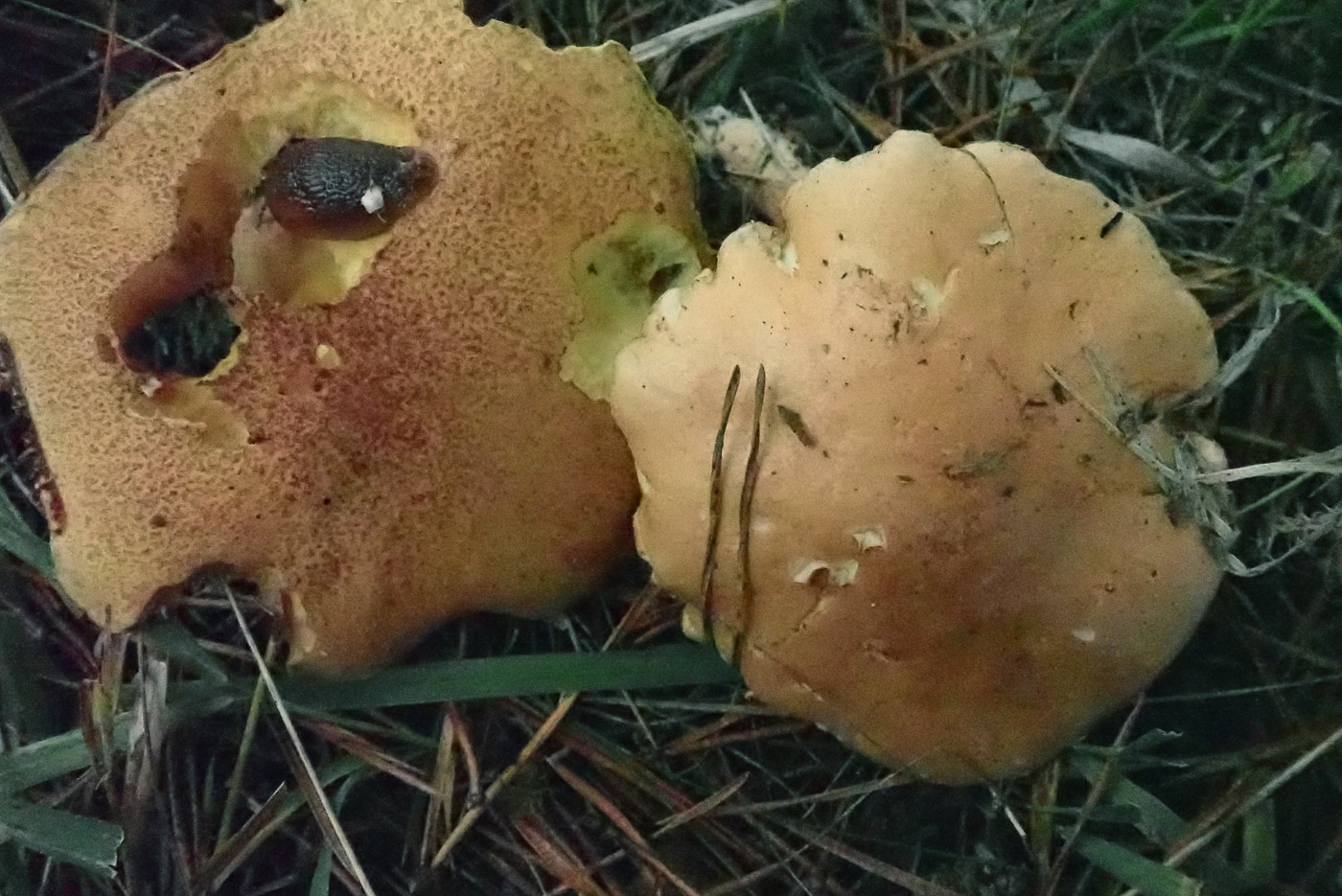
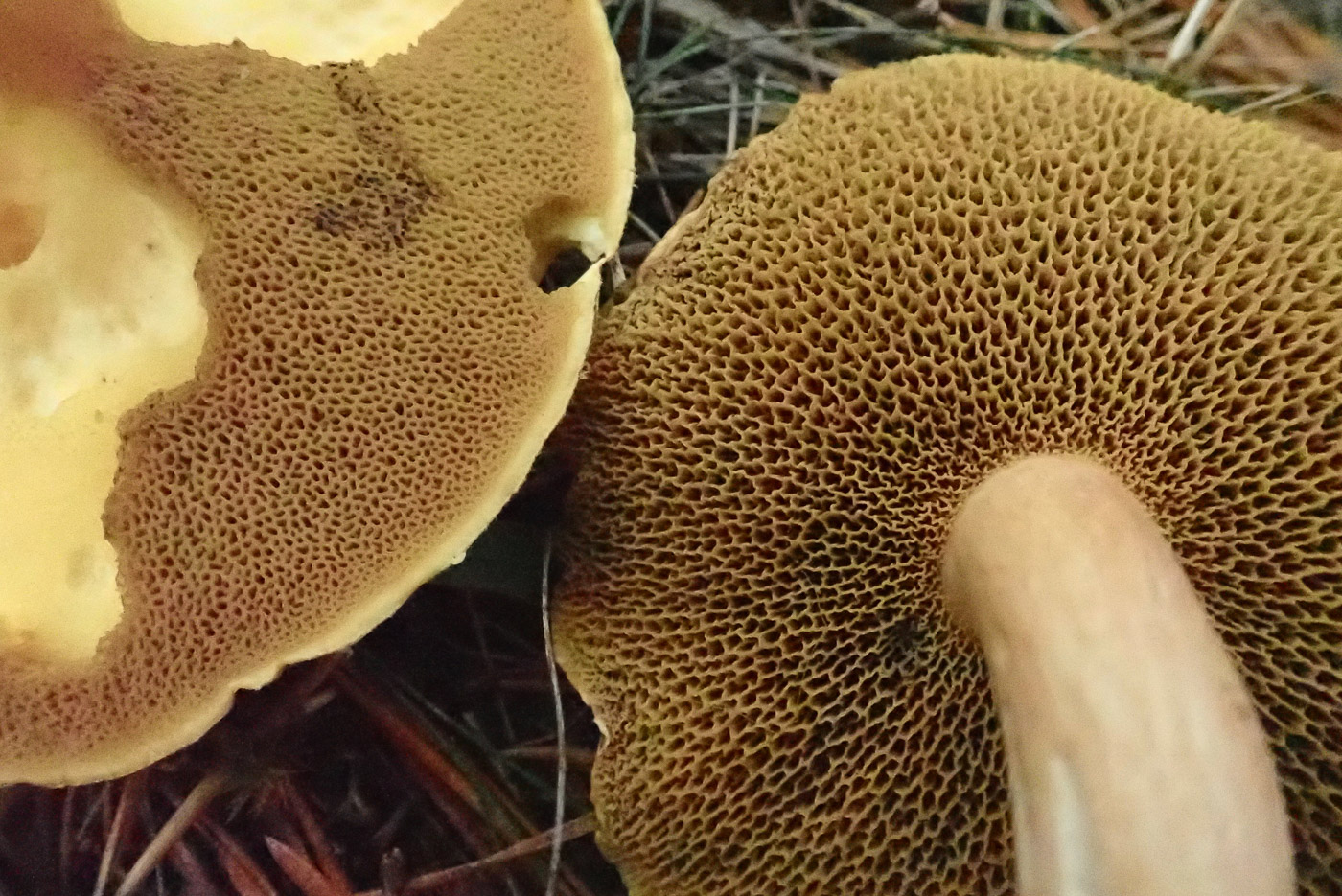
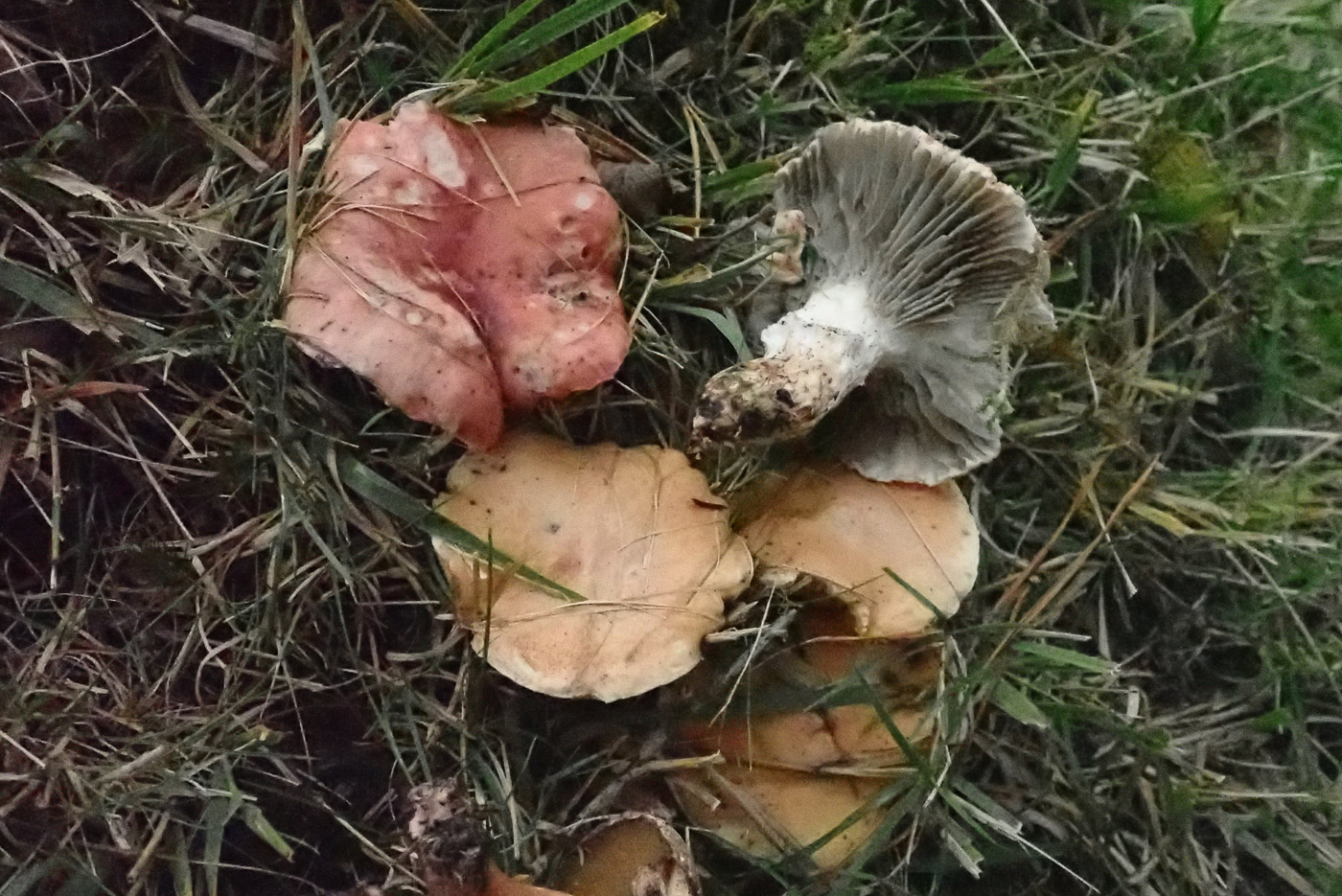
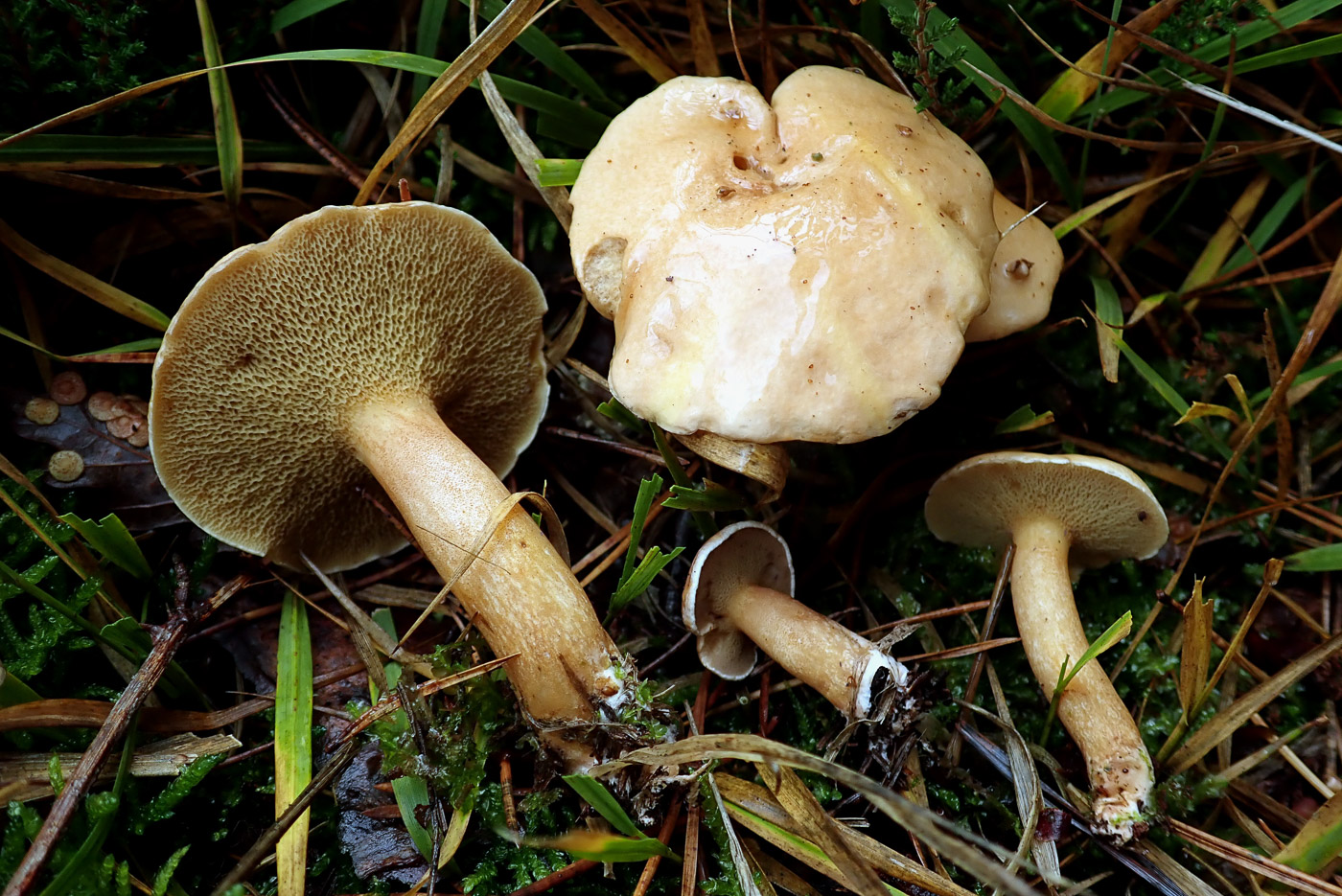
|
Suillus bovinus (Bovine Bolete) Oct 25, 2024. At Stoke Common under Pine Jim Wills found this pair, and picking one to turn it over found it to be somewhat sticky. This observation together with the presence of pores underneath placed it into genus Suillus; then at home the distinctive shape of the pores, the cap colour and occurrence under Pine all pointed to this species - one of the commonest wherever Pine occurs. If you find it do have a quick look around for the accompanying pink-red cap of Gomphidius roseus (Rosy Spike), a small gilled mushroom which associates with this particular bolete. Nov 29, 2022. At Stoke Common this is a regular fruiter under the many Pines with which it is host specific, but Penny was surprised to find such a range of specimens in good conditions at the moment - much of the site being under water as often happens here. There was no sign, however, of its companion agaric, Gomphidius roseus (Rosy Spike) - always worth a good hunt around for if you find this particular Bolete. Oct 27, 2021. Under Pine at Stoke Common Penny found many collections of this sticky capped Bolete and after much searching was rewarded by finding the red capped Gomphidius species which associates with it (and in fact is never found without it). The grey decurrent gills combined with rosy red cap and occurrence with S. bovinus make this an easy one to identify. There was another Suillus species present as well, giving the opportunity to compare the differences between the two. Suillus bovinus has a smooth sticky soft cap which is pinkish buff, also rather widely spaced irregularly shaped dull yellow pores which are slightly decurrent. Suillus variegatus has a darker brown textured to finely scaly cap and much smaller round pores which are not yellow but dark mustard to brown. Both species occur quite commonly under Pine and often grow near each other. Photo 1 is of Suillus bovinus; photo 2 compares the caps of S. bovinus right with S. variegatus left, photo 3 compares the pores of S. bovinus right with S. variegatus left; photo 4 shows S. bovinus together with Gomphidius roseus. (See also the collection of S. bovinus dated Aug 15) Aug 15, 2021. In short grass under a large Pine just outside Prestwood Churchyard Penny found this small singleton having just pushed up through the soil. Turning it over revealed two things: the cap felt sticky to the touch and it clearly had large pores underneath - the pores making it a member of the boletes and the sticky cap and presence of conifer making it a species of Suillus. Only found under Pine, the pale clay coloured smooth sticky cap is typical as are the slightly yellow large pores which don't blue when pressed, also the stem has no ring (unlike the much commoner S. grevillei, found only under Larch, or the much browner capped S. luteus, found also under Pine). Nov 3, 2020. Under Pine at Burnham Beeches Penny C. found quite a few specimens of this Bolete, one of several in this particular genus which are host specific with Pine. It has a sticky pale clay brown cap, pores are soft and quite large, darker than the cap and also slightly decurrent, stems are more or less concolorous with the cap and lack a ring (which helps to separate it from S. luteus - also found here today). Penny searched the area for another mushroom which associates with this particular Bolete, Gomphidius roseus, but sadly to no avail. But if you find S. bovinus it-s always worth a hunt for this bright red capped smallish species which has strongly decurrent grey gills. |
 |
Suillus collinitus (a Bolete with no common name) Aug 13, 2023. Under Pine in Gerrards Cross Jesper Launder found two different species of Suillus, this being by far the rarer of the two locally. (See below for more on the genus generally.) Compared to the species below, it has a darker more reddish brown fibrillose cap and a yellower ringless stem having numerous brown dots. It also has pink mycelium at its base though try as he might Jesper's camera failed to pick this up though he could clearly see it! We have only two previous county sites with only one record this century. This is therefore a first for Finds. |
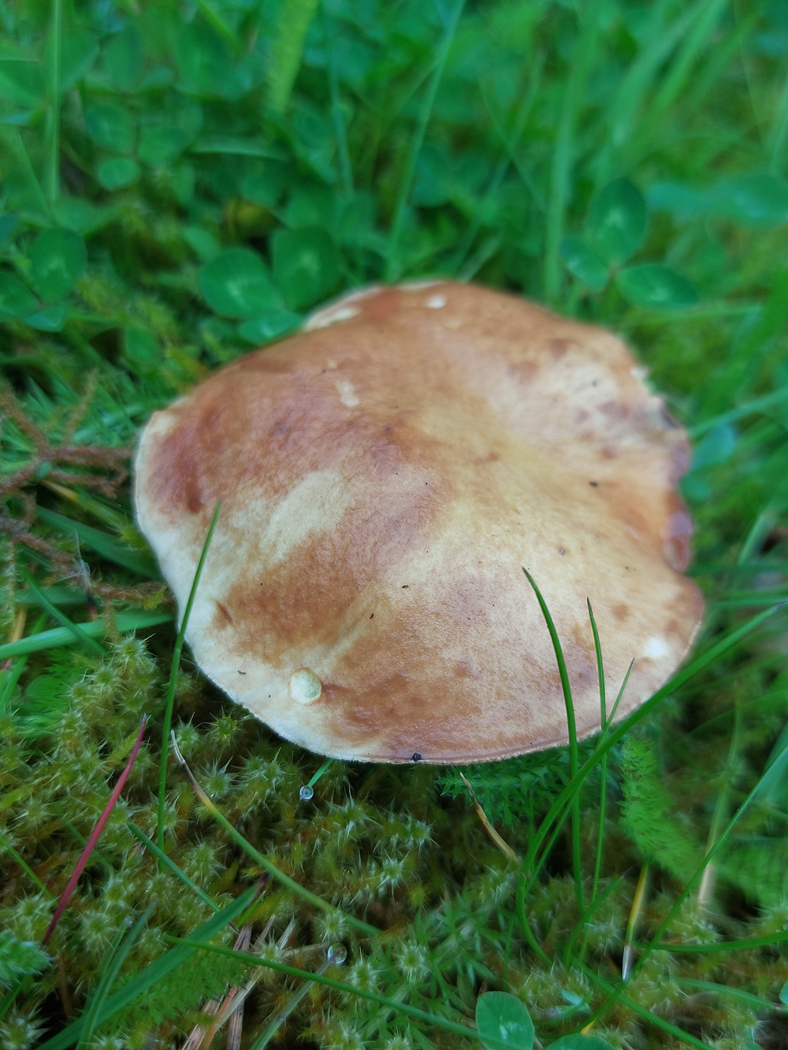
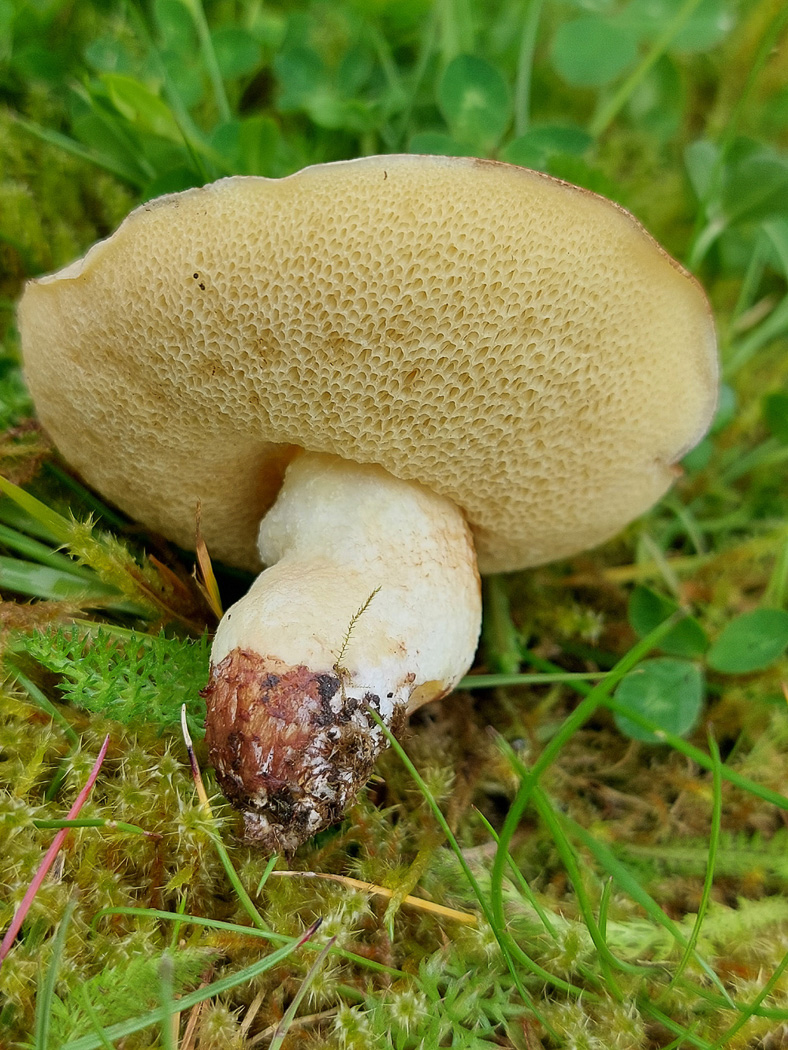  |
Suillus granulatus (Weeping Bolete) May 2, 2024. Penny has been wondering when our first Bolete would turn up as so many unseasonal species have been appearing this spring. Here it is! Jesper Launder found this singleton under Pine (its host tree) in Gerrards Cross where he found also it last year in August. See the notes about the species with that entry. Aug 13, 2023. Under Pine in Gerrards Cross Jesper Launder found two different species of Suillus - most of this genus associate with Pine though a few occur with Larch. They differ from the many other genera of Boletes in mostly having sticky caps - often really slimy in wet weather, with pores that don't blue and sometimes with a ring on the stem. S. granulatus has a pale brown sticky cap, fine yellow pores and ringless stem marked with numerous small whitish dots (though these are not really visible here). It is one of our commoner Suillus species given the correct tree association. though this appears to be a new entry for Finds. |
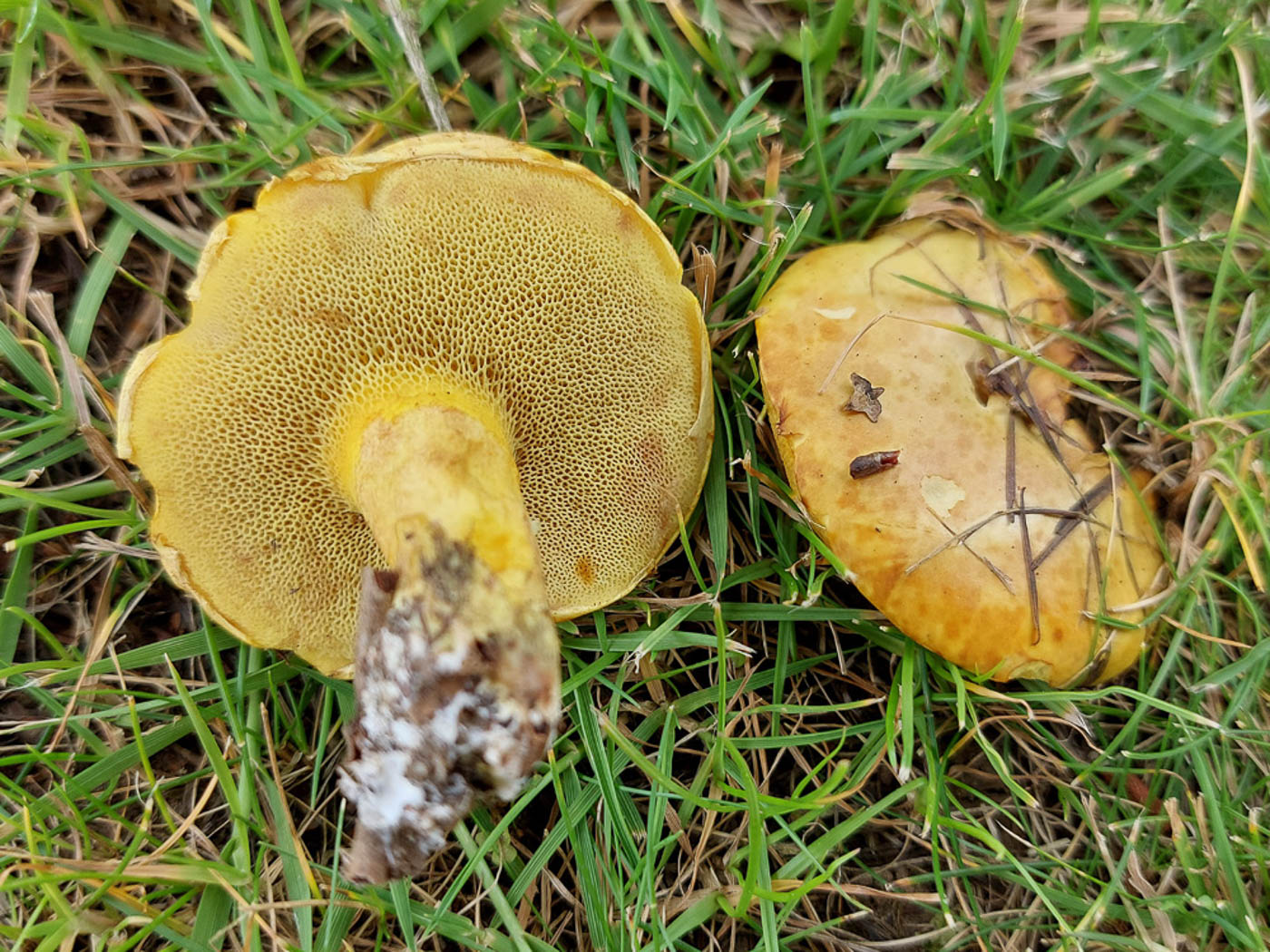 
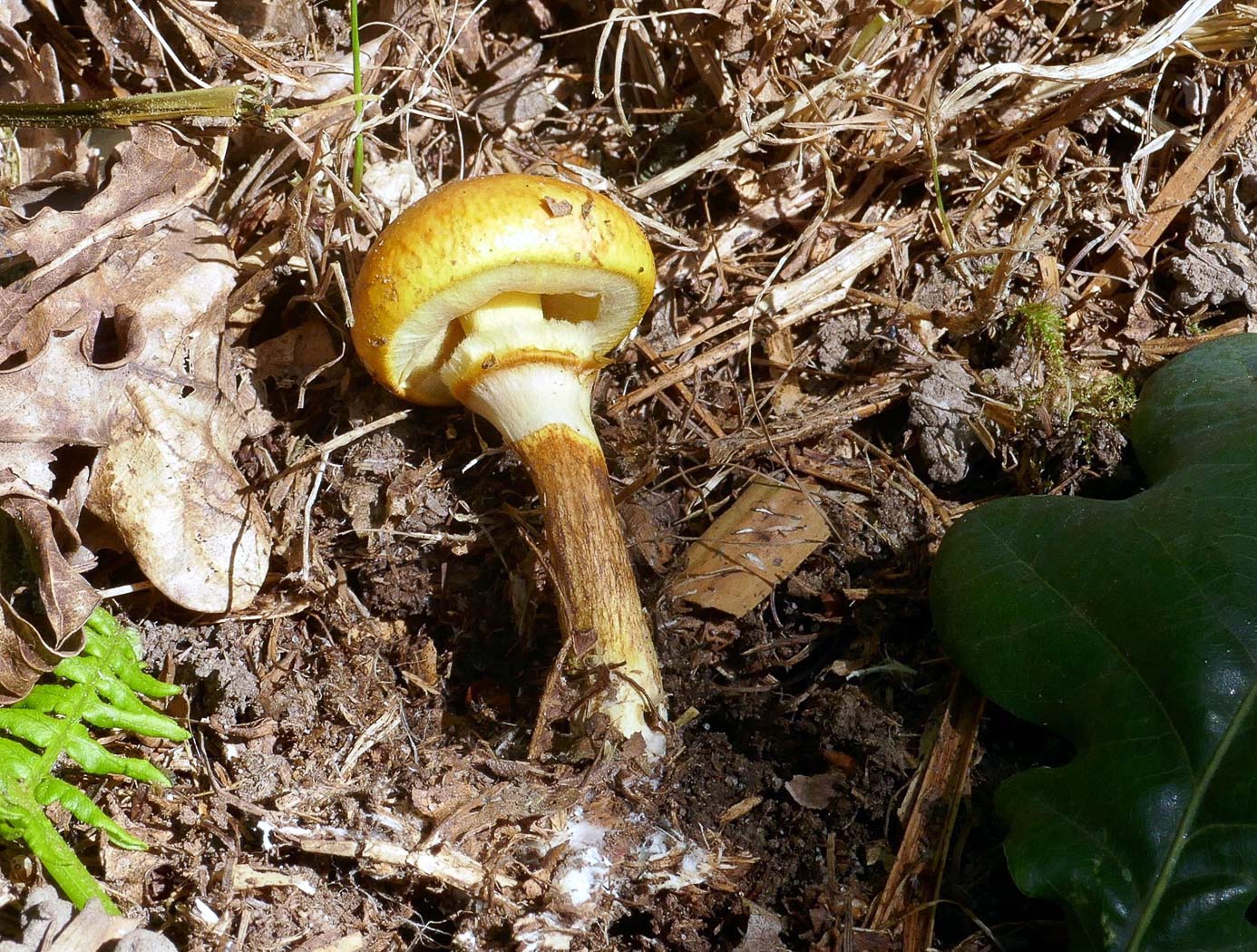
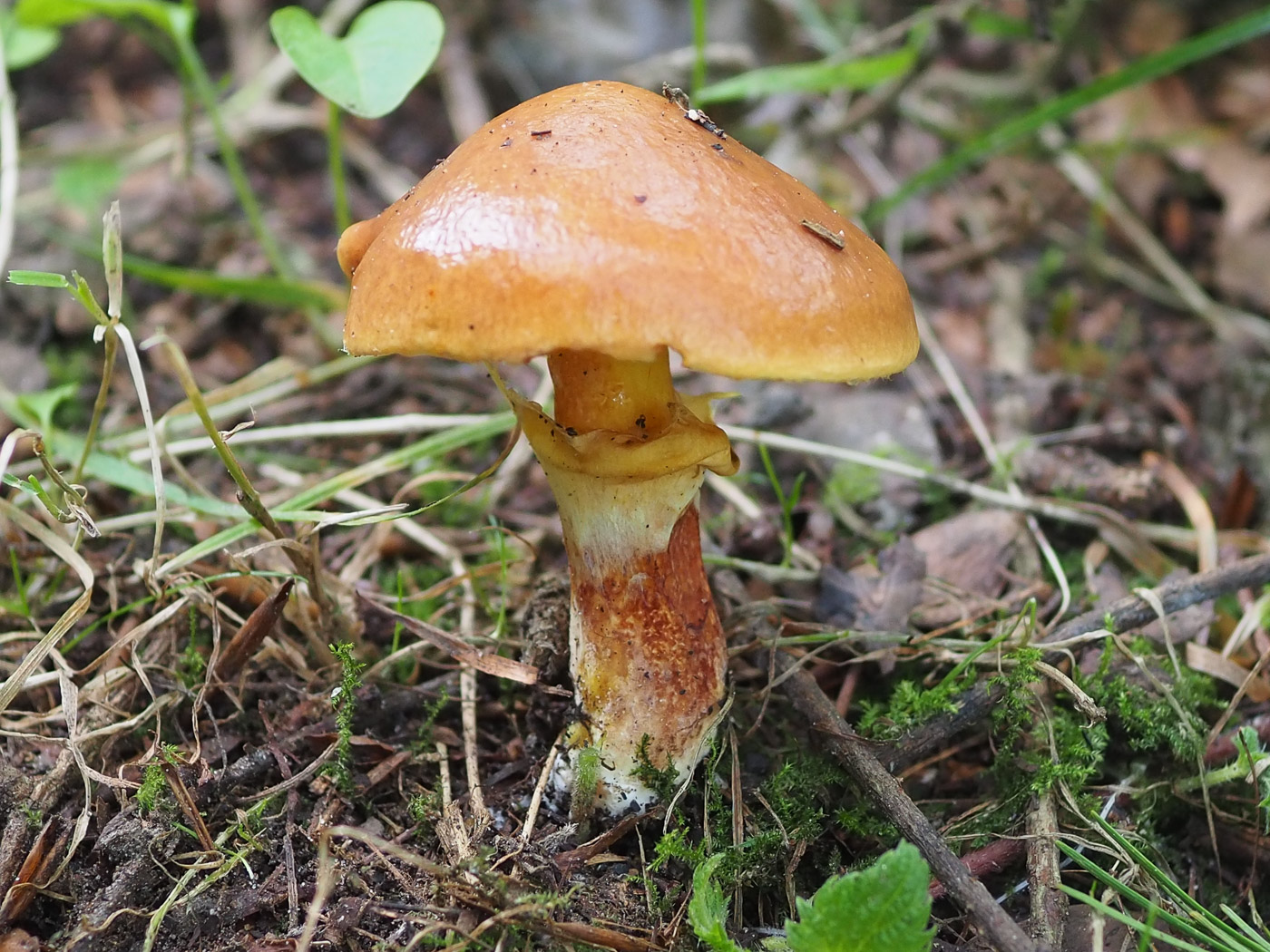
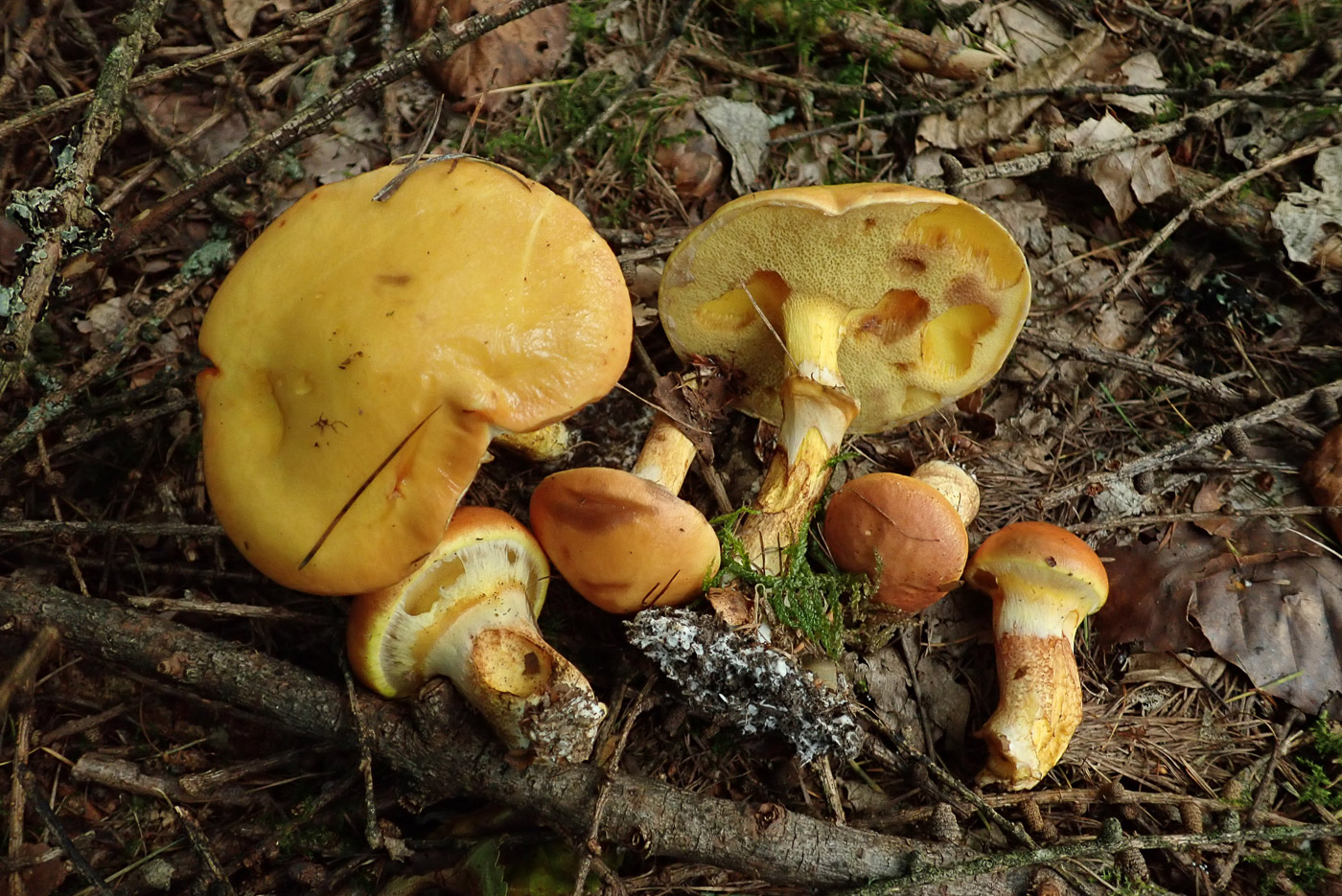
|
Suillus grevillei (Larch Bolete) Jun 11, 2024. Under Larch in a private garden in Beaconsfield Jesper Launder spotted this pair of Boletes - this is a common species which quite often fruits early in the season and is host specific to Larch unlike most others in this genus which associate only with Pine. It has the typical sticky cap of the genus, also like a few others a ring on the stem when young though it often quickly disappears. There are a few other Suillus species which associate with Larch but are considerably rarer. Jun 14, 2022. Here we have another early sighting - our second Bolete and the first Bucks record for June for the species though we have two others for July. It was found by Jackie Ewan at Stampwell Farm under Bracken and Oak but with Larch not far away. (A good lesson here: the host tree to any mycorrhizal species is not always the nearest tree!) Sep 7, 2020. Found by John Catterson in Cowleaze Wood (just over the county border into Oxfordshire!), this early fruiter occurs exclusively under Larch and is very variable in colour, sometimes yellow-brown as here, sometimes a rich reddish dark brown. It has a sticky cap and a persistent ring on the stem. (S. luteus (Slipperly Jack) also has a ring but lacks red in the brown cap and occurs exclusively under Pine.) Sep 16, 2020. This collection was found by Penny Cullington under Larch at Penn Wood. Our previous photo (dated Sept 7th) was of a singleton specimen so today's varied collection, showing young specimens with the ring still unformed and thus hampering one from deciding upon gills or pores at this stage, is worth including. Prior to finding the mature specimens here and because the cap underside was still concealed, it was suspected that this was possibly a species of Gymnopilus (which has gills). All was revealed once a specimen with pores was found and the Larch substrate noted. |
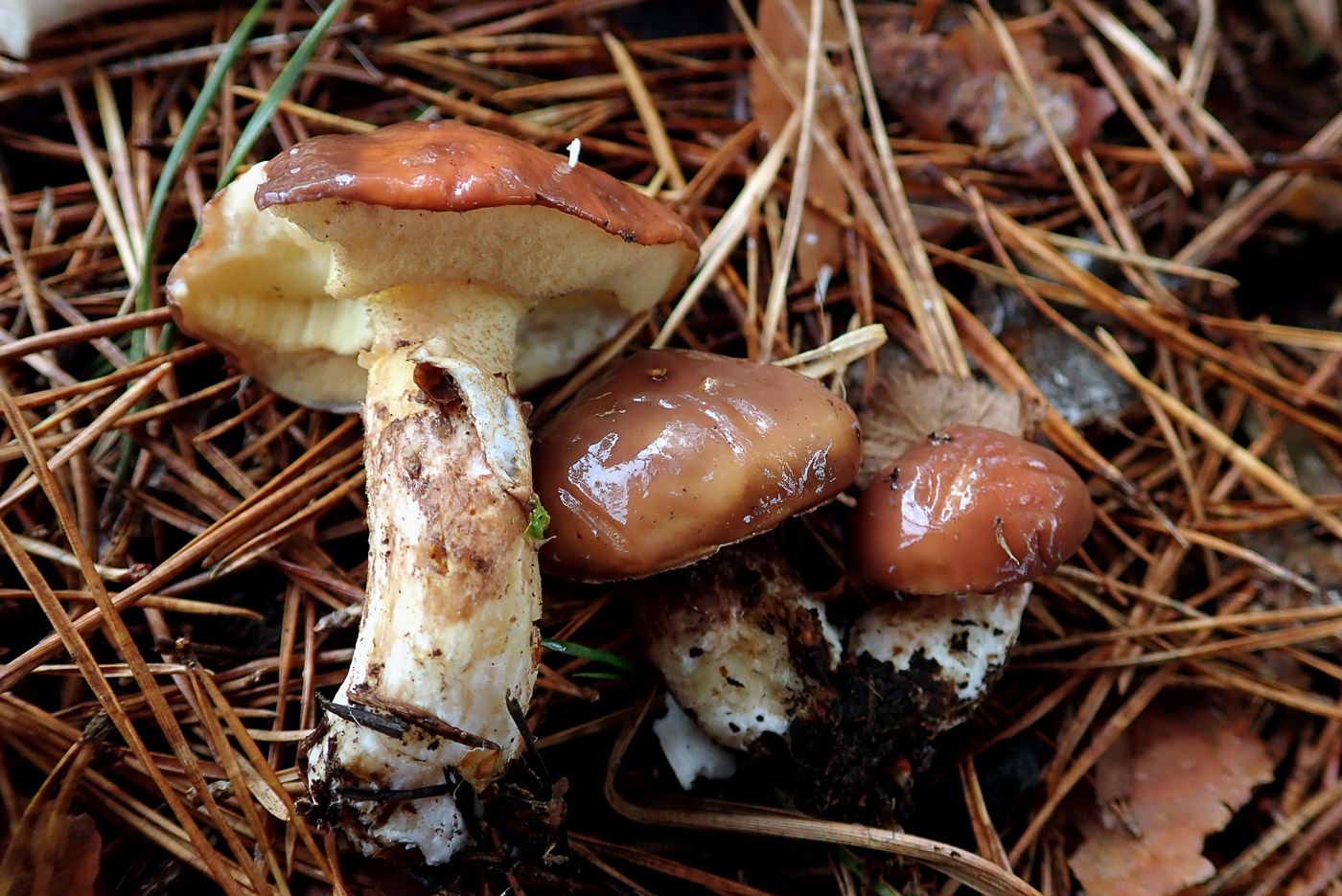
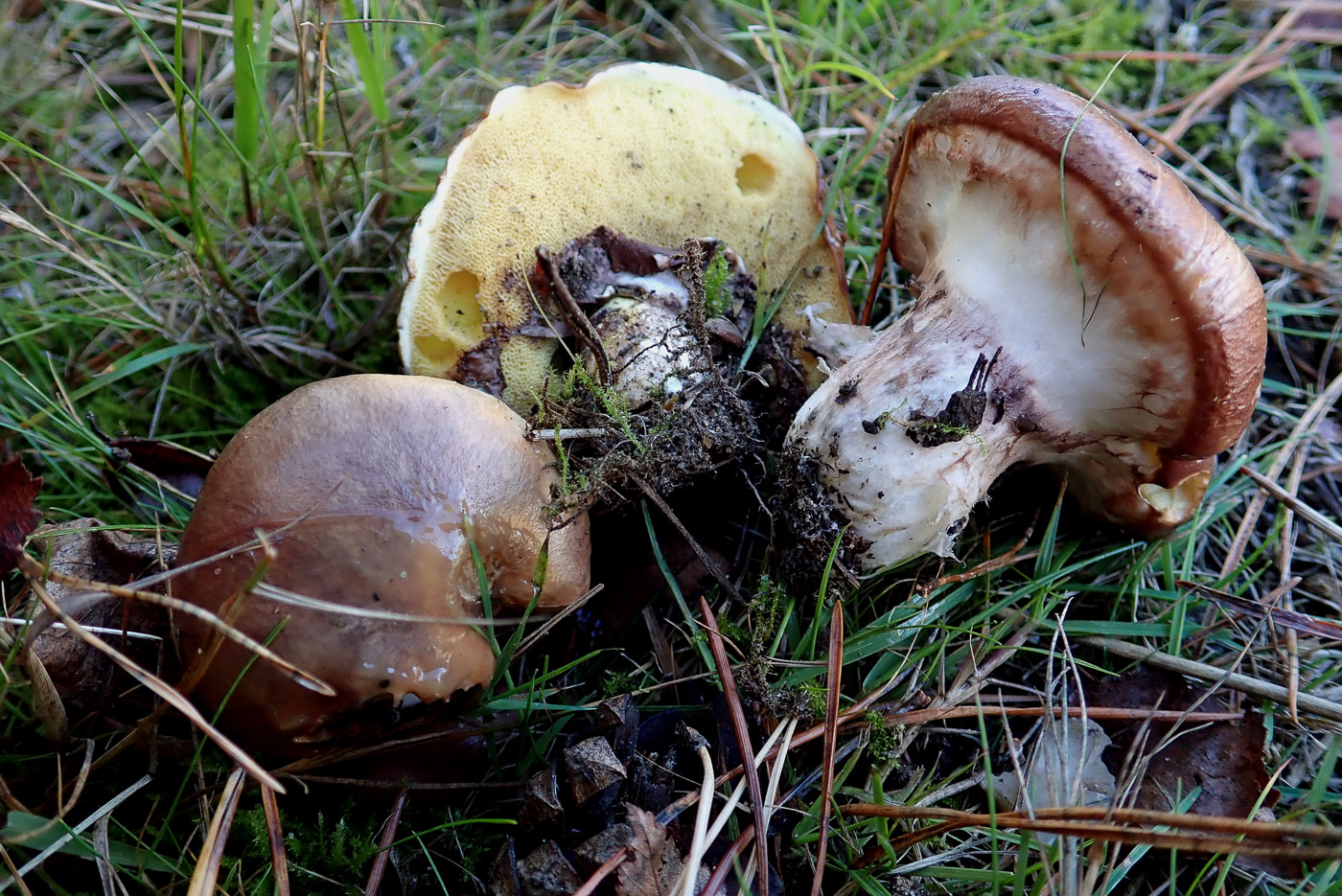
|
Suillus luteus (Slippery Jack) Nov 3, 2020. We have a previous photo of this species (dated Sept 25) but not of great material, as also here unfortunately, found by Penny C. under Pine in Burnham Beeches. Just worth including again, however, to show that it's still fruiting. See previous notes for more information. Sep 25, 2020. This, our 18th species of bolete this month, was found under Pine at Stoke Common by Penny Cullington. Unfortunately not the most photogenic material, it does show the basic diagnostic features: a very sticky rich brown cap, yellow pores and a stem with a significant membranous ring (seen still well attached and covering the pores in the RH specimen but leaving just some brownish remnants on the central specimen). Suillus grevillei Larch Bolete) has a similar ring (see photo dated Sept 16th for comparison) but grows exclusively under Larch and has a paler cap; today's species grows exclusively under Pine. |
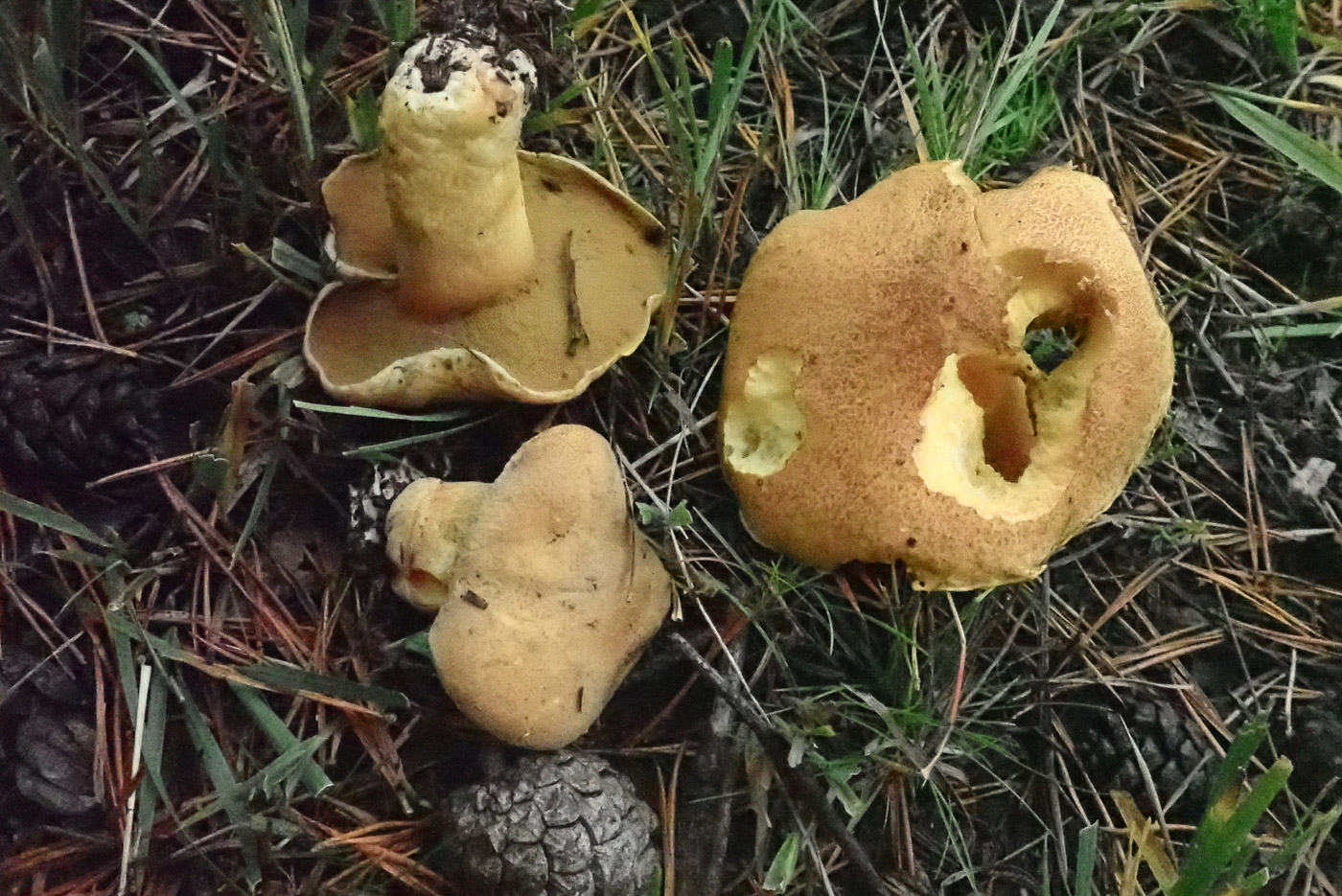
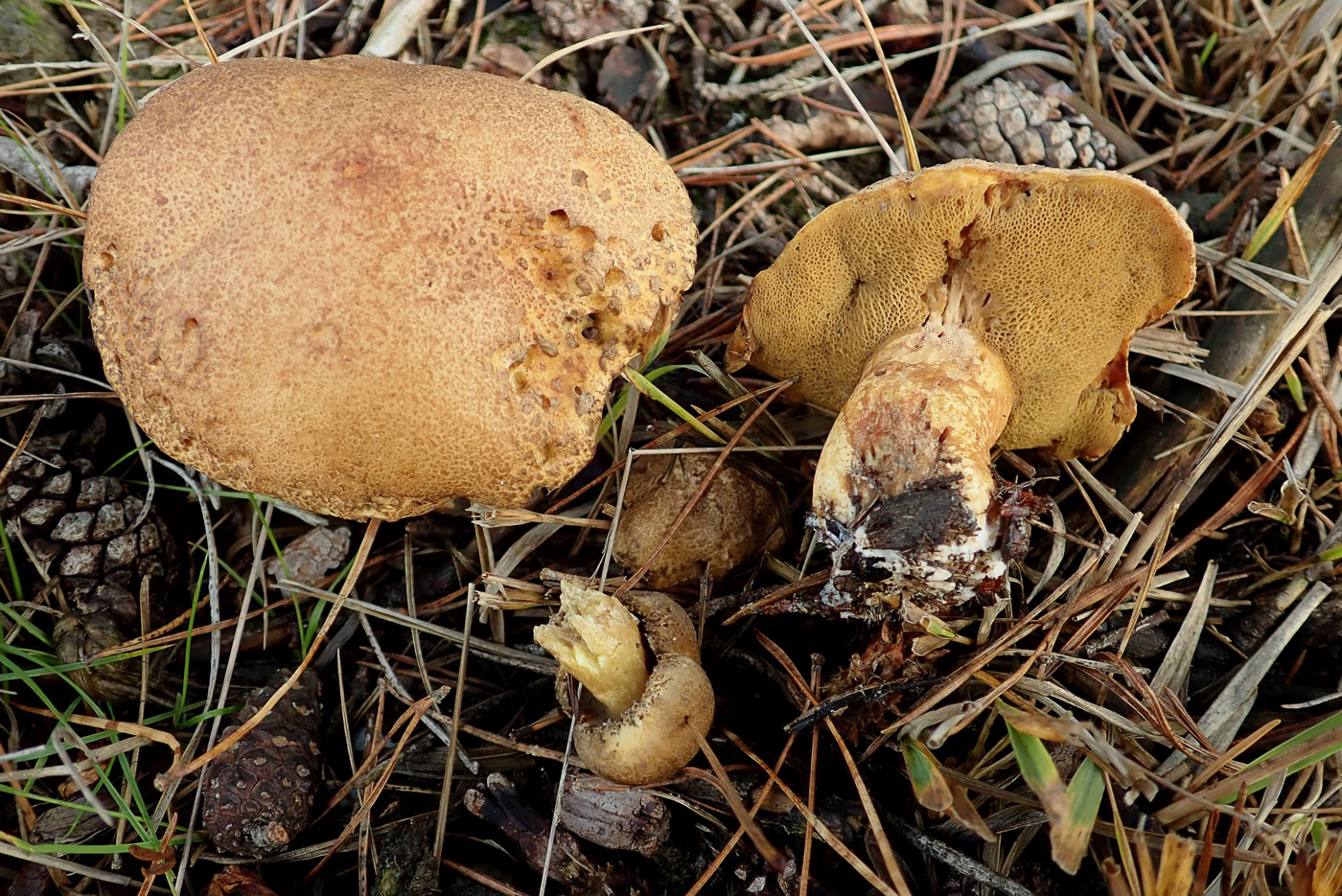
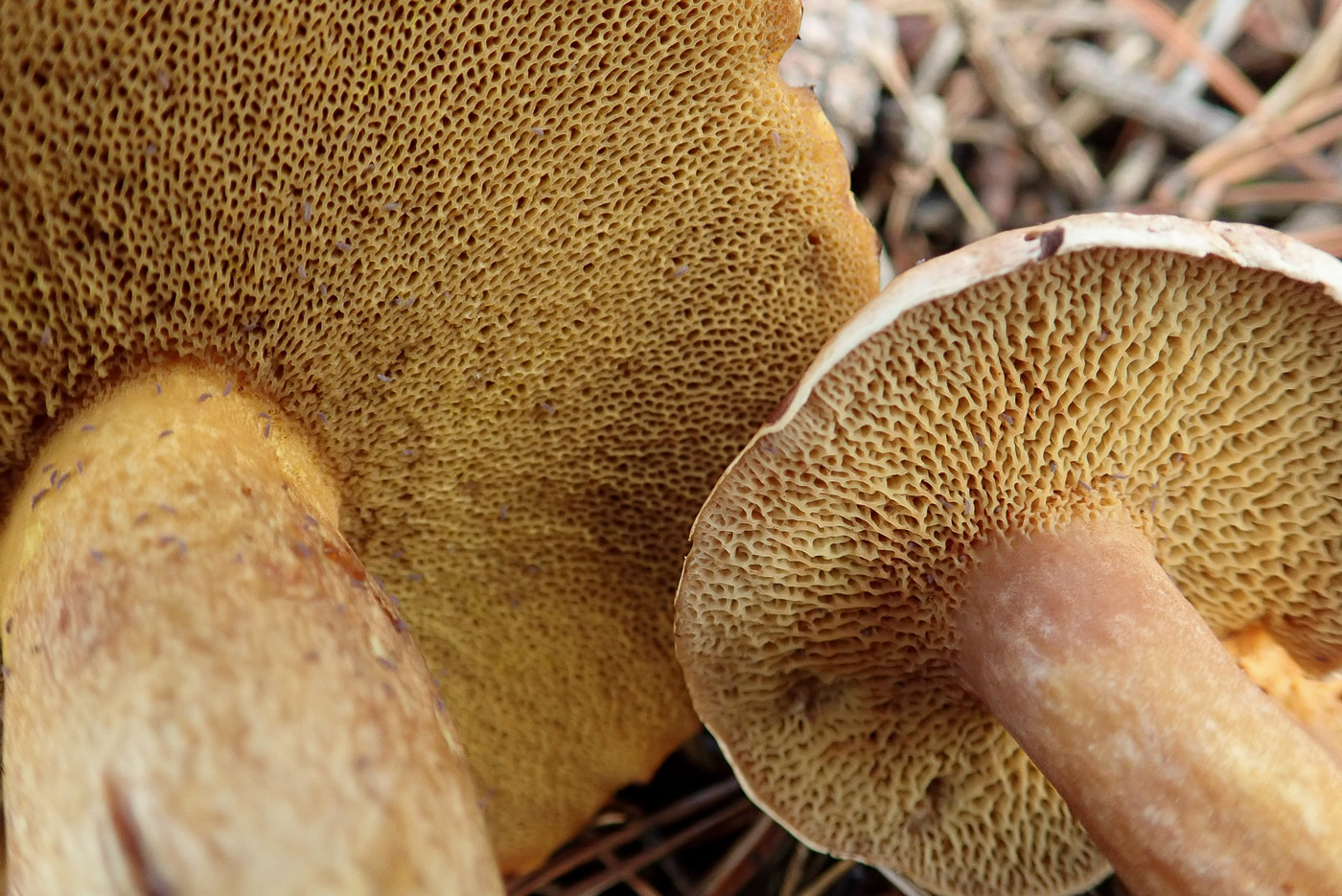
|
Suillus variegatus (Velvet Bolete) Oct 27, 2021. Under the Pines at Stoke Common and often growing alongside Suillus bovinus Penny found this slightly darker capped but similar species, another which occurs only under Pine. The cap texture is notably less smooth, however, and turning it over reveals fine pores which are also darker than in the other species. (Clearly the slugs found it tastier too!). See also the text and photos for Suillus bovinus above which compare the two species side by side. Nov 7, 2020. Penny C. found this species under Pine at Stoke Common along with S. bovinus, giving a good opportunity to compare two somewhat similar Boletes. Both are host specific with Pine and have yellowish brown caps though S. bovinus seems much more common in our area. S. bovinus has a smooth sticky cap which has pinkish buff tints, whereas S. variegatus has a more textured dry cap surface with no pink tints. The pores of the two are also notably different: in S. variegatus they are rounded and small, described as mustard coloured, whereas in S. bovinus they are irregularly angular and larger, also paler and slightly decurrent. In photo 2 these pore characters can be seen with S. variegatus on the left and S. bovinus on the right. |
 |
Suillus viscidus (Sticky Bolete) Oct 6, 2023. In Gerrards Cross under Larch Jesper Launder found this uncommon Bolete, one for which we have only one previous county record. The species is one of three Suillus species which associate only with Larch, by far the commonest of these being S. grevillei. (The third is extremely rare and unlikely in the south.) This is one of the palest capped Suillus species and not likely to be confused with the bright yellow / orange-brown S. grevillei, so one to watch out for if under Larch. This is a new entry for Finds. |
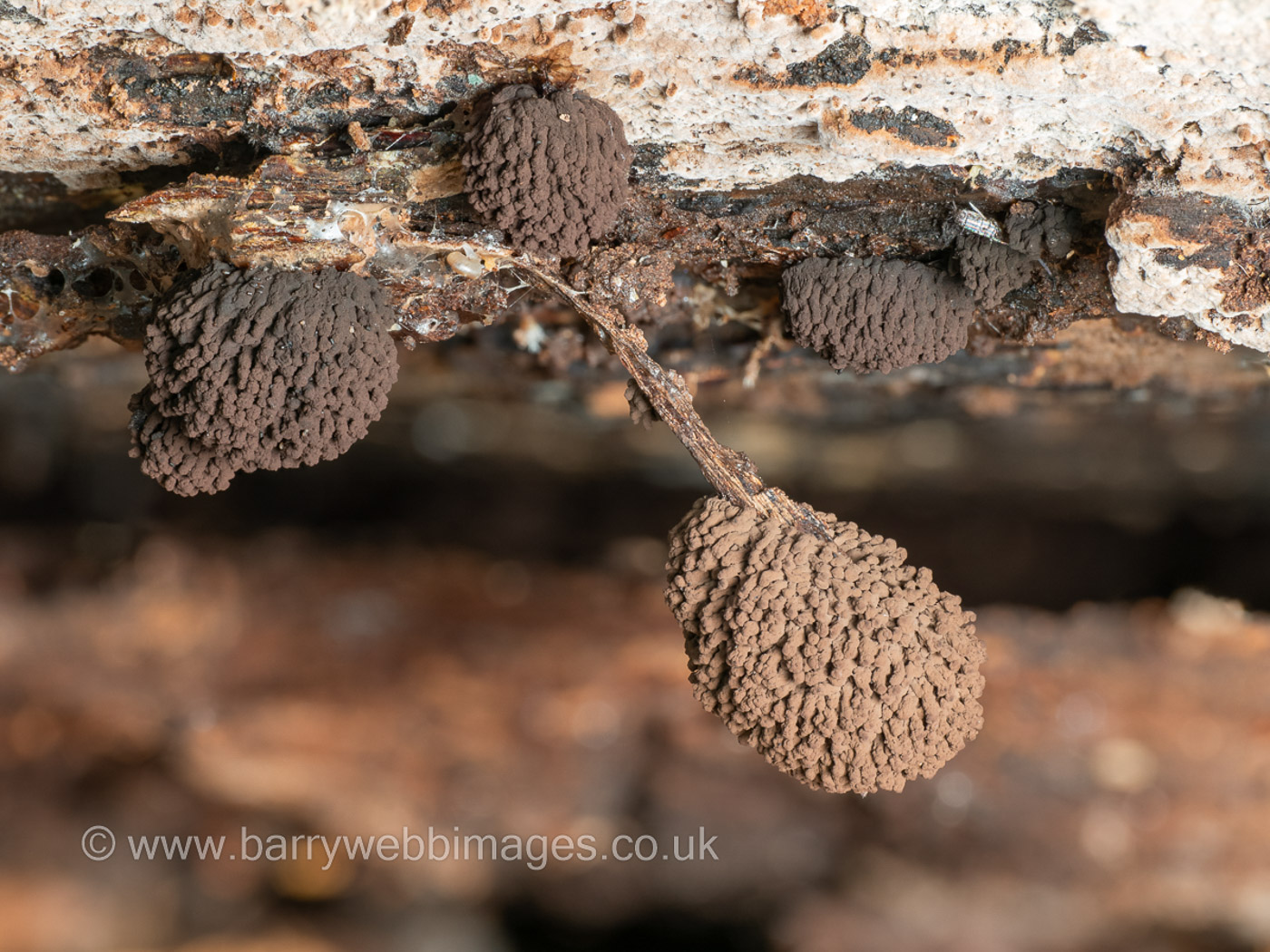 |
Symphytocarpus amaurochaetoides (a rare Slime Mould with no common name) Sep 13, 2023. On fallen rotting Beech at Burnham Beeches Barry Webb found this rare species, one that Penny has never heard of. As can be seen from its shape and habit, the genus is related to Stemonitis and at one stage was thought to be part of that genus but just malformed until it was realised that its few members were consistently different and species in their own right. The apparent long stalk on the lowest cluster here is in fact a sliver of wood flaking off the log - the tight clusters are stalkless and no more than 5mm tall. This was an nice find and is new to the county with few national records. |

